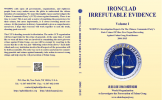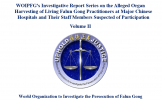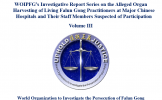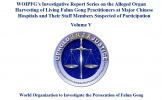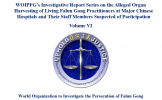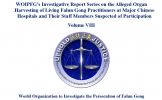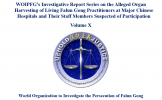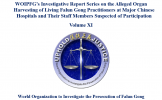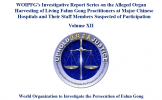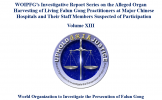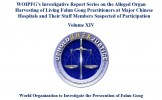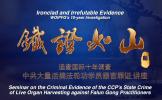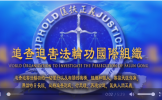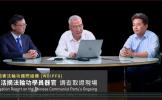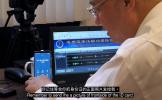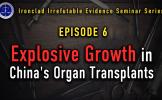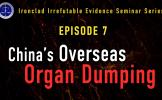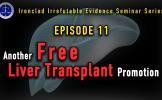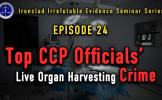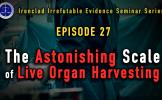WOIPFG’s Summary Report on the CCP’s State Crime of Massive Live Organ Harvesting against Falun Gong Practitioners from 2006-2015
WOIPFG’s Summary Report on the CCP’s State Crime of Massive Live Organ Harvesting against Falun Gong Practitioners
Published on April 5, 2016; updated on October 6, 2019
Preface
More than ten years, many questions about China’s organ transplant system have been perplexing the international community:
1. Is it true that many Chinese people, primarily Falun Dafa (aka Falun Gong) practitioners, as well as some Tibetans, Uighurs, Christians and others, have been killed as victims of live organ harvesting for organ transplants by the Chinese Communist regime?
2. What is the real scale of live organ harvesting in China?
3. Did Jiang Zemin personally issue the order to perform live organ harvesting on Falun Gong practitioners?
4. Is live organ harvesting isolated acts by certain hospitals colluding with the military, police and judiciary systems, or is it a systematic crime committed by the state?
China has the most secretive medical systems in the world. Since 2006, the Chinese medical establishment has shut the door to all external requests for investigation into the forced disappearances of Falun Gong practitioners and the nation’s organ transplant system. Facing concerns raised from the international community regarding many disconcerting phenomena existing within China’s transplant industry, the Chinese Communist Party (CCP) officials that run China’s health system—among whom Huang Jiefu is a representative figure—have collectively dodged the subject, flatly denied accusations, or attributed the organ sources to executed prisoners. After year 2010, Chinese health officials started promoting voluntary organ donation, in an attempt to provide a legal and humanitarian front to the nation’s transplant industry. In October 2015, Huang Jiefu declared that China had seen tremendous success in voluntary citizen organ donation, and that the nation’s organ transplant volumes had reached the highest level in history. Regarding these claims, who can challenge them?
We can. We, World Organization to Investigate the Persecution of Falun Gong (WOIPFG) was founded on January 20, 2003. Our mission is to investigate the criminal conduct of all institutions, organizations and individuals involved in the persecution of Falun Gong.
On March 9, 2006, the second day after allegations were reported in the international media that the Chinese Communist regime had been harvesting organs from living Falun Gong practitioners, WOIPFG immediately launched a systematic investigation targeting mainland China. Through our continual effort over the course of the last dozen years, WOIPF has investigated even China’s most senior leadership, including five former standing committee members of the CCP Central Politburo, a former vice chairman of the CCP Central Military Commission, a former Minister of National Defense, a former Minister of Commerce, and a former health minister of the General Logistics Department of the Chinese People’s Liberation Army (PLA). WOIPFG has also conducted investigations targeting 891 organ transplant hospitals and 9,519 organ transplant surgeons and specialists. We’ve made multiple rounds of searches and analysis from hundreds of thousands of media reports, medical papers, cached hospital web pages and databases. Our investigation has gathered the CCP’s criminal evidence from more than 2,000 telephone investigations, as well as over 10,000 items of data evidence. As of 2015, WOIPFG had published 44 phone investigation recordings and 1,886 items of data evidence. (Due to the limited length of this report and the protection of the parties involved in the phone investigations, this report only presents some parts of these phone recordings. For more detailed information, please refer to our previously published reports or contact our organization.) [1]
Through our investigations, we’ve reached the following conclusions:
Since 1999, under the direction of the former CCP top leader Jiang Zemin, the Political and Legal Affairs Commission and the “610 system” has been controlling the state apparatuses, including the Party, the government, the military, the armed police, and the justice and health systems, having been carrying out a nationwide genocidal massacre of Falun Gong practitioners in an organized manner through live organ harvesting for transplant surgeries in China. This is a state crime of genocide and a crime against humanity!
Conclusion One: Live organ harvesting targeting Falun Gong practitioners is a systematic crime committed by the state, which was initiated by Jiang Zemin and led by the Chinese Communist regime.
Conclusion Two: The initial main source for the live organ donor bank in China is suspected to be the several million Falun Gong practitioners illegally detained for petitioning for their rights and freedom to practice Falun Dafa.
Conclusion Three: After 1999, China’s organ transplant industry grew explosively.
Conclusion Four: A large amount of evidence proves the existence of an enormous living organ donor pool in China.
Conclusion Five: The CCP’s live harvesting of Falun Gong practitioners’ organs has not stopped, the figures have climbed instead. Two time periods in particular saw sharp increases of “rushed organ transplants”.
Conclusion Six: The CCP’s claim of using organs from executed prisoners prior to 2015 and its claim of using only organs from voluntary donation after 2015 are different hoaxes used during different time periods.
Conclusion Seven: Our analysis of a large quantity of data suggests that a startling number of Falun Gong practitioners have been slaughtered by the CCP’s live organ harvesting.
Conclusion Eight: Falun Gong practitioners have also been used in human experiments and made into plastinated human specimens.
Conclusion Nine: Live harvesting of Falun Gong practitioners’ organs is a continuation of the CCP’s history of killing.
Public release of archived information:
In the reference section of this report, all the evidence from web pages, medical papers and resources cited shall be publicly released in the form of WOIPFG archived links for the purpose of in-depth research by interested readers. These links will allow readers to view images of the original evidence and directly download cached web pages and medical papers. This will make up for the lack of original online data due to the CCP’s cyber interference, tampering with and removal of organ transplant information from its databases. Recordings and videos can be downloaded directly from WOIPFG’s websites. (https://www.zhuichaguoji.org/, http://www.upholdjustice.org/)
Table of Contents
Chapter 1: The Explosive Growth of China’s Organ Transplantation Industry Since 1999
I. The number of hospitals that perform liver transplants has increased from slightly over 20 to over 500
II. People.cn: There are more than 1,000 organ transplant hospitals during the peak period of organ transplantation
III. The officially reported liver transplantation volume increased 180-fold from 1999 to 2006
IV. The annual liver transplant volume increased by 436-fold from the 1990s to 2007
V. Tianjin First Central Hospital’s annual organ transplant volume explosively increased by several hundred or even several thousand times
VI. The actual transplant volumes of a large number of hospitals are more than 10 times the officially published figures
VII. Swift establishment of a large number of organ transplant and tissue typing centers
VIII. Chinese organ surplus creating an international organ transplant tourism fever
IX. Falun Gong practitioners’ organs were smuggled into Israel
I. Working overtime for intensive organ transplants
II. Organ surplus led hospitals to slash prices and even offer free transplants for sales promotion
1. Jilin Heart Hospital offering sales promotion – only 50,000 yuan for the first five heart transplant operations
2. Hunan People’s Hospital offered 20 free liver and kidney transplants
III. With abundant donors, recipients can specify the date of organ transplantation
IV. Phone Investigation Recordings
1. “Donors are available every day. The organs are all from living persons; donors are all alive.”
2. “What we have here is all this type of (Falun Gong practitioner donors).”
3. “I want to know if you have this type (of Falun Gong practitioners’ organs)?” “You just need to come over.”
4. “Do you get enough supplies of living prison donors, such as those who practice Falun Gong?” “Yes, sure.”
5. “If you could obtain Falun Gong practitioner kidney sources in this period of time, let me know, okay?” “No problem, you come over.”
Chapter 3: Since 2006, the Organ Transplant Volume has been Increasing Steadily in China
I. The number of ward beds increases and their occupancy rates are very high
1. The number of ward beds in the Organ Transplant Center of the PLA No. 309 Hospital increased from 316 in 2010 to 393 in 2012
2. At Tianjin First Central Hospital’s Organ Transplant Center, the number of ward beds increased from 120 to over 500; the bed occupancy rate in 2013 reached 131.1 percent
3. At Shanghai Renji Hospital, the number of beds for transplant patients increased from 13 in 2004 to 110 in 2014
4. The Organ Transplant Center at Sichuan People’s Hospital had 8 beds in 2007, and the number was increased to more than 100 in 2011
5. At Eastern Hepatobiliary Surgery Hospital in Shanghai, a specialist hospital for liver and gallbladder issues, the ward bed number increased from 742 to 1,500 in 2015
6. The average bed occupancy rate of Class A tertiary hospitals in China is 103%, and the average hospital stay is 20-30 days
II. After 1999, China’s organ transplant industry has always been in a hectic state throughout the year
1. At Tianjin First Central Hospital, surgeons were so busy that they had to work overtime on weekends and holidays
2. Zhengzhou People’s Hospital had kidney transplantation surgeries every night
3. Average length of hospital stays for kidney transplant recipients were decreased in order to relieve the heavy workload of the hospitals’ kidney transplant division
4. At the First Affiliated Hospital of Zhengzhou University of Henan, the number of kidney transplants continues to increase
Chapter 4: The Existence of a Massive Living Organ Donor Pool
Evidence I: Reverse matching in China, with organs waiting for patients and an average wait time of 1 to 2 weeks
1. The average organ wait time in Shanghai Changzheng Hospital’s Transplant Center is one week
2. The average wait time in the Oriental Organ Transplant Center of Tianjin First Central Hospital is two weeks
3. More startling: if any problem arose at the last minute with the organ donor, hospitals in China were able to source a replacement organ easily and the surgery could be performed within one week
4. “We have abundant donors now and can select young and healthier ones.”
5. “The shortest (organ) wait time is 2 or 3 days, the longest is more than 10 days.” “We have plenty of donors.”
6. “The patients come here at night and we do the liver transplantation surgeries overnight. That i very common here.”
Evidence II: Killing on demand, as the percentage of emergency liver transplant operations is as high as 26.6 percent
1. The percentage of emergency liver transplants is as high as 26.6 percent of all liver transplants
2. Shanghai Changzheng Hospital performed 120 emergency liver transplants within three years, with the shortest organ wait time being 4 hours after admission
3. Two kidney transplants were performed on the same patient within 48 hours
Evidence III: Multiple spare organs available for one transplant recipient
1. One kidney transplant patient was matched against eight donor kidneys
2. Huang Jiefu performed a liver transplant with three spare livers from three living persons
3. Analysis and Arguments
1) Not spare livers, but spare living persons
(1) The two spare donor livers from Chongqing and Guangzhou could only have come from two living persons
(2) The spare liver found in Xinjiang would also have been from a living person
2) Who were the “spare persons”?
(1) There exists a human organ bank of captive prisoners, which operates outside of China’s justice system
(2) The organ bank of living persons is a nationwide system with a massive number of captives
3) Three spare livers means three lives were at stake
4) Huang Jiefu often performs transplant demonstrations in various places and performs multiple operations at the same time
Evidence IV: Many hospitals conduct multiple transplant operations at the same time. In one hospital, 24 liver and kidney transplants were conducted in one day
1. Xinqiao Hospital of the Third Military Medical University once performed 24 kidney transplant operations in one day
2. Tianjin First Central Hospital once performed 24 liver and kidney transplant operations in one day
3. The First Affiliated Hospital of Sun Yat-Sen University performed 19 kidney transplant operations in one day
4. Xiangya Hospital performed 17 transplant operations in one day
5. General Hospital of Jinan Military Region once performed 16 kidney transplant operations continuously in 24 hours
6. Five donor livers were delivered at the same time to Fuzhou General Hospital of Nanjing Military Region. Among the five transplants, one was an emergency operation
7. List of 42 hospitals performing multiple transplants simultaneously according to media reports
Evidence V: Warm ischemia times are either zero or exceedingly short
1. What is warm ischemia time?
2. What is cold ischemia time?
3. What is cardiac death?
4. What is brain death?
5. All organ extractions from brain dead donors in mainland China are illegal
6. The warm ischemia time being either zero or exceedingly short indicates organ harvesting from living candidates
7. “Kidney transplants from living donors” in China is “completely different” from the cadaveric kidney transplants conducted in Japan
8. Examples of research papers by physicians in mainland China where zero and exceedingly short warm ischemia times have been recorded
1) At the Affiliated Hospital of Nanjing Medical University, from 2005 to 2007, 112 donor livers’ warm ischemia times were between 0 and 10 minutes, with an average of 3.96 minutes.
2) At the PLA Second Artillery Force General Hospital, from 2004 to 2007, 103 donor livers from “healthy young people’s cadavers” had warm ischemia times of 0 to 5 minutes.
3) At Second Military Medical University Affiliated Changzheng Hospital in Shanghai, from 2001 to 2004, 240 donor livers had warm ischemia times of 0 to 8 minutes.
4) 33 Selected Hospitals Reporting Zero or Extremely Short Warm Ischemia Times
Evidence VI: Murder Evidence by Live Organ Harvesting Revealed in Medical Papers
I. Cardiopulmonary excision from donors in two cases of Combined Heart-Lung Transplantation
Analysis:
1. The donor was probably a living person
2. The donor was a conscious person
3. The donor had spontaneous breathing
4. The organ provider was not brain dead or in a deep coma
Conclusions:
1. This paper is an authentic description of how the doctors conducted a murder. It recorded their crime.
2. The fact that they can write down the murder process and publish it on the Internet shows that killing has become their routine work, and that they have become morally depraved.
II. Analysis of the “100 Cases of Lung Excision” in Wuxi City
Analysis:
1. These lungs were not donated organs
2. They were not organs from executed prisoners
Conclusion: 100 people are suspected to have been killed from organ harvesting.
Evidence VII: Falun Gong practitioners are forced to have blood tests, which implies that the CCP has established a live-organ donor data bank
1. Nearly every detained Falun Gong practitioner is forcibly subjected to blood tests
2. Falun Gong practitioners are subjected to forcible blood tests in their homes
Evidence VIII: Annie, Peter and a military surgeon exposed the death concentration camps
1. Anne and Peter exposed the Sujiatun death internment camp
2. An elderly military doctor from the logistics department of Shenyang Military Region also revealed live organ harvesting to the Epoch Times
Evidence IX: The use of military and underground air defense facilities to establish secret concentration camps
Chapter 5: The CCP’s Claim that Organs are from Death Row Prisoners is a Scam
I. The CCP’s average annual figures of executions after 1999
1. According to Amnesty International’s records, from 1995 to 2005, the average annual number of executed death row prisoners in China was around 1,600
2. Huang Jiefu’s statement that the number of executions had been decreasing by 10% every year confirms that the organ sources after year 1999 have been abnormal
3. The China Judgment Document Network also shows that the number of death sentences in China has fallen sharply in recent years
II. The numbers of executed prisoners are far smaller than the organ transplant volumes
III. The organ matching ratio indicates that the organ pool size is much greater than the number of executed prisoners
IV. Only a small number of death row prisoners qualify to become organ donors due to health reasons
1. In 2009, Hangzhou city of Zhejiang Province conducted a hepatitis B checkup for 482 detainees, and found that 29 percent tested positive
2. In 2006, Heze City of Shangdong Province also conducted a physical check of detainees, and found that 1.29 percent tested positive for AIDS and syphilis, and 28.91 percent tested positive for hepatitis B and hepatitis C
V. The donors in excellent health, as specified in Chinese doctors’ medical papers, were not death row prisoners
VI. The excellent health of organ “donors” as described in Chinese doctors’ medical papers exceeds the average health metrics of average Chinese adults
Chapter 6: The CCP’s Claim that All Organs are Donated Starting from 2015 is a Lie
I. There are large differences in terms of the numbers of registered organs for donation and the organ wait times between China and other countries, indicating that the organ sources in China cannot be explained by normal organ donations
II. The organ donation system in China is actually in a paralyzed state and has failed to function
1. Huang Jiefu said that China’s Organ Donation and Transplantation Committee exists in name only
2. China’s organ donation rate is only 0.6ppm (0.6 per 1 million people)
III. According to organ donation organizations, organ donation cases are scarce, and the number of successful donations is few and far between
1. The staff from the Red Cross Society of Beijing said that organ donation was in preparation and had not yet begun
2. A Tianjin Red Cross Society staff member said that since the organ donation bank system was set up in 2003, only over 170 people have registered for organ donations by 2015
3. Shanghai only had five successful cases of organ donation during almost two years
4. One female staff member at the Red Cross branch in Qinhuangdao of Hebei Province said, “As of now, in our office, we haven’t had any organ donations.”
5. “It is almost impossible for Chinese people to donate their organs. We cannot find (organs from voluntary donations), almost none.”
6. “Even if the deceased’s close relatives consent to the organ donation, sometimes all it takes is one word from a distant relative, and the family changes their mind.”
I. More than 10 million Falun Gong practitioners have been illegally arrested for peacefully petitioning
II. The CCP’s use of code numbers instead of names to identify secretly detained Falun Gong practitioners as sources within the organ pool
III. 2.1 million locked up in labor camps from 2000 to 2006
IV. The time period of explosive growth of China’s organ transplant industry highly correlates with the time period, during which Falun Gong Practitioners were persecuted
1. The explosive growth of the organ transplant industry
2. Organ transplant centers/tissue typing centers have emerged in great numbers
Chapter 8: Live Organ Harvesting is a State Crime Ordered by Jiang and Carried Out by the CCP
I. Four types of evidence showing Jiang Zemin personally issued the order of live organ harvesting
Evidence 1: Four persons admitted that Jiang Zemin directly gave the order to extract organs from Falun Gong practitioners for transplant operations.
1. Investigation recording from Bai Shuzhong, Former Director of the Health Division for the Chinese People’s Liberation Army’s (PLA) General Logistics Department
2. Investigation recording from Bo Xilai, then-Minister of Commerce
3. Investigation recording from Tan Yunshan, the director of the Liver Pathology Department of Zhongshan Hospital, Fudan University in Shanghai
4. Investigation recording of Dr. Gong of the second ward of the Cardiothoracic Surgery Department at Tongji Hospital, Huazhong University of Science and Technology
Evidence 2: High-level CCP officials all knew about the crime of live organ harvesting from Falun Gong practitioners
1. Zeng Qinghong, former member of the CCP Central Politburo Standing Committee
2. Zhou Yongkang, former member of the CCP Central Politburo Standing Committee, former secretary of the CCP Central Political and Legal Affairs Commission (PLAC)
3. Guo Boxiong, former member of the CCP Central Politburo, Vice Chairman of the CCP Central Military Commission
4. Liang Guanglie, former Minister of National Defense, member of the CCP Central Military Commission
5. Li Changchun, former member of the CCP Central Politburo Standing Committee
6. Zhang Dejiang, former member of the CCP Central Politburo Standing Committee, director of the National People’s Congress (NPC) Standing Committee
7. Zhang Gaoli, then member of the CCP Central Politburo Standing Committee, Vice Premier of the State Council
Evidence 3: The CCP’s Central Political and Legal Affairs Commission (PLAC) and the 610 System are directly involved in the crime of live organ harvesting
1. Zhou Benshun, former Secretary-General of the CCP Central Political and Legal Affairs Commission
2. Wei Jianrong, former Vice Director of the CCP Central PLAC Office
3. Tang Junjie, former Deputy Secretary of the PLAC in Liaoning Province
4. Secretary Yu working for Luo Gan, former Member of the CCP Central Politburo Standing Committee
5. A Beijing PLAC official surnamed Li
6. Director of the 610 Office in Ji County, Tianjin
7. Sun Guangtian, deputy mayor of Dalian, former director of the Public Security Bureau in Dalian
Evidence 4: Systematic involvement of the military, police, the judiciary and legal systems and hospitals across China in the live organ harvesting
1. Testimony from an armed guard who is an eyewitness of live organ harvesting
2. The PLA No. 307 Hospital in Fengtai, Beijing
3. Intermediate People’s Court of Jinzhou, Liaoning Province
4. The Chinese Communist regime gave away evidence of the crime of organ harvesting
5. “Falun Gong (Practitioners)... We also have those, there has been one case this year.”
6. “I think you are well aware of that, so we don’t have to spell it out.”
7. Reported Evidence: Doctors in mainland China savagely murder for organs
1) “Yes, it’s from a Falun Gong (practitioner), so what?”
2) “(If) you dare to come here, I will kill you.”
8. 20 hospitals directly admitted in the telephone investigation that organs are from Falun Gong practitioners
II. Strong incentives promoting the development of new transplant technologies
1. Jiang Zemin personally signed an order to have the CCP Central Military Commission grant Wu Mengchao the honor of “Leading Medical Expert” and awarded Wu a first-class medal
2. Officials at different administrative levels promote the organ transplant industry
1) Zhang Gaoli, then secretary of the Tianjin Municipal Party Committee, visited an organ transplantation center and encouraged the center to “continue tapping into the advantage of organ transplantation”.
2) Han Qide, then Vice Chairman of the Standing Committee of the 11th National People’s Congress, personally guided and established the Organ Transplantation Center of Peking University.
3) Meng Jianzhu, then Secretary of the Jiangxi Provincial Party Committee, supported the organ transplantation industry at the First Affiliated Hospital of Nanchang University.
4) Bo Xilai, then Secretary of Liaoning Provincial Party Committee, is suspected of using Falun Gong practitioners to make plastinated bodies and conduct human experiments.
3. The military solves the issues of transplant rejection and organ preservation
1) The army established an early warning system for transplant rejection and developed the non-invasive diagnosis
2) China has 396 organ transplant-related patents
3) An archived webpage of Shanghai Changzheng Hospital showed “98 percent of Chinese hospitals use the organ preservation solution developed by our hospital”
4. Profiteering through bloody organ harvest
Profiteering through bloody harvest
Chapter 9: The Estimated Scale of Transplantation in China
I. Media reports validate the massive scale of transplants performed
1. China Economic Weekly: Peking University People’s Hospital once performed 4,000 liver and kidney transplants in one year
2. China Times: The PLA No. 175 Hospital in Nanjing Military Region “performs at least 3,000 kidney transplants per year”
3. Kwong Wah Yit Poh: Wuhan Tongji Hospital performed thousands of kidney transplants per year
II. Authoritative CCP transplant specialists confirmed that the actual number of transplants far exceeded the officially published numbers
1. Wu Mengchao: Communist China’s quantity of liver transplants is No. 1 in the world
2. He Xiaoshun: “The number of liver transplants nationwide in year 2000 was 10 times that of year 1999, and by year 2005 the number had tripled since year 2000”
3. Huang Jiefu alone performed more than 500 transplants in 2012, only one transplant used a donated organ
III. A surprising witness: German surgeon said one Chinese hospital in Tianjin conducted 2,000 transplants per year
IV. The testimony of Yang Guang, a China expert residing in Denmark
1. Data from China’s Public Security Bureau suggested that regional hospitals alone harvested organs from 500,000 Falun Gong practitioners
2. Two affiliated hospitals of a medical university in a large city conducted 2,000-3,000 organ transplants per year
V. Estimation of transplant numbers from hospital data
1. The true number of liver and kidney transplants at Tianjin First Central Hospital exceeded 5,000 cases per year since 2006, and hit 8,000 at the highest point
2. The actual transplant quantity at the People’s Liberation Army (PLA) No. 309 Hospital has exceeded 4,000 every year since 2012
3. Gongyi Hospital of Traditional Chinese Medicine in Henan Province launched a Kidney Transplant Center in 2001
VI. An investigative phone recording of Politburo Standing Committee Member Zhang Gaoli confirmed the CCP’s Crime of Live Organ Harvesting
1. Confirmation that Jiang Zemin ordered the harvesting of millions of organs from living Falun Gong practitioners
2. Zhang Gaoli promised that he would “handle the rest of Falun Gong practitioners well”
VII. Examination of China’s transplant volumes
1. 96 organ-harvesting centers conduct an average of several hundred to 1,000 transplants every year
2. 50 regional liver and kidney transplantation centers are suspected of conducting 100 transplants per year
3. 408 military, armed police or tertiary A-level hospitals not accredited by the Ministry of Health to conduct transplant operations, have conducted exceedingly large numbers of transplant operations
4. 153 small and medium transplant centers not accredited to conduct transplants may have conducted organ transplants
Chapter 10: Other Means through which Falun Gong Practitioners have been Subjected to Genocide
I. Wang Lijun and his human subject tests
1. Jinzhou City Public Security Bureau On-Site Psychological Research Center
2. An invention that causes artificial brain deaths, the “collision machine that causes primary brain-stem injuries”
3. Other human subject testing projects
4. Human subject research
5. Phone Investigations
1) Chen Rongshan, retired Director of Urological Surgery Department of the PLA No. 205 Hospital (05/25/2012)
2) Chen Rongshan, retired Director of Urological Surgery Department of the PLA No. 205 Hospital (06/13/2012)
II. The secrets behind the world’s largest exporter of plastinated human body specimens
1. China has become the largest exporter of plastinated human body specimens
2. Several dozen plastination factories in China were established after the persecution of Falun Gong began, and they received support from CCP officials at various levels
1) Bo Xilai, then Mayor of Dalian City, approved and commended the establishment of Von Hagens’s plastination company
2) Sui Hongjin established a separate factory and received support from CCP officials at various levels
3) The CCP Central Propaganda Department and the Ministry of Health took steps to mitigate “social controversy” surrounding Sui Hongjin’s body exhibition
3. The mystery surrounding the source of the bodies: the Chinese Police
1) The human body plastination process requires “fresh cadavers” in their entirety that have not undergone any processes of preservation
2) According to Gunter von Hagens, you can’t get any donated bodies in China
3) Most “fresh cadavers” were obtained through the Public Security Bureau, the Procuratorate and the legal system
4) Sui Hongjin stated that none of the corpses was from donation or executed prisoners
5) Sui Hongjin said some of the corpses came from Dalian Public Security Bureau
4. Investigation shows that some cadavers were from Falun Gong practitioners
1) Investigation conducted on the deputy mayor of Dalian, Sun Guangtian
2) Investigation conducted on a director of the “610 Office” in Ji County, Tianjin
III. Many hospitals have used “fresh corpses” of healthy young people to perform simulated liver transplant experiments
IV. Multi-organ transplantation experiments with human bodies
Chapter 11: The CCP’s History of Killing is Against Human Nature and Conscience
I. The CCP’s history of live organ harvesting
1. Harvesting a kidney from political prisoner Zhong Haiyuan for the child of a high-ranking official
2. Legalization of forced organ harvesting from death row prisoners
3. Widespread indiscriminate killing of death row inmates
4. Forced organ harvesting from other disadvantaged groups
II. The CCP’s various murderous political campaigns were acts of genocide
1. “Suppression of the counter-revolutionaries and land reform”
2. The “Three-Anti Campaign”, “Five-Anti Campaign” and “Elimination of the Counterrevolutionaries”
3. The “Cultural Revolution”
4. “The June Fourth Massacre”
5. “The Persecution of Falun Gong Practitioners”
Chapter 12: WOIPFG Shall Never Give up in Fulfilling Its Mission
I. The CCP demonizes the human nature and turns society into hell on earth
II. We remain determined in the face of daunting challenges
III. What can we do to help put a stop to the CCP’s crimes against humanity?
Chapter 1: The Explosive Growth of China’s Organ Transplantation Industry Since 1999Chapter 1: The Explosive Growth of China’s Organ Transplantation Industry Since 1999
Shortly after former CCP leader Jiang Zemin started the persecution against Falun Gong practitioners in 1999, tens of millions of Falun Gong practitioners were unlawfully arrested, because their peaceful appeals or truth clarification to the authorities were treated as a crime. Countless Falun Gong practitioners still remain missing today. At the same time, a surge of anomalies in China’s medical field appeared, with a drastic increase in organ transplantation surgeries and the swift establishment of a large number of organ transplant centers and tissue typing centers across China.
South Weekend, a state-run newspaper in China, published an article in March 2010, titled “The Maze of Organ Donation: Visible Organs, Invisible Donors.” The article read, “The year 2000 marked a watershed in China’s organ transplant industry… The number of liver transplants in the whole country in 2000 was 10 times of that in 1999, and by 2005, the number tripled from that in 2000”[2-1]. According to this article’s data sources, the number of liver transplant operations in China had increased 30-fold in 6 years!
Next, let’s examine the explosive growth of the organ transplantation industry in China taking place after year 1999, from several different angles:
I. The number of hospitals that perform liver transplants has increased from slightly over 20 to over 500
As of April 2006, the number of hospitals capable of performing liver transplant surgeries in China had increased sharply to over 500, from slightly over 20[2-2] prior to 1999[3]. This was an increase of more than 25-fold from 1999 to 2006. By contrast, in the United States, which has the world’s most advanced organ transplant technologies, only about 100 hospitals are qualified to perform liver transplants.
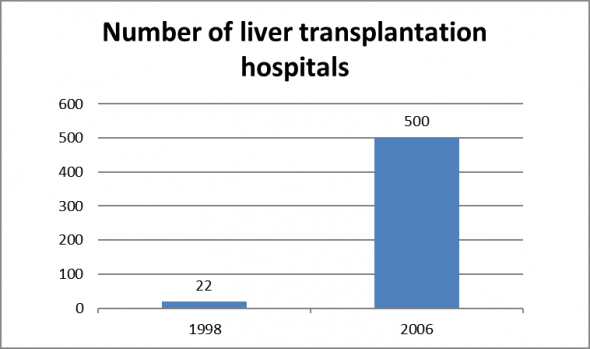
Figure 1.1 Number of hospitals in China capable of performing liver transplantation
II. People.cn: There are more than 1,000 organ transplant hospitals during the peak period of organ transplantation
In 2015, Ye Qifa, the executive chairman of China Organ Procurement Organization Alliance, said that after the introduction of the Human Organ Transplant Regulations in 2007, the number of medical institutions performing organ transplant operations in China had been reduced from over 1,000 to over 160.[4] These hospitals mainly perform liver and kidney transplantation.
As of July 10, 2016, WOIPFG estimated that there were 891 transplant hospitals and 9,519 organ transplant doctors suspected of participating in live organ harvesting.
III. The officially reported liver transplantation volume increased 180-fold from 1999 to 2006
During the more than two decades leading up to 1999, only 135 liver transplant operations were performed in mainland China (Note1), averaging 5 to 6 cases per year. During the 8-year period from 1991 to 1998, Chinese hospitals performed a total of 78 liver transplant surgeries, averaging 9.7 cases per year. By contrast, during the 8-year span from 1999 to 2006, an astronomical 14,589 liver transplant surgeries were carried out in mainland China, with an average of over 1,823 cases per year. This was a 180-fold increase in liver transplant volume. In particular, over almost 18 months, from January 1, 2005 to June 24, 2006, at least 5,644 liver transplants were performed in China.[5-1] The annualized figure would be 3,762 cases, a 387-fold increase from the average annual volume from 1991 to 1998.
Note1: The total was just 135 liver transplant surgeries for 20 years before 1999, this was derived from the following reports.
From 1977 to 1983, there were 18 units where liver transplants could be performed. Among them, 5 of them performed more than five surgeries: 10 cases at the Wuhan Tongji Hospital, 6 cases at the Shanghai Ruijin Hospital, 5 cases at the Affiliated Hospital of Nanjing Medical School, 5 cases at the Affiliated Hospital of Sichuan Medical School, 5 cases at the Guangdong General Hospital. None of the survivors had extended life for more than one year[5-2]. From 1984, the liver transplant in mainland had paused for 7 years (1984-1990). From 1991to 1997, liver transplant surgeries nation-wide totals 46[5-3] in 7 years. From 1991 to 1998, it totals 78[5-4]across the entire country in 8 years.
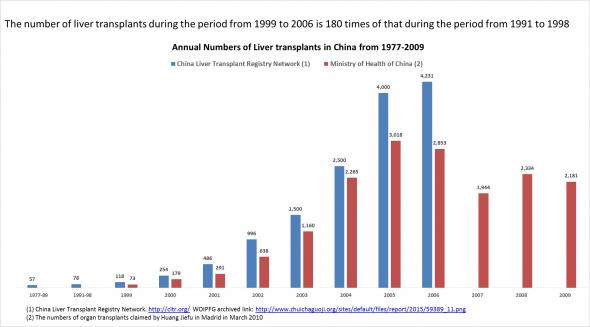
Figure 1.2 Schematic diagram of annual liver transplantation
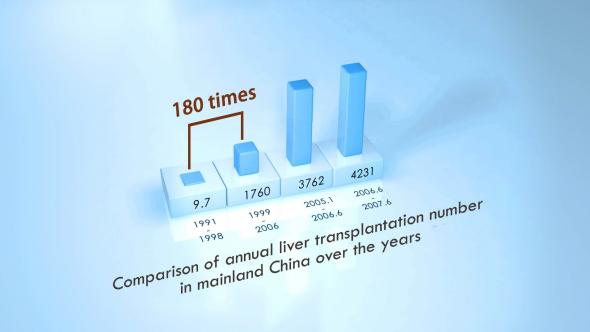
Figure 1.3 Comparison chart of annual liver transplantation
Note 2. Data source of 14,589 liver transplants in the 8 years from 1999 to 2006
1. In 1999, 2000 and 2001, there were 118, 254 and 486 cases implemented respectively[5-5].
2. in 2002 , there were about 1500[5-6].
3. In 2003, more than 1,500 liver transplants were completed nationwide[5-7].
4. In 2004, there were 2,500 liver transplants[5-8].
5. The number of liver transplants during 2005 was nearly 4000[5-9].
6. According to the << China Liver Transplant Registry>>, from June 24 of 2006 to June 24 of 2007, there were 4231[5-10] liver transplant surgeries completed. Therefore, 2115 cases completed in one half of 2006 can be assumed, and nearly 4230 for 2006 entire year.
IV. The annual liver transplant volume increased by 436-fold from the 1990s to 2007
It is hard to imagine that even after the crime of organ harvesting from living Falun Gong practitioners was exposed in 2006, at a time when the CCP was under close scrutiny from the international community, China conducted at least 4,231 liver transplant operations between June 24, 2006 and June 24, 2007.[6] This was approximately 436 times the average annual number of liver transplant surgeries during the period from 1991 to 1998.
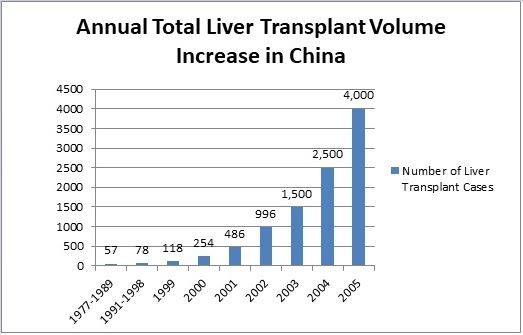
Figure 1.4 Schematic diagram of annual liver transplantation volume increase in China
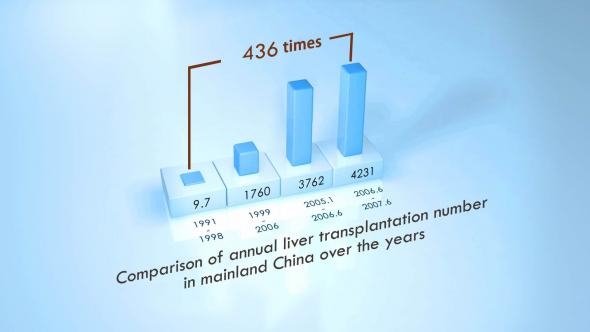
Figure 1.5 Comparison chart of annual liver transplantation over the years
V. Tianjin First Central Hospital’s annual organ transplant volume explosively increased by several hundred or even several thousand times
In May 1994, Tianjin First Central Hospital completed its first liver transplant operation. From 1994 to 1998, 8 cases of liver transplantation were completed in 5 years, with an average of 1.6 cases per year.[7] However, since 1999, the hospital’s annual total number of transplants has been increasing almost geometrically every year: there were 24 cases in 1999, followed by 78 cases in 2000, 129 cases in 2001, 272 cases in 2002, 289 cases in 2003 and 800 cases in 2004[8] (507 cases in 2004 according to another media report[9]). In 2005, 647 liver transplants and 436 kidney transplants were performed.[10] After 1999, hospital’s organ transplant volume has increased by several hundred times.
In particular, please note that the above figures are the numbers released by the CCP, and the actual numbers would be even more shocking. For example, according to our investigation, in Tianjin First Central Hospital, the number of beds in its new organ transplant building increased to more than 500 in September 2006 (another official media reported over 700 beds dedicated to organ transplantation at the building’s opening[11]), and the bed occupancy rate is over 90%, up to 131.1% the highest, and the average hospitalization time of a surgical patient is 25-30 days, thus the actual annual surgery number is more than 5,000 cases per year, and during the peak period, it would be 8,000 cases per year (please see Chapter 9 V. 1 for detailed calculations). The hospital’s liver and kidney transplantation volumes are several thousand times more than the average number before 1999.
(For detailed information, please read WOIPFG’s report titled “THE FINAL HARVEST: A Comprehensive Investigation into the Chinese Communist Party’s Live Organ Harvesting of Falun Gong Practitioners”. http://www.upholdjustice.org/node/338)
VI. The actual transplant volumes of a large number of hospitals are more than 10 times the officially published figures
From the organ transplant volumes of 11 randomly selected hospitals in 2015, we found out that each hospital’s actual minimum organ transplant volume was likely 10-20 times the officially published figure.[12]
|
|
Hospital |
Announced Annual Organ Transplant Volume |
Annual Organ Transplant Volume (conservatively estimated) |
Increase (times) |
|
1 |
Peking University People’s Hospital |
125 |
4,000 |
32 |
|
2 |
Tongji Hospital |
200 |
3,000 |
15 |
|
3 |
The First Hospital of China Medical University |
100 |
2,000 |
20 |
|
4 |
Nanjing General Hospital of People's Liberation Army |
100 |
1,000 |
10 |
|
5 |
Peking Union Medical College Hospital |
1 |
2,000 |
2,000 |
|
6 |
Tianjin First Central Hospital |
1,000 |
5,000 |
5 |
|
7 |
The PLA’s No. 309 Hospital |
200 |
3,000 |
15 |
|
8 |
Nanfang Hospital |
300 |
3,000 |
10 |
|
9 |
The Third Xiangya Hospital of Central South University |
200 |
2,000 |
10 |
|
10 |
Zhongshan Hospital, Fudan University |
400 |
4,000 |
10 |
|
11 |
Renji Hospital of Shanghai Jiao Tong University School of Medicine |
200 |
2,000 |
10 |
|
|
Total |
2,826 |
31,000 |
11 |
Figure 1.6 Comparison chart of actual transplant numbers and published transplant numbers at 11 hospitals
VII. Swift establishment of a large number of organ transplant and tissue typing centers
After 1999, mainland China saw a rapid emergence of a great many organ transplant centers and tissue typing facilities. Many hospitals and medical departments, which were not qualified to perform organ transplants in the past, were quickly converted into organ transplant centers. The basic information of some of these newly established medical facilities are presented in the table below.
Table 1.1 Overview of Organ Transplant Centers and Tissue Typing Centers[13]
|
Hospital Name |
Basic Information |
|
Ministry of Health Forensic Pathology Key Laboratory |
Established in October 1999 at Xi’an Jiaotong University’s Forensic Department, with the consent of the Ministry of Health’s Department of Medical Science, Technology and Education, this key laboratory was co-founded by the Ministry of Health, Ministry of Public Security and the Supreme People’s Court. The laboratory claims that its “research in the fields of organ transplant and tissue typing has reached an advanced international level.”[14] |
|
The People’s Liberation Army (PLA) No.309 Hospital |
Established in April 2002, the Organ Transplant Center of the PLA No. 309 Hospital was jointly founded by the Departments of Urology, Hepatobiliary Surgery and Cardiothoracic Surgery. In August 2005, the Nephrology and Hematology Departments merged into the transplant center. Officially designated the “Organ Transplant Center of the PLA” by the Health Department of the PLA’s General Logistics Department in March 2006, it was again renamed the “Organ Transplant Research Institute of the PLA” by the Health Department of the PLA’s General Logistics Department in 2011. As the hospital’s key revenue center, the Organ Transplant Center saw an increase in its gross revenue from 30 million yuan ($4.5 million) in 2006 to 230 million yuan ($35 million) in 2010 - an eightfold increase in five years.[15] |
|
The PLA Second Artillery General Hospital |
A Liver Transplant Center was established in the PLA Second Artillery General Hospital in July 2004.[16] |
|
General Hospital of the Beijing Military Region |
The hospital’s Hepatobiliary Surgery Department and Liver Transplant Center started clinical liver transplants in 1999. The hospital claims that these surgeries have become routine. Its Hepatobiliary Surgery Department claims to have established a fast and unobstructed channel to procure high-quality donor livers, not only from Beijing and its surrounding areas, but also from other provinces and cities without delay.[17] |
|
The PLA No. 302 Hospital |
A Liver Transplant Center was established in the PLA No. 302 Hospital in 2005.[18] |
|
The PLA No. 307 Hospital |
A Kidney Transplant Center was established in the PLA No. 307 Hospital in 2000.[19] |
|
General Hospital of Chinese People’s Armed Police Forces |
Approved by the General Logistics Department of the Armed Police Forces, an Organ Transplant Research Center in the General Hospital of Armed Police Forces was established in April 2002.[20] |
|
Affiliated Beijing You’an Hospital of Capital Medical University |
Beijing You’an Hospital, affiliated with Capital Medical University, established a Liver Transplant Center in March 2003. In August 2004, the Sino-US Cooperative Center for Liver Transplantation was jointly set up by the hospital and the Thomas E. Starzl Transplantation Institute of the University of Pittsburgh in the US.[21] |
|
Peking University People’s Hospital |
Peking University Institute of Organ Transplantation (formerly named Organ Transplant Center at Peking University) was established in October 2001 under the personal guidance of Han Qide, vice chairman of the standing committee of the 11th National People’s Congress.[22] |
|
The Third Hospital of Peking University |
The Organ Transplant Center in the Third Hospital of Peking University was established in October 2001.[23] |
|
Haidian Hospital in Beijing |
The Organ Transplant Center in Haidian Hospital was established in November 2003.[24] |
|
Zhongshan Hospital, Fudan University |
Established on October 30, 2001, the Zhongshan Hospital Organ Transplant Center performs more than 100 organ transplants every year, with an annual increase of 50 percent.[25] On December 8, 2003, the Organ Transplant Center of Zhongshan Hospital, Fudan University, and Thomas E. Starzl Transplantation Institute of the University of Pittsburgh in the US jointly established a collaborating center, becoming the world’s largest organ transplant organization.[26] |
|
Shanghai First People’s Hospital (aka. Affiliated First People’s Hospital of Shanghai Jiaotong University) |
Shanghai Clinical Center for Organ Transplantation was established in August 2001, affiliated with the Shanghai First People’s Hospital. The Center was founded by combining the “Shanghai Organ Transplant Research Center” and the “Shanghai Tissue Typing Center.” Initially relying on kidney transplants, the hospital currently claims to have performed transplants of the heart, liver, and combined transplants of liver-kidney, pancreas-kidney, kidney-adult pancreas islet cell and other substantive major organ transplants, including corneas, allogeneic fingers, fetal pancreas islet cells, bone marrow, peripheral blood stem cells and cord blood stem cells.[27] |
|
Shanghai Ruijin Hospital |
The Organ Transplant Center in Shanghai Ruijin Hospital was established in 2002.[28] |
|
Shanghai Chest Hospital, affiliated with Shanghai Jiaotong University |
In 2008, Shanghai Chest Hospital set up a “Lung Transplant Clinical Center”. The center provides guidance to many domestic hospitals in carrying out clinical lung transplantation.[29] |
|
Tianjin First Central Hospital |
The Tianjin Institute of Organ Transplantation was established in 2002. The center contains facilities for transplant surgeries, transplantation medicine, transplant ICU, transplant follow-up, anesthesia, imaging, pathology, ultrasounds, transplant laboratories and other departments. The center is able to simultaneously carry out liver transplants, kidney transplants, pancreas transplants, small intestine transplants and heart transplants. This is the largest professional transplant organization in China and the largest organ transplant center in Asia.[30] |
|
Affiliated Southwest Hospital of the PLA’s Third Military Medical University |
Southwest Hospital started clinical liver transplantation in May 1999, and was designated the key laboratory of the PLA for liver transplants in 2001. An International Collaboration Center was established in 2004 with the cooperation between Southwest Hepatobiliary Surgery Hospital and Thomas E. Starzl Transplantation Institute of the University of Pittsburgh in the US.[31] |
|
The First Affiliated Hospital of Wenzhou Medical University |
In 1999, the Department of Organ Transplantation[32] and Organ Transplant Typing Laboratory was established.[33] |
|
Transplantation Medical Engineering Research Center of the Ministry of Health |
Approved by the Ministry of Health, the Transplantation Medical Engineering Technology Research Center was formally established in the Third Xiangya Hospital of Central South University in 2005. During the first three years of its operation, the center successfully carried out several hundred cases of piggyback liver transplantation and more than 1,000 cases of kidney transplantation, as well as multi-organ combined transplants of liver-kidney, liver-pancreas, liver-intestine and pancreas-kidney. It also performs spleen transplantation, pancreas transplantation, heart transplantation, split liver transplantation, living-related liver transplantation, and thyroid and parathyroid transplants, as well as transplantation of cells from livers, spleens and pancreases.[34] |
|
Multi-organ Combined Transplantation Research Key Laboratory of the Ministry of Health |
The Key Laboratory for Multi-organ Combined Transplantation Research, under the Ministry of Health, was established in March 2001. Located in the First Affiliated Hospital of Zhejiang University School of Medicine, the laboratory has built up dedicated clinical sites for liver transplantation, kidney transplantation, bone marrow transplantation, and heart and lung transplantation. Their multi-organ combined transplantation project has been recommended by the Ministry of Health and provides technical support to more than 20 provincial and municipal hospitals.[35] |
|
Changzheng Hospital, affiliated with Second Military Medical University of the PLA |
The Organ Transplant Center in the Changzheng Hospital was established in early 2003 by combining the Department of Urology and the General Surgery Liver Transplantation Department. On December 17, 2003, the center was approved by the General Logistics Department of the PLA to become the first organ transplant institute of the PLA.[36] |
VIII. Chinese organ surplus creating an international organ transplant tourism fever
Sanlian Life Weekly reported in 2004 that in just a few years, tens of thousands of overseas patients had come to China for organ transplants, setting off an “organ transplant tourism”. This article described the thriving organ transplant tourism: “In addition to Koreans, Tianjin First Central Hospital (the Orient Organ Transplant Center) also has patients from nearly 20 countries and regions in Asia, including Japan, Malaysia, Egypt, Pakistan, India, Saudi Arabia, Oman, Hong Kong, Macao and Taiwan.”
Phoenix Weekly also reported that tens of thousands of foreigners came to China for organ transplants. The mainland China had become an emerging center for organ transplants worldwide.[37]
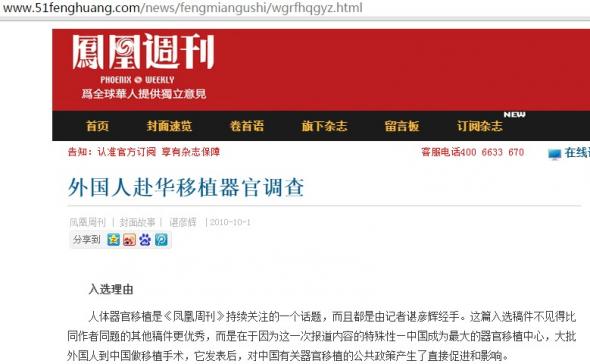
Figure 1.7 Phoenix Weekly: Tens of thousands of foreigners went to China for organ tourism before 2006
IX. Falun Gong practitioners’ organs were smuggled into Israel
In August 2007, the Israeli authorities arrested four human organ smugglers, who confessed that the organs were from Chinese political prisoners, executed prisoners and Falun Gong practitioners. This piece of news was published in Yediot Aharonot, the largest newspaper in Israel.
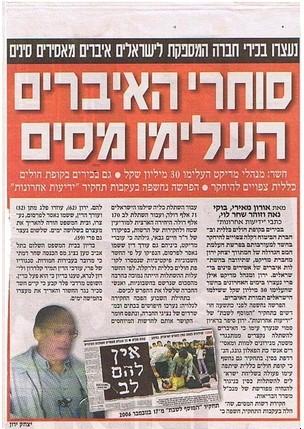
Figure 1.8 An Israeli newspaper reported one case of human organ smugglers
Chapter 2: Organ Transplantation Intensified after the CCP’s Large-Scale Live Organ Harvesting against Falun Gong Practitioners was Exposed in 2006
The CCP’s systematic, large-scale organ harvesting from living Falun Gong practitioners held in the Sujiatun Concentration Camp in Liaoning Province of northeastern China was exposed by the international media on March 9, 2006. Facing the allegations, the CCP and China’s organ transplant industry kept silent for three weeks. The Foreign Ministry spokesperson then denied the existence of the camp. In the meanwhile, “Interim Provisions to Manage Clinical Applications of Human Organ Transplant Technologies”[38] were issued and stated that the CCP would start screening organ transplant hospitals on July 1, 2006 for qualification, and that starting from May 1, 2007, unqualified hospitals could no longer carry out organ transplants. After the Interim Provisions were announced, many hospitals across China saw a dramatic increase in their organ transplant operations. Hospitals nationwide suddenly had a large number of organs available, and medical staff had to work overtime to transplant organs. This nationwide organ transplant rush lasted at least until May 1, 2007, for a period of more than one year.
I. Working overtime for intensive organ transplants
In 2006, Minghui.org received a large number of reports from inside China, claiming that the quantity of organ transplant surgeries in many hospitals had suddenly increased. For example, starting from March 2006, the Tianjin Hospital of Armed Police Forces had performed a large quantity of kidney transplant surgeries. These surgeries would take place every day, and six surgeries could be performed each night. These transplant recipients were discharged as soon as their conditions slightly improved, in order to increase the ward bed turnover ratio. The patients were told that the organ donors were “criminal youths.”[39]
II. Organ surplus led hospitals to slash prices and even offer free organ transplants for sales promotion
1. Jilin Heart Hospital offered a sales promotion – only 50,000 yuan for the first five heart transplant operations[40].
On April 12, 2006, Jilin Heart Hospital offered a “sales promotion,” charging only 50,000 yuan ($7,500) for the first five heart transplants.
2. Hunan People’s Hospital offered 20 free liver and kidney transplants
On April 28, 2006, Hunan People’s Hospital advertised that the hospital was offering 10 liver transplants and 10 kidney transplants free of charge,[41] suggesting that a large number of organs needed to be dealt with urgently.
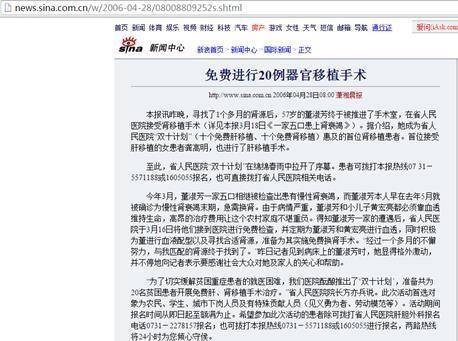
Figure 2.1 Screenshot of Hunan People’s Hospital’s advertisement offering 20 free liver and kidney transplants on April 28, 2006
III. With abundant donors, recipients can specify the date of organ transplantation
Table 2.1 List of Some “Rushed” Organ Transplantation Cases
|
Hospital |
Rushed Organ Transplantation Example |
|
Hunan People’s Hospital |
In 2006, Hunan People’s Hospital offered a “Double 10 Program” (10 free liver transplants and 10 free kidney transplants).[42] |
|
Dongguan Taiping People’s Hospital |
During the first three months of year 2006, over 300 cases of kidney transplantation were performed by surgeons working overtime.[43] From 2003 to 2005, the annual transplant volumes were only 360 cases, 260 cases and 160 cases, respectively. |
|
Guangdong Southern Medical University, Huizhou Union Hospital |
There were many donors on April 11 and 12, 2006.[44] |
|
West China Hospital of Sichuan University |
Around May 2006, a nurse of West China Hospital said that they had ample organs, “We have done six kidney transplants today.” |
|
Shanxi Armed Police Corps Hospital |
In 2006, a doctor said, “If you want to do it (organ transplant), this Thursday would be OK. We will have a large number of donors on Thursday. For only this month of April. We have (donors) this week, next week and the week after next!” [45] |
|
The PLA No. 181 Hospital in Guangxi |
“From the beginning of May 2006 to the end of June 2006, there are now donors...Come over right now, the liver and kidney can be transplanted at the same time.” [46] |
|
Urology (Kidney Transplantation), Guangzhou General Hospital of Guangzhou Military Region |
A doctor said that the kidney supplies were rich and that there would be living donors available next Monday (April 11, 2006), aged 25 to 30 years old.[47] |
|
First Affiliated Hospital of the First Military Medical University of the People’s Liberation Army (Guangzhou, Nanfang Hospital) |
(Regarding liver transplantation): “Try to come over; it can be done on Saturdays. There will be a lot of donors in April 2006 and a few batches next week... We perform close to 100 cases a year. Come over as soon as possible, and you can come on Saturdays and Sundays.” [48] |
IV. Phone Investigation Recordings
1. “Donors are available every day. The organs are all from living persons; donors are all alive.”
Subject of Investigation: Dr. Dai of the Department of Organ Transplantation at the Affiliated Hospital of Jiaotong University in Shanghai
Date: March 16, 2006 (Phone number: 01186-216-3240090)
(Recording 1: MP3; Transcript Download: pdf1)
Following are excerpts from the recorded conversation between a WOIPFG investigator and the Affiliated Hospital of Jiaotong University in Shanghai:
Investigator: Hello. May I have the number of your liver transplant center?
Operator: Please wait while we are transferring you.
……..
Doctor Dai: Let me tell you, it should be okay to have a liver transplant in your case.
Investigator: I just want to know how long we have to wait.
Doctor Dai: Donors are available every day. Today, for example, we are performing a transplant surgery.
Investigator: Well, I mean not just a fresh one. We need one from a living human…
Doctor Dai: Sure, the organs we use are all from living persons. The donors are all alive.
Investigator: What?
Doctor Dai: They are all organs from living persons!
Investigator: Then I want to know how long your transplant center has been in operation. I want to find out your surgeons’ skill level.
Doctor Dai: We’ve been doing this for 5-6 years. We have performed this type of operations for 5-6 years already.
Investigator: Then how many do you do per month?
Doctor Dai: We can do 400 to 500 cases.
Investigator: 400 to 500 cases?
Doctor Dai: Yes, that’s right.
Investigator: So you do 400 to 500 transplants every year?
Doctor Dai: No. This year we just started after the Chinese New Year, but so far we’ve done more than 10 cases, 20 to 30 cases already. Each year we did about 100 to 200 transplants.
Investigator: All these organs, they must come from healthy persons. We need the healthy one.
Doctor Dai: I’ll make sure that you’re satisfied after you come…
Investigator: I heard some come from those who practice (Falun) Gong. They are very healthy.
Doctor Dai: Yes, we have this type, but I cannot explain to you clearly over the phone.
Investigator: If you could find me one, I will come right away.
Doctor Dai: Of course. Just come over!
Investigator: Oh, you could. Then how do I find you? What’s your last name? I will look for you.
Doctor Dai: I’m Doctor Dai.
Investigator: Which Dai?
Doctor Dai: The ‘Dai’ as in ‘dai mao’ (=wear a hat).
2. “What we have here is all this type of (Falun Gong practitioner donors).”
Subject of Investigation: A surgeon at the Liver Transplantation Center at the Affiliated Zhongshan Hospital of Fudan University
Date: March 16, 2006 (Phone number: 86-21-64041990, ext. 2355)
(Recording 2: MP3; Transcript Download: pdf2)
Nurse: Yes, transplant ward.
Investigator: Is this the Liver Transplant Center?
Nurse: Yes. How may I help you?
Investigator: I want to consult about my illness.
Nurse: Please wait. I will get you a doctor.
Doctor: Hello, hello.
Investigator: Hello. Is that a doctor? Can you do a transplant surgery?
Doctor: Yes, we can.
Investigator: How long do I have to wait?
Doctor: About a week after you come.
Investigator: Are there any organs from Falun Gong practitioners? I heard that this kind is generally very good…
Doctor: What we have here are all this type.
Investigator: Oh, the healthy ones all come from Falun Gong practitioners, and they are fresh, usually within how many hours?
Doctor: It should be okay within 24 hours, but we generally control it within 10 hours.
……
3. “I want to know if you have this type (of Falun Gong practitioners’ organs)?” “You just need to come over.”
Subject of Investigation: A doctor at the Qianfoshan Liver Transplant Center in Shandong Province
Date: March 16, 2006 (Phone number: 0118653182968900)
(Recording 3: MP3; Transcript Download: pdf3)
Following are excerpts from the recorded conversation between a WOIPFG investigator and the Qianfoshan Liver Transplant Center in Shandong Province
Hospital operator: Hello.
Investigator: Hello. Is that the ward of Shandong Qianfoshan Liver Transplant Center?
Hospital operator: Yes.
Investigator: I’d like to consult about…
Hospital operator: Please wait. I’ll get a doctor for you.
Investigator: OK.
Doctor: Hello.
Investigator: Hi. I’d like to ask a few questions. How long have you been performing liver transplants? Do you…
Doctor: We started in year 2002.
Investigator: From 2002 to present?
Doctor: More than four years.
Investigator: As for the liver supplies, usually how long can you preserve them (for transplants)?
Doctor: The rule stipulates it to be (less than) 12 hours. So far, we haven’t exceeded 12 hours. The ones we have are all pre-checked.
Investigator: There are some livers from Falun Gong practitioners. So I want to know if you have this type or not?
Doctor: Um. You just need to come over.
Investigator: So you mean you have this type?
Doctor: Well, let me tell you, you just come over…um…we will sure to get more of this type in April, and the number of those suppliers is gradually increasing now.
Investigator: Why will there be more in April?
Doctor: I cannot tell you that because it involves... it doesn’t mean…Anyway, there is no need to explain this to you. This question can’t be answered.
4. “Do you get enough supplies of living prison donors, such as those who practice Falun Gong?” “Yes, sure.”
Subject of Investigation: A nurse from the Urinary Surgery Department at Wuhan Tongji Hospital
Date: March 30, 2006 (Phone number: 011862783662688)
(Recording 4: MP3; Transcript Download: pdf4)
Following are excerpts from a recorded conversation between a WOIPFG investigator and Wuhan Tongji Hospital:
Investigator: Hello. Is that the Wuhan Tongji Hospital?
Nurse: Yes, it is.
Investigator: Is that the Urinary Surgery Department? We need to have a kidney transplant.
Nurse: Yes, this is the department for kidney transplants.
Investigator: When did you start doing kidney transplants on a large scale?
Nurse: We are the earliest place. We started a long time ago.
Investigator: How many operations do you do each year?
Nurse: Our hospital is the place, where the largest number of transplants have been done. In the entire Hubei area, our department is the most productive one. We’ve done a lot, because we have ample organ donors.
Investigator: From a patient’s perspective, live kidney sources are preferred. So we are looking for live organ transplantation from prisoners, for example, from those who practice Falun Gong. Is it possible?
Nurse: Sure.
Investigator: So do you get enough supplies of living prison donors, such as those who practice Falun Gong?
Nurse: Yes, sure. When you are ready, you can come over directly, and we will discuss it in detail.
5. “If you could obtain Falun Gong practitioner kidney sources in this period of time, let me know, okay?” “No problem, you come over.”
Subject of Investigation: Zhu Yunsong, the director of Organ Transplant Departmenet at the General Hospital of Guangzhou Military Command of the PLA
Date: April 12, 2006 (Phone numbers: 0118613602703460, 011862036222653)
(Recording 5: MP3; Transcript Download: pdf5)
Following are excerpts from a recorded conversation between a WOIPFG investigator and Zhu Yunsong:
Investigator: Is that Director Zhu of Guangzhou Military Region General Hospital?
Zhu: Yes, speaking.
Investigator: I am working at the No. 304 Hospital from Beijing, and I have two relatives here. Right now we do not have enough kidney supplies. We used to do lots of such surgeries in years 2001, 2002, 2003 ...
Zhu: Yes, I know.
Investigator: We found that kidneys from young donors are good. Another thing is that the kidneys from Falun Gong detainees are relatively good. Do you have this kind of kidney sources from Falun Gong detainees?
Zhu: We do not have many Falun Gong (practitioners’ kidney sources).
Investigator: You still have some of this kind (of kidneys from Falun Gong practitioners)?
Zhu: It is not difficult to find Type B kidneys (from Falun Gong practitioner donors). If you want, you can come. We will do it pretty soon, definitely can be arranged before May 1.
Investigator: Do you have one batch prior to May 1?
Zhu: We will have several batches.
Investigator: How about after May 1?
Zhu: If you wait until after May 1, it will likely to be after May 20.
Investigator: If you could obtain Falun Gong practitioner kidney sources in this period of time, let me know, okay?
Zhu: No problem, you come over and we can talk then...
Chapter 3: Since 2006, the Organ Transplant Volume has been Increasing Steadily in China
For a long period of time, due to the CCP’s deliberate misleading propaganda, the international community has been led to believe that the number of organ transplants in China decreased after 2006. However, the reality is just the opposite. Organ transplantation in communist China continues to expand in scale, and the number of ward beds dedicated to transplant patients increases every year. The average occupancy rate for these ward beds is 103 percent, with the rate being as high as 131.1 percent in some hospitals. In order to bring in more in-patients and lessen the heavy workload of their kidney transplant departments, some hospitals have shortened the average length of hospital stay for their organ transplant patients; and transplant surgeons are kept busy throughout the entire year. This is the actual situation caused by a large volume of organ transplants.
The following are officially published data by the CCP regime.
I. The number of ward beds increases and their occupancy rates are very high
1. The number of ward beds in the Organ Transplant Center of the PLA No. 309 Hospital increased from 316 in 2010 to 393 in 2012
The gross income of the hospital’s Organ Transplant Center was 30 million yuan in 2006, and it rose to 230 million yuan in 2010, an increase of nearly 8-fold in 5 years.[49]
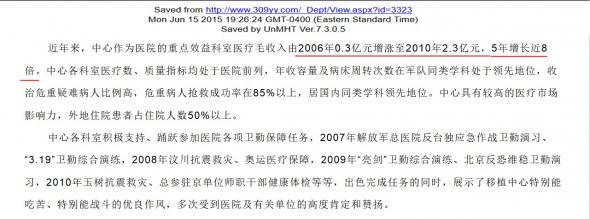
Figure 3.1 Screenshot of the PLA No. 309 Hospital’s Web Page
2. At Tianjin First Central Hospital’s Organ Transplant Center, the number of ward beds increased from 120 to over 500; the bed occupancy rate in 2013 reached 131.1 percent[50]
In September 2006, the number of ward beds at the Organ Transplant Center of Tianjin First Central Hospital increased from 120 beds to over 500 beds in total. (Another official CCP media reported that there were more than 700 beds for organ transplants at the time of the hospital’s new building’s opening[51]). The bed occupancy rate reached as high as 131.1 percent.
This transplant surgery center has facilities to perform 17 liver and kidney transplant operations simultaneously (9 liver transplants and 8 kidney transplants).
3. At Shanghai Renji Hospital, the number of beds for transplant patients increased from 13 in 2004 to 110 in 2014
In October 2004, the hospital increased the number of beds at its liver transplant center from 13 to 23.[52]
In June 28, 2007, the Chinese Organ Transplantation website showed that this liver transplant center had 90 beds. [53]
In 2014, the number of liver transplant beds was increased to 110.
On June 28, 2007, the Chinese Organ Transplantation website reported that the Renji Hospital Organ Transplant Center was equipped with Class 100 horizontal laminar flow operating rooms and Class 10,000 horizontal laminar flow wards and was capable of performing 6 liver transplant operations simultaneously.[54]
4. The Organ Transplant Center at Sichuan People’s Hospital had 8 beds in 2007, and the number was increased to more than 100 in 2011[55]
When founded in 2007, the Organ Transplant Center at Sichuan People’s Hospital had only five physicians, five nurses and eight beds for transplants. As of January 2011, it was a clinical surgery center with 12 physicians, 27 nurses and more than 100 beds.[56]
5. At Eastern Hepatobiliary Surgery Hospital in Shanghai, a specialist hospital for liver and gallbladder issues, the ward bed number increased from 742 to 1,500 in 2015
The hospital had 742 beds in early 2015.[57] In October 2015, due to its expanding business, the hospital constructed a new wing, bringing the total number of beds to 1,500,[58] doubling the original number. Wu Mengchao, president of the hospital, boasted that “our liver transplant volume now is the largest in the world”.
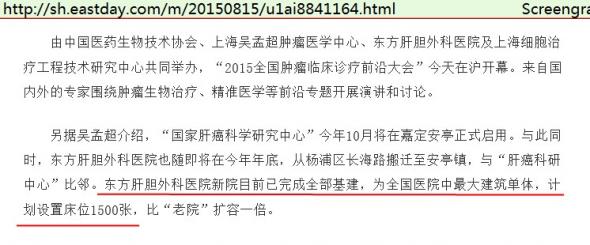
Figure 3.2 Screenshot of the Eastday Website in August 2015
6. The average bed occupancy rate of Class A tertiary hospitals in China is 103%[59], and the average hospital stay is 20-30 days
II. After 1999, China’s organ transplant industry has always been in a hectic state throughout the year
Since 1999, the organ transplant sector in China has been in an exceedingly hectic state throughout the year. This has not been a short-term phenomenon, nor is it simply isolated cases found at a small number of hospitals. Instead, this is prevalent across China, and the pattern is consistent throughout the year. The following are some examples.
1. At Tianjin First Central Hospital, surgeons were so busy that they had to work overtime on weekends and holidays
According to an article from the Chinese Organ Transplantation Website in February 2006, the surgeons of the Organ Transplant Department at Tianjin First Central Hospital were so busy shuffling between hospital wards and operation rooms that they didn’t even have time to greet one another. They were often heard saying, “Too busy these several days, more than 10 operations a day.” Some surgeons were “too busy to go home.”

Figure 3.3 Report of the Chinese Organ Transplantation Website in February 2006
2. Zhengzhou People’s Hospital had kidney transplantation surgeries every night
During the Chinese New Year holiday season of 2007, Zhengzhou People’s Hospital had kidney transplantation surgeries every night. On December 27 alone, the hospital completed 13 kidney transplant surgeries.[60]
According to an article published on the “Chinese Etiquette Training Network” in April 2010, “Around the Chinese New Year in 2007, surgeon Xing Li contracted conjunctivitis in his right eye from overworking for days on end, often performing surgeries from 2 am or 3 am to the following day. Since Xing Li had to do operations in such a manner without any rest every night, he had to ask his assistants to help clean his infection.” [61]
3. Average length of hospital stays for kidney transplant recipients were decreased in order to relieve the heavy workload of the hospitals’ kidney transplant division
In 2013, West China Hospital of Sichuan University improved its third comprehensive ward. They shortened the average length of hospital stays for kidney transplant patients for postoperative care to 10 days, greatly increasing the bed turnover rate.[62]
4. At the First Affiliated Hospital of Zhengzhou University of Henan, the number of kidney transplants continues to increase
The Kidney Transplant Department at the First Affiliated Hospital of Zhengzhou University in Henan Province completed 149, 173 and 230 kidney transplant operations in 2012, 2013 and 2014, respectively.[63-1]
Chapter 4: The Existence of a Massive Living Organ Donor Pool
Typically, tissue match rate is quite low for major organ allotransplantation. Davis Heath (UC) website says “Except for identical twins and some brothers and sisters, it is very rare to get an exact match between two people, especially if they are unrelated.” The chance of finding an exact Human leukocyte antigen (HLA) match with an unrelated donor is extremely low, “about one in 100,000” (Davis Health) [63-2]. It is exceedingly difficult. This is also why patients in many developed countries, such as the United States, have to wait for organs to become available (i.e. forward matching) and the wait time is usually two to three years.
However, in mainland China, after the persecution of Falun Gong started in July 1999, the phenomenon of organs waiting for patients to show up (i.e. reverse matching) emerged, and the wait time would be as short as 1-2 weeks, or even a few hours. That is, they have enough living organ donors for the patients to choose from, and once a patient appears, a suitable donor can be found immediately.
According to a report on Xinhua’s website dated March 24, 2012, former U.S. Vice President Dick Cheney received a heart transplant in the U.S. after being on a donated organ waiting list for nearly two years.
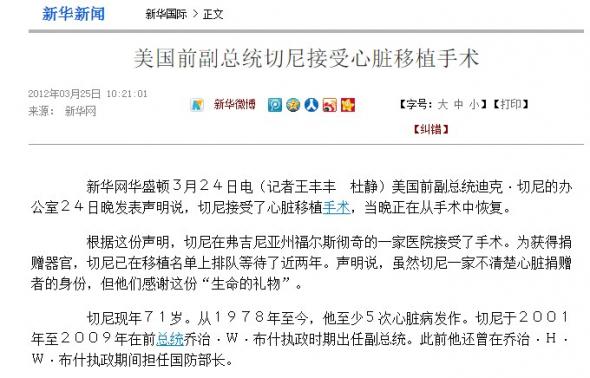
Figure 4.1 News article about former U.S. Vice President Dick Cheney receiving a heart transplant
The U.S. has an extensive organ donation network with more than 120 million people registered as voluntary organ donors.[64] Even so, on March 29, 2006, a Metro article entitled “An Age of Donating Organs Online” reported that the average wait time for a kidney transplant surgery was 3 to 7 years. According to a report by the United States Department of Health and Human Services in 2007, the average wait time for a liver and kidney in the United States is 2 and 3 years, respectively. [65]
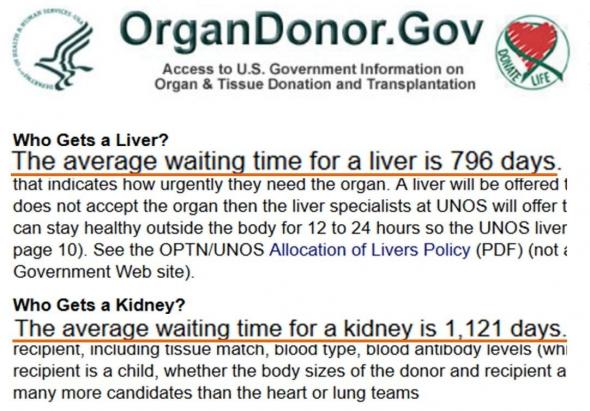
Figure 4.2 Average wait times for donated organs in the U.S.
Evidence I: Reverse matching in China, with organs waiting for patients and an average wait time of 1 to 2 weeks
After 1999, a particular strange phenomenon appeared in China’s organ transplant industry: the wait times for transplant organs became extremely short, and the country had an oversupply of organs. There appeared to be so many donors that China alone couldn’t use all of their organs. Hospitals in China started marketing and promoting organ transplants to patients from all over the world. Tens of thousands of foreign “organ transplant tourists” have traveled to China for transplant operations, because the average wait time for an organ could be 2 to 4 weeks, and sometimes even as short as 1 to 2 weeks. Available organs would be waiting for transplant patients, which is called reverse matching, and this phenomenon is never found anywhere else in the world.
Several examples of hospitals’ websites showing ultra-short organ wait times:
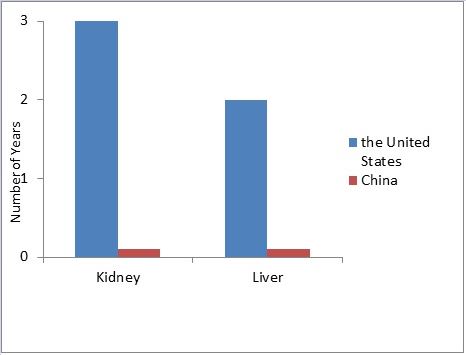
Figure 4.3 The average wait times for transplant organs in China and in the U.S.
1. The average organ wait time in Shanghai Changzheng Hospital’s Transplant Center is one week
Shanghai Changzheng Hospital’s Transplant Center clearly stated on its liver transplant application form that the average wait time for a liver transplant was one week.
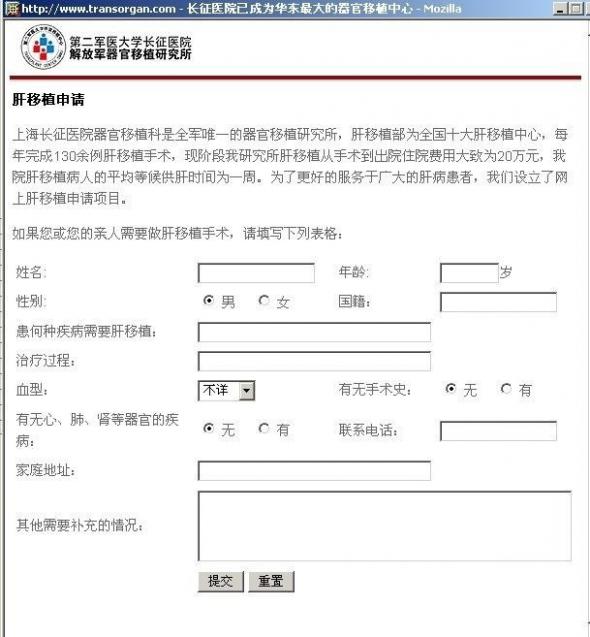
Figure 4.4 Online liver transplant application form of the Organ Transplant Center at Shanghai Changzhen Hospital.
2. The average wait time in the Orient Organ Transplant Center of Tianjin First Central Hospital is two weeks
The official website for the Orient Organ Transplant Center of Tianjin First Central Hospital stated that the center completed 647 liver transplant surgeries in 2005, and the average wait time was two weeks. The web page has since been removed, but WOIPFG investigators recovered a cached online copy.[66]
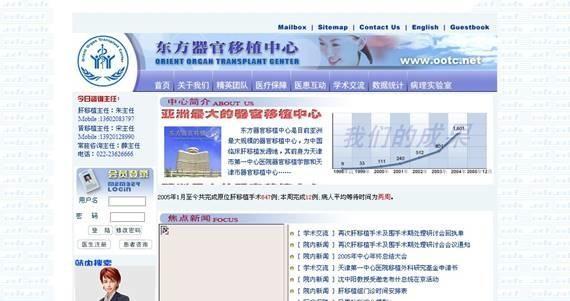
Figure 4.5 The Orient Organ Transplant Center claimed that their average organ wait time was two weeks in 2005
3. More startling: if any problem arose at the last minute with the organ donor, hospitals in China were able to source a replacement organ easily and the surgery could be performed within one week
According to its website, the International Transplantation (China) Online Support Center of The Chinese Medical University Affiliated Hospital in Shenyang offered a special service: if any problem arose with the provided donor at the last minute, the center would find another matching donor and perform another surgery within one week.
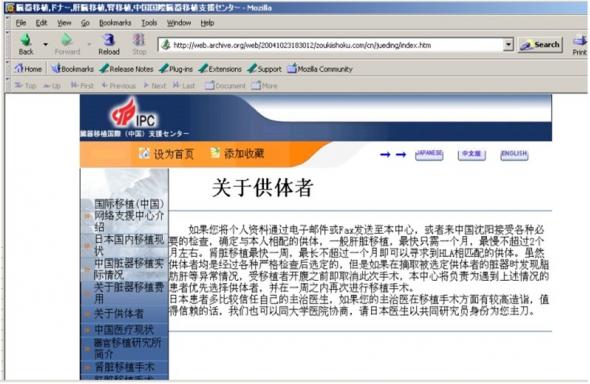
Figure 4.6 International Transplantation (China) Online Support Center
4. “We have abundant donors now and can select young and healthier ones.”
Subject of Investigation: Chen Yongfeng from the Liver Transplantation Department of Zhengzhou People’s Hospital
Date: June 26, 2015 (Phone number: 8613623711903)
Chen Yongfeng said that on the day of the phone investigation, two operations were performed, one donor was 16 years old, and the other was 24 years old. He said, “We have abundant donors now and can select young and healthier ones. But in the future, we don’t know if things are still like this. We all selected people less than 40 years old. Donors can be found within a week.”
(Recording 6: MP3; Transcript Download: pdf6)
5. “The shortest (organ) wait time is 2 or 3 days, the longest is more than 10 days.” “We have plenty of donors.”
Subject of Investigation: An on-duty doctor from Liver Transplantation Ward at People’s Hospital of Zhengzhou
Date: June 25, 2015 (Phone number: 8637163933151)
On June 25, 2015, a doctor on duty at the Department of Hepatobiliary Surgery of Zhengzhou People’s Hospital told a WOIPFG investigator, “The shortest wait time for a donor is approximately 2-3 days, in general. The longest would be about 10 days. The cost is about 500,000 yuan (approx. USD 78,000). We have a lot of donors.” When asked why their wait time is so short and about the source of their donors, the doctor said, “For this matter, um, I cannot provide any answers. I can’t. Don’t ask. Don’t ask these questions. The organs are directly sent to our operating rooms every day, one or two operations every day, guaranteed.”
(Recording 7: MP3; Transcript Download: pdf7)
6. “The patients come here at night and we do the liver transplantation surgeries overnight. That is very common here.”
Subject of Investigation: Li Gongquan, liver transplantation doctor of the First Affiliated Hospital of Zhengzhou University
Date: March 19, 2015 (Phone number: 8637166862192)
On March 19, 2015, Doctor Li Gongquan, a liver transplant surgeon at Zhengzhou University First Affiliated Hospital told a WOIPFG investigator over the phone, “It could be done within a week. If you want, we can do organ matching with him…”
(Recording 8: MP3; Transcript Download: pdf8)
Evidence II: Killing on demand, as the percentage of emergency liver transplant operations is as high as 26.6 percent
An emergency liver transplant is an urgent liver transplant operation performed on patients with acute, serious liver problems and less than 72 hours to live. Due to the difficulty of urgent tissue typing and the extended wait time for a donor, emergency liver transplant operations are rarely performed outside of China. In China, however, emergency liver transplants have become a common operation since 1999. Here are some examples:
1. The percentage of emergency liver transplants is as high as 26.6 percent of all liver transplants
According to data from The 2006 Annual Report on China Liver Transplant Registration[67], 8,486 cases of liver transplants were performed in 29 organ transplant centers from April 6, 2005, to December 31, 2006. Among these, 4,331 cases had specified whether or not they were emergency transplants, indicating a total of 1,150 emergency liver transplants performed, or 26.6 percent of those 4,331 cases. One patient received a liver transplant operation only four hours after becoming hospitalized. This was the fastest transplantation recorded in the data set.
The 2006 Annual Report on China Liver Transplant Registration
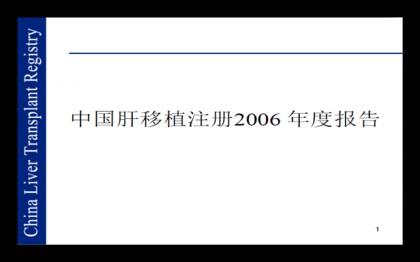
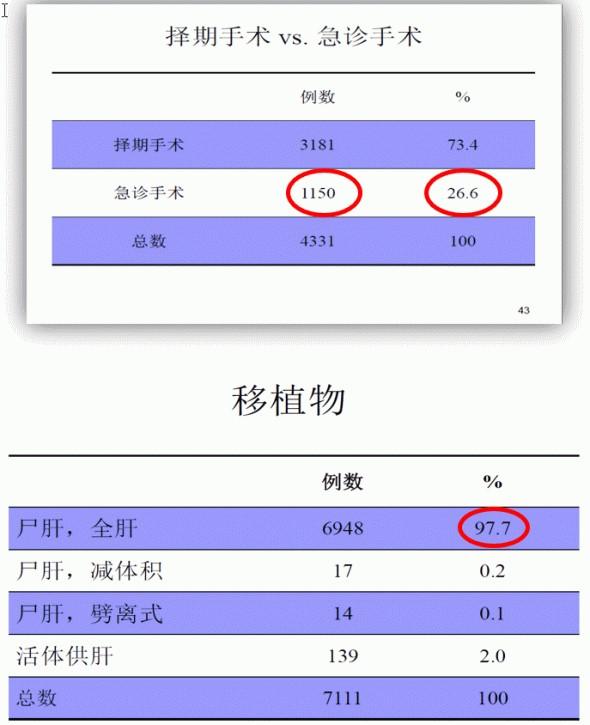
Figure 4.7
|
Selective Operations VS Emergency Operations |
||
|
|
Number of Cases |
Percentage |
|
Selective Operations |
3,181 |
73.4% |
|
Emergency Operations |
1,150 |
26.6% |
|
Total |
4,331 |
100.0% |
|
Transplanted Organs |
||
|
|
Number of Cases |
Percentage |
|
Cadaveric Livers, Full Liver Operations |
6,948 |
97.7% |
|
Cadaveric Livers, Size-decreasing Operations |
17 |
0.2% |
|
Cadaveric Livers, Split Liver Operations |
14 |
0.1% |
|
Living Donor Liver Operations |
139 |
2.0% |
|
Total |
7,118 |
100.0% |
Analysis
1) First, this is a state-level annual report.
2) The report clearly stated that emergency organ surgeries accounted for 26.6%. That is, over one quarter of the donor organs were obtained on demand at any time.
3) These readily available organs could not be normally donated organs or organs from executed prisoners. This is because the supply of donated organs would be unpredictable, and the execution of death-row prisoners would be carried out at a specific time and place as decided and confirmed by the Supreme Court. It is impossible that a hospital in need of an emergency liver transplant would be able to randomly change a court decision and execute a death-row prisoner at will.
4) In order to supply livers for a large number of emergency liver transplant cases, which accounted for 26.6%, an enormous number of individuals would be readily available for tissue typing and organ excision. This is because blood type matching and tissue typing required for organ transplants would have very low success rates.
5) The report shows that full cadaveric liver operations accounted for 97.7% of the total transplanted organs. That is, one liver transplant would basically take one person’s life.
In summary: These donor organs were readily available in large quantities for killing and excision at any time. Therefore, an enormous living organ donor pool was in existence!
2. Shanghai Changzheng Hospital performed 120 emergency liver transplants within three years, with the shortest organ wait time being 4 hours after admission
Shanghai Changzheng Hospital, an affiliated hospital of the Second Military Medical University, performed 120 emergency liver transplant operations during the three-year period from 2003 to 2006. The shortest wait time for receiving an organ transplant after the patient was admitted into the hospital was four hours.[68]
3. Two kidney transplants were performed on the same patient within 48 hours
According to a Huaxia Times article published on May 17, 2006, Han Xiuwu, a chief surgeon at Beijing Haidian District Hospital’s Organ Transplant Center, completed two kidney transplant operations on the same patient within 48 hours on the afternoon of December 28, 2004. The first operation failed due to hyper-acute rejection, so Han conducted the second kidney transplant on the following day.[69]
The article cited some comments from the general public: “In other countries, patients usually have to wait a few years for a precious kidney. But Haidian Hospital could obtain kidneys as easy as if they were pigs’ kidneys. The first donor kidney was acquired within nine days. As for the second kidney, they could just go and get it. Isn’t this strange?”
Evidence III: Multiple spare organs available for one transplant recipient
1. One kidney transplant patient was matched against eight donor kidneys
According to Bloody Harvest - Revised Report into Allegations of Organ Harvesting of Falun Gong Practitioners in China, Tan Jianming of the Kidney Transplant Center at Fuzhou General Hospital of the Nanjing Military Region performed a kidney transplant at Shanghai First People’s Hospital in 2003.[70] Prior to the transplant operation, over the course of more than two months, the surgeon had performed tissue-typing tests for the patient with eight spare kidneys. The first seven tests failed due to the patient’s antibody rejection. The eighth kidney was matched successfully and the operation was performed.[71]
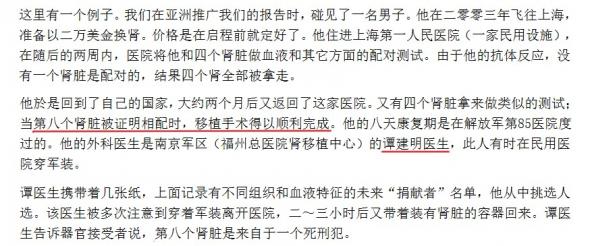
Figure 4.8 Bloody Harvest: Revised Report into Allegations of Organ Harvesting of Falun Gong Practitioners in China by David Matas and David Kilgour (Feb 25th, 2007).
People’s Daily reported that Tan Jianming, director of the Shanghai Organ Transplantation Research Center had performed more than 4,200 cases of kidney transplantation by June 2014.[72]
Comparison between China and the United States:
The former U.S. Vice President Dick Cheney waited for almost two years to obtain an organ on March 24, 2012. At that time, in the United States, there were 120 million voluntary donors and an advanced organ deployment network system.
In China, in 2003, an ordinary patient just waited for two months (about eight weeks) to get eight organs, which implies one organ per week. However, before year 2005, hardly anyone volunteered to donate their organs. And there was no national network deployment system before 2013.
2. Huang Jiefu performed a liver transplant with three spare livers from three living persons
According to articles from official state-run media www.xinhuanet.com reprinting from www.xjbs.com.cn, www.sina.com reprinting from Urumqi Evening News, Today’s Nurse periodical,[73] and Phoenix Weekly, while accompanying Luo Gan, the then-Secretary of the CCP’s Central Political and Legal Affairs Commission (PLAC), to attend the 50th anniversary celebration for the establishment of the Xinjiang Uyghur Autonomous Region, the then-Vice Minister of Health, Huang Jiefu, demonstrated an autologous liver transplant operation at the First Affiliated Hospital of Xinjiang Medical University on the afternoon of September 28, 2005. Huang used three spare livers for the operation, which are suspected from living persons (see analysis in Section 3 for details).
Phoenix Weekly reported: “When Huang Jiefu opened the abdominal cavity of a 46-year-old liver cancer patient named Yao Shufa (the 4th Issue of Today’s Nurse reported that the patient’s name was Yao Dongqiang)[74], he discovered that the liver’s condition was suitable for autologous liver transplantation, which he has been dreaming about conducting. An autologous liver transplantation would mean to remove the patient’s liver first, cut off the tumor or lesion on the liver, and then place the liver back into the patient’s body.” So Huang Jiefu decided on the spot to change the original surgery plan and to perform an autologous liver transplantation instead.
An autologous liver transplant would take more than a dozen hours to perform. And afterwards, it would take another 24 hours of observation to determine whether it is successful or not. During this process, if the surgery failed, he would have to conduct an allogeneic liver transplant. Otherwise, the patient would die immediately.
So Huang asked another surgeon to suture the incision, and he immediately contacted the First Affiliated Hospital of Sun Yat-Sen University in Guangzhou City and the Southwest Hospital affiliated with Third Military Medical University in Chongqing City, and instructed them both to provide a spare liver. According to the article on Today’s Nurse, suitable spare livers “with matching blood types and gene loci” were found by the two hospitals within several hours of Huang’s request on the afternoon of September 28. “At 6:30 pm on September 29, a matching liver arrived from Chongqing. Three medical personnel from Guangzhou’s Sun Yat-Sen Hospital also rushed to Xinjiang at top speed with another matching liver and bypass devices.”[75] And according to Urumqi Evening NewsOnline, an additional spare matching liver was immediately found in Xinjiang, as well.[76]
Huang’s operation lasted from 7pm on September 29 to 10am on September 30. After 24 hours of observation, Huang announced the operation to be successful. The spare livers were no longer needed.[77] By then, 39 hours had passed.
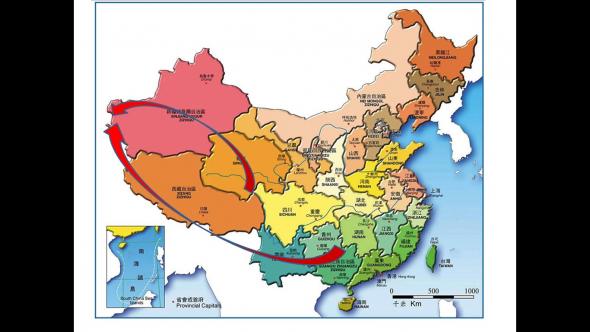
Figure 4.9 “The Horrific Inside Story of Human Organ Market in China”, Phoenix Weekly, November 2013
3. Analysis and Arguments
According to the “Regulations and Standards on Liver Transplantation” released by China’s Ministry of Health in 2006, the cold ischemia time cannot exceed 15 hours for the donor liver, which means:
1) Not spare livers, but spare living persons
(1) The two spare donor livers from Chongqing and Guangzhou could only have come from two living persons, due to the time limit for cold ischemia. If the spare livers had been extracted before being shipped to Xinjiang, it would have been well over 60 hours from the moment they were shipped out to the confirmation of the success of the autologous liver transplantation.
(2) The spare liver found in Xinjiang would also have been from a living person. Similarly, due to limit on the cold ischemia time and the urgent nature of the surgery, the living person with the spare liver must have been kept in preparation to be murdered for organ harvesting at any moment.
2)Who were the “spare persons”?
(1) There exists a human organ bank of captive prisoners, which operates outside of China’s justice system. In other words, outside of the justice system, there exists a group of people, who could be slaughtered at any time when their organs match that of someone in need of a transplant.
The execution of a death row prisoner must strictly comply with the law. The time and location of the execution must be in accordance with written documents issued by the Supreme Court; at the time of the execution, officials from the court and the procuratorate must be on site to perform a positive identification of the prisoner awaiting execution; the positive identification procedure is repeated after the execution is carried out. However, regarding Huang’s operation, medical staff from Chongqing and Guangzhou must have transported living persons for the spare livers by air. This suggests that the two living persons were captives not registered within the constraints of the justice system.
(2) The organ bank of living persons is a nationwide system with a massive number of captives. Huang’s requests made to different parts of the country suggest that the organ bank system is a nationwide network on an appalling scale. Judging from the short time frame with which matching livers of “identical blood type and gene loci” were found at the two different locations, we deduce that a large number of living captives are on standby for organ extraction. In its reporting on this particular transplant operation, the CCP-controlled state-run media unwittingly provided evidence for our case.
3) Three spare livers means three lives were at stake.
The surgery Huang performed was a whole liver transplantation, meaning that each spare liver was equivalent to one human life.
Huang Jiefu, as the main person in charge of organ transplants in China, could order organs at will in the entire country. He must also know that this is killing people. He not only did this, but also publicly reported that. How terrible it is!
4) Huang Jiefu often performs transplant demonstrations in various places and performs multiple operations at the same time
On the morning of September 18, 2003, the Central South University News Network reported that the then-Vice Minister of Health Huang Jiefu “operated” a liver transplant at the Third Xiangya Hospital. Huang Jiefu attended the inauguration ceremony of the Hunan Provincial Transplant Medical Engineering Technology Research Center at the Third Xiangya Hospital of Central South University. On the same day, the hospital’s transplant center “scheduled” seven liver and kidney transplants.[78]
Evidence IV: Many hospitals conduct multiple transplant operations at the same time. In one hospital, 24 liver and kidney transplants were conducted in one day
Our investigation has discovered that many hospitals can conduct several, or as many as several dozen, kidney and liver transplant operations, on the same day, or even at the same time. And this phenomenon of “more than 10 transplant operations on a single day” has been a long-term routine at many hospitals, where the surgeons are too busy to even have a day off during holiday seasons. Under normal circumstances, it would be impossible to simultaneously find so many donors with a close tissue match. However, since 1999, this has been a common phenomenon in China. For example:
1. Xinqiao Hospital of the Third Military Medical University once performed 24 kidney transplant operations in one day[79]
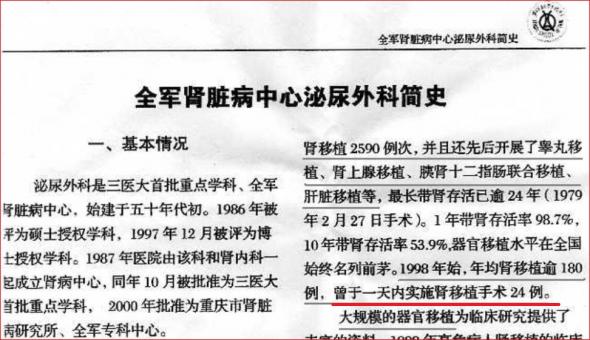
Figure 4.10 “A Brief History of the Urological Surgery Department at the Military Nephrology Center” Web Snapshot
2. Tianjin First Central Hospital once performed 24 liver and kidney transplant operations in one day[80]
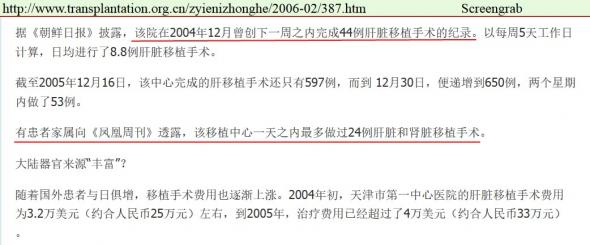
Figure 4.11 Snapshot of a China Organ Transplantation Webpage
3. The First Affiliated Hospital of Sun Yat-Sen University in Guangzhou performed 19 kidney transplant operations in one day[81]
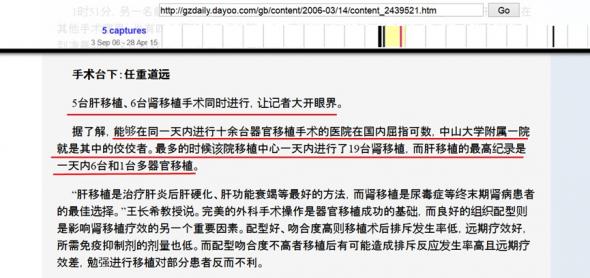
Figure 4.12 Snapshot of a Guangzou Daily Webpage
4. Xiangya Hospital performed 17 transplant operations in one day
According to Xiangya Hospital’s website, on May 26, 2005, the hospital performed one liver, six kidney and eight corneal transplants.[82] On September 3, 2005, the hospital conducted seven major heart-liver-kidney transplant surgeries.[83] On April 28, 2006, the hospital performed 17 transplant operations in one day, including two liver transplants, seven kidney transplants and eight corneal transplants.[84]
5. General Hospital of Jinan Military Region once performed 16 kidney transplant operations continuously in 24 hours[85]

Figure 4.13 Snapshot of Dazhong Network’s Webpage
6. Five donor livers were delivered at the same time to Fuzhou General Hospital of Nanjing Military Region. Among the five transplants, one was an emergency operation
On March 10, 2014, China Organ Transplantation website published an article originally reported by Southeast Express titled “Medical Staff Completed Five Liver Transplant Operations within 17 Hours without Sleep or Rest”. The article said that the Fuzhou General Hospital of Nanjing Military Region conducted five liver transplants from 12 noon on February 18, 2014, to 4am on February 19, 2014. Two of the organ recipients had chronic severe liver failure, one had acute liver failure with hepatitis B, one had an enormous hepatic tumor, and one had severe liver failure with multiple biliary tract surgeries.[86]
According to the article, the five patients had been admitted to the hospital and were waiting for liver sources, and the “five matching livers had already been found but could only be extracted five minutes after the donors’ heart stopped beating.” Apparently, the “donors” were still alive with functional livers, while their livers were being matched to the recipients. Therefore, after the five patients had been admitted to the hospital, they were not waiting for suitable organ matching, but instead for the death of the “organ providers”.
The report also mentioned that the five liver sources were “delivered at the same time”. [87] This means that these five individuals passed away at the same time. What a coincidence. These five people, who provided the liver sources, died at the same time, when those five patients needed the livers! Moreover, one case was an emergency liver transplantation, and the person, who provided the liver, was selected when the liver transplant was about to take place.
Under normal conditions, the probability of a successful organ matching from a non-relative of a transplant organ recipient is 6.5 percent, and the average wait time in the U.S. for organ transplant operations would be two years for a liver, and three years for a kidney. One medical professional in the United States once said that under normal circumstances, “getting a healthy organ is as hard as picking a star in the sky.”
Please note that these five transplant operations took place on February 18, 2014, more than eight years after the horrible truth of organ harvesting from living Falun Gong practitioners by the CCP was first exposed by international media in 2006. For a long time, the CCP has been deliberately misleading the international community into believing that organ transplant numbers dropped after 2006. However, the CCP continues to harvest organs from Falun Gong practitioners on a massive scale to this day.
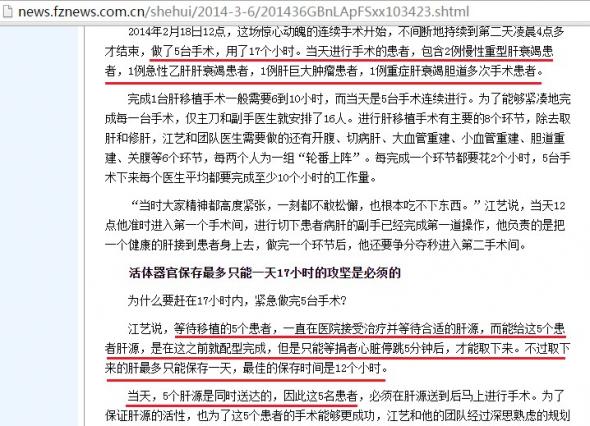
Figure 4.14 On March 10, 2014, China Organ Transplantation website reprinted an article from Southeast Express Newspaper
7. List of 42 hospitals performing multiple transplants simultaneously according to media reports
In 2014, through online articles alone, we found that 42 hospitals had been conducting multiple transplant operations simultaneously in batches.
Table 4.1 42 hospitals have performed multiple transplants simultaneously in batches
|
Name of the Hospital |
Media record of transplant operations in batches on the same day |
|
1. People’s Liberation Army Xinqiao Hospital of Third Military Medical University |
“Starting from 1998, the average number of renal transplants is 180 per year. There is a record of 24 cases of renal transplantation completed in a single day.”[88] |
|
2. General Hospital of People’s Liberation Army General Staff (the PLA No. 309 Hospital) |
In April 2002, the Military Organ Transplant Center was set up.[89] This center has a record of completing 12 kidney transplants during one night.[90] |
|
3. Affiliated Southwest Hospital of Third Military Medical University |
On September 29, 2004, Guo Jiwei, director of the Medical & Educational Department, visited the hospital’s operating rooms with other senior officials of the medical section and coordinated with the hepatology division to perform five liver transplant surgeries.[91] |
|
4. General Hospital of Jinan Military Region |
On March 21, 2005, Qilu Evening News published a special report on Li Xiangtie, director of the Department of Urology: “Under his leadership, the Department of Urology has many highly experienced specialists and a stellar team; the department can simultaneously perform six kidney transplant operations and has set a national record of conducting 16 renal transplants continuously within 24 hours...[92] and on six occasions, the department did seven transplants in one day, and once did 32 transplant operations in a week.”[93] |
|
5. Fuzhou General Hospital of Nanjing Military Region |
On January 17, 2006, Fuzhou General Hospital simultaneously performed three liver transplants for the first time.[94] On February 18, 2014, starting at 12 noon, within the next 17 hours, 16 hepatobiliary surgeons completed five liver transplants without sleep or rest.[95] |
|
6. The PLA No. 474 Hospital of Lanzhou Military Region |
This hospital is capable of completing 12 kidney transplants at one time.[96] |
|
7. Beijing Military Region Beidaihe Sanitarium |
As of April 2007, the hospital had completed 313 cases of renal allograft transplantation, and for 28 times, they performed 6 to 9 cases of renal transplantation simultaneously.[97] |
|
8. Affiliated Shanghai Changzheng Hospital of Second Military Medical University |
The official website of the hospital states that within nine days in 2005 from April 22 to April 30, its organ transplant center completed 16 liver transplants and 15 renal transplants.[98] |
|
9. The Armed Police General Hospital |
On April 6, 2005, under the command of Director Shen Zhongyang, the organ transplant center completed five liver transplants on patients, who were 12 to 62 years old, including a female Korean patient and a 12-year-old child with Wilson Disease.[99] |
|
10. Dongfeng General Hospital |
In August 2000, the hospital completed multiple organ transplant operations, including 10 renal transplants, 1 parathyroid transplant and 3 corneal transplants on the same day.[100] |
|
11. Third Xiangya Hospital of Central South University |
This hospital simultaneously did two liver transplants and five kidney transplants. It has the capability to carry out six to seven simultaneous transplants, and its yearly transplant operations amount to more than 200.[101] On the morning of September 18, 2003, Huang Jiefu attended the founding ceremony of the “Hunan Provincial Engineering Research Center for Transplantation Medicine” at the Third Xiangya Hospital of Central South University. The transplant center at the hospital that day “scheduled” seven liver and kidney transplant operations.[102] |
|
12. Second Xiangya Hospital of Central South University |
The Second Xiangya Hospital of Central South University routinely performs more than 10 operations with two or three days. The hospital once completed nine kidney transplants in one day.[103] |
|
13. Xi’an Gaoxin Hospital |
Founded in 2002, the organ transplant center completed more than 500 kidney transplants after two years of its establishment. An article on the hospital’s 10-year history of development stated, “Regardless of whether the weather was hot or cold, four to five people were crowded in a beat-up van harvesting donors’ organs”, and sometimes “(performed) seven to eight transplants during one day and night.”[104] |
|
14. Zhengzhou People’s Hospital |
On December 27, 2007, Director Qu Qingshan’s team completed 13 kidney transplants in 21 hours at the renal disease and organ transplant center.[105] |
|
15. First Affiliated Hospital of Sun Yat-Sen University |
On Mar. 14, 2006, Guangzhou Daily reported: “In recent days, in the First Affiliated Hospital of Sun Yat-Sen University operating rooms, reporters witnessed a scene of simultaneous operations of five liver transplants, six renal transplants... At one time, the hospital transplant center did 19 kidney transplants in one day, and the highest record for liver transplantation is six operations performed together with one multiple-organ transplant surgery in one day.”[106] |
|
16. Foshan No.1 People’s Hospital |
On December 29, 2005, the Department of Urology completed seven renal transplantation operations.[107] From the morning of December 28, 2004, to the early morning of December 29, in less than 24 hours, the Foshan No.1 People’s Hospital completed five kidney transplants and two liver transplants.[108] |
|
17. Dalian Friendship Hospital |
On February 1, 2002, the hospital completed one liver and four renal transplants in 14 hours.[109] |
|
18. Gongyi City Chinese Medicine Hospital |
In 2001, an allogeneic kidney transplant center was established in a ward of the hospital. The kidney transplant center can accommodate 12 kidney transplant patients at the same time. They could perform up to eight cases of kidney transplantation in one day, and the transplant center’s urological surgery director Li Hongdao has carried out over 500 allogeneic kidney transplants.[110] |
|
19. The PLA No. 107 Hospital of Jinan Military Region |
Du Yingdong, deputy director of the hospital’s Liver Transplant Center, claimed that he sometimes would complete three to four liver transplants in one day.[111] |
|
20. Shengli Oil Field Central Hospital |
On April 26, 2002, the hospital completed six kidney transplants within 24 hours. On October 27, 2002, five renal transplants and one liver transplant were completed within 24 hours. Within three days from January 9 to 12, 2004, the hospital completed 10 renal transplants and one liver transplant.[112] |
|
21. Qidu Hospital |
On the morning of March 23, 2006, from 3am to 9am, the hospital completed 4 renal transplants.[113] |
|
22. First Hospital of Shijiazhuang City |
On July 17, 2006, from 3pm to 1am in the next morning, the hospital’s Third Surgery Department and the Urological Surgery Department jointly completed five kidney transplants within 10 hours.[114] |
|
23. Second Hospital of Lanzhou University |
Director of the Urological Surgery Department, Yue Zhongjin, led the whole department to complete 8 renal transplants in 32 consecutive hours.[115] |
|
24. Affiliated Wuhan Xiehe Hospital of Central China University of Science |
The official website states that it had completed 100 heart transplants within five years. The hospital once performed four heart transplants on the same day and at the same time.[116] |
|
25. Taizhou Hospital in Zhejiang Province |
This hospital once conducted five renal transplants in one day.[117] |
|
26. Xiangya Hospital of Central South University |
On May 26, 2005, one liver, six kidney and eight corneal transplants were completed.[118] On September 3, 2005, seven major surgeries of heart, liver and kidney transplantation were completed.[119] At the beginning of February 2006, 2 liver transplants were completed within 72 hours. On April 28, 2006, the organ transplant center finished 17 transplantation operations in one day, including seven late-stage uremia patients, who underwent kidney transplant surgeries at the same time. The hospital also completed two liver transplants and eight corneal transplants simultaneously on the same day.[120] |
|
27. Tianjin First Central Hospital |
Xinhua Net (Tianjin) reported on February 7, 2005, that the Oriental Organ Transplant Center at the Tianjin First Central Hospital completed 108 liver transplants in January 2005 (four to five liver transplants every day if surgeries were performed on only five working days per week) and 43 kidney transplants.[121] Some patients’ families told the Phoenix Weekly that the transplantation center once did as many as 24 liver and kidney transplants in one day.[122] The Oriental Organ Transplant Center is capable of doing nine liver transplants and 8 kidney transplants simultaneously.[123] |
|
28. Jiangxi Armed Police Corps Hospital |
In February 2002, the urological organ transplant center was set up.[124] Over the next two years, the center completed 260 kidney transplants for patients in and outside the military. The center once continuously performed renal transplants for four patients over eight hours.[125] |
|
29. Guangdong Frontier Corps Hospital Kidney Center in Shenzhen |
From 3pm on August 2, 2004 to about 2am on the next day, within 11 hours, this hospital completed six allogeneic kidney transplants.[126] |
|
30. First Affiliated Hospital of Zhejiang University School of Medicine |
The nurses at the hospital’s renal transplant ward said, “One day at the end of 2006, more than 30 kidneys came in; more than 10 people were shot on that day.” On January 28, 2005, Zheng Shusen at the transplant center completed five liver transplants consecutively on the same day. Zheng Shusen did 11 orthotropic liver transplants in a week.[127] |
|
31. West China Clinical Medical College (West China Hospital) |
Yan Lu’nan said that they once performed seven liver transplants in a day.[128] A West China Hospital nurse said, in a phone conversation recording, “Once they did six kidney transplants in a day. The kidney resources are abundant.”[129] |
|
32. Third Affiliated Hospital of Sun Yat-Sen University in Guangzhou |
On the evening of February 10, 2004, four liver transplants were performed by the head of the hospital, Chen Guihua.[130] |
|
33. First Affiliated Hospital of Kunming Medical College |
On June 24, 2005, the hospital performed liver transplant surgeries for three patients simultaneously.[131] |
|
34. Shanghai Renji Hospital |
Xia Qiang, head of the liver transplant center, has lost count of how many liver transplant surgeries he has performed. He can only remember his own record of performing six liver transplant surgeries in one day.[132] |
|
35. Shandong University Second Hospital |
On July 16, 2014, Jinan Daily published an article on Wang Hongwei, director of the kidney transplant section. Wang once completed 10 kidney transplants in one day.[133] |
|
36. Shanxi Armed Police Corps Hospital |
On the morning of June 7, 2005, the hospital performed three transplant surgeries simultaneously. More than 30 physicians and nurses participated in the surgeries. Professor Liu Zhenwen was the chief physician for the liver transplants; Zhao Xueyi was the chief physician for kidney transplants.[134] |
|
37. Xijing Hospital (in Xi’an City) |
Cai Zhenjie, director of the Department of Cardiac Surgery, completed three heart transplants in one day.[135] |
|
38. First Affiliated Hospital of Nanchang University |
The hospital once completed six major organ transplants simultaneously in one day.[136] |
|
39. Shanxi Province No. 2 People’s Hospital |
Wu Xiaotong, director of the Organ Transplant Center, has performed transplants for 12 consecutive hours in one day.[137] In August 2006, patients awaiting organ transplants totaled more than 100 per day at a minimum. 11 kidney transplants were conducted on August 15, 2006.[138] |
|
40. Guangdong Province No. 2 People’s Hospital |
On August 4, 2006, Wu Jiaqing, deputy director of Organ Transplant Department, told our investigator that they completed at least 10 organ transplants each day before August 3, and completed six organ transplants on August 4.[139] |
|
41. First Affiliated Hospital of Zhengzhou University |
Big River Health Newspaper reported on March 27, 2014, that the transplant center at the First Affiliated Hospital of Zhengzhou University completed four liver transplants successfully for two patients with liver cirrhosis and two with liver cancer.[140] |
|
42. Affiliated Hospital of Qingdao University |
In August 2014, the official website of Affiliated Hospital of Qingdao University claimed, “In order to support the new leap of kidney transplant department, Sun Lijiang and Li Yanjiang from the hospital’s Urology Surgery Department, often rush to Huangdao to assist the operations in the evenings after finishing work in their own department. Together with Dong Zhen and Huang Tao, they have completed six surgeries within 24 hours.”[141] |
From a medical point of view, it is simply impossible to find so many death row donors with relatively consistent tissue matching on the same day. The only possibility is that there is a large pool of living organ donors that have been tested for their blood types and leukocyte histocompatibility antigen (i.e. HLA).
Evidence V: Warm ischemia times are either zero or exceedingly short
Our investigation has discovered that many organ transplant operations performed in China had either zero or exceedingly short warm ischemia times, indicating that the donors for these operations were still alive when their organs were extracted.
1. What is warm ischemia time?
Warm ischemia time is the period of time from the moment the donor stops supplying blood to the organ to the start of cold perfusion.[142] The time the organ allows warm ischemia is: 3-4 minutes for hearts, 5-8 minutes for livers, 30 minutes for kidneys and 24 hours for bones and corneas.
2. What is cold ischemia time?
Cold ischemia time (CIT) is the time period between the cold perfusion of an organ after its blood supply is cut off and the time its blood supply is restored during transplantation.[143] The time limit of the cold ischemia time for kidneys is 24 hours; for livers, it is 15 hours; and for hearts, it is 6 hours.[144] [145]
3. What is cardiac death?
Cardiac death generally means a person’s heart stops beating, as well as the breathing and circulation.
4. What is brain death?
Brain death means a full irreversible loss of brain functions, including the brainstem functions. Clinical determination of brain death must include three indispensable indicators: deep coma, no brain stem reflex and no spontaneous breathing.
5. All organ extractions from brain dead donors in mainland China are illegal
To this day, China does not have a uniform set of national criteria issued by the administration on what constitutes brain death. Likewise, there is no legislation on brain death. Therefore, according to China’s laws, any action of organ extraction from a brain-dead person is illegal.
6. The warm ischemia time being either zero or exceedingly short indicates organ harvesting from living candidates
If the warm ischemia time is zero, it indicates that heartbeat and blood supply are present during organ excision, i.e. organ is excised from a living body. It can only be done by taking organs from either a brain-dead or a living person.
1) In cases where a death is caused by an accident, warm ischemia time is often relatively long; and a zero ischemia time is impossible.
2) When using organs from executed prisoners, strictly speaking, the warm ischemia time should not be zero, either. This is because execution should follow the judicial process, where organ extraction should only occur after the medical examiner has inspected the body and pronounces the prisoner dead. Therefore, the warm ischemia time should not be zero, either.
3) In cases of brain dead donors, organs can be obtained with a zero or exceedingly short warm ischemia time. However, China has no brain death legislation, lacks a set of criteria that define brain death, and does not have an organ donation system in place. So basically, there are no “brain dead donors” in China.
7. “Kidney transplants from living donors” in China is “completely different” from the cadaveric kidney transplants conducted in Japan
The following is the online response from China International Organ Transplantation Support Center of China Medical University:
“The kidneys transplanted in China are from living donors, completely different from the cadaveric kidney transplant operations you’ve heard of in Japan’s hospitals or dialysis centers.”[146]
However, even these “living donor transplant operations” conducted in China are different from those performed elsewhere in the world, where donors remain alive. In other countries, a liver transplant from a living donor refers to a partial liver transplantation, where a portion of the donor’s liver is excised and transplanted into the recipient. The donor is normally a relative of the recipient. By contrast, in China, the entire liver is excised and transplanted into the recipient. This equates to killing the donor through liver excision.
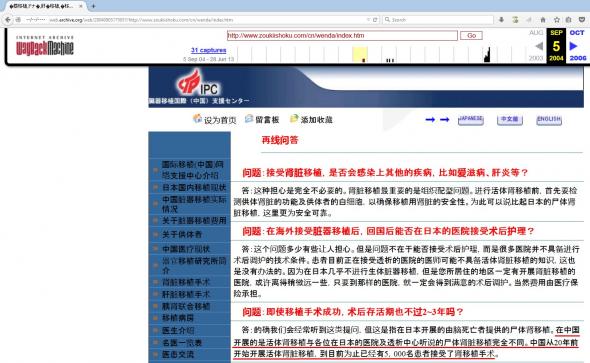
Figure 4.15 Support Center of China International Transplantation cached webpage
8. Examples of research papers by physicians in mainland China where zero and exceedingly short warm ischemia times have been recorded
1) At the Affiliated Hospital of Nanjing Medical University, from 2005 to 2007, 112 donor livers’ warm ischemia times were between 0 and 10 minutes, with an average of 3.96 minutes.[147]
2) At the PLA Second Artillery Force General Hospital, from 2004 to 2007, 103 donor livers from “healthy young people’s cadavers” had warm ischemia times of 0 to 5 minutes.[148]
3) At Second Military Medical University Affiliated Changzheng Hospital in Shanghai, from 2001 to 2004, 240 donor livers had warm ischemia times of 0 to 8 minutes.[149]
4) 33 hospitals reported zero or extremely short warm ischemia times
Table 4.2 33 Selected Hospitals Reporting Zero or Extremely Short Warm Ischemia Times
|
Hospital Name |
Time Period |
Warm ischemia Times of Removed Organs |
|
1. Affiliated Union Hospital of Fujian Medical University |
August 1995 - October 2007 |
111 cases of heart evisceration where all donors were brain dead, aged at 25±7; no history of cardiovascular disease, with the warm ischemia times being 0-15 minutes[150] |
|
2. Nanjing Drum Tower Hospital |
January 1996 - March 2008 |
314 liver transplants were implemented, with the warm ischemia times being 0-2 minutes[151] |
|
3. No.1 Affiliated Hospital of Guangxi Medical University |
June 26, 1996 - June 2004 |
20 cases of rapid lavage and joint removal of multiple organs were recorded, with the warm ischemia times being 0-5 minutes[152] |
|
4. The PLA No. 309 Hospital |
2003-2009 |
162 liver transplants were recorded with the warm ischemia times being 0-5 minutes, average 2 minutes[153] |
|
5. Foshan City No.1 People’s Hospital |
March 2003 -December 2006 |
28 cases of liver extraction from donors who had no liver diseases, with the warm ischemia times being 0-6 minutes[154] |
|
6. Guangzhou General Military Hospital |
July 2006 - May 2011 |
20 cases of organ extraction, where the warm ischemia times were zero[155] |
|
7. Shanghai Ruijin Hospital |
June 2002 – September 2004 |
100 cases of liver extraction from donors; cardiac arrest times were 0-7 minutes; no liver diseases, no malignant tumors, no obvious fatty degeneration, tested negative for hepatitis B[156] |
|
8. Wuxi City No.2 People’s Hospital |
December 25, 2000; January 30, 2002; March 13, 2002; September 28, 2002; March 24, 2003 |
Five liver transplants where “donors were brain dead youthful men who had been healthy, and their livers were of good quality,” “the warm ischemia times for the five transplants were basically 0 minute”[157] |
|
9. No.1 Affiliated Hospital of Wenzhou Medical Institute |
February 2003-April 2004 |
Performed three orthotopic heart transplants, donors were all male, aged 18, 31 and 45, and the warm ischemia times were 0 minute in all three cases[158] |
|
10. Affiliated Hospital of Nanjing Medical University |
March 2005 - November 2007 |
Among 125 liver transplants, 112 were from “deceased donors.” However, the warm ischemia times for livers from these “deceased donors” were between 0 and 10 minutes, with an average of 3.96 minutes.[159] |
|
11. No.2 Affiliated Hospital of Medical School of Zhejiang University |
August 31, 1999 - February 9, 2001 |
The hospital conducted 10 liver transplants, all 10 donors were brain dead; fast removal of multiple organs was implemented; the warm ischemia times were 0 to 5 minutes, averaging 3.06 minutes.[160] |
|
12. Affiliated Hospital of Jiangsu Nantong Medical Institute |
November 2000 - May 2003 |
4 orthotopic heart transplants, “donors were brain dead, 3 male, 1 female; their heart functions were normal before death. All four donors had their chest incised immediately after brain death.” The warm ischemia times were 0 to 2 minutes, with an average of 1 minute[161] |
|
13. Nanjing Drum Tower Hospital of Jiangsu Province |
June 2004-June 2005 |
Obtained 42 donor livers, with the warm ischemia times being 0-5 minutes, “brain dead, aged 19 to 38, no infectious diseases, no kidney or liver diseases”[162] |
|
14. No.2 Artillery General Hospital |
July 2004 - 2007 |
103 liver transplants, “all donors were healthy young people, one brain dead and 102 deceased.” However, in all 103 cases, the warm ischemia times were 0-5 minutes[163] |
|
15. Shanghai Changzheng Hospital |
October 2001 – September 2004 |
240 liver transplants implemented, with warm ischemia times being 0-8 minutes[164] |
|
16. Dongguan People’s Hospital of Guangdong Province |
April 2003 and December 2003 |
4 orthotopic heart transplants, with warm ischemia times being 0-3.5 minutes[165] |
|
17. Affiliated Union Hospital of Fujian Medical University |
August 1995 – March 2009 |
96 orthotopic heart transplants, donors were brain dead, male, aged 20 to 45; the warm ischemia times were 0-15 minutes, and the cold ischemia times were 50-235 minutes[166] |
|
18. South Hospital Affiliated to South Medical University |
April 5, 2000 |
One orthotopic heart transplant, “donor brain dead, male, donor and recipient were of the same blood type, the lymphocytotoxic crossmatch PRA < 1%, HLA was half matched; the warm ischemia time was 0 minute, the cold ischemia time was 90 minutes”[167] |
|
19. The PLA No. 117 Hospital |
April 1989 – October 2002 |
294 cases of fast removal of both kidneys were implemented, where the warm ischemia times were 30 seconds to 10 minutes[168] |
|
20. Affiliated Children’s Hospital of Beijing Military General Hospital |
September 2006 – August 2007 |
Seven heart extractions for transplants, where donors were “brain dead” males, with warm ischemia times being 1-10 minutes[169] |
|
21. Zhongshan Hospital Affiliated to Fudan University |
January 2004 to August 2006 |
117 cases of fast joint extraction of livers and kidneys immediately following cardiac arrest; 109 male, 8 female; aged 18 to 47, with an average age of 28.6 years old; the average warm ischemia time was 2.7 minutes.[170] |
|
22. South Hospital of South Medical University |
August 2004-December 2007 |
126 cases of fast joint extraction of livers and kidneys, the warm ischemia times were 1-8.5 minutes, averaging 4 minutes[171] |
|
23. No.1 Affiliated Hospital of China Medical University |
September 1999 - September 2004 |
19 cases of joint pancreas-kidney extraction; donors were all male, with an average age of 30; all had serious craniocerebral injuries; the warm ischemia times were 2.0±0.5 minutes[172] |
|
24. Shanghai No.1 People’s Hospital |
January 2001-September 2003 |
138 cases of joint liver-kidney extraction; cooperated with a partner hospital to simultaneously extract five hearts and three lungs; the warm ischemia times were 2-5 minutes[173] |
|
25. The PLA No. 81 Hospital |
April 2003-Februry 2008 |
68 cases of liver extraction; the warm ischemia times were 2-5 minutes[174] |
|
26. Beijing Military General Hospital |
April 2005 -July 2007 |
30 cases of orthotopic liver extraction; the warm ischemia times were 2-7 minutes, averaging 4.6 minutes[175] |
|
27. The PLA No. 401 Hospital |
September 2003 - May 2004 |
34 cases of liver extraction; the warm ischemia times were 2-9 minutes, averaging 5.1 minutes[176] |
|
28. Affiliated Hospital of Binzhou Medical Institute |
October 22, 2004 |
1 case of single lung extraction; the donor was male, with no history of heart or lung disease or history of cigarette smoking; the warm ischemia time was 2 minutes[177] |
|
29. Shandong Provincial Hospital |
January 2005-December 2008 |
120 liver transplants implemented; 6 of the 120 were joint liver-kidney transplants; donors aged 19-40, averaging 28 years old; no history of alcohol drinking, no malignant tumor, no infection, no diabetes; the livers and kidneys had normal functions; tested negative for hepatitis B and HIV; the warm ischemia times were 2.5-4 minutes[178] |
|
30. Affiliated No.1 Hospital of National Sun Yat-sen University |
January 2006-January 2007 |
Two cases of heart and lung extraction for transplants; the donors were male, aged 28 and 32; both were brain dead, with no heart disease or infectious disease; the warm ischemia times were 2.5 minutes and 3 minutes[179] |
|
31. Anyang City Chinese Medicine Hospital |
January 2000-December 2004 |
36 cases of kidney extraction; the warm ischemia times were 2-13 minutes[180] |
|
32. Jiujiang City No.1 People’s Hospital |
October 26, 2001 |
One liver transplant completed; the donor had been dead for 2 minutes before the liver extraction[181] |
|
33. Southwest Hospital Affiliated to Third Military Medical University |
June 26, 2000 |
One case of joint heart-kidney transplant; the donor was male, aged 28, brain dead after external head trauma; the warm ischemia time was 2 minutes 20 seconds[182] |
Sources: WOIPFG, 2016.
Evidence VI: Murder Evidence by Live Organ Harvesting Revealed in Medical Papers
I. Cardiopulmonary excision from donors in two cases of Combined Heart-Lung Transplantation
The following medical paper published by Wu Jian and other physicians from Yan’an Hospital of Kunming describes the procedure of a heart and lung extraction, which is a record of two suspected killing cases.
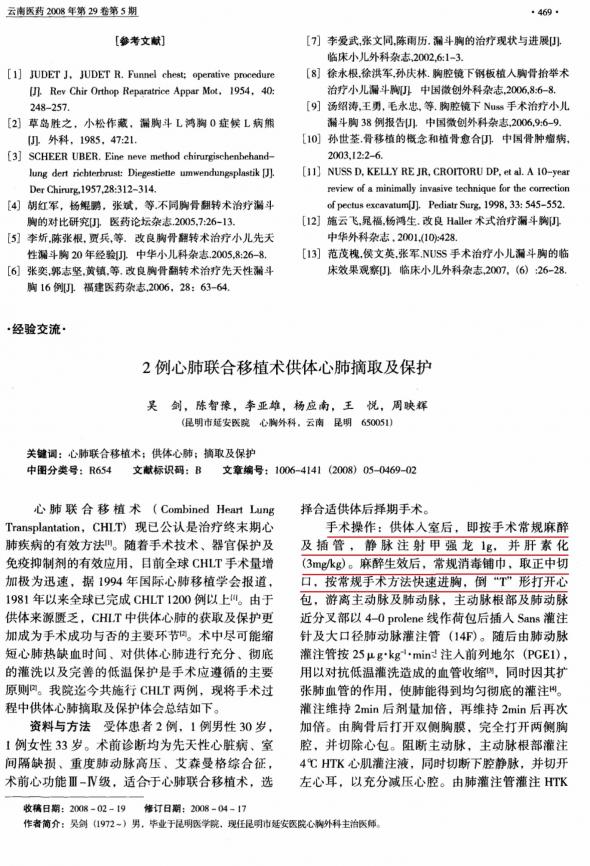
Figure 4.16 Journal of Yunnan Medicine, 2008, Vol 29, (5), pp 469
Here is the description of the surgical procedure as specified in the paper in figure 4.16: After the donor (organ provider) entered the operating room, conventional anesthesia and endotracheal intubation procedures were administered; intravenous administration of 1g methylprednisolone and heparin (3mg/Kg) was given to the organ provider. After the anesthesia began taking effect, the routine draping procedure was followed using sterile towels. An incision was made in the center and into the chest swiftly using routine surgery procedures.
Analysis:
Clinical determination of brain death must include all three indispensable indicators: deep coma, no brain stem reflexes and no spontaneous breathing. No spontaneous breathing refers to the need to rely on a ventilator to maintain breathing. An apnea test must also be used to verify brain death. Apnea tests require the temporary removal of ventilator support for 8-10 minutes, during which time a clinically brain dead patient would not display any respiratory efforts. According to the report above, the following conclusions can be drawn:
1. The donor was probably a living person, because only living people would need anesthesia and intubation.
2. The donor was a conscious person. The narrative of the operation in the above paper reads: “After the anesthesia became effective, routine disinfection of the towel,...” This record shows that this person was a living person, who had the physiological signs (neural sensation, nerve reflex, etc.) to judge the anesthetic effect.
3. The donor had spontaneous breathing, because anesthesia and routine tracheal intubation only took place after the donor entered the operating room. That is, before entering the room, he or she could breathe on his or her own without intubation.
4. The organ provider was not brain dead or in a deep coma, if so, he or she should have required endotracheal intubation and intravenous fluids before entering the room to maintain his or her breathing and heartbeat.
We can draw some further conclusions from the analysis above:
1. This paper is an authentic description of how the doctors conducted a murder. It recorded their crime.
2. The fact that they could write down the murder process and publish it on the Internet shows that killing people had become their routine work, and that they had become morally depraved.
II. Analysis of the “100 Cases of Lung Excision” in Wuxi City
Chen Jingyu, the “No.1 Lung Transplant Doctor in China” at Wuxi People’s Hospital, jointly authored a medical paper with seven other doctors (Wang Zhenxing, Zheng Mingling, Ye Shugao, Liu Feng, Chen Ruo, Lu Rongguo and Wei Dong) with the title “100 Cases of Lung Excision for Lung Transplantation: Cold Ischemia Time > 6h and the Effect of Lung Volume Reduction on Prognosis”.[183] The procedure described in the paper is suspected of having murdered 100 people by live organ harvesting.
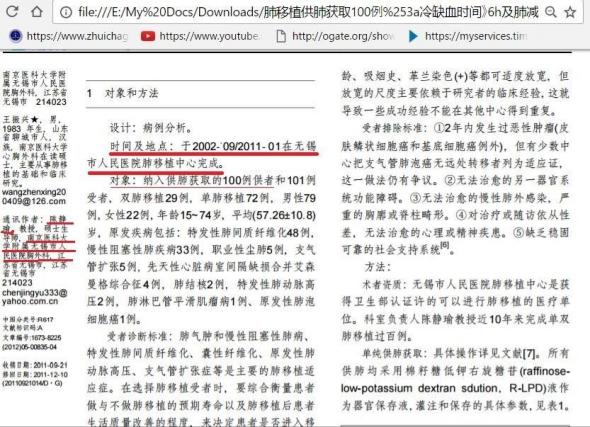
Figure 4.17 100 lungs were harvested at the lung transplant center of Wuxi People’s Hospital
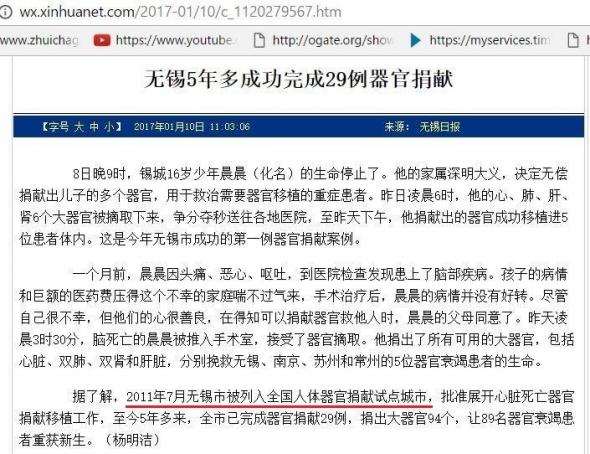
Figure 4.18 In July 2011, Wuxi City began its organ donation pilot program. The total donations had been only 29 cases by 2017. (http://wx.xinhuanet.com/2017-01/10/c_1120279567.htm)
Analysis:
1. These lungs were not donated organs
These 100 lungs were excised during the time period from September 2002 to January 2011. According to media reports, voluntary organ donations in Wuxi City started in July 2011. As of 2017, there had been a total of 29 cases of organ donations.
2. They were not organs from executed prisoners
The excisions took place in the operating room of the Lung Transplant Center at Wuxi People’s Hospital. It’s impossible to execute death-row prisoners in operating rooms, because the executions of death-row prisoners are governed by strict regulations. They are carried out on the specific dates and locations in accordance with the Supreme Court’s verdicts. And relevant government personnel from the court and procuratorate must be present at the execution site. Therefore, it can also be said that these were not organs from executed prisoners.
Conclusion: 100 people are suspected to have been killed from organ harvesting.
Based on the above evidence, these lungs might be from Falun Gong practitioners or other people. And they were absolutely not from donations or executed prisoners.
Evidence VII: Falun Gong practitioners are forced to have blood tests, which implies that the CCP has established a live-organ donor data bank
It is very difficult for us to obtain more evidence from those secret concentration camp, where Falun Gong practitioners are being held, because of the CCP authorities’ information censorship. However, these blood tests of Falun Gong practitioners, whether they are locked up in jails, labor camps, detention centers or even at their own homes, indirectly confirm that the Chinese regime has been building a database for reverse organ matching.
1. Nearly every detained Falun Gong practitioner is forcibly subjected to blood tests
In addition to the extensive physical and mental abuse, Falun Gong practitioners from all over China are forcibly subjected to blood tests while they are being detained. A large number of Falun Gong practitioners held in jails, labor camps and detention centers have suffered extreme abuse at the hands of authorities. Some have been beaten, some have been injured, and many have been crippled or died from torture. According to Minghui.org, from 1999 to July 4, 2019, a total of 4,316 deaths had been confirmed, where practitioners were beaten to death.[184]
Practitioners subjected to blood tests are not informed the results, and if they truly display illness symptoms they are denied medical treatment. They are unable to post bail to seek medical treatment. This is common practice throughout China. No other detainees or inmates receive such treatment.
2. Falun Gong practitioners are subjected to forcible blood tests in their homes
Since April 2014, officials and the police from public security bureaus have broken into the homes of Falun Gong practitioners. In some cases, in Guizhou, Liaoning, Hunan, Hubei and Beijing, the authorities have forced the practitioners to undergo blood tests in their own homes.[185]
In a few cases, where the Falun Gong practitioners could not be located, the police of public security bureau forcibly took blood from their relatives. Even elderly Falun Gong practitioners, some over 80 years old, were forced to take blood tests. Many cases like this took place in Guizhou and Liaoning, where some police officers even said that they were simply carrying out orders from their superiors.[186] Over the course of about one month in Dandong, Liaoning Province, a total of 16 Falun Gong practitioners were forced by the local police to have their blood drawn and thumbprints recorded.[187]
Evidence VIII: Annie, Peter and a military surgeon exposed the death concentration camps
1. Annie and Peter exposed the Sujiatun death internment camp
On March 9, 2006, reporter Peter disclosed to the overseas newspaper “The Epoch Times” that there was a secret concentration camp for detaining Falun Gong practitioners in Sujiatun, Shenyang, and this was the first time the CCP’s large-scale live harvesting of Falun Gong practitioners’ organs was exposed in the international community.[188]
On March 19, 2006, Annie, ex-wife of a chief surgeon involved in the removal of Falun Gong practitioners’ corneas, exposed that Sujiatun Concentration Camp was located in Sujiatun
Liaoning Provincial Thrombosis Hospital of Integrated Chinese and Western Medicine. From year 2001 to October 2003, her ex-husband directly harvested corneas from around 2,000 people, whose internal organs were subsequently harvested by other surgeons. All this was done when the victims were still alive. “Currently, no one could escape alive. The majority of approximately 6,000 Falun Gong practitioners died after suffering from kidney, cornea and skin harvesting, and their corpses were destroyed. Now there are still approximately 2,000 people being hidden there.”[189]
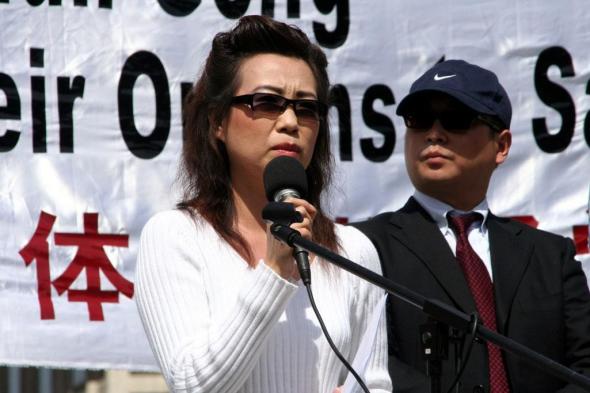
Figure 4.19 On April 21, 2006, a chief surgeon’s ex-wife, Annie, and reporter Peter stood up and testified at a public rally held in Washington D.C. that Falun Gong Practitioners’ organs were being harvested alive by the CCP at a concentration camp in Sujiatun, Shenyang.
2. An elderly military doctor from the logistics department of Shenyang Military Region also revealed live organ harvesting to the Epoch Times
On March 31, 2006, an elderly military doctor from the Logistics Department of Shenyang Military Region also confirmed the existence of the Sujiatun underground concentration camp to the Epoch Times: “In the underground concentration camp of Sujiatun, more than 10,000 people were detained in early 2005, but at the present time the number of detainees there is maintained at around 600 to 750, since many have been transferred or killed. At present, even if you enter the Sujiatun area to investigate, you wouldn’t find evidence, because it is too easy to transfer thousands of people, and it takes only one day to transfer 5,000 people via the closed railway wagon train. I have witnessed the transfer from Tianjin to Jilin, a special transfer of over 7,000 people by fully armed guards and was carried out at night. Everyone was locked to the handrail, like chickens that were hoisted. ”[190]
“Sujiatun is only one of 36 similar concentration camps across the country. Among the materials I have come across, China’s largest Falun Gong internment camp is in Jilin, code 672-S, and the number of detainees exceeds 120,000. It is a place to detain many Falun Gong practitioners, felons and political prisoners from all over the country. In Jilin’s Jiutai region, where China’s fifth largest Falun Gong internment camp exists, more than 14,000 people are being detained.”
There is also the CCP’s “felon policy”.[191] The elderly military doctor also disclosed, “The Central Military Commission of the Chinese Communist Party issued some documents in 1962, and they have been in use to this day, stipulating that death-row prisoners and felons convicted of serious crimes could be treated according to the developmental needs of the state or of socialism. During the Cultural Revolution, the primary revolutionized way to ‘process’ these prisoners was to eat their bodies. The second way was to use them as slave labor for various production lines.”
“According to the supplemental provisions issued in 1984, organ transplantation with organs from felons was fully legalized. The public security bureaus and judicial departments in many areas would directly harvest organs from living prisoners before cremating their bodies. Sometimes they would intentionally shoot and injure prisoners to create the formality of death, before directly removing their organs. And they then would cremate the bodies. Since 1992, due to the development of many industries, human bodies - living people or dead bodies- have become expensive industrial raw materials.”
“At present, the CCP Central Committee has agreed to classify Falun Gong practitioners as class enemies and to treat them with any means that would meet the needs of economic development, without the need to report to the upper levels. That is, Falun Gong practitioners, like the felons in China, are no longer treated as human beings, but as product raw materials and commodities.”
In the eyes of the CCP, Falun Gong practitioners, who believe in “Truthfulness, Compassion, Forbearance” have become “class enemies” that need to be “physically annihilated”. This is the definition of the “death-row prisoner” of the CCP.
Evidence IX: The use of military and underground air defense facilities to establish secret concentration camps
According to information gathered inside China, as of 2006, the CCP had 670 public prisons, 300 labor camps (which were later abolished) and a total of approximately 1.8 million detainees. In those days, many places of imprisonment were greatly overcrowded due to the large number of Falun Gong practitioners being detained there. There was still a constant stream of petitioning practitioners, so the CCP used military and underground air defense facilities to establish secret concentration camps across the country, to carry out more covert and cruel persecution of Falun Gong practitioners.[192]
On October 1, 2000, Agence France-Presse (AFP) reported that the CCP had built new concentration camps in Northeastern China and Northwestern China, specifically for detaining Falun Gong practitioners, and each concentration camp could detain 50,000 people.[193]

Figure 4.20 Screenshot of an Epoch Times report on the secret concentration camps
From the above nine pieces of evidence, we can see clearly that in mainland China, after 1999, the wait times for organ transplants have become extremely short; the number of emergency transplants has become staggering; multiple operations have been conducted in the same day in the same hospitals; sometimes one operation would have multiple spare donors and even live persons as backup donors; it is very common for donor organs to have zero warm ischemia times; and some strange phenomena, such as free organ promotions, have been taking place. These cannot be explained by normal organ donations or organ procurement from executed prisoners. Combining these pieces of evidence with insiders’ testimonies regarding some large-scale concentration camps, we can draw this conclusion:
After 1999, institutions similar to Nazi concentration camps have emerged in mainland China, holding a large number of Falun Gong practitioners and live organ harvesting them at any time for exorbitant profits.
Chapter 5: The CCP’s Claim that Organs are from Death Row Prisoners is a Scam
Considering evidences in the previous chapters, please think about several questions.
1. Can the volume of organ transplants that has been growing explosively in China for many years after 1999 be explained solely by sourcing organs from executed prisoners?
2. Is it possible for the average wait time for executed prisoners’ organs to be guaranteed to be 1 or 2 weeks?
3. Can executed prisoners’ organs supply all the emergency transplants, which were as many as 26.6% of the total transplants?
4. Could Huang Jiefu transfer three death-row prisoners by just making a phone call?
5. How could it be possible for one hospital to perform 24 operations within one day? Is it possible for them to only use organs from executed prisoners?
I. The CCP’s average annual figures of executions after 1999
According to the analysis of various official data of the Chinese Communist Party, the average annual numbers of organs obtained from executed death row prisoners after 1999 have been far lower than the annual volumes of organ transplants.
1. According to Amnesty International’s records, from 1995 to 2005, the average annual number of executed death row prisoners in China was around 1,600[194]

According to Amnesty International’s records, from 1995 to 1999, the annual average number of executed death row prisoners in China was around 1,680 per year. Between 2000 and 2005, the average number was 1,616 per year, a decrease of 4% from the previous 5-year period.
While these figures from Amnesty International might have been underestimated, even if the estimates were higher, they would still fail to explain the exponential growth in organ transplant volumes in the mainland China since the year 2000.
2. Huang Jiefu’s statement that the number of executions had been decreasing by 10% every year confirms that the organ sources after year 1999 have been abnormal
On March 7, 2013, Huang Jiefu, former deputy minister of the Chinese Ministry of Health, said in an interview with Southern Metropolis Daily: “Since more than a decade ago, China’s executions have been decreasing at a rate of 10% per year. Now there are actually very few death row prisoners.”[195]
Although Huang Jiefu did not state the annual figures of executions, it can be seen from his statement that after the persecution of Falun Gong started in 1999, the number of executions has been decreasing year over year, which is consistent with Amnesty International’s records.
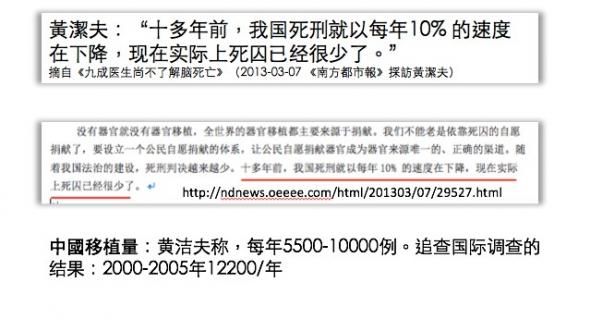 Figure 5.1 Screenshot of the Southern Metropolis Daily article
Figure 5.1 Screenshot of the Southern Metropolis Daily article
3. The China Judgment Document Network also shows that the number of death sentences in China has fallen sharply in recent years
The China Judgment Document Network is the official website managed and operated by the Supreme Court of the Chinese Communist Party. From July 2, 2013 to December 31, 2014, the Supreme People’s Court published a total of 180 death penalty review verdicts on the China Judgment Document Network website, pertaining to 210 defendants with reviewed death sentences.[196] Compared with the average annual numbers of death sentences published by Amnesty International from 1995 to 2005, it is obvious that the number of death sentences has dropped significantly.[197]
II. The numbers of executed prisoners are far smaller than the organ transplant volumes
In terms of the actual kidney transplant volumes, the discrepancy between them and the annual numbers of executed prisoners are even greater. For example, Peking University People’s Hospital would perform 4,000 Liver and kidney transplants in one year. The number of executed prisoners of the entire country would not be enough to meet the demand of just this one hospital.

Figure 5.2 Screenshot of a Xinhuanet article in September 2013
III. The organ matching ratio indicates that the organ pool size is much greater than the number of executed prisoners
Usually, the organ matching ratio between non-relatives is 6.5 percent. Based on Huang Jiefu’s claim that the annual numbers of kidney transplants in 2000 and 2004 were 5,500 and 10,000 respectively, the numbers of executed prisoners of those years couldn’t have been sufficient for the transplant operations.
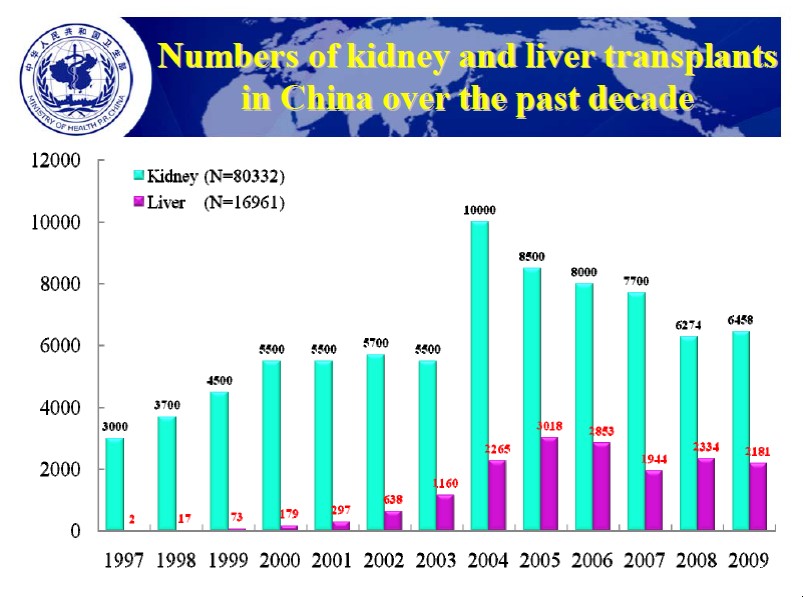
Figure 5.3 Total annual volumes of organ transplants released by Huang Jiefu in Madrid in March 2010
IV. Only a small number of death row prisoners qualify to become organ donors due to health reasons
1. In 2009, Hangzhou City in Zhejiang Province conducted a hepatitis B checkup for 482 detainees, and found that 29 percent tested positive.[198]

Figure 5.4 Hepatitis B Checkup Results of 482 Detainees in Hangzhou City
|
Test Item |
Result |
Number of People |
Positive rate |
|
HBsAg |
Positive |
64 |
13.28% |
|
HBeAg |
Positive |
8 |
1.66% |
|
HBsAb |
Positive |
142 |
29.46% |
2. In 2006, Heze City of Shangdong Province also conducted a physical checkup of detainees, and found that 1.29 percent tested positive for AIDS and syphilis, and 9.27 percent tested positive for hepatitis B and hepatitis C.

Figure 5.5 Results of physical checkups for detainees in Heze City of Shangdong Province
|
Categories |
Number of examinees |
Anti-HIV |
Anti-TP |
HBsAg |
Anti-HCV |
||||
|
Number of positive results |
The positive rate |
Number of positive results |
The positive rate |
Number of positive results |
The positive rate |
Number of positive results |
The positive rate |
||
|
Voluntary blood donors |
2,218 |
1 |
0.05% |
5 |
0.22% |
7 |
0.32% |
2 |
0.09% |
|
Rural residents |
222 |
0 |
0 |
2 |
0.90% |
8 |
3.60% |
2 |
0.90% |
|
Detainees |
1,543 |
1 |
0.06% |
19 |
1.23% |
122 |
7.91% |
21 |
1.36% |
|
Total |
3,983 |
2 |
0.05% |
26 |
0.65% |
137 |
3.44% |
25 |
0.63% |
V. The donors in excellent health, as specified in Chinese doctors’ medical papers, were not death row prisoners
Among the more than 300 medical papers from over 200 hospitals collected by WOIPFG investigators,[199] 2,084 cases of various organ transplant operations specifically described the “organ donors”. These “donors” were described as having “no history of long-term medication,” “no hepatitis B, hepatitis C, malignant tumors or chronic illnesses,” “no history of alcohol abuse, diabetes or other illnesses” and “no fatty liver”. The health of the “donors”, as described by hospitals in many provinces, has been consistently excellent.
VI. The excellent health of organ “donors” as described in Chinese doctors’ medical papers exceeds the average health metrics of average Chinese adults
“A number of surveys, which used sampling data from city populations, show that 12.5 percent~35.4 percent of Chinese adults have fatty liver, making it the No.1 liver disease among Chinese adults, replacing viral hepatitis,” Professor Zeng Minde, honorary group leader of the Fatty Liver and Alcoholic Liver Disease Group of the Chinese Medical Society, said. He also said that China had seen a dramatic increase in the number of patients with obesity and type 2 diabetes, suggesting that the percentage of the Chinese population with fatty liver would continue to rise.[200]
Table 5.2 Examples of “Donors” in Excellent Health in 2,084 Organ Transplant Cases at 36 Hospitals[201]
|
Hospital Name |
Time Period of Transplants |
Description of “Organ Donors” |
|
1. Dongguan (City) Taiping People’s Hospital |
August 2002 – August 2005 |
Implementation of 350 kidney transplants, among which there were 90 combined liver-kidney extractions and 260 liver extractions. The “donors” were between 20 and 30 years of age, liver functions tested normal, HBsAg, HBeAg, HBeAb, HCV-Ab, HEV-Ab, HIV-Ab, RPR and TPPA tested negative.[202] |
|
2. Beijing Military Region General Hospital |
April 2005 – July 2007 |
Implementation of 30 orthotopic liver transplants, with combined liver-kidney extractions from cadavers. The “donors” were 18 to 42 years of age, tested negative for hepatitis B, syphilis and HIV, no tuberculosis, no malignant tumor, no chronic illnesses. The warm ischemia times of these “donor livers” were between 2 and 7 minutes, with an average of 4.6 minutes.[203] |
|
3. Navy General Hospital |
Mar – Aug 2005 |
Implementation of three orthotopic heart transplants. The “donors” were brain-dead, aged 31, 22 and 28, with no history of cardiovascular diseases or any other major organ diseases.[204] |
|
4. Capital Medical University Affiliated Anzhen Hospital |
April 1992 – April 2006 |
Performed 51 orthotopic heart transplants; all 51 donors were male, aged 21 to 43, with no history of cardiovascular diseases or any other major organ diseases. The transportation of the extracted hearts in all 51 cases took less than an hour.[205] |
|
5. Qianfoshan Hospital of Shandong Province |
Jan. 2002 – Jan. 2005 |
The hospital’s liver transplant center performed 44 liver transplants for 43 patients. The “donors” had no hepatitis B, hepatitis C, HIV, syphilis or other blood-transmitted diseases. The entire livers were excised. The warm ischemia times were 5 to 10 minutes, averaging 5.6 minutes.[206] |
|
March 2003 – Oct 2012 |
The cardiac surgery department performed 25 heart extractions and transplants. The “donors” were between 20 and 35 years of age, with no history of cardiovascular diseases.[207] |
|
|
6. Shandong Provincial Hospital |
Jan. 2005 – Dec 2008 |
The hospital performed 6 combined liver-kidney transplants; the “donors” were 19 to 40 years of age, with an average age of 28 years old, with no history of alcoholic abuse, no malignant tumors, no infectious diseases, no diabetes, and their liver and kidney functions were normal, tested negative for hepatitis and HIV. The warm ischemia times were 2.5 to 4 minutes.[208] |
|
7. Weifang People’s Hospital |
Mar. 2001 – Aug. 2006 |
The hospital performed 9 orthotopic liver transplants, with cadaveric livers from healthy young people, with normal liver functions, and five tests of hepatitis B were negative. The rapid en bloc extraction technique was used, with warm ischemia times being between 5 and 8 minutes.[209] |
|
8. Affiliated Hospital of Binzhou Medical College of Shandong Province |
Oct. 22, 2004 |
The hospital performed a right single lung transplant; the “donor” was male, with no history of cardiovascular and lung diseases, no history of smoking, and the warm ischemia time was 2 minutes.[210] |
|
9. Jinan No.4 People’s Hospital & Fujian Medical University Union Hospital |
Jul. 1 and Aug. 6, 2006 |
The hospital cooperated on two heart extractions and transplants; the “donors” were 38 and 26 years old respectively, and they had always been in good health.[211] |
|
10. Ji’ning Medical College Affiliated Hospital, Shandong Province |
Dec. 13, 2002 |
The hospital performed one liver extraction and transplantation; the “donor” was a young male, died of a traumatic brain injury; he was in good health when alive, with normal liver functions; the warm ischemia time was 4 minutes.[212] |
|
11. Jinan Central Hospital |
Aug. 2002 |
In one liver extraction and transplant case, the “donor” was 25 years of age, with no infectious diseases, no malignant tumors and no chronic liver diseases.[213] |
|
12. Fudan University Affiliated Zhongshan Hospital |
May 2000 – Apr. 2011 |
The hospital performed 298 orthotopic heart transplants, with 291 cadaveric hearts and 7 brain-dead donor hearts, aging from 18 to 45 years old, with an average age of 26.8 ± 4.5 years. There were 283 males and 15 females. These “donors” all had no confirmed history of cardiovascular diseases or other major organ diseases. Among these 298 cases, since year 2007, 60 hearts were extracted after the hearts stopped beating, and the rest were extracted while the hearts were still beating.[214] |
|
13. Nanjing Military Region Fuzhou General Hospital |
1999-2004 |
The hospital performed 40 kidney-liver extractions with the rapid excision technique and performed 40 cases of liver allotransplantation; all 40 “donors” were male non-heart-beating cadavers with an average age of 27 (21 to 45 years of age). Their liver functions were normal and tested HIV negative before the operations.[215] |
|
14. Second Affiliated Hospital of Harbin Medical University |
Jan. 2004 |
The hospital performed one heart transplant; the “donor” was 37 years old and brain-dead. He weighed 72kg, and was in good health when alive; the warm ischemia time was less than 5 minutes.[216] |
|
15. Wuxi People’s Hospital, Anhui Province |
Sep. 2002 – Jan. 2011 |
The hospital performed 100 lung extractions and 101 lung transplants; the “donors” had no history of primary heart disease, no history of lung diseases, no history of heart or lung surgery, no severe chest injury, no extensive pulmonary contusion, no aspiration pneumonia, no suppurative disease and no malignant lesions, and they tested negative for HIV and hepatitis.[217] |
|
16. First Affiliated Hospital of Nanjing Medical University |
Oct. 2004 – Apr. 2006 |
The hospital performed 117 orthotopic liver transplants using cadaveric livers. The “donors” had no underlying liver diseases, no malignant tumors, and no obvious steatosis, and they tested negative for hepatitis B with serological examination. The donor livers were obtained through the rapid double perfusion method of abdominal aorta and portal veins.[218] |
|
17. First Affiliated Hospital of Suzhou University |
Aug. 2000 – Apr. 2001 |
The hospital performed 5 liver transplants and extractions. The “donors” were 20 to 40 years of age, with no infectious diseases, no malignant tumors and no chronic liver diseases.[219] |
|
2000-2006 |
The hospital performed 6 heart extractions and transplants. The “donors” were 25 to 37 years of age, with no history of cardiovascular diseases. Their lymphocyte toxic antibody tested negative, and their blood tested negative for cytomegalovirus, EB virus, hepatitis and HIV.[220] |
|
|
18. Nanjing Drum Tower Hospital |
Jun. 2004 – Jun. 2005 |
The hospital performed 42 cases of combined kidney-liver extractions from corpses, and obtained 42 donor livers and 84 kidneys. The “donors” were 19 to 38 years of age; 40 of them were male, and 2 were female, with no infectious diseases, no kidney or liver diseases.[221] |
|
19. Zhenjiang First People’s Hospital |
Apr. 2005 – Dec. 2006 |
The hospital performed 4 heart extractions and transplants. The “donors” were male, aged 23 to 40 years old, with no history of cardiovascular or lung diseases, and no history of thoracic (chest) surgery.[222] |
|
20. Second Hospital of Nanjing |
Mar. – Nov., 2004 |
The hospital performed 11 rapid combined liver-kidney extractions. All “donors” were brain-dead, aged 18 to 36, with no infectious diseases, no kidney diseases, no liver diseases and no other serious illnesses.[223] |
|
21. Wuxi Second People’s Hospital |
Dec. 2000 – Mar. 2003 |
The hospital performed 5 orthotopic liver extractions and transplants by using the rapid liver excision technique. The “donors” were brain-dead young adult males, who were healthy when alive.[224] |
|
22. Xuzhou Medical College Affiliated Hospital |
Apr. – Jul., 2002 |
The hospital performed two allogeneic orthotopic heart transplants. The “donors” were male, aged 28 and 24, died of traumatic brain injuries. They had been in good health when alive and tested negative for hepatitis B, cytomegalovirus and EB virus.[225] |
|
23. Second Hospital of Hebei Medical University |
Oct. 2001 – Oct. 2002 |
The hospital performed 5 liver transplants with all cadaveric livers. The “donors” aged 20 to 40, with no infectious diseases, no malignant tumors and no chronic diseases. The hospital used the separate perfusion and excision technique.[226] |
|
24. Second Xiangya Hospital of Central South University |
Up to year 2006 |
The hospital performed 60 combined liver-kidney extractions from cadavers. Among them, 30 cases were from non-heart-beating cadaver “donors”. There were 28 males and 2 females, aged 19 to 37 years old. Their preoperative test of immune system diseases and hepatitis were negative, and their kidney and liver functions were normal when alive.[227] |
|
25. Third Xiangya Hospital of Central South University |
Mar. 2002 – Dec. 2005 |
The hospital performed 107 liver extractions and transplants, with low temperature orthotopic perfusion of the entire organs for extraction, and all “donors” were healthy when alive.[228] |
|
Jan. 2004 – Jun. 2008 |
The hospital performed 91 liver extractions and orthotopic transplants. The “donors” were 19 to 55, averaging 29 years of age. Among them, there were 80 males and 11 females. Their preoperative tests of liver and kidney functions proved normal, and the virological examination results were also normal. The hospital used the rapid multi-organ combined extraction technique.[229] |
|
|
Jan. 2004 – Jul. 2006 |
The hospital performed 64 liver extractions from non-heart-beating cadavers. The “donors” aged 19 to 55 (the average was 32.5 years old). Their preoperative liver and kidney functions tested normal, with no fatty liver. They also tested negative for hepatitis C and HIV.[230] |
|
|
26. China Medical University First Affiliated Hospital |
May 1995 – Jun. 2005 |
The hospital performed 122 orthotopic liver transplants, and used rapid combined excision technique to perform 165 cases of liver-kidney extractions. The “donors” were all brain-dead, aged 20 to 54 years old. There were119 males and 3 females. Their preoperative HIV and hepatitis tests were negative, and their liver and kidney functions were normal when alive.[231] |
|
27. Fourth Military Medical University Affiliated First Hospital (aka Xijing Hospital) |
Jan. 26, 2001-Sep. 26, 2003 |
The hospital performed 26 orthotopic heart transplants and extractions. The “donors” were brain-dead males, no history of cardiovascular diseases.[232] |
|
28. The PLA No. 452 Hospital |
Jul. 2006 – Oct. 2009 |
The hospital performed 164 kidney transplants and extractions. The “donors” were 81 males and 1 female, aged 22 to 46, with an average age of 32.3 years old. They had no tuberculosis, no hepatitis, no syphilis, no HIV or other infectious diseases.[233] |
|
29. Sichuan Provincial People’s Hospital |
Aug. 2007 – Apr. 2009 |
The hospital performed 34 kidney transplants and extractions. The “donors” were healthy when alive, with no high blood pressure, no cardiovascular disease, no tuberculosis, no diabetes, no kidney and no liver diseases.[234] |
|
30. First Affiliated Hospital of Wenzhou Medical University |
Mar. 2001 – Dec. 2004 |
The hospital performed 35 liver transplants and extractions for patients with posthepatitic cirrhosis and acute sever hepatitis. Among them, there were 11 cases of standard orthotopic liver transplantation, 9 cases of classic piggyback transplantation and 15 cases of improved piggyback transplantation. They used the rapid liver-kidney combined procurement technique. All “donors” were brain-dead adults, who were healthy when alive. The warm ischemia times were 3 to 7 minutes, averaging 4.4 minutes.[235] |
|
Feb. 2003 & Jan. 2004 |
The hospital performed 2 orthotopic heart transplants from cadaveric “donors,” who were all younger than 35 years of age, with no history of cardiovascular diseases, no hepatitis, no tuberculosis or other infectious diseases.[236] |
|
|
31. Shanxi Armed Police Corps Hospital, Armed Police Forces General Hospital |
Oct. 2004 - 2006 |
The hospital performed 12 liver transplants and extractions, and all liver “donors” were healthy males, died of traumatic brain injuries.[237] |
|
32. Inner Mongolia Medical University Affiliated Hospital |
Aug. 2003 & Dec. 2004 |
The hospital performed 2 orthotopic heart transplants, and the “donors” were brain-dead male, of 31 and 42 years of age respectively. They were in good health when alive.[238] |
|
33. Dongguan People’s Hospital
|
Apr. 2003 & Dec. 2003 |
The hospital performed 4 orthotopic heart transplants. The “donors” were brain-dead males, aged 20 to 30 years old, with no history of cardiovascular diseases. The warm ischemia times were 0 to 3.5 minutes.[239] |
|
34. Foshan First People’s Hospital |
Dec. 1999 – Dec. 2001 |
The hospital performed 13 orthotopic liver transplants (including a second liver transplant on one patient) and extractions. The “donors” aged 20 to 35, with no infectious diseases, no malignant tumors and no chronic diseases.[240] |
|
35. Guangzhou Military Region Guangzhou General Hospital |
Around year 2007 |
The hospital performed 50 combined liver-kidney extractions and transplants. The “donors” had no hepatitis C, no hepatitis B, no syphilis, no HIV and no liver or kidney diseases.[241] |
|
36. The PLA No.107 Hospital |
Jan. 2003 – Oct. 2010 |
The hospital performed 168 liver transplants with cadaveric livers. These livers had no malignant tumors, and tested negative for HIV, syphilis, and hepatitis C. Two donors tested positive for surface antigen, and the rest were all negative.[242] |
Source: WOIPFG, 2016
Chapter 6: The CCP’s Claim that All Organs are Donated Starting from 2015 is a Lie
The CCP announced that beginning from January 1, 2015, it would stop using executed prisoners as organ donors for organ transplants, and that donated organs from the general public would be the sole source for organ transplants.
However, WOIPFG’s telephone investigation completely discredited this claim. From January 2015 to November 2015, WOIPFG investigators spoke with staff members in 169 Chinese hospitals designated to perform organ transplants and a number of institutes for voluntary organ donation.
Our investigation shows that voluntary organ donation across entire China is still as difficult as before.
China’s official organ donation institutes claim that donors are scarce, and successful matches are few and far between, while organ transplants are still being performed in large quantities with short wait times and abundant donors. This is a pattern that cannot be explained by a random supply of voluntary organ donors.
I. There are large differences in terms of the numbers of registered organs for donation and the organ wait times between China and other countries, indicating that the organ sources in China cannot be explained by normal organ donations
United States: 120 million registered organ donors, but only 15,951 people donated their organs in 2016 (annual donation rate is 134/million) for vital organ, liver and/or kidney transplants. The average wait time is 2 to 3 years.
United Kingdom: 21 million registered organ donors, but only 1,364 people donated their organs in 2016.[243]
China: According to “Shiyushou”, a Chinese online voluntary organ donor registration system, there are more than 300,000 registered organ donors in China.[244] Huang Jiefu claimed that there were 4,080 cases of organ donation in China in 2016 (the annual donation rate was 136/10,000, which was more than 100 times that of the United States), and in year 2017, China had 5,148 organ donation cases (the annual donation rate was 171.6 /10,000), cumulatively achieving 16,000 cases of vital organ donation.[245] Also in China, the average wait time for an organ is 2 to 4 weeks, with the shortest being just 4 hours.[246] The percentage of emergency liver transplants is as high as 26.6% of all liver transplants.[247] An emergency liver transplant is an urgent liver transplant operation performed on patients with acute, serious liver problems and less than 72 hours to live.
Calculated according to international conventions, by taking into account the mortality rate of 7/1,000 and other factors, such as organ donors’ illnesses, unhealthy lifestyles, ages, as well as the time lapses between their deaths and organ extractions, ultimately only 1% to 2% of registered organ donors would meet the requirement for organ transplantation after their deaths.
Applying this reasoning to the 300,000 alleged Chinese organ donors, the result would be: In 2016, 7/1000 of these 300,000 individuals would pass away, so that would be approximately 2,100 people. Among these 2,100 people, who had previously registered for organ donation, and who passed away in 2016, only 1% to 2% of them could provide organs for successful organ transplants. That is, there would be only 21 to 42 successful organ donors in 2016.[248] However, the CCP claimed that there were 4,080 cases of organ donation in China in 2016,[249] and in year 2017, China had 5,148 organ donation cases.[250] This implies that the CCP’s organ donors come from other sources.
Why is there such a large difference in organ donation rates between China and the United States? Normally voluntary organ donations from citizens are random and cannot be planned. Unless there is a very large number of specifically detained individuals, who can be killed for their organs at any time, it would be impossible to meet the organ procurement requirements for such a large number of emergency organ transplants and such extremely short organ wait times.
II. The organ donation system in China is actually in a paralyzed state and has failed to function
1. Huang Jiefu said that China’s Organ Donation and Transplantation Committee exists in name only
In his interviews with The New York Times and Beijing Youth Daily on November 18, 2015, Huang Jiefu revealed that China’s voluntary organ donation system is in a paralyzed state, and has failed to function:
“When being asked about the largest current problem, he admitted to the lack of coordination between the Red Cross and the National Planning Commission, the two key departments in setting up the organ donation system. The two departments jointly established the National Organ Donation and Transplantation Committee on March 1, 2014, but the Committee practically exists in name only, ‘so far no meeting has been held yet’. As the chairman, he felt powerless and was concerned.”[251]
2. China’s organ donation rate is only 0.6ppm (0.6 per 1 million people)[252]
Organ transplantation in China started in the 1970s, but until 2003 post mortem organ donation from members of the general public was practically nonexistent. In March 2010, a pilot project for an organ donation system started in Shanghai, Tianjin, Liaoning Province, Shandong Province, Zhejiang Province, Guangdong Province, Jiangxi Province, Xiamen of Fujian Province, Nanjing of Jiangsu Province, and Wuhan of Hubei Province. Guangdong Province’s Human Organ Donation Pilot Project officially went into operation on April 20, 2010.
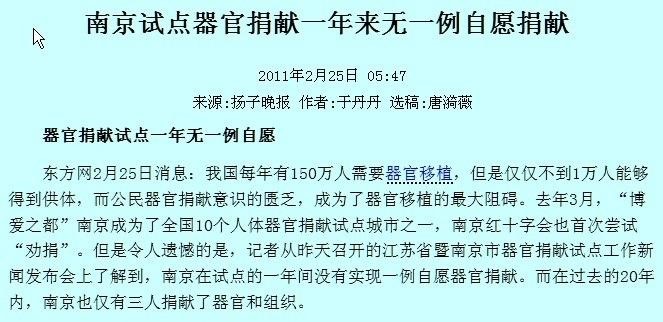
Figure 6.1 Snapshot of Yangzi Evening Newspaper
On February 25, 2011, Yangzi Evening Newspaper reported on a press conference about the Organ Donation Pilot Project held by Nanjing City, Jiangsu Province. The article revealed that since becoming one of 10 Chinese cities included in the organ donation system’s pilot project in March the previous year, Nanjing had yet to see any organ donors. Over the past 20 years, just three persons had donated their organs in Nanjing.
According to Huang Jiefu, China has about 300,000 patients annually who are in urgent need of organ transplants, yet there are only about 10,000 transplant operations per year. At present, Chinese citizens’ post mortem organ donation rate is just 0.6ppm (0.6 per one million people), making China among the countries with the lowest organ donation rates in the world.[253]
Professor Chen Zhonghua of Tongji Medical University of Huazhong University of Science and Technology stated that from 2003 to August 2009, only 130 cases of successful organ donation from deceased mainland Chinese citizens were recorded. According to data released during the 2014 Chinese Organ Transplant Conference, there were only 1,448 cases of organ donation from deceased mainland Chinese citizens in the three-year period from 2010 to 2013.[254]
III. According to organ donation organizations, organ donation cases are scarce, and the number of successful donations is few and far between
WOIPFG investigators called China’s Red Cross organ donation offices at the end of year 2015. Though few picked up the phone, those who did stated that the numbers of successful donations were very low.
1. The staff from the Red Cross Society of Beijing said that organ donation was in preparation and had not yet begun
Investigation Recording 9, “We are still in the preparatory stage for organ donation”
Subject of Investigation: A staff member from the Red Cross Society of Beijing
Date: December 6, 2015 (Phone number: 861063558766)
(Recording 9: MP3; Transcript Download: pdf9)
Beijing has the largest transplant volumes in China. The category of hospitals accredited by the Ministry of Health to conduct organ transplants independently includes 20 hospitals. However, the actual transplant volume is appalling. Zhu Jiye, director of the Urological Surgery department at Peking University People’s Hospital told China Economic Weekly that the hospital “once performed 4,000 kidney transplants within a year.”[255]
2. A Tianjin Red Cross Society staff member said that since the organ donation bank system was set up in 2003, only over 170 people have registered for organ donations by 2015
Subject of Investigation: A staff member at the Red Cross Society of Tianjin
Date: December 11, 2015 (Phone number: 862227311180)
(Recording 10: MP3; Transcript Download: pdf10)
According to a Tianjin Daily report on March 1, 2015, “the reporter recently learned from the Red Cross that since Tianjin launched the human organ donation system in March 2010, Tianjin had a total of 123 cases of successful organ donation, the cumulative number of donated large organs was 278.”[256]
Such a low number of donations cannot explain the large organ transplant volumes in Tianjin. Tianjin has four organ transplant hospitals accredited by the Ministry of Health. Out of these four hospitals, the Organ Transplant Center at Tianjin First Central Hospital has more than 500 transplant ward beds, and from 2006 to 2014, the hospital’s actual transplant volume per year was in the range of 5,000 to 8,000.[257]
3. Shanghai only had five successful cases of organ donation during almost two years
A staff member from the Red Cross organ donation office in Huangpu District, Shanghai said that they only started organ donation since the first half of year 2014. They said that a document was issued from some senior level officials regarding the process, but organ donations had been very scarce. To date, there had only been five cases of organ donation in the entire city of Shanghai.
Subject of Investigation: A staff member of the Red Cross Society’s organ donation office in Huangpu District, Shanghai
Date: December 17, 2015 (Phone number: 86-63365880)
(Recording 11: MP3; Transcript Download: pdf11)
Shanghai has 11 organ transplantation hospitals accredited by the Ministry of Health, all of which are national-level transplant centers. These hospitals carry out large numbers of organ transplants each year. So the five cases of organ donation are not the main source of organs for transplant hospitals in Shanghai.
4. One female staff member at the Red Cross branch in Qinhuangdao of Hebei Province said, “As of now, in our office, we haven’t had any organ donations.”
On May 14, 2015, a female staff member at the organ donation office of the Red Cross branch in Qinhuangdao of Hebei Province (Phone number: 86-3355311503) said, “There are people who have signed up (for organ donation), but have not donated yet. (And there are) not many of them. It is also possible to sign up at a very young age, and then we can only wait until their final moments. As of now in our Qinhuangdao area, there are no liver or heart donations, even no place to accept such donations.”
(Recording 12: MP3; Transcript Download: pdf12)
5. “It is almost impossible for Chinese people to donate their organs. We cannot find (organs from voluntary donations), almost none.”
Liu Zhonghua, chief surgeon of the Urological Department at Henan People’s Hospital said in March 2015 that it’s almost impossible for Chinese people to donate their organs. “We cannot find (organs from voluntary donations), almost none.” When asked if people who are unrelated to the patient are reluctant to donate organs, he replied, “Of course, who wants to give (his/her organs) to you?!” (Phone number: 86-13503716066)
(Recording 13: MP3; Transcript Download: pdf13)
6. “Even if the deceased’s close relatives consent to the organ donation, sometimes all it takes is one word from a distant relative, and the family changes their mind.”
On July 2, 2015 at around 9:16 am, an on-duty staff at the organ donation office of the Red Cross branch in Jiaozuo (Phone number: 86-3913933224) said that some people had registered for organ donation, but the number was very, very small; there were people who had registered, but they must wait for them to die of natural causes before organ donation could take place; the number of people who donated their organs after they passed away from accidents was very few and far between. As for those who donate organs after death, they can’t make the decision whether to donate or not after they’re dead. So their families have to call the organ donation office to give consent to the donation. Even if the deceased’s close relatives consent to donate the deceased’s organ(s), sometimes all it takes is one word from a distant relative, and the family changes their mind.
(Recording 14: MP3; Transcript Download: pdf14)
Our multi-faceted investigation proves:
The CCP falsely claims that only donated organs are used starting in 2015. On the contrary, the organ transplant industry in mainland China is still very prosperous and profitable. For example, Huang Jiefu announced a record high in organ transplantation in 2015. Where are organ donors coming from?
Chapter 7: Tens of Millions of Falun Gong Practitioners Detained for Petitioning are the Suspected Main Sources for the Organ Donor Pool
The year 2000 marked a watershed in China’s organ transplant industry. Hospitals across China, large and small, rushed to provide the facilities and the surgical teams that would culminate in the industry’s explosive growth. The entire world knew that in China the wait time for organ transplants was extremely short and there was an ample supply of organs. Every year, several thousand foreigners partook in “organ transplant tourism” in China to receive their transplant operations. This raised a question in the international surgical community: where did so many organs come from?
In the meantime, under the direction of the former CCP head Jiang Zemin, a comprehensive persecution against Falun Gong practitioners began in 1999. In response, tens of millions of Falun Gong practitioners traveled to Beijing to publicly appeal for an end to the persecution. Several million practitioners refused to give their names to the authorities in order to protect their families from persecution and were detained. These people simply disappeared without a trace.
However, at the beginning, people didn’t link the two issues together, until March 2006, when several witnesses and informants, including a veteran military doctor from Shenyang Military Region, appeared. They spoke out and testified that the CCP was harvesting organs from living Falun Gong practitioners on a massive scale, which shocked the world.
I. More than 10 million Falun Gong practitioners have been illegally arrested for peacefully petitioning
According to an internal investigation by the CCP’s Public Security Bureau, from May 1992 to July 1999, the number of Falun Gong practitioners grew from a handful of people to somewhere between 70 million and 100 million.[258]
Although Falun Gong was widely perceived even by the Chinese Communist Party as a non-violent movement that stresses the ethical principles of truthfulness, compassion and forbearance, the number of practitioners grew larger than the number (i.e. 65 million) of the Chinese Communist Party members. Out of jealousy and fear, on July 20, 1999, the then leader of the CCP, Jiang Zemin, launched a nationwide comprehensive persecution against Falun Gong practitioners. In response, tens of millions of practitioners traveled to Beijing to petition, aiming to tell the authorities and the general public the truth about Falun Gong, to appeal for an end to the persecution and to ask for their right to practice freely. Every day, practitioners from all over China went to Beijing to peacefully petition. Their petitions were met with violent kidnapping, illegal detention and repatriation to their respective provinces by the CCP.
According to the Beijing Public Security Bureau’s internal information, as of April 2001, the number of Falun Gong practitioners arrested when petitioning in Beijing and whose names were registered by the police, had reached 830,000. This excludes the practitioners who did not give their names.[259] The CCP’s internal source indicates that the period from early 2000 to late 2001 marks a peak period of Falun Gong practitioners petitioning in Beijing. By calculating the additional consumption of steamed buns in Beijing, Beijing Public Security Bureau estimated that during the peak time, on a single day, there could be more than 1 million practitioners petitioning in Beijing.[260]
To avoid implicating their families and workplaces in a persecution that had no apparent legal restraints and was becoming increasingly violent, many practitioners refused to reveal their names or other personal information to the police. As many of these “nameless” practitioners could not be registered or sent back home, and their number was large, even local schools and stadiums were filled up, they were promptly transported from short-term detention centers into the Laogai System (labor camps, prisons, black jails, psychiatric wards and long-term detention centers). Yet the CCP’s prisons and labor camps across China were already filled to capacity. As a result, the CCP transferred many of these nameless Falun Gong practitioners from the existing Laogai System into little-known underground prisons, labor camps and specialized concentration camps in remote areas.
According to sources in China, during that period of time, the CCP had 670 prisons and 300 labor camps known to the public, with a total detention capacity of approximately 1.8 million people. After large numbers of Falun Gong practitioners were thrown into these facilities, they became seriously overcrowded. Therefore, by utilizing military facilities and bunkers all over the country, the CCP built secret concentration camps where practitioners endured more covert and cruel persecution.[261] Countless Falun Gong practitioners have since disappeared, and the CCP established the conditions necessary to create an organ donor pool and carry out large-scale organ harvesting.
As early as October 1, 2000, the Agence France Presse (AFP) reported that the CCP had built two concentration camps in Northeast and Northwest China. These two camps were able to hold 50,000 detainees each. Trainloads of practitioners, who did not give their names and addresses to the authorities to avoid implicating others, were shipped to these secret concentration camps in Xinjiang. To this day, no one has come out of these camps alive.[262]
II. The CCP’s use of code numbers instead of names to identify secretly detained Falun Gong practitioners as sources within the organ pool
A WOIPFG investigator once spoke with Chen Qiang, a kidney broker who worked for the People’s Liberation Army (PLA) No. 307 Hospital in Fengtai District, Beijing. He stated clearly, “If they could not find out the real names (of the organ donors), they just left code numbers, you know.” In addition, Chen emphasized that the authorities, the police and the prison system operated a supply chain in trafficking the organs of detained Falun Gong practitioners. Chen also said that he could provide materials to confirm that the organs were indeed from Falun Dafa practitioners.[263]
(Recording 15: MP3; Transcript Download: pdf15)
Phone investigation recording is as follows:
Investigator: Hello, is that Xiao Chen?
Chen Qiang: Yes, it’s me. Speaking.
Investigator: Hello. Last time I talked to you about contacting people to get kidney sources. How is it going?
Chen Qiang: You meant that, contacting the prison for the kidney sources.
Investigator: Yes, or (kidney) sources of Falun Gong practitioners. Please find out the information for me…
Chen Qiang: I’ve heard that it’s more difficult now than before, much more difficult now.
Investigator: From where did you get (the organ sources) before?
Chen Qiang: From Xicheng (A place in Beijing).
Investigator: Xicheng, you now--- By the way, how could you be so sure that he (the “donor”) was a Falun Gong practitioner? Did you find out about this?
Chen Qiang: How to positively identify a Falun Gong practitioner? Well, when the time comes, then on our side, our higher-ups will have people show you some documents, you know. He will show you the information and documents. You can rest assured.
Chen Qiang: We have connections with the government officials, as well. There are connections with high-ranking officials.
Chen Qiang: You know, I will show you such materials even if you don’t ask me for them.
Investigator: There is one more thing that I don’t quite understand. That is, these people are detained in forced labor camps or prisons.
Chen Qiang: Right now, there are fewer in the forced labor camps.
Investigator: Really? Where are they usually being detained now?
Chen Qiang: Now they are in prisons. Normally, they are sent away from Beijing and transferred to prisons in other cities/provinces.
Investigator: I heard from others that, several years ago, they arrested many Falun Gong practitioners, who did not give their names after they were detained, quite a few; they detained them underground, the kind of place that was neither a prison nor a labor camp…
Chen Qiang: You are talking about what was going on around year 2003. I know exactly what you are talking about. They started to not reveal their names in 2003.
Investigator: So there were many in year 2003?
Chen Qiang: Yes. There were lots of Falun Gong practitioners on file from around year 2003.
Investigator: You see, the 50,000 yuan in advance is no problem. I told you already. I can give you 20,000 yuan extra to just make you feel secure. Later, you just tell me how much money you spent, you can just tell me an amount.
Chen Qiang: I also need to use contacts to find it for you. The money they ask specifically, I think it will be around 200,000 yuan.
Investigator: Right.
Chen Qiang: Last time I made some inquiries by calling people… Later you said (those organ sources) wouldn’t do, and it’s better to get (organs) from Falun Gong practitioners. Later I contacted (the labor camp or prison officials) by phone. I asked my boss to call (the official), and (that official) said they would obtain the organs from “inside (the labor camps or prisons).”
Investigator: Oh.
Chen Qiang: Now (the Falun Gong practitioners) have all been transferred to prisons in other cities/provinces. They (i.e. the officials) need to transfer (the organs) from there; that takes money. A large portion of this money must be paid to the people over there, you know.
Investigator: Yes, yes. Several years ago, they secretly detained many Falun Gong practitioners, who went to petition but did not provide their names. There were no records, no registrations.
Chen Qiang: Yes, it is quite normal, you know … If a Falun Gong practitioner did not give his name, he would be assigned a code number, you understand?
Investigator: Yes, yes.
Chen Qiang: If they could not find out their real names, they could just record code numbers, you know.
Investigator: Oh.
Chen Qiang: And also according to their fingerprints.
Investigator: It would be tantamount to assigning code numbers to these people and locking them up afterwards, right?
Chen Qiang: Definitely. If you don’t have code numbers for them, wouldn’t it become chaotic later? It wouldn’t work if there were no basis (for identification). After such a thing is done, I tell you. It is not that I want to tell you something. I can’t tell you the specific details, such as somebody’s name, you know?
Investigator: Right.
Chen Qiang: I cannot take this situation casually. How can I be so casual? We have a direct relationship (with the related parties). Since we are doing this business, we have people in every department. How can you get it done without connections?
Investigator: Yes.
Chen Qiang: Such an operation is like a supply chain, as you know.
III. 2.1 million locked up in labor camps from 2000 to 2006
China’s Caijing.com.cn reviewed the CCP’s “re-education through forced labor” system in an article published on November 16, 2013, titled “Forced Labor Camps Held Up to 300,000 People at One Point.”[264]
According to the report, after the 1990s, the number of inmates in the CCP’s labor camps rose year after year and reached a peak of 300,000 per year. Although the numbers began to drop in 2006, there were still 90,000 inmates in 2012. The peak period, mentioned in the article, was between 2000 and 2006. During this time, the number of Falun Gong practitioners brutally persecuted by the CCP was at its highest point, and the volume of organ transplant operations was also at a peak. Using an increase of 300,000 people per year from 2000 to 2006, a rough calculation suggests that the CCP held approximately 2.1 million people in their labor camps. In addition, the US government mentioned in its 2008 Religious Freedom Report that in China’s labor camps, more than half of the inmates were Falun Gong practitioners.[265] Based on this, during the six years from 2000 to 2006, approximately 1.05 million Falun Gong practitioners were detained in China’s labor camps.
In summary, we believe that during the 14-year period from 1999 to 2013, as many as several million Falun Gong practitioners could have been imprisoned in China’s forced labor camp system.
IV. The time period of explosive growth of China’s organ transplant industry highly correlates with the time period, during which Falun Gong Practitioners were persecuted
1. The explosive growth of the organ transplant industry
Since 1999, mainland China’s organ transplant industry has seen explosive growth. Across China, hospitals large and small in cities and towns of varying sizes began doing organ extraction and transplants en masse. Even some small-scale hospitals, specialized clinics and hospitals specializing in traditional Chinese medicine that lacked the proper qualification to perform organ transplants, actually began performing organ transplants. The time period during which there was a rapid growth of organ extraction and transplants correlates very strongly with the persecution of Falun Gong practitioners by the CCP. [266]
2. Organ transplant centers/tissue typing centers have emerged in great numbers
Since 1999, mainland China saw a rapid emergence of a great many organ transplant centers and tissue typing facilities. Many hospitals and medical departments, which had no transplant expertise in the past, were quickly converted into organ transplant centers. (For details, please see Chapter 1 Section VII.)
Chapter 8: Live Organ Harvesting is a State Crime Ordered by Jiang and Carried Out by the CCP
A large quantity of evidence points to a startling fact: these incidents of organ harvesting from Falun Gong practitioners are not isolated, localized or incidental murders. There are four distinct evidentiary trails that lead us to conclude that Jiang Zemin directly ordered the live organ harvesting of Falun Gong practitioners and gave the army the lead role in carrying out the murders. The many state apparatuses—the armed police, the Political and Legal Affairs Commission, the Public Security Bureau, the Procuratorate, the Courts, the judiciary system and medical facilities across the country that practice organ transplants—have been complicit in these crimes. (The evidence also touches on how harvesting has been commercialized, allowing the network of military hospitals and armed police hospitals to share the profits.) These state apparatuses have been massacring Falun Gong practitioners in a genocide by live organ harvesting. These atrocities began in year 2000 and continue to this day.
I. Four types of evidence showing Jiang Zemin personally issued the order of live organ harvesting
Starting from March 9, 2006, WOIPFG initiated an investigation into organ harvesting centers inside the communist party’s judicial system, army and armed police in 31 provinces and autonomous regions. We released 290 phone conversations, for which complete audio recordings are available, all of which are standalone, direct evidence and can be downloaded. These include:
• Five members of the Standing Committee of the Politburo
• One vice chairman of the CCP’s Central Military Commission
• A Central Military Commission member and former defense minister
• Minister of Health of the General Logistics Department of the Chinese People's Liberation Army (PLA)
• Central and local Political and Legal Affairs Commissions and officials at the "610 Offices"
• An armed police guard, who witnessed a case of live organ harvesting
• Military hospitals
• Staff members in the Red Cross Organ Donation Offices
• 44 pieces of phone investigation recording evidence and 1,628 pieces of data evidence regarding presidents, directors and doctors transplant departments of over 30 hospitals
• Organ transplant brokers
Evidence 1: Four persons admitted that Jiang Zemin directly gave the order to extract organs from Falun Gong practitioners for transplant operations.[267]
1. Investigation recording from Bai Shuzhong, Former Director of the Health Division for the Chinese People’s Liberation Army’s (PLA) General Logistics Department.
On September 30, 2014, a WOIPFG investigator called Bai Shuzhong, as a member of the Bo Xilai Special Investigation Team.
(Recording 16: MP3; Transcript Download: pdf16)
As the then-Director of the Health Division of the Chinese People’s Liberation Army (PLA) General Logistics Department, Bai played a key role in conveying Jiang’s order to slaughter Falun Gong practitioners for their organs. His term of office was between 1998 and 2004, which coincided with the peak time period of the CCP’s persecution of Falun Gong practitioners and its crime of live organ harvesting. In the phone investigation recording, Bai clearly stated that Jiang Zemin gave a direct order to harvest organs from Falun Gong practitioners for organ transplant, and that there were multiple state apparatuses beside the military, which had been involved in live organ harvesting.
Investigator: Here is the situation, when you were the Director of the Health Division for the PLA General Logistics Department, regarding excising organs from captivated Falun Gong people for organ transplantation, was it an order from Wang Ke, the then director of the PLA General Logistics Department? Or did it directly come from the Central Military Commission?
Bai: Back then, it was President Jiang. There was an order, a sort of instruction. It said to start carrying out this thing, which is organ transplantation. Later, President Jiang, (I) heard, issued an instruction, about people selling kidneys for transplant surgeries, this, I should say, it was not just the military that was doing kidney transplants.
Investigator: We also obtained some information, that is, back then, the Joint Logistics Departments (of the Military Regions) were responsible for detaining a batch of Falun Gong people as live organ donors, right?
Bai Shuzhong: This, this, back then, ah, I think, at least this is how I remembered, back then, yes. Because back then, after President Jiang issued the instruction, we all did a lot of anti-Falun Gong work.
The recording clearly shows that the live organ harvesting of Falun Gong practitioners was directly ordered by Jiang Zemin, and more than one government/CCP system, besides the military, was involved in live organ harvesting.
This phone recording affirms the weight of the evidence WOIPFG has acquired from the military, armed police, regional government agencies and the judiciary and legal systems. All of these organizations have participated in the crime of live organ harvesting. It also expounds the reasons behind this issue and confirms the judgment WOIPFG has made based on the collected evidence.
2. Investigation recording from Bo Xilai, then-Minister of Commerce
(Recording 17: MP3; Transcript Download: pdf17)
On September 13, 2006, when Bo Xilai, the then Minister of Commerce, accompanied then-Premier Wen Jiabao on a visit to Hamburg, Germany, an informant, Investigator Bao Guang, called Bo Xilai under the guise of the first secretary of the Chinese Embassy in Germany.
First Secretary: That is, when you were the governor of Liaoning Province…That is, regarding the matter of live organ harvesting of Falun Gong practitioners, was that your order or Jiang Zemin’s order?
Bo Xilai: Chairman Jiang’s!
3. Investigation recording from Tan Yunshan, the director of the Liver Pathology Department of Zhongshan Hospital, Fudan University in Shanghai
(Recording 18: MP3; Transcript Download: pdf18)
On February 8, 2015, a WOIPFG investigator reached Tan Yunshan by phone (Phone number: 86-13681972360).
Investigator: You know that Bai Shuzhong, the former Director of Health Department of the PLA General Logistics Department has admitted that Jiang Zemin had ordered to harvest organs from living Falun Gong practitioners for transplantation. Are all the hospitals still doing this under that policy?
Tan Yunshan: Yes, yes.
4. Investigation recording of Dr. Gong of the second ward of the Cardiothoracic Surgery Department at Tongji Hospital, Huazhong University of Science and Technology
On October 12, 2015, Doctor Gong of the second ward of the Cardiothoracic Surgery Department at Tongji Hospital, Huazhong University of Science and Technology, spoke with a WOIPFG investigator on the phone. Gong acknowledged their use of Falun Gong practitioners as donors for organ transplants, and that they were doing so by following Jiang Zemin’s order.
(Recording 19: MP3; Transcript Download: pdf19)
Here is an excerpt of the phone investigation conversation:
Investigator: Oh, that kind (of organs) from Falun Gong practitioners?
Dr. Gong: Even for (the organs of) the ones unclaimed by family members, we can’t use them right now.
Investigator: Well, they have always been doing this (i.e. organ harvesting)? You know, lots of hospital were doing this before, in large quantities. You know at that time, it was allowed, because Jiang Zemin ordered people to do so, when he was the state chairman.
Dr. Gong: That kind of thing can only be done when you have the government’s documents.
Investigator: Right, right. He gave an order to use organs from the imprisoned practitioners. Falun Gong practitioners’ (organs) could all be used. So Jiang Zemin gave the order at that time, and that’s why you dared to do this, is that right?
Dr. Gong: Absolutely.
Evidence 2: High-level CCP officials all knew about the crime of live organ harvesting from Falun Gong practitioners
WOIPFG’s investigations on five members of the Standing Committee of the Politburo, the vice chairman of the CCP’s Central Military Commission, a member of the Central Military Commission, and the former defense minister further confirm that Jiang Zemin issued the order to harvest organs from living Falun Gong practitioners; Zhou Yongkang, the former Secretary of the Central Political and Legal Affairs Commission, had been directly involved in implementing the policy of live organ harvesting; the PLA General Logistics Department has been the core agency responsible for live organ harvesting; and high-ranking CCP officials have all been well aware of the live organ harvesting from Falun Gong practitioners. [268]
1. Zeng Qinghong, former member of the CCP Central Politburo Standing Committee
On August 8, 2007, Zeng Qinghong attended the celebration of the 60th anniversary of the establishment of the Inner Mongolia Autonomous Region. An investigator of WOIPFG called Zeng Qinghong’s hotel room phone number. On the phone, Zeng Qinghong did not deny that “the army participated in the organ harvesting of Falun Gong practitioners” and stressed that “you should find out through your normal channels.” [269]
(Recording 20: MP3; Transcript Download: pdf20)
2. Zhou Yongkang, former member of the CCP Central Politburo Standing Committee, former secretary of the CCP Central Political and Legal Affairs Commission
On May 29, 2008, a WOIPFG investigator pretending to be “Li Chuncheng, Sichuan Provincial Communist Party Committee Secretary” carried out a phone conversation on Zhou Yongkang. Zhou did not deny the statement that some Falun Gong practitioners were being held at facilities such as military warehouses and bomb shelters, but emphasized that this matter could only be discussed through a secure phone line.[270]
(Recording 21: MP3; Transcript Download: pdf21)
3. Guo Boxiong, former member of the CCP Central Politburo, Vice Chairman of the CCP Central Military Commission
During Guo Boxiong’s visit to Central America from October 23 to November 4, 2011, a WOIPFG investigator had a phone conversation with Guo, in the name of the secretary of Zhou Yongkang, the former head of the Central Political and Legal Affairs Commission. Guo did not deny the existence of “live organ harvesting from imprisoned or detained Falun Gong practitioners for transplant operations.” He only emphasized that further discussion should be conducted “through a confidential phone line.”[271]
(Recording 22: MP3; Transcript Download: pdf22)
4. Liang Guanglie, former Minister of National Defense, member of the CCP Central Military Commission
Liang Guanglie is the former Minister of National Defense and a retired People’s Liberation Army (PLA) general. He once served as the PLA Chief of the General Staff. A phone investigation conducted by a WOIPFG investigator took place during his trip to the U.S. from May 4 to May 10, 2012. In this phone investigation, Liang admitted that the Central Military Commission held meetings to discuss the issues about Falun Gong practitioners detained by the military and that the military hospitals were involved. Liang also suggested that it was the PLA General Logistics Department that should be contacted to collect related information rather than him.[272]
(Recording 23: MP3; Transcript Download: pdf23)
5. Li Changchun, former member of the CCP Central Politburo Standing Committee
On April 17, 2012, during an undercover phone call with Li Changchun, a WOIPFG investigator said to Li, “We got information that, while you and Jia Qinglin are away (from Beijing), we should use Bo Xilai’s involvement in murdering and excising organs from Falun Gong practitioners to convict Bo. At that time…” Li answered immediately, “Zhou Yongkang is in charge of this specifically. He knows it.” [273]
(Recording 24: MP3 Transcript Download: pdf24)
6. Zhang Dejiang, former member of the CCP Central Politburo Standing Committee, Director of the National People’s Congress (NPC) Standing Committee
On June 15, 2015, while Zhang Dejiang was on an official visit to India, a WOIPFG investigator called him in the name of Secretary Liu working at Jiang Zemin’s office. When Zhang was asked, “Comrade Jiang Zemin wants to know, whether Zhou Yongkang, after having been sentenced to prison, has confessed that it was Jiang Zemin, who authorized the practice of live organ harvesting against imprisoned Falun Gong practitioners for organ transplantation?” Zhang did not deny the allegation, but only answered, “Let’s talk when I’m back home, shouldn’t we?” “It’s inconvenient to talk on cell phones while being abroad.”[274]
(Recording 25: MP3; Transcript Download: pdf25)
7. Zhang Gaoli, then member of the CCP Central Politburo Standing Committee, Vice Premier of the State Council
On June 24, 2015, while Zhang Gaoli was on an official visit to Kazakhstan, a WOIPFG investigator, disguised as a secretary working for Jiang Zemin, phoned Zhang Gaoli.[275] When asked about Falun Gong practitioners filing lawsuits against Jiang Zemin for harvesting organs from millions of practitioners, Zhang did not deny the allegation at all. Instead, Zhang eagerly promised, “I will definitely … prevent this matter from being pursued at the Politburo’s meeting.”
(Recording 26: MP3; Transcript Download: pdf26)
Evidence 3: The CCP’s Central Political and Legal Affairs Commission (PLAC) and the 610 System are directly involved in the crime of live organ harvesting
High-ranking officials of the Political and Legal Affairs Commission further confirmed the crime of live organ harvesting:
1. Zhou Benshun, former Secretary-General of the CCP Central Political and Legal Affairs Commission
In November 2008, Zhou Benshun, the then secretary-general of the CCP Central PLAC, accompanied Zhou Yongkang, the director of the CCP Central PLAC, on a visit to Australia. A WOIPFG investigator disguising himself as Yang Hui, the head of the Second Department of the People’s Liberation Army (PLA) General Staff Headquarters, collected a testimony from Zhou Benshun about the massive live organ harvesting from Falun Gong practitioners by the CCP. Zhou admitted, “Such a thing as live organ harvesting from Falun Gong practitioners in our country, it does exist in our country.”
Zhou Benshun was the vice secretary-general and later secretary-general of the CCP Central PLAC from 2004 to 2013. Ultimately, he was one of the high-level officials and organizers involved in the implementation of live harvesting organs from Falun Gong practitioners.[276]
(Recording 27: MP3; Transcript Download: pdf27)
2. Wei Jianrong, former Vice Director of the CCP Central PLAC Office
On September 26, 2008, former vice director of the CCP Central PLAC Office, Wei Jianrong, admitted that live organ harvesting from detained Falun Gong practitioners “started a long time ago.”[277]
(Recording 28: MP3; Transcript Download: pdf28)
3. Tang Junjie, former Deputy Secretary of the PLAC in Liaoning Province
Liaoning Province was suspected to be the very first province involved in large-scale live organ harvesting from Falun Gong practitioners. On April 13, 2012, when the former Deputy Secretary of PLAC in Liaoning Province, Tang Junjie, was asked, “What kind of directions or commands did Bo Xilai issue regarding the extraction of organs from Falun Gong practitioners?”, he replied, “I was asked to take care of this task. The party central was actually emphasizing on this... At that time, we mainly discussed it during the meetings within the Standing Committee.”[278]
(Recording 29: MP3; Transcript Download: pdf29)
4. Secretary Yu working for Luo Gan, former Member of the CCP Central Politburo Standing Committee
When the CCP started the persecution of Falun Gong, Luo Gan was the director of the Central PLAC. On October 28, 2006, Luo Gan’s secretary Mr. Yu said to a WOIPFG inestigator, “I cannot give you a clear explanation in a short conversation.” He then asked the disguised investigator to call him from a secure phone line (a red phone).[279]
(Recording 30: MP3; Transcript Download: pdf30)
5. A Beijing PLAC official surnamed Li
From September 16 to 26, 2008, a Political and Legal Affairs Commission (PLAC) national meeting was being held in Jiangnanchun Hotel, Changzhou City, Jiangsu Province. A WOIPFG investigator conducted a phone investigation on one of the meeting participants, Mr. Li, who’s a staff member of the PLAC system in Beijing.
Investigator: Well, we want to know which levels of officials from your PLAC system are familiar with a certain state secret.
Li: What is this about?
Investigator: This is regarding the state secret of live organ harvesting from Falun Gong practitioners for organ transplant operations. Which levels of officials of the PLAC are privy to this state secret?
Li: Should be all the levels above the division level.[280]
(Recording 31: MP3; Transcript Download: pdf31)
6. Director of the 610 Office in Ji County, Tianjin
Director of the 610 Office in Ji County, Tianjin, admitted to a WOIPFG investigator that the plastinated human bodies and cadavers sold illegally by Bo Xilai’s wife Gu Kailai “were not all from Falun Gong practitioners.”[281]
(Recording 32: MP3; Transcript Download: pdf32)
7. Sun Guangtian, deputy mayor of Dalian, former director of the Public Security Bureau in Dalian
On September 18, 2012, a WOIPFG investigator disguised himself as the secretary of Xia Deren, who was the deputy secretary of CCP Committee of Liaoning Province, in order to collect testimony from Sun Guangtian, the former director of the Public Security Bureau of Dalian from 2000 to 2003. They talked about the involvement of Bo Xilai and his wife in selling Falun Gong practitioners’ corpses.[282]
(Recording 33: MP33; Transcript Download: pdf33)
Evidence 4: Systematic involvement of the military, police, the judiciary and legal systems and hospitals across China in the live organ harvesting[283]
The evidence includes but is not limited to:
• The testimony from an armed guard who was an eyewitness to organ harvesting
• Chen Qiang, a kidney broker, who worked for the transplant division of the PLA No. 307 Hospital in Beijing, admitted that the authorities, the police and the prison system collude in trafficking organs snatched from Falun Gong practitioners. Chen said that he could provide documents to prove that the organs came from Falun Gong practitioners.
• Staff from the Intermediate People’s Court of Jinzhou openly admitted that organs harvested from Falun Gong practitioners were available.
• Audio recordings of organ transplant doctors of more than 30 hospitals confirm that organ donors were in fact detained Falun Gong practitioners.
• Chen Rongshan, former Director of the Urology Department of the PLA No. 205 Hospital, said that the courts were also involved in organ harvesting, and that he promised to not disclose the use of organs from Falun gong practitioners in organ transplant operations.
• Evidence have been collected from 9,500 organ transplant doctors in 865 hospitals suspected of having committed live organ harvesting.
1. Testimony from an armed guard who is an eyewitness of live organ harvesting
Investigation Date: December 12, 2009
An armed police officer from Jinzhou City in Liaoning Province, who used to be an armed guard at a live organ-harvesting site, testified that he witnessed the entire process of organ harvesting from a Falun Gong practitioner. The guard told WOIPFG about this extremely horrifying crime he had witnessed.
(Recording 34: MP3; Transcript Download: pdf34)
On April 9, 2002, in a surgery room on the 15th floor of the General Hospital of Shenyang Military Region, he saw a female Falun Gong practitioner in her 30s, who was a middle school teacher and had wounds and scars covering her entire body, as the result of a week of brutal torture, rape and force-feeding. The Public Security Bureau of Liaoning Province sent two military doctors, one from the Shenyang Army General Hospital of the PLA, and the other a graduate of the Second Military Medical University. One of them had military official ID No. 0106069. They did not administer any anesthesia to the victim and extracted her heart, kidneys and other organs while she remained fully conscious, cold-bloodedly killing her in the process. During the entire process, the eyewitness was present and stood to one side as an armed guard.
Aside from exposing the graphic details of the organ harvesting operation, the eyewitness disclosed additional information. He said that the Public Security Bureau of Jinzhou City had murdered numerous Falun Gong practitioners through various means of torture, and then claimed that the deaths were results from suicides or accidents. Some Falun Gong practitioners had their brain pulp sucked out after they were killed. And even more evil things have done to Falun Gong practitioners….
The following is a partial transcription of the testimony recording:
Eyewitness: The scalpel was held by the chest, when it cut into the victim, the blood gushed out, the blood gushed out instead of…
Investigator: Was the victim a man or a woman?
Eyewitness: A woman.
Investigator: Was she young?
Eyewitness: A little over 30 years old.
Investigator: Was she still shouting “Falun Dafa is good”?
Eyewitness: She was still shouting, still shouting that.
Investigator: Tell me how she said it.
Eyewitness: We had interrogated and brutally tortured her for a week already. Her body was covered in countless wounds and scars. We had shocked her with stun guns, stunned her. She had been out of her wits…out of her wits. She had lost her mind, basically. She had also been refusing food, so we had had to force feed her milk into her stomach. Whenever she refused, we had to force feed her. You know when you pinch a person’s nose, the person has to instinctively open up the mouth and swallow. So that’s how we had kept her alive. She had lost 15 Jin (a unit of weight, equal to half a kilogram) in 7 days. And then I wasn’t sure who–maybe some office at the Public Security Bureau of Liaoning Province, anyway, it was a very secretive office–they sent two people. One was a military doctor from the Shenyang Army General Hospital of the PLA. One was a graduate of the Second Military Medical University. Basically, one was more elderly, the other one was young. Basically, she was sent to an operating room at a psychiatric hospital, and a set of procedures were performed on her. They did not administer any anesthesia to her. They held the scalpel by her chest. Their hands did not tremble at all. If it were me, I would have trembled for sure. I might have served in the armed police force, I carried a gun and I participated in military exercises with real ammo, and I’d seen lots of dead bodies, but when I saw those military doctors, I had to give it to them. Their hands did not tremble at all. They just pulled up their masks and [the gurney] was pulled close. We each held a gun and stood to the side, guarding. They had already cut into her, she screamed, the woman screamed, and shouted “Falun Dafa is good”.
Investigator: When the scalpel cut into her chest, she shouted “Falun Dafa is good”?
Eyewitness: [She] screamed, and said “Falun Dafa is good”. [She] said, “You can kill me…” Basically, she meant “you can kill me, but can you kill hundreds of millions of us, people who are being persecuted for believing in a true faith.” At that moment, the doctors, the military doctors, hesitated. They shot me a glance, and then shot our senior official a glance, and the official nodded. He continued with the blood vessels…first was the extraction of the heart, and then the extraction of the kidneys. When the scissors cut into a blood vessel in the heart, she began convulsing, it was extremely terrifying. I can imitate her screams, but I am not good at it. Her screams were like something was tearing up, tearing up, and then, ah, ahhh….her mouth was gaping, her eyes popping, mouth gaping. Oh dear…I can’t go on talking about this.
Investigator: I understand. Do you know her name?
Eyewitness: Her name is…I can’t disclose that, I can’t tell you that, because there were only a few of us in that operating room.
Eyewitness: How about this, I will give her a code name, how about “Xue Mei Gui” (“Snow Rose”). Her name means a kind of flower, so we will call her “Xue Mei Gui”.
Investigator: We will call her “Xue Mei”, “Mei” as in “Mei Gui” (“Rose”).
Eyewitness: You could also use “Mei” as in “Mei Hua” (“Plum Blossom”).
Investigator: Okay, Xue Mei it is then.
Eyewitness: At the time, she was a teacher, a teacher at a middle school. I think her son should be 12 years old this year. Her husband is not someone with abilities or means, I think he’s a factory worker. Prior to her death, she had been through unspeakable molestation. A lot of the policemen are very sexually perverted. What they did to her, they used pliers, vaginal speculum. I don’t know where they got that equipment. These things I witnessed firsthand. I only regret that I did not take any photographs of what they did. The policemen sexually violated her. She was kind of good looking, kind of pretty. They raped her… they did so many such things [to her].
Investigator: You witnessed this at the Public Security Bureau you were working at…
……
Eyewitness: There were other things that were even more sinister, basically…basically…I feel that I owe her, whenever I think back to that moment, I feel I owe her. I couldn’t save her.
……
2. The PLA No. 307 Hospital in Fengtai, Beijing
Subject of Investigation: Chen Qiang, a kidney broker for the People’s Liberation Army No. 307 Hospital in Fengtai District, Beijing
Investigation Date: April 10, 2007
Chen Qiang was a kidney broker, who worked for the organ transplant division of the PLA No. 307 Hospital in Beijing. He admitted that officials, police and the prisons operate like a supply chain in trafficking organs harvested from Falun Gong practitioners. He was even able to provide documents to confirm that the organs were from Falun Dafa practitioners.[284]
(Recording 35: MP3; Transcript Download: pdf35)
Phone investigation recording:
Investigator: Hello, is that Xiao Chen?
Chen Qiang: Yes, it’s me. Speaking.
Investigator: Hello. Last time I talked to you about contacting people to get kidney sources. How is it going?
Chen Qiang: You meant that, contacting the prison for the kidney sources.
Investigator: Yes, or (kidney) sources of Falun Gong practitioners. Please find out the information for me…
Chen Qiang: I’ve heard that it’s more difficult now than before, much more difficult now.
Investigator: From where did you get (the organ sources) before?
Chen Qiang: From Xicheng (A place in Beijing).
Investigator: Xicheng, you now--- By the way, how could you be so sure that he (the “donor”) was a Falun Gong practitioner? Did you find out about this?
Chen Qiang: How to positively identify a Falun Gong practitioner? Well, when the time comes, then on our side, our higher-ups will have people show you some documents, you know. He will show you the information and documents. You can rest assured.
3. Intermediate People’s Court of Jinzhou, Liaoning Province
Investigation Subject: A criminal court police at the Intermediate People’s Court of Jinzhou
Investigation Date: May 22, 2006
A court officer from the first division of criminal law at the Intermediate People’s Court of Jinzhou stated clearly, “If your conditions (referring to the prices) are good, we can provide (organs of Falun Gong practitioners).”
(Recording 36: MP3; Transcript Download: pdf36)
4. The Chinese Communist regime gave away evidence of the crime of organ harvesting
Investigation Subject: Doctor Lu Guoping of Guangxi National Hospital’s Urology Department
Investigation Date: May 22, 2006.
Doctor Lu Guoping of Guangxi National Hospital admitted that some organs used for transplants were from Falun Gong practitioners, and the CCP media unintentionally confirmed the validity of WOIPFG’s phone investigation.
In 2008, the Chinese embassy and consulate in Canada released a TV program produced by Hong Kong Satellite TV in an attempt to deny the CCP’s live organ harvesting of Falun Gong practitioners.
In the program, Doctor Lu Guoping of Guangxi National Hospital’s Urology Department was interviewed. He admitted that he was the person, who answered a phone call from a WOIPFG investigator on May 22, 2006, but he denied his own words. The video was distributed by many Chinese embassies and consulates, so its validity was acknowledged by the CCP government.
However, Lu Guoping had a very strong regional accent and a severe stammer. His phone investigation by WOIPFG lasted more than half an hour, and its recording couldn’t have been mimicked or fabricated by using synthetic voices. Therefore, the CCP’s rebuttal video became a very good piece of evidence that could be used to compare Lu’s voices in the WOIPFG recording and the video and to positively identify him. The TV documentary has been distributed by some Chinese embassies and consulates, so the authenticity of Lu Guoping’s account of live organ harvesting Falun Gong practitioners was indirectly confirmed by the CCP government.
(Recording 37: MP3; Transcript Download: pdf37)
5. “Falun Gong (Practitioners)... We also have those, there has been one case this year.”
Investigation date: May 6, 2014 (Phone numbers: 01186-51267780100,-13606210812)
On May 6, 2014, Shen Zhenya, Director of the Cardiovascular Surgery and Research Department at the First Affiliated Hospital of Soochow University, said: “We now have (donors) every month. If you come, I estimate that the wait time is a little more than half a month. We should be able to find a donor. Organs from Falun Gong (practitioners)... we also have (this kind). There has been one (such) case this year.”
(Recording 38: MP3; Transcript Download: pdf38)
6. “I think you are well aware of that, so we don’t have to spell it out.”
Investigation date: March 18, 2014 (Phone number 01186-13910765179)
On March 18, 2014, Zeng Wen, deputy director of the Cardiovascular Surgery of the Anzhen Hospital in Beijing said, “I think you also know where most of the donors come from. I think you are well aware of that, so we don’t have to spell it out.” When asked whether Falun Gong practitioners were the source of the donors, Zeng did not deny, but only replied, “I can’t talk anymore” and ended the conversation.
(Recording 39: MP3; Transcript Download: pdf39)
7. Reported Evidence: Doctors in mainland China savagely murder for organs[285]
In 2015, WOIPFG received the telephone recordings from two Falun Gong practitioners. The recordings were telephone conversations that showed the shocking lack of conscience of some mainland Chinese doctors, who were slaughtering practitioners for their organs. The doctors not only claimed that the volume of organs harvested was “innumerable” and “countless,” one doctor also openly threatened to murder the Falun Gong practitioner that called him.
1) “Yes, it’s from a Falun Gong (practitioner), so what?”
On December 21, 2015, when answering a Falun Gong practitioner’s phone call at 9:55 am, the doctor on duty (male, possibly Li Lunming, phone number 86-503165709) at the Department of Cardiac Transplantation of the Central Hospital of Jiangmen in Guangdong Province claimed, “Yes, it’s from a Falun Gong (practitioner), so what?” “I do it every day.” “We have done a lot of (live organ harvesting), you probably haven’t thoroughly investigated the quantity, way too many.”
(Recording 40: MP3; Transcript Download: pdf40)
2) “(If) you dare to come here, I will kill you.”
On December 21, 2015 at 10:54 p.m., during a phone call that lasted 19:08 seconds, when a Falun Gong practitioner asked the doctor on duty (phone number 867503165709) at the Department of Cardiac Transplantation, Central Hospital of Jiangmen, Guangdong Province, “How many organs have you dug out from living Falun Gong practitioners?”, he replied, “Countless.” When asked again, “Do you dare to confirm it is ‘countless’?”, he repeated again, “Countless.” The doctor then directly threatened the Falun Gong practitioner who called him, “(If) you dare to come here, I will kill you. I kill you to see whether you go to heaven or hell.”
(Recording 41: MP3; Transcript Download: pdf41)
According to WOIPFG’s investigation, Jiangmen Central Hospital (aka. Affiliated Jiangmen Hospital of Sun Yat-sen University) began performing kidney transplants in 1999, liver transplants in July 2002, and conducted its first heart transplant in December 2005. The timeline of this hospital’s involvement in transplant surgeries coincides with that of the CCP’s persecution of Falun Gong.[286]
8. 20 hospitals directly admitted in the telephone investigation that organs are from Falun Gong practitioners
Top surgeons from all over the country—from organ transplant centers in Beijing and Tianjin to organ transplant departments of hospitals in Shanghai, Wuhan, Guangdong and Guangxi—clearly admitted that Falun Gong practitioners were used as organ donors and guaranteed that, in most cases, they could arrange a transplant surgery within one or two weeks.
Table 8.1. 20 Hospitals Admitted Using Falun Gong Practitioners’ Organs in Phone Recordings[287]
|
Hospital |
Confirmation of Falun Gong practitioners as organ sources |
|
1. The People’s Liberation Army (PLA) No. 307 Hospital |
Chen Qiang, a surgeon at the hospital’s organ transplant department and also a kidney broker, admitted that the CCP officials, police and prison authorities orchestrate and operate the trafficking of Falun Gong practitioners’ organs, and they could even provide identification information, proving that the organ “donors” were indeed Falun Gong practitioners.[288] (Recording 15: MP3; Transcript Download: pdf15) |
|
2. The People’s Liberation Army No. 205 Hospital |
Chen Rongshan, the head of the Urology Surgery Department, admitted that the “donors” were detained Falun Gong practitioners, and this was done through the court. [289] (Recording 43: MP3; Transcript Download: pdf43) |
|
3. Tianjin First Central Hospital |
Director Song said, “We have similar situations (Falun Gong practitioner organs).”[290] |
|
4. Affiliated Zhongshan Hospital of Fudan University in Shanghai |
A surgeon said, “What we have here all belong to this type [Falun Gong practitioners].”[291] (Recording 2: MP3; Transcript Download: pdf2) |
|
5. Affiliated Hospital of Shanghai Jiaotong University (Shanghai First People’s Hospital) |
Surgeon Dai said, “There is one kind, the ones doing the practice. Their bodies are very good.”[292] (Recording 1: MP3; Transcript Download: pdf3) |
|
6. Guangxi National Hospital |
Urology transplant surgeon Lu Guoping admitted that the hospital used Falun Gong practitioners as organ sources. The CCP has also provided relevant evidence, and live organ harvesting cannot be denied.[293] (Recording 37: MP3; Transcript Download: pdf37) |
|
7. Third Affiliated Hospital of Sun Yat-sen University |
Falun Gong practitioners’ organs can be found for organ transplants.[294] |
|
8. General Hospital of Guangzhou Military Region |
Investigator: “If you could obtain Falun Gong [practitioner] kidney sources in this period of time, could you let me know?” |
|
9. Second Affiliated Hospital of Hubei Medical University |
Investigator: “What about kidney sources from prisoners who practice Falun Gong at your place?” |
|
10. Wuhan Tongji Hospital |
Investigator: “Using supplies of live organs from Falun Gong (practitioners), is that okay?” Answer: “It’s not a problem.”[297] |
|
11. Shandong Qianfoshan Hospital |
Investigator: “There are some livers that come from Falun Gong practitioners. So I want to know if you have this type or not?” |
|
12. Wuhan General Hospital of the Guangzhou Military Region |
Director Tang of the kidney transplant department said, “If it is available from Falun Gong, then we use it.”[299] |
|
13. The First Affiliated Hospital of Suzhou University |
Cardiovascular surgery department and research lab director Shen Zhenya said, “Falun Gong practitioners ... Yes, we also have those. We had one case this year…”[300] (Recording 38: MP3; Transcript Download: pdf38) |
|
14. The Second Artillery General Hospital |
Lu Wei, deputy director of transplant department, said, “(We) still do (organ transplants) right now. In the past, we used Falun Gong donors.”[301] |
|
15. Beijing Anzhen Hospital |
Deputy Chief Physician Zeng Wen of cardiac surgery department said, “I think you also know where the majority of donors come from. I think you know this very well, so we don’t have to say it explicitly…”[302] (Recording 39: MP3; Transcript Download: pdf39) |
|
16. Second Affiliated Hospital of Tsinghua University; Beijing Yuquan Hospital |
Surgeon Li Honghui said they could provide Falun Gong practitioners’ kidneys.[303] |
|
17. Chengdu City Air Force Hospital |
Director Xu Yahong said that there would be a batch of kidney donors after the middle of May 2006, and that the hospital could provide young and healthy Falun Gong practitioners’ organs.[304] |
|
18. Foshan Hospital of Traditional Chinese Medicine, Guangdong Province |
Ophthalmology department director Liang Xianjun said, “The previous donors were Falun Gong (practitioners) and condemned prisoners.”[305] |
|
19. Second Affiliated Hospital of Guangzhou Medical College |
A surgeon said that there would be a batch of organ donors coming to the hospital in mid-April 2006. The practitioners were in better health (than average). The kidneys were from young people between 20 and 30 years of age, with no infectious diseases, AIDS or syphilis.[306] |
|
20. General Hospital of Shenyang Military Region |
A doctor said, “Falun Gong practitioners? Oh, that has nothing to do with you. You just want to have a kidney transplant operation? Rest assured, (the donors) we have are all young guys in their 20s.”[307] |
II. Strong incentives promoting the development of new transplant technologies
1. Jiang Zemin personally signed an order to have the CCP Central Military Commission grant Wu Mengchao the honor of “Leading Medical Expert” and awarded Wu a first-class medal
According to the CCP-controlled media, Jiang Zemin met with Wu Mengchao four times for having achieved breakthroughs in key liver transplant challenges, notably, the issue of liver transplant rejection. Wu holds the titles of President of the Eastern Hepatobiliary Hospital affiliated with the Second Military Medical University, Chief Consultant of the Army Organ Transplant Conference, and is known as the “father of hepatobiliary surgery in China”. Jiang personally signed an order to have the CCP Central Military Commission hold a special conference to grant Wu the honor of “Leading Medical Expert”, and awarded Wu a first-class medal.[308]
For having solved problems regarding liver transplant rejection and other key issues during the peak period of live organ harvesting of Falun Gong practitioners, Wu Mengchao was given the 2005 Annual National Supreme Science and Technology Award.[309] On January 17, 2006, Sun Dafa, Political Commissar of the General Logistics Department, awarded 1 million yuan (US$153,000) to Wu on behalf of the Department.[310]
By 2010, Wu Mengchao had completed more than 4,000 liver transplants. On October 10, 2011, the Central Propaganda Department, the Ministry of Health, the General Political Department, the General Logistics Department and the Shanghai Municipal Party Committee jointly held a “General Assembly to Present the Meritorious Deeds of Comrade Wu Mengchao” in the Great Hall of the People. Xu Caihou (former vice chairman of the CCP Central Military Commission), Li Jinai (current director of the General Political Department) and Liao Xilong (current director of the General Logistics Department) attended the event.[311] These three men are key figures in the Chinese military’s involvement in live organ harvesting.
2. Officials at different administrative levels promote the organ transplant industry
1) Zhang Gaoli, then secretary of the Tianjin Municipal Party Committee, visited an organ transplantation center and encouraged the center to “continue tapping into the advantage of organ transplantation”.
From 2007 to 2012, Zhang Gaoli was the secretary of the Tianjin Municipal Party Committee. The Organ Transplantation Center of Tianjin First Central Hospital is suspected of committing organ harvesting on a massive scale. On July 17, 2010, Zhang visited the center and stated that the Tianjin municipal Communist Party Committee and the Tianjin municipal government would continue to support the work of the Red Cross Society and to promote the advantages of the Tianjin medical institutions in organ transplantation. This hospital allegedly conducted one third of all liver transplants in the entire country in that year.[312]
2) Han Qide, then Vice Chairman of the Standing Committee of the 11th National People’s Congress, personally guided and established the Organ Transplantation Center of Peking University.
3) Meng Jianzhu, then Secretary of the Jiangxi Provincial Party Committee, supported the organ transplantation industry at the First Affiliated Hospital of Nanchang University.[313]
4) Bo Xilai, then Secretary of Liaoning Provincial Party Committee, is suspected of using Falun Gong practitioners to make plastinated bodies and conduct human experiments.
In our investigation, the Public Security Bureau, the Procuratorate and the legal systems, which were run by Luo Gan, then-Director of the CCP’s Central Political and Legal Affairs Commission, and later by Zhou Yongkang, Luo’s successor, are key agencies in the persecution of Falun Gong practitioners and in supplying “fresh human bodies”. Both Bo Xilai and his wife Gu Kailai are primary suspects in these crimes.[314]
3. The military solves the issues of transplant rejection and organ preservation
1) The army established an early warning system for transplant rejection and developed the non-invasive diagnosis
Shi Bingyi, director of the Institute of Organ Transplantation of the PLA No.309 Hospital, established a system giving early warning of transplant rejection through non-invasive diagnosis, which has become an important diagnostic method in the case of acute rejection. This development is patented by the state. Shi also established the low-dose immunosuppressive program in conjunction with the traditional medicine program to combat transplant rejection.[315]
In February 2012, during an interview with Xinhuanet, Shi said that the most important issues of organ transplantation were organ function preservation and organs’ extended survival. “There are two solutions: one is stem cell transplants; another solution is to improve the regulatory immune cell network such as through regulatory T cells. The latter has a good effect for extended organ preservation and immune tolerance. This is one of the transplant medicine advances we have achieved that places us at the forefront of transplant medicine worldwide.”
2) China has 396 organ transplant-related patents
As we know, transplant surgery requires an organ preservation solution and patients rely on anti-rejection agents during the postoperative stage. With the surge in organ transplant volume in China, many have wondered why the overseas market hasn’t seen a corresponding increase in demand for organ preservation solutions and anti-rejection agents. We discovered that many Chinese domestic transplant institutions began related research and development many years ago, and most organ transplant hospitals in China employ domestically developed products instead of relying on imported products.
With regard to immunosuppressive drugs, Li Leishi, member of the Chinese Academy of Engineering and director of the Institute of Nephrology Research of Nanjing Military General Hospital, found that Triptolide (monomer), the herbal extract of Tripterygium wilfordii, is an effective immunosuppressant, and has good efficacy in the treatment of acute rejection of kidney transplants.[316] Li Yantang, director of the Department of Urological Surgery of the PLA General Hospital, and his student Qian Yeyong are also engaged in the research of tripterygium glycosides, a kidney transplant anti-rejection drug made from Tripterygium wildfordii. Qian’s research is part of the research carried out under the National Natural Science Foundation of China.[317] Qian was the first one to succeed in using this immunosuppressant in clinical organ transplantation.[318]
Since 1999, China has patented 396 organ transplant-related products, 253 of which are anti-rejection drugs, accounting for 68.9 percent. WOIPFG has archived the online profiles of all these patents. The following is one of such transplant immunosuppressant patents by the Institute of Pharmacology and Toxicology, which belongs to the Academy of Military Medical Sciences of the Chinese PLA:
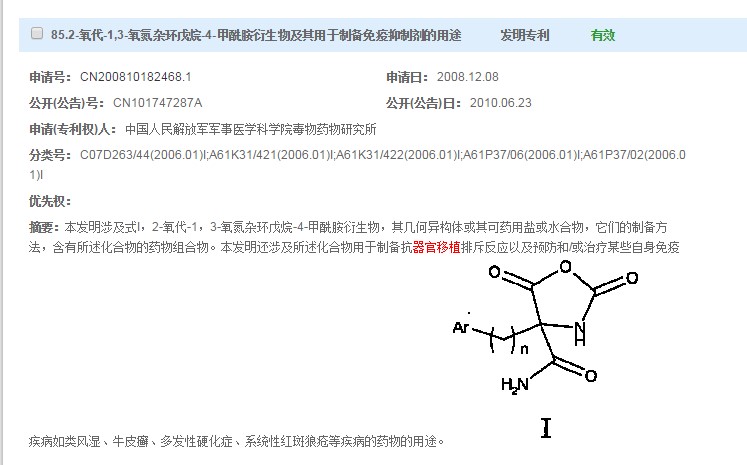
Figure 8.1 A patent for an immunosuppressant for organ transplants by the Academy of Military Medical Sciences
3) An archived webpage of Shanghai Changzheng Hospital showed “98 percent of Chinese hospitals use the organ preservation solution developed by our hospital”
Shanghai Changzheng Hospital of the Second Military Medical University was one of the first hospitals to conduct kidney transplant surgeries. With the funding provided by the Shanghai Science and Technology Commission, Zhu Youhua, a member of the Military Organ Transplantation Institute, and his team led the way in finishing the research on the kidney and multi-organ preservation solution, and put it into clinical application for 20 years, so that China’s research in this field is at the forefront of the world.[319] As displayed on Changzheng Hospital’s archived webpage, “98 percent of Chinese hospitals use the organ preservation solution we’ve developed.”[320]
This hospital has conducted a startling number of emergency liver transplants. The minimum wait time for a surgery was just four hours after a patient became hospitalized. Zhu Youhua had personally completed 3,680 cases of kidney transplantation by the end of year 2010.[321]

Figure 8.2 Archived web page of Shanghai Changzheng Hospital of the Second Military Medical University: “98% of Chinese hospitals use the organ preservation solution developed by our hospital.”
Not only military institutes, but regional medical universities, hospitals and pharmaceutical institutes are also involved in this field of research and development. For example, the Organ Transplantation Institute of China Medical University has also taken part in the research and development of an organ preservation solution, and developed a kidney preservation solution. The institute claims that it is at the forefront domestically in its research into organ preservation.[322]
We believe that such research, development and production of key transplant drugs are not initiated by the individual organ transplant centers themselves, but are instead dictated by the CCP as part of its support for carrying out the nationwide live organ harvesting.
4. Profiteering through bloody organ harvesting
Since profits from organ transplants would not be accounted for in the military budget, and the layers of the organ harvesting system are maintained by the military spending, organ harvesting from living Falun Gong practitioners and organ trafficking have become a way of making money without costs, and the CCP military officials are benefitting directly from the General Logistics Department. [323]
For example, the medical gross income of the organ transplant center of the No.309 Hospital, the “PLA Organ Transplant Center”, named by the Health Section of the General Logistics Department, increased from 30 million yuan (US$4.5 million) in 2006 to 230 million yuan (US$34.6 million) in 2010, a 5-year growth of nearly 800 percent.[324]
In another example, Daping Hospital Affiliated to the Third Military Medical University started performing organ transplants in the late 1990s, and the annual income of the hospital increased from 36 million yuan (US$5.4 million) to over 900 million yuan (US$135.5 million) in 2009, an increase of 25 times.[325]
Chapter 9: The Estimated Scale of Organ Transplantation in China
Under the cover of the Iron Curtain, it is very difficult to investigate crimes committed by the CCP, which is the wicked, deceitful, brutal and the largest totalitarian terrorist organization in the history of mankind. And it is even more difficult to determine the specific number of live organs harvested from Falun Gong practitioners by the CCP.
However, through various sources of evidence, and the “slip-ups” by CCP conspirators, we now have a picture of the massive scale of the CCP’s crimes against humanity. Comprehensive evidence proves that the CCP’s harvesting of organs from living Falun Gong practitioners is a crime committed on a national scale – and the number is frightening.
WOIPFG has investigated and collected evidence from organ transplant medical institutions from 22 provinces, 5 autonomous regions and 4 municipalities directly under the control of mainland China’s central government.
As of December 2014, WOIPFG’s investigation had discovered that a total of 865 hospitals and 9,500 doctors had been involved in live organ harvesting. (Of these hospitals, 712 were performing liver and kidney transplants[326]). These hospitals were found in 22 provinces, 5 autonomous regions, 4 central government directly controlled municipalities and 217 prefect-level municipalities.
The implicated hospitals were part of the Chinese military system and the armed police system, and a significant number of traditional Chinese medicine (TCM) hospitals, forensic hospitals, children’s hospitals, county-level hospitals and specialist hospitals were also involved, despite not having the facilities / qualifications for organ transplant surgeries.
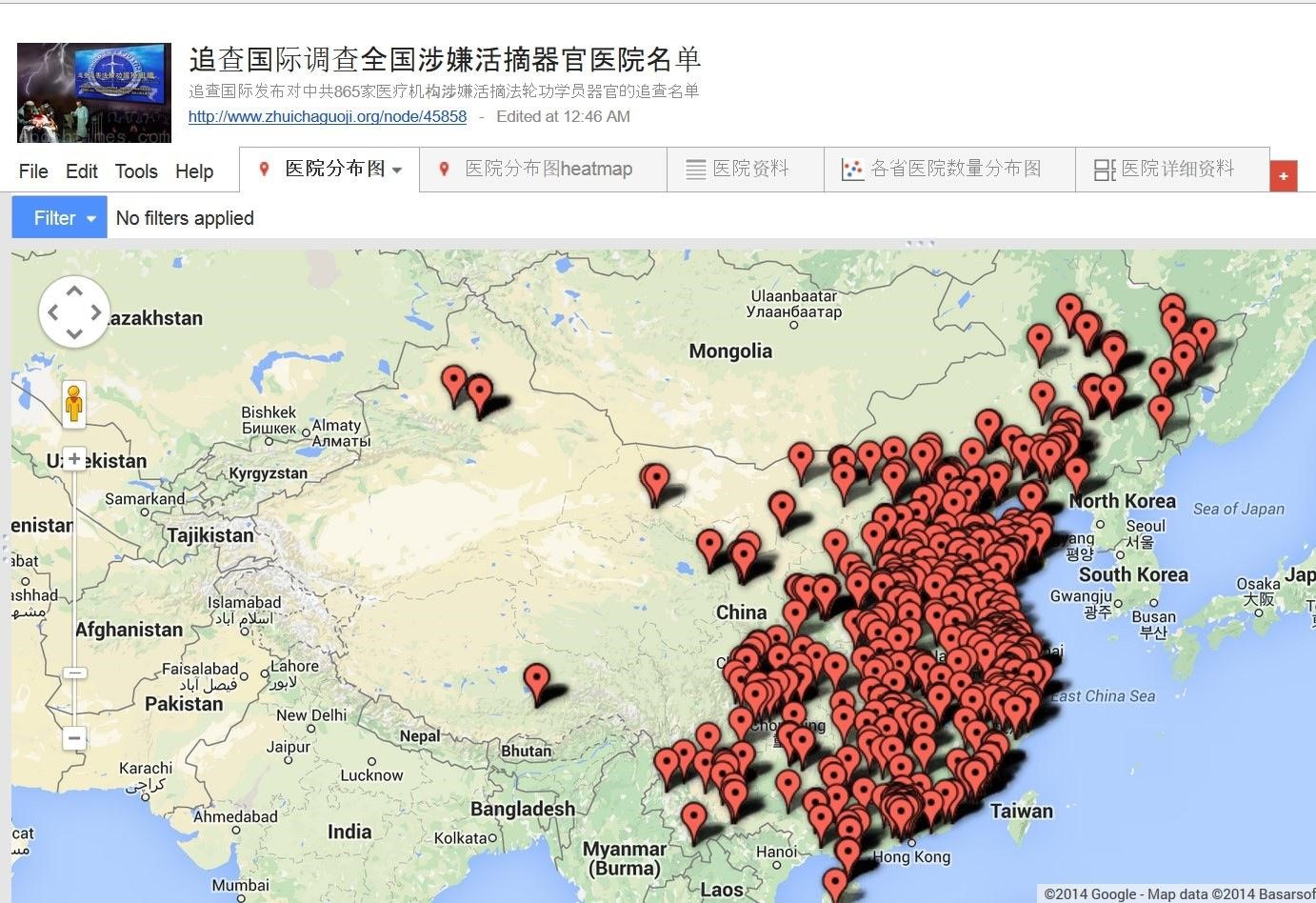
Figure 9.1 Distribution map of hospitals suspected of conducting live organ harvesting in China
According to the July 2015 statistics from China’s Hospital Administration of the National Health and Family Planning Commission,[327] Mainland China had 20,918 hospitals, of which 1,150 were tertiary hospitals and 4,321 were secondary hospitals. Tertiary hospitals were typically large-scale comprehensive hospitals or specialized hospitals found in large cities with more than 500 ward beds. Of the tertiary hospitals, 705 were level A hospitals.[328] All tertiary level a hospitals were conducting organ transplant surgeries.
I. Media reports validate the massive scale of organ transplants performed
1. China Economic Weekly: Peking University People’s Hospital once performed 4,000 liver and kidney transplants in one year
In September 2013, Zhu Jiye, head of Organ Transplantation Research Institute of Peking University and director of the Hepatobiliary Surgery Department at Peking University People’s Hospital, said in an interview with China Economic Weekly, “Prior to launching the pilot project in 2010, organs from executed prisoners accounted for almost all donor organ sources in China. Our hospital used to perform 4,000 liver and kidney transplants in one year, and the sources of these organs were all executed prisoners.”[329] The article was later published on Xinhuanet.

Figure 9.2 Screenshot of the “Xinhuanet” article in September 2013
2. China Times: The PLA No. 175 Hospital in Nanjing Military Region “performs at least 3,000 kidney transplants per year”
According to a China Times’ report dated May 1, 2006, Xiamen Chang Gung Hospital, whose costly construction was funded by two prominent Taiwanese companies, was put to use at the end of year 2006. Organ transplantation was said to be the hospital’s main business development area.
A Taiwanese businessman in Xiamen cited the example of a tertiary hospital located in Zhangzhou, Fujian Province, which is close to Xiamen: No. 175 Hospital of Nanjing Military Region (aka. Xiamen University Affiliated Southeast Hospital). The hospital performed at least 3,000 kidney transplants each year.[330] One out of four kidney transplant patients at the hospital was from Taiwan. Considering that a kidney transplant would cost 1 million to 2 million New Taiwan Dollars (US$31,000-$62,000), Chang Gung Hospital, which focuses primarily on kidney transplants, would have a very lucrative outlook.[331]
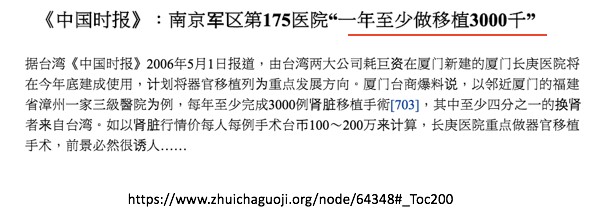
Figure 9.3 Screenshot of the China Times’ report on May 1, 2006
3. Kwong Wah Yit Poh: Wuhan Tongji Hospital performed thousands of kidney transplants per year
An article first published on Kwong Wah Yit Poh, and later reproduced by China’s Sina Global News, stated that as an important city in central China, Wuhan was also China’s largest organ transplant center. The most famous organ transplant hospital there was Tongji Hospital of Huazhong University of Science and Technology in Wuhan (aka. Wuhan Tongji Hospital). Wuhan Tongji Hospital is one of China’s earliest and most authoritative hospitals that performs live donor kidney transplants. Every year, the hospital would perform thousands of kidney transplant surgeries. The hospital’s website claims to have the largest group of living donor kidney transplant recipients (i.e. patients waiting for kidney sources).[332]
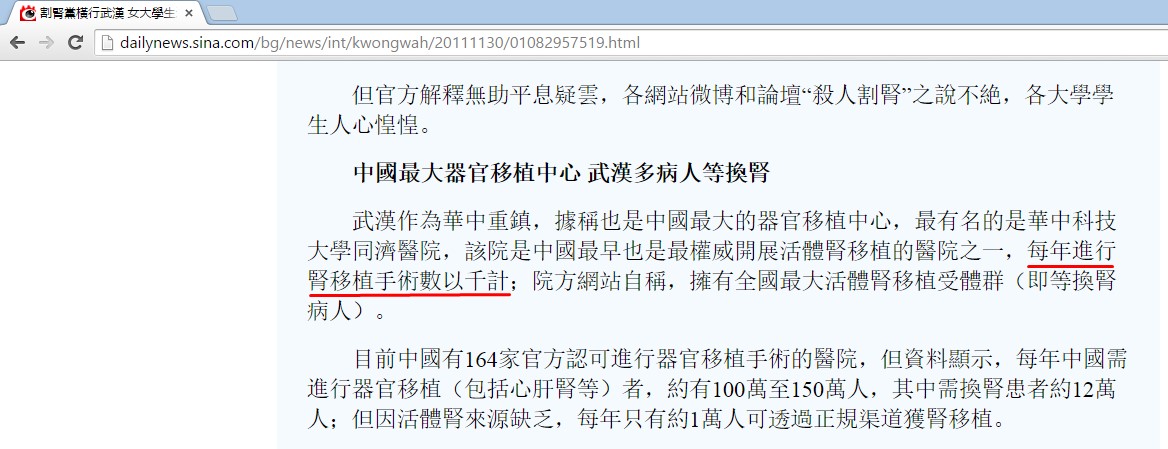
Figure 9.4 Screenshot of the “Sina Global News” article in November 2011
During WOIPFG’s investigation, a surgeon from this hospital said, “It is guaranteed to have sufficient live prisoners like Falun Gong practitioners.” He also told the undercover WOIPFG phone investigator, “Before the people (the donors) die, the organs are taken out.”[333]
A surgeon’s relative, who was working at this hospital, said that there were many donors available, (and before the crime of organ harvesting was exposed in 2006,) the surgeons would work overtime every day to perform organ transplants.[334]
On January 16, 2016, the official website for this hospital still claimed that its kidney transplants numbered nearly 3,000 a year.[335] However, the number of its annual kidney transplants plummeted to 200 cases on its website later, suggesting that the data had been deliberately altered.
II. Authoritative CCP transplant specialists confirmed that the actual number of transplants far exceeded the officially published numbers
Perhaps the numbers above seem too large to be accurate, but if we review the statements of several authoritative organ transplant specialists within the CCP system, we would find the actual organ transplant volume likely to be beyond our imagination.
1. Wu Mengchao: Communist China’s quantity of liver transplants is No. 1 in the world
On May 11, 2011, Sina TV interviewed Wu Mengchao and his student Wang Hongyang. The host, Yin Jun, asked, “Where is China at in terms of liver transplants?” Wu Mengchao replied, “At present, China performs the most liver transplants in the world, and both the quality and results of the transplants are good and have caught up with the international standard.”[336] In the United States, about 6,000 liver transplants are performed per year.[337]
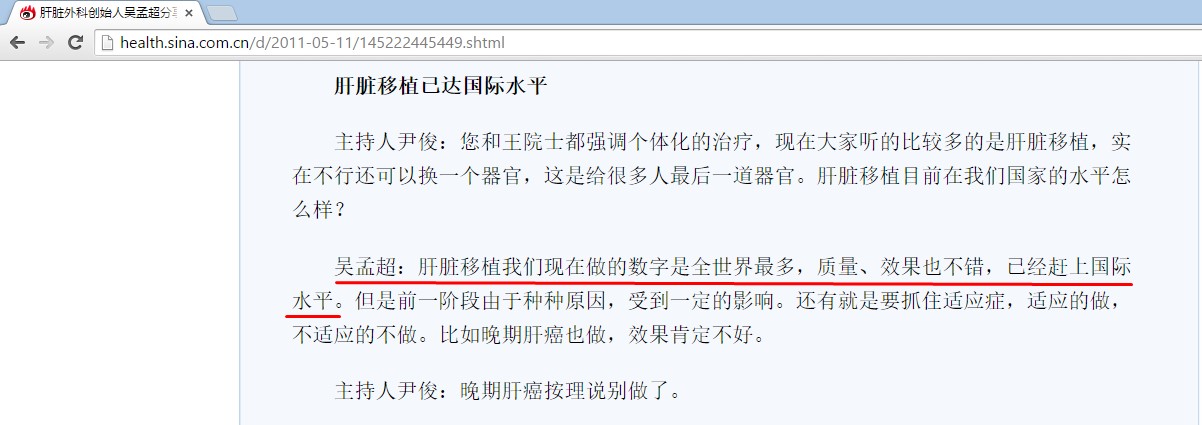
Figure 9.5 Screenshot of a Sina Health webpage from May 2011
2. He Xiaoshun: “The number of liver transplants nationwide in year 2000 was 10 times that of year 1999, and by year 2005 the number had tripled since year 2000”
Phoenix Magazine Network published an article titled “The Inside Story of Human Organ Trafficking in China” on November 5, 2013. The article quoted He Xiaoshun, who was a health specialist for the central government, a committee member of the China Organ Donation Committee,[338] and Vice President of the Organ Transplantation Academy of the First Affiliated Hospital of Sun Yat-sen University.[339]
He Xiaoshun was quoted saying, “The year 2000 is the watershed of China’s organ transplant industry… The number of liver transplants nationwide in 2000 is 10 times that of 1999, and by 2005, the number has tripled since 2000.”[340] This means the number of organ transplants carried out in 2005 in China was 30 times that of the year 1999.

Figure 9.6 Screenshot of the Phoenix Magazine Network’s “Inside Story of Human Organ Trafficking in China”, November 5, 2013
3. Huang Jiefu alone performed more than 500 transplants in 2012, and only one transplant used a donated organ
Huang Jiefu, chairman of the China Organ Donation Committee, deputy director at the ministerial level of the Central Health Protection Committee, and the former vice minister of the Ministry of Health, is responsible for overseeing China’s organ transplant sector. In March 2013, Huang Jiefu told a Guangzhou Daily reporter that as a liver transplant physician, he alone performed more than 500 transplants in 2012, and only one transplant used a donated organ.

Figure 9.7 Screenshot of a news article, where Huang Jiefu stated he had performed more than 500 transplants in one year
III. A surprised witness: a German surgeon said that one Chinese hospital in Tianjin conducted 2,000 transplants per year
A German doctor, Dr. Torsten Trey, said that in 2006, a doctor from Tianjin told him that his own hospital conducted about 2,000 liver transplants per year.[341]
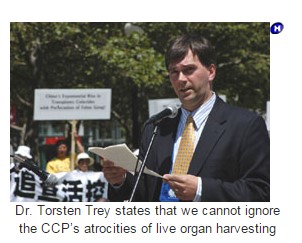
Figure 9.8 Photograph of Dr. Torsten Trey, sourced from the Epoch Times
On July 24, 2006, Dr. Torsten Trey traveled to Boston from Germany to attend the first World Organ Transplant Academic Conference. During that conference, a surgeon from Tianjin told him that the hospital he worked for was one of three in Tianjin that could perform organ transplant surgeries, and his hospital conducted about 2,000 cases of liver transplants in one year. Dr. Trey was puzzled, and thought, “This number is more than the total number of operations in Germany. We have to ask where their liver donors come from.”
IV. The testimony of Yang Guang, a China expert residing in Denmark
1. Data from China’s Public Security Bureau suggested that regional hospitals alone harvested organs from 500,000 Falun Gong practitioners
A witness named Mr. Yang Guang said, “A friend working at the Public Security Bureau told me on the phone that in the last decade or so, organ transplants performed at general hospitals led to the unnatural deaths of more than 500,000 Falun Gong practitioners. This figure was what he knew from only general hospitals’ statistics, such as People’s hospitals and municipality hospitals. The number of organ transplants from armed police hospitals, military hospitals and Public Bureau hospitals were not included. This is because statistics from these three kinds of hospitals are more confidential. Even people, who work for the Ministry of Public Security, are not in the know.”[342]
2. Two affiliated hospitals of a medical university in a large city conducted 2,000-3,000 organ transplants per year
According to an exclusive report published by the Epoch Times on March 16, 2014, Chinese affairs expert Yang Guang spoke about the live organ harvesting at two affiliated hospitals of a medical university in China.[343] One of Mr. Yang’s former classmates was the deputy head at a hospital affiliated with a medical university. To protect the safety of these sources, we will not reveal the name of this hospital or that of the deputy head. He was a medical expert who handled hospital logistics. This man told Mr. Yang in person the dark reality of how organs were transplanted inside this hospital:
“The two hospitals affiliated to our medical university conduct 2,000-3,000 organ transplants every year. Since there is a live organ donor bank, blood type matching can be completed within a month, sometimes even within 48 hours. As soon as our hospital notifies the 610 Office, a prison vehicle would immediately send a candidate with the matching code number to our hospital. After another round of testing to confirm the blood type, this candidate would be sent to different divisions for transplant needs. Often, liver, kidney and corneal transplants are performed simultaneously. After the operations, the body would be sent to the cremation furnace, without collecting the ashes. We only have this donor’s code number, and we only know that he or she was a Falun Gong practitioner. People from the 610 Office are always on site to monitor the entire transplant procedure.”
“The Communist Party Committee at a higher level sets rules for us to keep all the information confidential. We are not allowed to look into the situation or the number of organ transplants in other hospitals, nor are we allowed to tell others about the organ transplant situation in our hospital. At the end of each year, we report to our higher-level Party Committee the number of transplants conducted within that year (2,000-3,000 cases) and the code numbers of the organ donors. Immediately after we send the report, monitored by the 610 Office personnel, we are ordered to delete all the data from our computers.”
V. Estimation of transplant numbers from hospital data
The following are examples that indicate the scale of organ transplants in Chinese hospitals.
1. The true number of liver and kidney transplants at Tianjin First Central Hospital exceeded 5,000 cases per year since 2006, and hit 8,000 at the highest point
Tianjin Municipal Party Committee and the city government invested 170 million yuan (~US$25.5 million) in the construction of the Oriental Organ Transplant Center at Tianjin First Central Hospital. The building’s area is 46,000 square meters, and it was first put into use in August 2006.[344] The Center has 500 beds and 16 floors, making it the largest organ transplant center in Asia. Its Surgery Center is equipped to perform nine liver transplants and eight kidney transplants simultaneously.[345]

Figure 9.9 snapshot of the Baidu Encyclopedia web page about the Oriental Organ Transplant Center
1) Bed count, bed occupancy rate and the average length of stay for liver transplantation patients at Tianjin First Central Hospital’s Oriental Organ Transplant Center
Bed count: Over 500[346]
Bed occupancy rate (BOR): 131.1 percent.[347] In 2013, the average BOR of tertiary level A hospitals was 103 percent.[348]
The average length of stay for a liver transplant patient in China is 25-30 days, and the average length of stay for kidney transplant is 30 days.
Annual Transplantation Quantity at Tianjin First Central Hospital’s Oriental Organ Transplant Center:
5,475 cases (500 × 365 × 90% / 30), using 90 percent as the average BOR, and 30 days as the average length of stay
6,265 cases (500 × 365 ×103% / 30), using 103 percent as the average BOR, and 30 days as the average length of stay
7,975 cases (500 × 365 × 131.1% / 30), using 131.1 percent as the average BOR, and 30 days as the average length of stay
8,544 cases (500 × 365 × 131.1% / 28), using 131.1 percent as the average BOR and 28 days as the average length of stay
2) The hospital’s team of liver and kidney transplant surgeons[349]
through official online publications and medical papers, we found that 110 surgeons at Tianjin First Hospital had conducted liver and kidney transplants, including 21 chief surgeons, 25 deputy chief surgeons, 13 attending surgeons and 51 others.[350] Since 1999, liver and kidney transplants have become routine clinical surgeries at the center.[351] In January 2015, Tonight Media Group reported, “Under the guidance of Shen Zhongyang, new surgeons can now conduct liver transplants independently and have nearly conducted 1,000 liver transplants each.”[352]
3) Surgery Capability
The Organ Transplantation Surgery Center is capable of performing nine liver transplants and eight kidney transplants simultaneously,[353] or 17 surgeries simultaneously.
4) Surgeons have almost no rest days
Based on the above analysis, we believe that as early as year 2006, the number of liver and kidney transplants at this hospital had reached more than 5,000 cases a year, and at its highest point, the number almost reached 8,000 cases.
(Definition: Bed occupancy rate indicates the ratio of beds occupied by patients to total bed count.[354] Sometimes the bed occupancy rate exceeds 100%, due to the presence of extra beds. For example, a hospital can add extra beds in its wards, corridors and conference halls. And it can even rent beds in nearby hotels or other facilities. However, the calculation would still be based on the regular number of ward beds.)
2. The actual transplant quantity at the People’s Liberation Army (PLA) No. 309 Hospital has exceeded 4,000 every year since 2012
The Organ Transplant Center at the PLA No. 309 Hospital was established in April 2002. In October 2005, it was renamed the PLA Organ Transplant Center by the Health Division of the PLA General Logistics Department. In 2011, it was renamed the PLA Organ Transplant Research Institute by the same division. The PLA No. 309 Hospital is also the Data Center for the Management Committee of the Chinese Scientific Registry of Kidney Transplantation (CSRKT).[355]
Bed count: 393 beds in 2012[356]
Bed occupancy rate: 100 percent[357]
The average length of stay: 30 days
Surgeon team:
As many as 42 surgeons,[358] including 13 chief and deputy chief surgeons
Surgery capacity:
The hospital once completed 12 kidney transplants in one night.[359]
Annual transplantation quantity:
4,781 cases (393 × 365 × 100% / 30)
3. Gongyi Hospital of Traditional Chinese Medicine in Henan Province launched a Kidney Transplant Center in 2001
Gongyi is merely a small county-level city. Gongyi Hospital of Traditional Chinese Medicine, which uses Traditional Chinese Medicine (TCM) as the primary means for diagnosis and treatment, set up a Kidney Transplant Center in 2001. The hospital can handle as many as 12 kidney transplant patients simultaneously and is equipped to conduct as many as eight kidney transplants per day. By 2006, the hospital’s director of the Urological Surgery Department, Li Hongdao, had conducted more than 500 kidney transplants.[360]
VI. An investigative phone recording of Politburo Standing Committee Member Zhang Gaoli confirmed the CCP’s Crime of Live Organ Harvesting
On June 24, 2015, a WOIPFG investigator called then Chinese Vice Premier Zhang Gaoli, saying that she was a secretary from Jiang Zemin’s Office, to verify that Jiang Zemin gave the order to harvest organs from millions of living Falun Gong practitioners.[361]
(Recording 42: MP3; Transcript Download: pdf42)
1. Confirmation that Jiang Zemin ordered the harvesting of millions of organs from living Falun Gong practitioners
As one of the incumbent Politburo Standing Committee members and Vice Premier, Zhang Gaoli did not deny nor show surprise when asked by the investigator about “Jiang Zemin’s order to remove organs from several million Falun Gong practitioners.” In addition, when asked by the investigator “to prevent the matter from being pursued at the Politburo meeting,” Zhang promised, “I will” and asked Jiang to “not worry.” This further affirms that Jiang Zemin personally ordered the removal of organs from living Falun Gong practitioners. Furthermore, cadres at the most senior levels of the communist party are all fully aware of this.
2. Zhang Gaoli promised that he would “handle the rest of Falun Gong practitioners well”
This statement from Zhang Gaoli confirmed that the living organ bank composed of a large number of detained Falun Gong practitioners was still in existence in 2015, and that Falun Gong practitioners were in danger of having their organs removed at any time.
The following is the telephone recording:
Officer Li Guang: Hello?
Investigator: Is that Officer Li Guang?
Officer Li Guang: Hello!
Investigator: Hello, is Comrade Zhang Gaoli nearby? This is Secretary Liu of Comrade Jiang Zemin’s Office.
Officer Li Guang: Hello, Secretary Liu.
Officer Li Guang: Vice Premier Zhang is not here yet.
Investigator: When will he be there?
Officer Li Guang: He needs at least another 40 minutes.
Investigator: All right, I will call back in one hour, 50 minutes, is that ok?
Officer Li Guang: Yes.
Officer Li Guang: Hello.
Investigator: Is that Officer Li Guang? This is Secretary Liu.
Officer Li Guang: Hello!
Investigator: Is Comrade Zhang Gaoli back?
Officer Li Guang: Please wait a moment. I will hand over the cellphone immediately.
Investigator: OK, thank you.
Officer Li Guang: OK.
Zhang Gaoli: Hi, this is Zhang Gaoli.
Investigator: This is Secretary Liu from Comrade Jiang Zemin’s office.
Zhang Gaoli: Hello, Secretary Liu.
Investigator: Hello! Comrade Jiang Zemin wants me to tell you a few words. He said that recently over 10,000 Falun Gong practitioners sued him at the Supreme Procuratorate. They accused Comrade Jiang Zemin of ordering the removal of organs from millions of Falun Gong practitioners, and they want Jiang to be accountable for this matter. So Jiang Zemin is very worried about this. He hopes...
Zhang Gaoli: Ah.
Investigator: He hopes at the Politburo meeting, you would prevent them from pursuing this matter.
Zhang Gaoli: OK.
Investigator: Can you do that?
Zhang Gaoli: Yes, yes, yes.
Investigator: You know, the responsibility of live organ harvesting from several million Falun Gong practitioners is enormous. You know that, right? You understand.
Zhang Gaoli: I am now in Kazakhstan.
Investigator: Right.
Zhang Gaoli: I just got off the plane.
Investigator: Yes, I am saying when you go back, when you go back, you need to take care of this matter...
Zhang Gaoli: Tell Chairman Jiang to rest assured.
Investigator: There is another matter…
Zhang Gaoli: I... I...
Investigator: …that I would like to ask you about.
Zhang Gaoli: I definitely will.
Investigator: You must stop this matter, you know.
Zhang Gaoli: Yes, I will.
Investigator: Comrade Jiang Zemin ordered the removal of organs from millions of Falun Gong practitioners, the responsibility of this matter is very serious.
Zhang Gaoli: Ah, um, ah, I wish Chairman Jiang good health and longevity. I wish Chairman Jiang good health and longevity.
Investigator: When you go back, you must take care of this matter immediately. Also, the rest of the Falun Gong practitioners should be handled well, too. No mistakes allowed.
Zhang Gaoli: Yes, yes, yes.
Investigator: All right.
Zhang Gaoli: OK, OK, OK.
Investigator: Bye.
(For more details, please read the report at http://www.upholdjustice.org/node/297)
VII. Examination of China’s organ transplant volume
For reasons well known to the public now, a definitive conclusion or entirely accurate figures of the number of organs harvested by the CCP are impossible to obtain. Yet ample evidence exists to suggest that the volume is frighteningly large.
Live organ harvesting is a state crime ordered by a party leader. With the CCP’s decades of murderous experience as the foundation, and the input from the entire state apparatus, and supported by the concentration camp-style living donor pool throughout the country, a live organ harvesting massacre has been taking place in China, and the organ transplant volume has experienced an explosive growth! The actual number is so massive that it exceeds the imagination of people.
1. 96 organ-harvesting centers conduct an average of several hundred to 1,000 transplants every year
These 96 organ harvesting centers are all tertiary level-A hospitals equipped with the most advanced medical equipment and staffed with the best physicians in China. These hospitals are usually directly governed by various arms of the military, prominent hospitals located in major cities or affiliated with key Chinese universities or institutions. Some of these hospitals’ transplant data have been published in the Communist Party’s official media and in overseas media that are controlled by the Communist Party. [362]
2. 50 regional liver and kidney transplantation centers are suspected of conducting 100 transplants per year
These hospitals belong to the secondary hospitals accredited by the Ministry of Health to conduct organ transplant operations. They are mostly provincial hospitals or affiliated hospitals of universities located in prefecture-level or provincial-level municipalities. These hospitals also have advanced transplant expertise with large organ transplant volumes. [363]
3. 408 military, armed police or tertiary level-A hospitals not accredited by the Ministry of Health to conduct transplant operations, have conducted exceedingly large numbers of transplant operations
There are 408 organ transplantation centers in large-scale military and local hospitals, mainly tertiary level-A hospitals, not accredited to conduct organ transplant operations, including 56 military and armed police hospitals, and 352 local tertiary level-A hospitals. [364]
Experts estimate that before the organ harvesting from living donors was exposed in 2006, the number of organ transplants conducted by countless small and medium transplantation institutions, which account for 80 percent of all medical institutions that perform transplants in China, was no less than that from the large institutions, which account for 20 percent of the total, with some small-scale hospitals having exceedingly large transplant volumes.
Even after the Chinese Ministry of Health implemented an accreditation system, many hospitals that failed to receive accreditation continued with such operations. Compared to the large hospitals, these small and medium institutions are more flexible in their operations. Several dozen military and armed police hospitals are not restricted in any fashion, because they possess abundant donor sources, and the total number of transplants from these facilities should not be underestimated.
4. 153 small and medium transplant centers not accredited to conduct transplants may have conducted organ transplants
The 153 transplant centers within this category include mostly secondary hospitals, tertiary level-B hospitals, a small number of small-scale privately owned hospitals and district hospitals. These hospitals mostly perform kidney transplants, which require relatively less medical expertise. [365]
Prior to the 2007 release of the list of approved and designated organ transplant centers by China’s Ministry of Health, there had been regional accreditation programs for organ transplants across the country. The qualifying standard within the transplant sector was usually that a hospital needed to conduct a minimum of 50 transplants per year. For example, Guangdong’s Provincial Health Department issued a minimal qualification standard for an organ transplant hospital in 2003,[366] where a kidney transplant hospital was required to perform at least 50 cases per year. From September to December 2003, 47 hospitals of different sizes in Guangdong received the liver and kidney transplantation qualification, including 30 hospitals that performed kidney transplants.
In summary, a large number of Falun Gong practitioners have been killed for live organ harvesting.
Of course, obtaining actual information from a tyrannical regime is exceedingly difficult. Looking back in history, it took a long time for the international community to come to terms with the existence of the Holocaust. The extent of the crimes committed was not made known to the world until the Allied forces liberated the Auschwitz Concentration Camp. Postwar investigations showed that more than 6 million Jews were slaughtered. And the world paid a heavy price for World War II.
Today, the CCP’s actions are extremely similar to those committed by the Nazis, only that the extent of the CCP’s evilness is much greater. Mankind cannot continue to overlook these crimes, or world civilization will cease to exist.
Chapter 10: Other Means through which Falun Gong Practitioners have been subjected to Genocide
Throughout the course of the persecution of Falun Gong, aside from state-sanctioned live organ harvesting, the CCP has conducted extensive psychological tests on the dying process, drug tests, other human subject tests and even autopsy lectures using Falun Gong practitioners. The CCP has even gone as far as making the bodies of Falun Gong practitioners, including the remains of practitioners who were tortured to death, into scientific specimens using the method of “plastination.” These plastinated bodies and body parts have been displayed in major cities around the world in profit-driven body exhibitions. The figures referenced in this chapter provide evidence from a different perspective demonstrating that the total number of slaughtered Falun Dafa practitioners is in fact greater than previously thought.
I. Wang Lijun and his human subject tests
WOIPFG has discovered that the CCP is suspected of conducting human subject tests using a great many Falun Gong practitioners. One of the key figures implicated is Wang Lijun, former deputy mayor of Chongqing and former chief of the Public Security Bureau of Chongqing Municipality.
On February 6, 2012, Wang Lijun abruptly visited the U.S. Consulate in Chengdu requesting political asylum, but Wang’s request was denied. News about this incident made Wang Lijun well known worldwide.[367]
1. Jinzhou City Public Security Bureau On-Site Psychological Research Center[368]
In May 2003, Wang Lijun was reassigned to Jinzhou City, Liaoning Province, and took on the positions of chief of the Public Security Bureau and Municipal Communist Party Committee Secretary. At the time, Bo Xilai held the titles of vice secretary of the Liaoning Provincial Communist Party Committee and Governor of the province. Wang worked under both the Ministry of Public Security and the Provincial Communist Party Committee. Shortly after Wang took office, he established the “On-Site Psychological Research Center,” a facility operating under the Jinzhou Public Security Bureau. Wang had no medical background, an education level of only middle school, and was formerly transferred from positions in the military, yet he became the director, professor, researcher and a forensic expert at this research center. One China’s CCTV news report from 2004 stated that this was “the only onsite psychological research center under the Chinese police system”, and it was managed by the most senior police administrators of the CCP.[369]
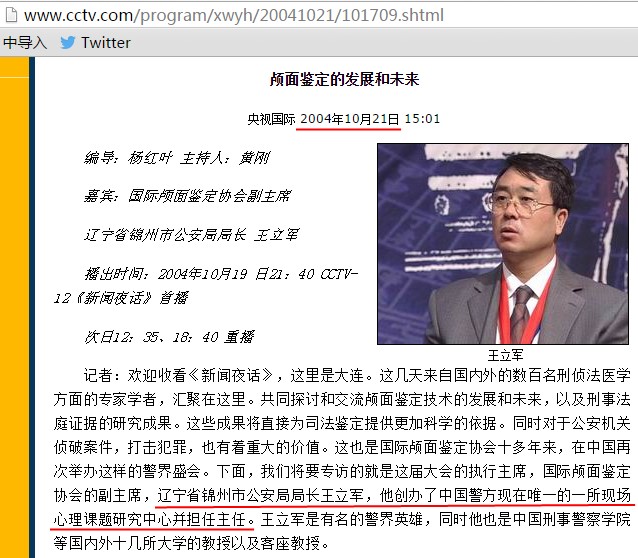
Figure 10.1 Snapshot of the article published on CCTV’s International Channel about Wang Lijun
In 2008, Wang Lijun was reassigned to Chongqing as chief of the Public Security Bureau, and the research center in Jinzhou disappeared along with Wang’s reassignment. Meanwhile, in cooperation with Southwest University, Wang established the “Southwest University and Chongqing Public Security Bureau Onsite Psychological Research Center.” Wang assumed the title of director of the center. After his arrest in 2012, this research center in Chongqing disintegrated. Apparently, these “research centers” were directly linked to Wang Lijun himself, instead of being associated with any province or city.
According to WOIPFG’s investigation, the On-Site Psychological Research Center (OSPRC) performed “research” on human subjects awaiting execution, with the aim of studying the dying process. Such “research” included “a person’s psychological changes when facing death,” “changes in vital signs”[370] and the toxic residuals in different organs after lethal injection. These victims might have been killed by lethal injection and/or the direct excision of human organs.
On September 17, 2006, Wang Lijun and his OSPRC’s “Research on Organ Transplantation from Donors Who Have Been Subjected to Drug Injection”[371] were awarded the “Guanghua Innovation Special Contribution Award” by the China Guanghua Science and Technology Foundation,[372] along with a research grant of 2 million yuan (US$300,000).[373] Both the secretary of the Guanghua Foundation, Ren Jinyang, and Wang Lijun spoke at the award ceremony. Their speeches revealed that the research center had used several thousand living candidates to conduct executions and organ transplants. The subject of their research included a new fluid formula for organ preservation used on organs taken from bodies executed through lethal injection.
At the award ceremony for the Guanghua Innovation Special Contribution Award, Ren Jinyang said in his speech, “Professor Wang Lijun and the Research Center conducted basic research and clinical trials to study how to resolve the challenging issue, which is that the organ transplant recipients are generally not very receptive to organs injected with drugs. They have created a brand new preservation solution, which is used to provide a perfusion treatment for livers and kidneys previously subjected to drugs. After animal tests, in vitro experiments and clinical trials, they have achieved an important milestone where the recipient’s body is able to accept the liver and kidney after such a treatment.”[374]
When talking about his research “achievements,” Wang Lijun emphasized, “Our research site and our scientific and technological achievements are the crystallization of several thousand intensive onsite cases; they are the results of the painstaking efforts by so many of us … Jin Yang, the secretary-general of China Guanghua Science and Technology Foundation, and his staff were right there at our site, the very scene of our anatomization and the very spot of transplanting organs into the recipients. As a police officer with years in the service, when I see that the life of an executed prisoner is extended in the bodies of several people in mere minutes, I still feel blown away.”[375]
According to Amnesty International, from 2000 to 2005, the average annual number of executions of death row prisoners in mainland China was 1,616.[376] By December 31, 2004, China had 333 prefecture-level cities. From where would such a small city like Jinzhou find several thousand human test subjects for onsite drug injections?
Jinzhou On-Site Psychological Research Center stated in its overview that Beijing University, China Medical University, and the PLA No. 205 Hospital all participated in its “Organ Transplantation from Donors Who Have Been Subjected to Drug Injection” research.[377] In May 2012, using the name of “Special Investigation Team on Wang Lijun”, WOIPFG conducted a telephone investigation on Chen Rongshan, chief of the Urological Surgery Department of the PLA No. 205 Hospital. Chen Rongshan confirmed that the donor organs came from detained Falun Gong practitioners.[378]
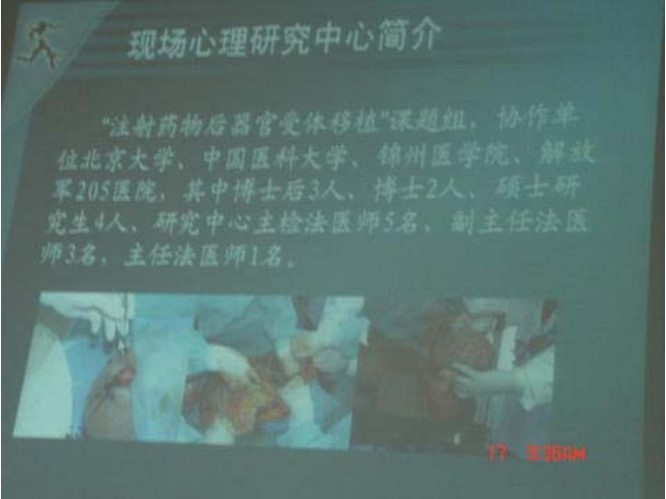
Figure 10.2 the overview of Jinzhou on Site Psychological Research Center indicated that Beijing University, China Medical University and the PLA No. 205 Hospital participated in “Organ Transplantation from Donors Who Have Been Subjected to Drug Injection”
2. An invention that causes artificial brain deaths, the “collision machine that causes primary brain-stem injuries”
Since assuming the title of chief of the Chongqing Public Security Bureau, Wang Lijun conducted other human subject tests besides establishing the Southwest University and Chongqing Public Security Bureau Onsite Psychological Research Center. Notably, Wang held a patent for a “collision machine to cause primary brain-stem injuries,” which he developed to cause brain deaths. The patent inventors are listed as Wang Lijun, Yin Zhiyong, Zhao Hui and Wang Zhengguo. They applied for a patent in December of 2011 and got the approval the following year.
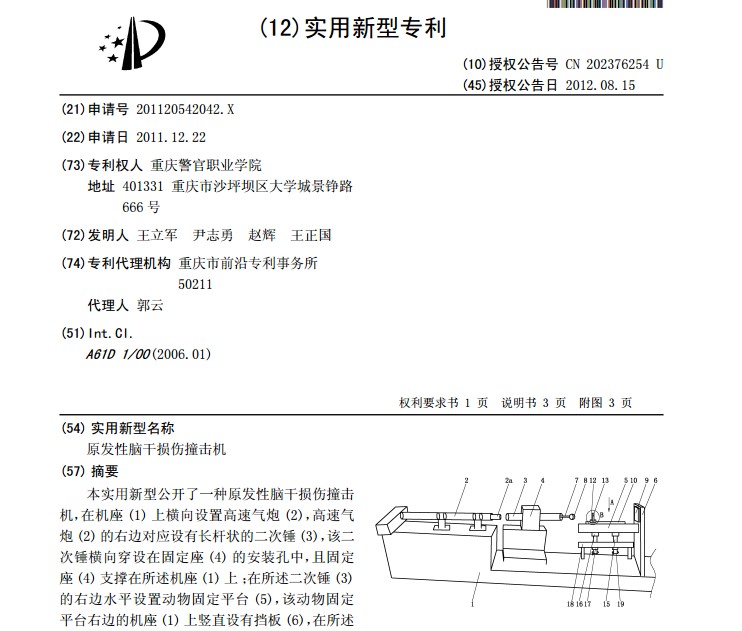
Figure 10.3 Part of the instruction manual on Wang Lijun’s patented invention: “collision machine to cause primary brain-stem injuries”[379]
Co-inventors Yin Zhiyong, Zhao Hui and Wang Zhengguo of Daping Hospital of the No.3 Military Medical University jointly published an article in the Journal of Traumatic Surgery, in the second issue of 2008, titled “Quasi-static and Temporal Brain Injuries Caused by Collisions, Simulation Analysis and Its Clinical Significance.”[380] The article confirmed that this particular patented invention was designed to research brain deaths in humans, and stated, “as of October 2007, 12 ‘fresh heads’ of just-dead corpses had been used for collision experiments. All the (head) donors were male, aged between 26 and 38, with an average age of 31.”
The invention of this machine involved a process of using the prototype machine to crack human skulls and cause brain stem injuries. It was a process of slaughtering humans, because using the “heads of just-dead corpses” for the collision experiments would not serve the purpose of studying the extent of brain stem injury in humans. Just like the “organ donors” noted throughout this paper, the collision experiments must have also used living candidates.
3. Other human subject testing projects
According to the website of the China Guanghua Science and Technology Foundation (CGSTF): “As the leader of Jinzhou On-Site Psychology Research Center (OSPRC) research team, Wang Lijun authored several academic papers, including ‘On Injury-Free Dissection,’ ‘A Study on Organ Transplant from Donors Who Have Been Subjected to Drug Injection’ and ‘A Study on the Time Dependence of Intestinal and Gastric Excrement of Females from Northern China.’[381]
As a police chief, for what purpose was he conducting research on the “Intestinal and Gastric Excrement of Females from Northern China?” And who were the subjects of his research?
4. Human subject research
Who are the sources of research for these human experiments? WOIPFG’s investigation provided an answer to this question. On May 22, 2006, a WOIPFG investigator conducted telephone investigations on relevant government agencies under Wang Lijun’s jurisdiction. A court officer from the Intermediate People’s Court of Jinzhou City [the criminal court] told the investigator that they were still able to provide kidneys extracted from Falun Gong practitioners.[382]
In 2009, WOIPFG published testimony from an armed guard who had witnessed live organ harvesting from a Falun Gong practitioner. The witness had worked under Wang Lijun as a policeman at that time. He said that Wang had issued a strict order to the police that with regard to Falun Gong practitioners, “we must arrest them all and kill them all.”[383]
5. Phone Investigations
1) Chen Rongshan, retired Director of Urological Surgery Department of the PLA No. 205 Hospital
Investigation Date: May 25, 2012 (Phone # 86-13841666988)
(Recording 43: MP3; Transcript Download: pdf43)
The following is an excerpt from the recorded conversation between a WOIPFG investigator, disguised as “a member of the Wang Lijun inter-departmental investigation team,” and Chen Rongshan, retired director of the Urological Surgery Department of the PLA No. 205 Hospital of Jinzhou City. Chen Rongshan admitted that the organ transplant donors were detained Falun Gong practitioners, and that the court had approved this. [384]
Chen: “Hello?”
Investigator: “Hello, is that Chen Rongshan, former director of the Urological Surgery Department of the PLA No. 205 Hospital?”
Chen: “Yes, yes, yes, who is that?”
Investigator: “I’m from the Wang Lijun inter-departmental investigation team.”
Chen: “Ah, ah, ah.”
Investigator: “When Wang Lijun was at the Jinzhou Public Security Bureau, he was in charge of the On-Site Psychological Research Center. The center had some joint projects with the PLA No. 205 Hospital. Can you tell me more about the projects?”
Chen: “Oh.”
Investigator: “He had a project called ‘Research on Organ Transplantation from Donors who have been subjected to Drug Injection.’ The PLA No. 205 Hospital was their partner. Please tell me more about this project.”
Chen: “Ah.”
Investigator: “What I am asking is whether you have cooperated together?”
Chen: “China Medical University also partnered with them.”
Investigator: “Wang Lijun told us that some organ donors were jailed Falun Gong practitioners. Is that true?”
Chen: “Those were arranged by the court.”
Investigator: “By the court, right?”
Chen: “Yes, yes.”
Investigator: “That is to say that the organs were provided by prisons and labor camps?”
Chen: “Let me say something, don’t talk about this matter with me, okay?”
Investigator: “Because we are now…”
Chen: “If you want to talk to me, contact the Political Department of the PLA No. 205 Hospital first. Okay?”
Investigator: “Well, we’ve already discussed this with them before talking to you.”
Chen: “No, no, you, the Political Department hasn’t called me. I cannot, cannot, okay?”
Investigator: “They…well, the telephone number is the same.”
Chen: “They must call me first, okay?”
Investigator: “We’ve already talked to them.”
Chen: “Ask someone from the Political Department to call me.”
Investigator: “We’ve already contacted with Director Lin from the Political Department.”
Chen: “That won’t work. We have disciplines in the military. If you want to discuss certain matters, you must first talk to the Political Department, then someone from the Political Department must call me. Alright?”
Investigator: “He told me to contact you directly, so…”
2) Chen Rongshan, retired Director of Urological Surgery Department of the PLA No. 205 Hospital
Investigation Date: June 13, 2012 (Phone # 86-13841666988)
(Recording 44: MP3; please refer to Appendix 44 for transcript translation)
Following are excerpts from the conversation between a WOIPFG investigator posing as the secretary of Deputy Minister Wang Jia of the Joint Health Services in Shenyang Military Region (former president of the PLA No. 205 Hospital) and Chen Rongshan, retired director of Urological Surgery Department at the PLA No. 205 Hospital. Chen promised to keep secret the live organ harvesting from Falun Gong practitioners for organ transplantation.
Chen: Hello?
Investigator: Hello, is that Chen Rongshan, former director of Urological Surgery Department at the PLA No. 205 Hospital?
Chen: Where are you calling from?
Investigator:I am the secretary of Wang Jia, the deputy Minister of the Joint Health Services. Your former president wanted me to tell you something.
Chen: Oh, go ahead.
Investigator: No matter what level of investigation agencies contact you about the harvesting of Falun Gong practitioners’ organs for organ transplants, do not say a word. Do not leak any secrets. Can you do that?
Chen: Ah, yes, sure, sure.
Investigator: The nurses at your Urological Surgery Department at that time, did they know the donors were Falun Gong practitioners?
Chen: Who are you?
Investigator: Our former hospital president….
Chen: No, you, secretary, what’s your last name?
Investigator: My last name is Zhang, my name is Zhang Tao.
Chen: Your name is Zhang Tao?
Investigator: Our former hospital president specifically asked me to remind you.
Chen: I know, I understand, hum.
Investigator: Ok. If possible, please inform the other former staff of your department as well.
Chen: I’ll mention it. Tell them not to talk about it casually. Ah.
Investigator: Right, right, right.
Chen: I got it. Thanks.
Investigator: Good. That’s it for now.
Chen: Ok, bye. Goodbye.
II. The secrets behind the world’s largest exporter of plastinated human body specimens
WOIPFG’s investigation indicates:
1. China has become the largest exporter of plastinated human body specimens[385]
The world’s two largest organizations engaged in human body plasticization are the German-owned enterprise von Hagens Plastination (Dalian) Co., Ltd., which used to be located in Dalian High-tech Industrial Park, and Sui Hongjin’s Dalian Hoffen Bio-Technique Co., Ltd., and their revenues accounted for 90% of the total industry share in China in year 2012.[386]
Oriental Outlook Weekly reported on November 24, 2003, that von Hagens Plastination Co., Ltd, a German-owned enterprise, over the course of four years, had sold many human specimens made from Chinese corpses to the rest of the world, reaping hundreds of millions of dollars in profit.[387]
From 2004 to the end of 2012, multiple human body exhibitions run by Sui Hongjin appeared in more than 60 cities in over 20 countries.
2. Several dozen plastination factories in China were established after the persecution of Falun Gong began, and they received support from CCP officials at various levels
China’s several dozen human body plastination factories were only established after the persecution of Falun Gong started taking place in 1999. Von Hagens Plastination Co., Ltd and Sui Hongjin’s Dalian Hoffen were the earliest factories.
1) Bo Xilai, then Mayor of Dalian City, approved and commended the establishment of von Hagens’s plastination company
In August 1999, one month after the CCP launched the persecution against Falun Gong, the Dalian municipal government approved von Hagens’s application to invest $15 million in building a solely foreign-owned enterprise, von Hagens Plastination Co., Ltd.[388] in Dalian’s Hi-tech Industrial Park.[389] In September 1999, at the Xinghai Friendship Award ceremony, Bo Xilai, the then mayor of Dalian City, presented an award certificate and medal to von Hagens.
2) Sui Hongjin established a separate factory and received support from CCP officials at various levels
In year 2000, the Ministry of Health and the Chinese Association of Science and Technology approved Sui Hongjin’s application to hold China’s first plastinated human body exhibition and the “Human Body World Exhibit,” was scheduled to launch in 2004.[390] On June 21, 2002, with fervent support from Dalian Medical University, Sui Hongjin established his own business.[391] Sui registered a university-owned enterprise, Dalian Medical University Plastination Co. Ltd.[392]
In January 2004, Sui Hongjin expanded his operations and established Dalian Hoffen Bio-Technique Co., Ltd., where he served as chairman of the board.[393]
According to Window of the Northeast, a magazine affiliated with the Dalian Municipal Communist Party Committee,[394] “Sui Hongjin was very encouraged by the enthusiastic support for the ‘Human Body World Exhibit’ from officials of various levels. Wu Jieping, then Vice Chairman of the Standing Committee of the National People’s Congress and member of both the Chinese Academy of Sciences and the Chinese Academy of Engineering, wrote the name of the exhibition in Chinese calligraphy. Xue Shepu, member of the Chinese Academy of Sciences and then chairman of the Chinese Society for Anatomical Sciences, wrote the introduction for the literature that accompanied the exhibition. During the exhibition, Wu Yi, then vice premier of the State Council, asked officials from the Ministry of Health to attend the exhibition to provide guidance and conduct field research.[395]
3) The CCP Central Propaganda Department and the Ministry of Health took steps to mitigate “social controversy” surrounding Sui Hongjin’s body exhibition
On January 1, 2004, the “Plastinated Human Body” exhibition provided by the Dalian Medical University[396] quietly opened at the Museum of Natural History in Beijing. It was not well received by the public and was commonly called the “corpse exhibition.” Even the media, controlled by the Central Propaganda Department and only allowed to “speak with one voice”, expressed different opinions about the exhibition.[397] However, four months later, on April 8, 2004, amidst wide spread controversy, Sui’s “Human Body World Exhibit”, which was sponsored by the Chinese Society for Anatomical Sciences, officially opened. Compared to its previous low-profile appearance at the Museum of Natural History, there was much pomp this time. The “Human Body World Exhibit” toured the country for four months with Beijing as the first stop.[398]
A reason behind the fanfare was that Dalian Hoffen Bio-technique Co., Ltd. was able to silence the controversy it had encountered after passing an onsite inspection by the Ministry of Health and the CCP Central Propaganda Department.[399]
On June 11, 2004, Dalian Hoffen’s “Human Body World Exhibit” began its tour in South Korea. On August 8, 2005, the “Human Body World Exhibit” arrived in the United States.[400]
3. The mystery surrounding the source of the bodies: the Chinese Police
1) The human body plastination process requires “fresh cadavers” in their entirety that have not undergone any processes of preservation
From all the lab reports, papers and notices that have been released to the public, it is clear that they all emphasized the use of “fresh” bodies for the “plastination” process. Because plastination requires fresh cadavers in their entirety that have not undergone any preservation.
For example, on December 29, 2001, Hagens received an encrypted email from Sui Hongjin, who was serving as the general manager of Hagen’s plastination factory in Dalian at that time. The email read, “This morning, two fresh, top quality corpses arrived at the factory. Their livers were removed only a few hours ago in hospital.”[401]
2) According to Gunter von Hagens, you can’t get any donated bodies in China
On October 21, 2003, Hagens received an email from a subordinate, “So far, we haven’t received any donated bodies in China.”[402] On August 17, 2012, Gunter Von Hagens’ son told Deutsche Welle that until then they had received only one donated cadaver from China’s donation network.[403]
3) Most “fresh cadavers” were obtained through the Public Security Bureau, the Procuratorate and the legal system
In 2004, the German news magazine Der Spiegel obtained some evidence[404] through onsite inspection, confirming that in the “fetus and infant database” maintained by the von Hagens Plastination factory in Dalian, there was a detailed record of a nine-month-old fetus. The “origin” of the fetus was clearly written as “Public Security Bureau.” But how could a nine-month-old fetus end up with the Public Security Bureau?
A 2008 settlement with the attorney general of New York obliged Premier Exhibitions Inc., Sui Hongjin’s exhibition partner, to publish a disclaimer on its website and at the exhibition hall.[405] The disclaimer reads, “This exhibit displays human remains of Chinese citizens or residents which were originally received by the Chinese Bureau of Police,” and “Premier Exhibitions Inc. cannot independently verify that the human remains you are viewing are not those of persons who were incarcerated in Chinese prisons.”

Figure 10.4 Premier Exhibitions, Inc. publishes a disclaimer on its website
4) Sui Hongjin stated that none of the corpses was from donation or executed prisoners
The Southern Metropolis Daily conducted face-to-face, telephone and email interviews on August 17, 20 and 21, 2012 respectively with Sui Hongjin. During the interviews, he said, “In fact, none of the cadavers was from executed prisoners. Since the first day of Dalian Hoffen, we have never used any such corpses!” Sui Hongjin also said, “So far, none of the bodies we use for plastination is from donation.”[406]
5) Sui Hongjin said some of the corpses came from Dalian Public Security Bureau
In 2012, a WOIPFG investigator conducted a recorded phone investigation with Sui Hongjin, who said that some “corpses” were from the Dalian Public Security Bureau.
(Recording 45: MP3; Transcript Download: pdf45)
Automated answering machine: “Hello, welcome to Dalian Hoffen Bio-technique Co., Ltd., please dial the extension number directly, please dial zero to look up (extension) numbers.”
Sui: Hello?
Investigator: Hello, I am looking for Professor Sui Hongjin.
Sui: Who’s calling?
Investigator: Ah, this is xxx, is that Professor Sui?
Sui: Yes, speaking.
Investigator: This is the case, Bo Xilai set up von Hagens Plastination Co., Ltd. during his Dalian administration. You were his general manager, right?
Sui: Yes, right.
Investigator: Then, what is the main source of the corpses your company used?
Sui: Dozens of them were collected from the Public Security Bureau, that is, the Public Security Bureau provided them.
Investigator: Collected from the Public Security Bureau… then how many bodies have you received so far?
Sui: I can’t remember it now, a few dozens.
Investigator: Oh,
Sui: If you come to investigate in person, I will tell you about this situation, it is not convenient to say it over the phone.
Investigator: Which Public Security Bureau supplied you?
Sui: Uh, it’s Dalian City, Dalian Municipal Public Security Bureau.
Investigator: The source of these corpses you use is from the Public Security Bureau. Do you know where they got them from?
Sui: They. . . should be. . How do you say this, this is in 2004, there was a report inside them, that is. . .
Investigator: Oh.
Sui: Report to the Ministry of Public Security, ah.
Investigator: Oh.
Sui: Because there are some things about them, I only know the results. It is not convenient for me to ask the details. You can do this, um. . It is because of this matter that I also think it’s very sensitive, and I am willing to cooperate with you to investigate.
Investigator: Oh, OK.
Sui: Well, if necessary, I can talk to you in person, and then if you need me to sign anything or be responsible (for my words). No problem, I will be responsible for my words.
Investigator: What department is supervising you? Is it Dalian Medical University?
Sui: Yeah, but regarding Hagens’s situation, I think I am still more familiar with it than the university.
Investigator: OK, thank you for your cooperation with us, thank you very much.
Sui: Ok. you’re welcome.
Investigator: Ok, that’s it for today, bye.
Sui: Bye.
As early as 2004, the Health Vocational Education magazine, which was jointly managed by the Department of Science and Education of the Ministry of Health and the Health Department of Gansu Province, published a paper entitled “Collection of Human Body Specimens”.[407] It was mentioned in the paper that the main channel for collecting “corpses” was “through the Public Security Bureau, the Procuratorate and the Court” and stressed that it is necessary to “seek support from these departments”.[408] At that time, the main officials in charge of those departments of Liaoning Province and Dalian City were Li Feng,[409] secretary of the Political and Legal Affairs Commission and director of the Public Security Department of Liaoning Province (2001-2011), and two directors of the Public Security Bureaus of Dalian, Sun Guangtian[410] (April 25, 2000 - March 2003) and Zhang Jixian[411] (September 2004 - December 2009).
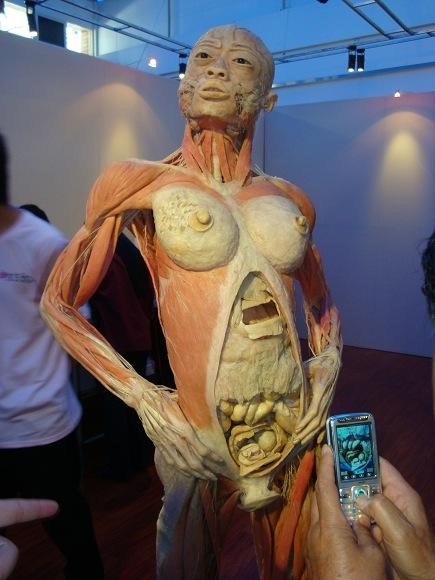
Figure 10.5. Sui Hongjin’s “mother and child” specimen
Among Sui’s plastinated specimens, one is a standing female specimen with her abdominal cavity exposed, showing a three-month old fetus. According to Chinese law, pregnant women cannot be given the death penalty. Even if this woman died in a car accident, her family would never allow their love ones’ bodies to be made into human specimens. However, according to Sui Hongjin, all specimens could only have come from the police bureau. So what really happened?
4. Investigation shows that some cadavers were from Falun Gong practitioners
WOIPFG’s telephone investigation uncovered that some human specimens came from Falun Gong practitioners.
1) Investigation conducted on the deputy mayor of Dalian, Sun Guangtian
On September 18, 2012, a WOIPFG investigator, disguised as the secretary of Xia Deren, the deputy secretary of Liaoning’s Provincial Communist Party Committee, conducted an investigation on Sun Guangtian, the incumbent deputy mayor of Dalian, who served as chief of Dalian Public Security Bureau from 2000 to 2003. The investigation focused on collecting evidence about the involvement of Bo Xilai and his wife Gu Kailai in selling the corpses of Falun Gong practitioners.
(Recording 46: MP3; Transcript Download: pdf46)
Sun Guangtian: Hello?
Investigator: Hello, is that Sun Guangtian, deputy mayor of Dalian?
Sun Guangtian: Yes, speaking.
Investigator: This is the secretary of Xia Deren, deputy secretary of the Liaoning Provincial Communist Party Committee. Secretary Xia asked me to pass on a message to you.
Sun Guangtian: Go on.
Investigator: Many things have happened now, and no matter what, you cannot disclose that Bo Xilai’s wife Gu Kailai was involved in selling the corpses of Falun Gong practitioners, if someone comes to investigate.
Sun Guangtian: What is your surname?
Investigator: My surname is Wang.
Sun Guangtian: Is Secretary Xia’s secretary surnamed Wang?
Investigator: Yes, yes, yes, I was just transferred here a while ago.
Sun Guangtian: Oh.
Investigator: Can you do this?
Sun Guangtian: Oh, I am listening.
Investigator: If there are other departments come to investigate this matter, you must not disclose it.
Sun Guangtian: Hmm. What else do you want to say?
Investigator: Secretary Xia would like you to pass on the message to relevant insiders who worked at Dalian Public Security Bureau at the time that they need to be careful not to leak this information.
Sun Guangtian: Please tell Secretary Xia that he can trust me to carry this out.
Investigator: Okay, good, good.
Sun Guangtian: Okay?
Investigator: Yes, Okay! Goodbye.
2) Investigation conducted on a director of the “610 Office” in Ji County, Tianjin
In September 2013, Director Zhao of the “610 Office” in Ji County, Tianjin admitted that Bo Xilai’s wife, Gu Kailai, was involved in stealing and selling the organs and cadavers of Falun Gong practitioners.
(Recording 47: MP3; Transcript Download: pdf47)
Investigator: Hello, 610 (Office)?
Zhao: Ah?
Investigator: Is that the 610 Office?
Zhao: Yes.
Investigator: Do you know...
Zhao: Who is that?
Investigator: Do you know that you guys are a criminal group?
Zhao: I am [610 Office]. Who are you?
Investigator: Once the persecution ends, have you ever thought about what will happen to you? See what happened to Gu Kalai?
Zhao: Gu Kalai was selling organs of Falun Gong practitioners.
Investigator: Yes, she had two human cadaver plastination factories in Dalian. She sold plastinated full-body cadavers for one million U.S. dollars each; the cadavers without internal organs were sold for 800,000 US dollars. What a devil.
Zhao: What she sold were not all from Falun Gong practitioners.
Investigator: You know that they were not all Falun Gong practitioners, right?
Zhao: Ah, ah.
Investigator: There were some petitioning Tibetans and Mongolians.
Zhao: Forget it (hangs up).
III. Many hospitals have used “fresh corpses” of healthy young people to perform simulated liver transplant experiments
From January 1999 to August 2006, Weifang People’s Hospital in Shandong Province performed at least 35 liver excisions from “fresh corpses” with modified methods, including five piggyback orthotopic liver transplant operations, four liver transplant surgeries using the classic technique, and 26 simulated liver transplant experiments. All the liver “donors” were male and aged between 19 and 43.[412]
As of 2002, the Second Affiliated Hospital of Harbin Medical University performed applied anatomy research on the subject of splitting liver transplantation with 58 Formalin-fixed adult livers and eight fresh livers.[413] As of 2004, this hospital had performed anatomy research on blood supply to the duodenum, the lower segment of the common bile duct, and Vater ampulla by using 30 Formalin-fixed adult human corpses and 10 fresh cadavers.[414]
IV. Multi-organ transplantation experiments with human bodies
Tan Jianming is the deputy head at Fuzhou General Hospital of Nanjing Military Region, the director of the Urology Department at this hospital, the director of the PLA’s Organ Transplant Research Center and a key administrator overseeing the establishment of the national-level clinical transplant department. He performed at least 40 cases of human pancreatic islet cell transplantation in a little more than two years. He had experimented with several hundred mice and was a pioneer in constructing the rat model of diabetic nephropathy in Asia. Unexpectedly, when he tried to apply the same technique on the human pancreas, he encountered numerous failures. The first challenge in the pancreatic islet cell transplant was to separate islet cells by using a cell separator and special enzymes to extract islet cells with sufficient concentration and vitality from the donor’s pancreas.
In the second half of the year 2002, his research took a nosedive, with more than 40 human pancreas experiments failing one after another. At the end of 2002, he finally succeeded in the separation of human pancreatic cells, and a series of challenges were overcome thereafter, such as the digestion by the adult pancreas, islet cell separation, and the purification and effective treatment of the cells. In early 2003, Tan performed a pancreatic islet cell transplant surgery as chief surgeon on a 13-year-old diabetic patient.[415]
Chapter 11: The CCP’s History of Killing is Against Human Nature and Conscience
The CCP has never stopped slaughtering the Chinese people since it first appeared in China in 1921, and it became ever more brutal after it came to power on October 1, 1949. Its political movements have been de facto genocides, where targeted groups were subjected to smear campaigns and physical eradication. According to estimates, over half of China’s population has at some point in history been victims of the CCP’s persecution campaigns, and anywhere from 60 to 80 million people have perished from unnatural causes during the process. This figure exceeds the total casualties of the two world wars during the 20th Century. The massacre of Falun Gong practitioners, primarily through the means of live organ harvesting, has occurred in the context of the CCP’s history of killing, indoctrination, political culture and its warped social environment.
A brief review of the CCP’s killing record throughout its various political campaigns during its decades-long rule will help provide context to the CCP’s massacre of harvesting organs from living Falun Gong practitioners. We suggest that everyone read the Nine Commentaries on the Communist Party[416] to learn about the CCP’s true nature.
I. The CCP’s history of live organ harvesting
1. Harvesting a kidney from political prisoner Zhong Haiyuan for the child of a high-ranking official
In 1975, Zhong Haiyuan, a teacher at Jingfengshan Elementary School in Ganzhou City, Jiangxi Province, was held in custody for supporting Li Jiulian, a so-called “counterrevolutionary”. She was also designated a “counterrevolutionary” and given a death sentence, as she pleaded not guilty and expressed her independent thoughts.
On April 30, 1978, Zhong was paraded on the streets, hands tied behind her back and then executed. The executioner shot her on the right side of her back instead of her heart on purpose, so that she would not die immediately. Medical staff had been waiting on the side. They rushed to her body, carried it inside a military vehicle and excised her kidney on a makeshift operating table.[417]
Her organ was quickly transplanted into the child of a high-ranking official, who had been waiting for the operation at the No.92 Field Hospital in Nanchang City.
2. Legalization of forced organ harvesting from death row prisoners
The 1984 Provisional Regulations on harvesting organs from death row inmates were issued by six ministries.
On October 9, 1984, the CCP’s Supreme People’s Court, the Supreme People’s Procuratorate, the Ministry of Public Security, the Justice Ministry, the Health Ministry and the Ministry of Civil Affairs jointly issued the Provisional Regulations on Using the Corpses and Organs of Death Row Inmates,[418] legalizing forced organ harvesting from death row prisoners, which on a legal level, violates international conventions.
According to Soho Watch, harvesting organs from healthy young death row inmates by abusing the principle of voluntary donations has long been an unspoken rule in China’s judicial administrations.[419] In 1998, up to 3,596 kidney transplants were performed.[420]
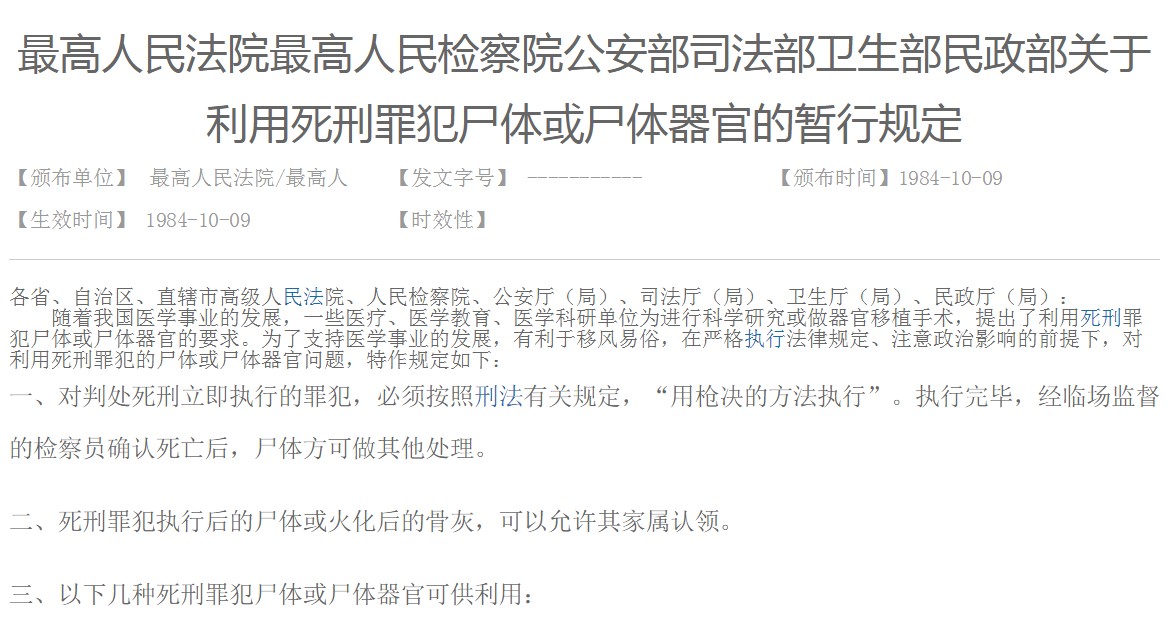
Figure 11.1 Screenshot of the CCP’s Provisional Regulations on Using the Corpses and Organs of Death Row Inmates
3. Widespread indiscriminate killing of death row inmates
China’s traditional culture necessitates the deceased be respected, and a dead body should be kept in its entirety. So the corpses were rarely insulted, and this is also the main cultural reason that few Chinese are willing to donate their organs. Since the CCP believes in atheism, it takes organs not only from death row inmates, but also from those who are not guilty or whose crimes are not punishable by death.
Two well-known cases have been circulating recently on the Internet. One is the Nie Shubin case, in which Nie was sentenced to death for rape despite insufficient evidence. It was believed that he was given a death sentence just because his organs matched well with those of a high-ranking CCP official. Later the real perpetrator, Wang Shujin, emerged. However, the judicial administration in Hebei Province refused to confirm the validity of the detailed confession by Wang Shujin and refused to rectify Nie’s case.[421]
The second major case is that of Xia Junfeng, a street vendor. City inspectors beat him up, and to defend himself, Xia killed the two inspectors by accident, for which he was given a death sentence. Jurists, lawyers and public opinion in China agreed that Xia did not deserve to die for his crime. According to the Beijing News (Xin Jing), when Xia’s wife Zhang Jing received what Xia had left her from the prison, the package contained the clothes Xia wore when he met his family for the last time on September 25, 2013. She murmured to herself, “What was he wearing when he left?”[422]
Similar to Nie’s case, Xia’s execution date was issued months before his actual execution date. It is believed that this lapse was used for seeking a suitable organ buyer and to arrange for the organ transplant operation.
4. Forced organ harvesting from other disadvantaged groups
In November 2013, Phoenix Weekly, a Hong Kong-based magazine, published a report titled “The Veiled Reality of the Body Organs Trade in China.” The article stated, “In the past decade, travel to China for organ transplant has become increasingly popular. In China, organs seem to be available all the time with very little wait time needed; and matching procedures are done quickly.” Medical professionals around the world believe that there must be massive underground organ banks in China, even banks, where organs are harvested from living people. In other words, “there must be organ suppliers whose blood has been tested, blood types and other matching tests completed and filed beforehand, and who would be taken to the ‘hospitals’ (i.e. slaughterhouses) on demand. That is the only way to guarantee the uninterrupted availability of organs which can be supplied on extremely short notices.”
The article explicitly stated, “Falun Gong practitioners who have no legal protection in China, prisoners in China’s labor camps, social refugees and abducted women and children are all vulnerable targets of this underground organ trade organization.”[423]
Through two years of investigation, Ethan Gutmann, a U.S. investigative writer and China watcher, interviewed some Uighur policemen, and Chinese doctors and nurses, whose statements help verify that the CCP began harvesting organs from Uighur dissidents and civilians decades ago.
However, as copious evidence in our report indicates, the scale and magnitude of organ harvesting from living Falun Dafa practitioners far exceeds the scale that the CCP had committed in the past; this is a state-sanctioned action ordered by Jiang Zemin, rather than isolated crimes of illegal organ trade. Random individuals cannot possibly carry out organ harvesting on such a massive scale, as in the case of Falun Gong practitioners.
II. The CCP’s various murderous political campaigns were acts of genocide
The following CCP’s various political campaigns after seizing power in China are anti-humanity genocides.
1. “Suppression of the counter-revolutionaries and land reform”
After the CCP seized power in 1949, in March 1950, it issued the Order to Strictly Suppress the Counter-revolutionary Elements, which is historically known as the “suppression of the counter-revolutionaries.”
At the end of 1952, the CCP officially published the number of executed “counter-revolutionary elements” as exceeding 2.4 million. From county magistrates to local jiazhangs (leaders of 10-family units in rural China), the actual number of local administrators, public servants and teachers from the former Nationalist Party government and landowners, who perished in this movement, was at least 5 million. As for those who perished in the land reform movement, according to Mao, the figure is between 2 million and 3 million. John F. Fairbank, a prominent American academic and historian on China, estimated the figure to be over 1 million.
2. The “Three-Anti Campaign”, “Five-Anti Campaign” and “Elimination of the Counterrevolutionaries”
The “Three-Anti Campaign” began in December 1951, and the “Five-Anti Campaign” began in January 1952. According to Facts of the Political Campaigns after the Founding of the People’s Republic of China, during the “Three-Anti Campaign” and “Five-Anti Campaign,” more than 323,100 people were arrested and over 280 committed suicide or disappeared. In the subsequent “Elimination of the Counterrevolutionaries” movement, over 21,300 people were executed, and over 4,300 committed suicide or disappeared.
3. The “Cultural Revolution”
The Cultural Revolution was formally launched on May 16, 1966, and lasted until 1976. This period has been called the “Ten-Year Catastrophe.” Facts of the Political Campaigns after the Founding of the People’s Republic of China reported that, “over 4.2 million people were detained and investigated; over 1,728,000 people died of unnatural causes; over 135,000 people were labeled as counter-revolutionaries and executed; over 237,000 people were killed and over 7.03 million were disabled or injured in armed attacks; and 71,200 families were entirely destroyed.”
Statistics compiled from county annals by experts show that at least 7.73 million people died of unnatural causes during the Cultural Revolution. According to some Japanese media reports, the statistical data collected on the orders of the CCP’s Central Committee confirmed that the Cultural Revolution brought disaster to 600 million Chinese people.
4. “The June Fourth Massacre”
From the evening of June 3 to the early morning of June 4, 1989, the CCP ordered its troops to open fire on the peacefully demonstrating citizens and students on Beijing’s Tiananmen Square and in the surrounding streets. The CCP’s military dispatched tanks to chase the students to compel them to leave the square. This incident is known as the “June 4th Massacre” or the “Tiananmen Square Massacre.”
On the eve of June 4, 2014, a confidential file held at the White House was exposed. Through the informant within the CCP’s martial law troops, the U.S. government learned that the CCP’s internal assessment estimated 40,000 casualties during the “Tiananmen Square Massacre, including 10,454 people killed.
5. “The Persecution of Falun Gong Practitioners”
The scale of this genocidal persecution against Falun Gong practitioners, which is still ongoing, is the largest persecution of belief in human history. Hundreds of millions of people’s freedom of faith has been suppressed, and millions of people are being illegally detained. Furthermore, the evilest crime of live organ harvesting, something unprecedented on this planet, continues to take place.
Chapter 12: WOIPFG Shall Never Give up in Fulfilling Its Mission
I. The CCP demonizes the human nature and turns society into hell on earth
Our investigation has made it clear that the CCP, through indoctrination and violence, has completely eradicated the baseline for human nature and has done so systematically. Doctors bearing the sacred role of saving lives have been turned into ruthless murderers. Under the CCP’s rule, men have lost their remaining shreds of morality and decency. Falun Gong practitioners have not been the only group of people that have fallen victim to the CCP’s perversity. In fact, the CCP is harmful to any society and to humanity as a whole. Anyone still under its influence has placed him or herself in peril. To fully investigate and expose the CCP’s crimes against humanity is for mankind to defend itself against this force of evil.
II. We remain determined in the face of daunting challenges
Since January 20, 2003, the date of WOIPFG’s establishment, we have known that the kind of investigations we do would be different. Our investigation resembles, in methods, those done during war times and target almost the entire country of China under the CCP’s iron fist. The subject of our investigation is state-sanctioned crimes by the CCP, essentially a totalitarian and terrorist organization, in which the extent of its evil, deception, brutality and scale are something the world has never seen before.
Our work could only be made possible with the long-term selfless commitment of all of our volunteers and overseas individuals, who choose to stand on the side of justice. We would like to extend our sincere gratitude to all of you.
Facing these persecutors, we know that they are also victims and the consequences of their actions are extremely tragic. We will investigate well and expose evil as soon as possible, so these people can wake up early and avoid the fate of destruction.
WOIPFG is a non-profit organization. Over the many years since our establishment, WOIPFG has not accepted any external donations. Those who take part in this project, out of their own pockets, have paid for the various expenses. All of us who contribute to the work of WOIPFG are volunteers. We each have jobs, and we do our best to keep this project going. And no matter what, we are determined in what we do and shall never look back, because we understand that this is an important responsibility, and that individual losses and gains pale in comparison.
It has been years since the facts of live organ harvesting were exposed to the world, yet the carnage in China has not come to a stop. Faced with this reality, we often feel profound frustration and grief. Many of us often wake up in the middle of the night with a cold sweat. As you are reading this sentence, probably many good, innocent Falun Gong practitioners are being strapped to a gurney and pushed into an operating room to have their organs extracted. Many more practitioners are still imprisoned in secret jails, facing the unspeakable terror of having their hearts, livers and kidneys removed at any moment. They are desperate for your help. And their families—parents, brothers, sisters, etc.—who have endured tremendous suffering over these years, are desperate to be reunited with their loved ones.
We feel the burden and responsibility on our shoulders.
III. What can we do to help put a stop to the CCP’s crimes against humanity?
Our recommendations to individuals:
1) Let your family, relatives, friends, neighbors, coworkers and anybody else in your social circle know the facts of the CCP’s forced organ harvesting from a massive number of living Falun Gong practitioners. Let the whole world know the truth, and stand together to put a stop to the CCP’s crimes against humanity.
2) If you are able to, track down and collect names and evidence of individuals suspected of harvesting organs from Falun Gong practitioners. Report your findings to WOIPFG, and become part of this endeavor, which helps pave the road for an unprecedented, historical trial in the future.
We call on all countries to:
1. Thoroughly investigate the CCP’s crimes against humanity in China!
2. Implement the universal jurisdiction of the Rome Convention on crimes against humanity, and launch judicial investigation procedures for Chinese doctors, police officers and other relevant personnel suspected of organ harvesting and who have come to a foreign country.
3. Enforce legislation that prohibits the training of organ transplant technologies for China, and prohibits citizens from going to China to do organ transplants and other coordinated crimes.
WOIPFG abides by the following principle: whoever commits the offence shall bear the responsibility; in the case where the offence is committed by an organization, the responsibility shall fall on the individuals involved; abetting a crime and directly committing a crime are considered the same. According to this principle, the responsibility of all the crimes committed in the name of an organization, a unit or a system shall eventually fall on the individuals involved. All responsible individuals involved in the persecution of Falun Gong shall be thoroughly investigated and brought to justice.
The persecution of Falun Gong is a genocide and a crime against humanity. Most notably, live harvesting organs from Falun Gong practitioners is a state-sanctioned crime initiated by Jiang Zemin and implemented by the CCP. All that have taken part in live organ harvesting must be held responsible and be condemned and punished by law.
Self-confession, reporting others’ crimes, and striving for a redemption is the only way out! Of course, individuals who are obsessed with their crimes would not admit, but you can’t stop others, including your accomplices, from reporting. Consequently, you will lose the chance to redeem yourself.
It is the responsibility and privilege of every nation, organization and individual to take part in fully exposing and putting a stop to the CCP’s crimes against humanity.
Governments of all countries, organizations and righteous people around the world must act immediately to fully understand communism’s ultimate goal and thoroughly investigate the CCP’s crimes against humanity and bring it to justice! There is no time to waste! This is not only about punishing the perpetrators for their crimes, but more importantly, it’s also about restoring the human race’s last moral conscience! This is a battle between good and evil, as well as a comprehensive moral test for every individual, every organization, and every country’s government. At this junction of history, we hope that people will choose conscience and justice, and eliminate the evil together.
World Organization to Investigate the Persecution of Falun Gong is determined, as always, to bring all agencies, organizations and individuals guilty of persecuting Falun Gong to justice. No matter how long it takes, and no matter how far and deep we have to search, WOIPFG shall carry on its investigation till the end, fulfil its mandated mission, right the wrongs, and uphold justice in the world. This is WOIPFG’s promise to the international community. We shall never give up.
World Organization to Investigate the Persecution of Falun Gong
Tel: +1-347-448-5790; Fax: +1-347-402-1444
Mailing address: P.O. Box 84, New York, NY 10116, U.S.A.
Online Report: https://www.zhuichaguoji.org/node/3387
Website: http://zhuichaguoji.org (Chinese); http://www.upholdjustice.org/ (English)
References
----------------------------
[1] WOIPFG's Report on the Crime of Live Organ Harvesting in China -- Table of Content
http://www.upholdjustice.org/node/370
[2-1] South Weekend. “The maze of organ donation: visible organs, invisible donors”. March 26, 2010. http://news.163.com/10/0326/10/62MP5K0G00011SM9.html
WOIPFG archived link: http://www.zhuichaguoji.org/cn/images/nationalcriminalreports/10.jpg
[2-2] https://www.zhuichaguoji.org/node/124628
[3] Guo Na. “It is hard to make laws for Organ Transplantation”. Sanlian Lifeweek. April 17, 2006. http://www.lifeweek.com.cn/2006/0417/14976.shtml
[4] People.com.cn. “Hepatobiliary Disease Research Institute of Wuhan University: Organ Transplantation Races with Time”. April 25, 2015. http://hb.people.com.cn/n/2015/0425/c337099-24632343.html
[5-1] China Liver Transplant Registry Network Statistics. http://cltr.org/
[5-2] 《Transplant Center of Beijing Tongren Hospital》 “Current Status of Liver Transplantation in China" Liu Keding, Editorial Department of Chinese Journal of Organ Transplantation http://www.trhos.com/trtx/gyz2.HTM
[5-3] 《People’s Daily online》 2000 年 10 月 17 日 Character http://unn.people.com.cn/GB/channel413/417/1100/1131/200010/17/1857.html
http://www.zhuichaguoji.org/media/2020/09/0906.png
http://www.zhuichaguoji.org/media/2020/09/0906-Parts.png
[5-4] Life Week (Sanlian Shenhuo Zhoukan) September 23, 2004 “Organ Transplantation: A Large Market That Is Quietly Growing” Jin Yan, Wang Hongliang http://www.lifeweek.com.cn/2004-09-23/000019781.shtm
http://www.zhuichaguoji.org/media/2020/08/20200819-2.png
WOIPFG archived link: http://www.zhuichaguoji.org/sites/default/files/report/2015/59389_12.png
[5-5] Life Week (Sanlian Shenhuo Zhoukan) September 23, 2004 “Organ Transplantation: A Large Market That Is Quietly Rising” Jin Yan, Wang Hongliang, http://archive.is/wRE1t
WOIPFG Archive Link: http://www.zhuichaguoji.org/media/2020/08/20200819-2.png
[5-6] Life Week (Sanlian Shenhuo Zhoukan) September 23, 2004 “Organ Transplantation: A Large Market That Is Quietly Rising” Jin Yan, Wang Hongliang http://archive.is/wRE1t
According to incomplete statistics from the Organ Transplant Society of the Chinese Medical Association, as of 2003, our country has completed more than 55,000 organ transplants. Among them, there are more than 50,000 kidney transplants, and currently more than 5,000 are completed every year, second only to the United States; more than 3,000 liver transplants, 1,500 completed last year alone.
WOIPFG Archive Link: http://www.zhuichaguoji.org/media/2020/08/20200819-3.png
WOIPFG Archive link: http://www.zhuichaguoji.org/media/2020/08/20200819-3-Parts.png
[5-7] “Peking University People's Hospital Liver Transplantation Center records the breakthrough of 300 cases of liver transplantation in Peking University People's Hospital Liver Transplantation Center” http://web.archive.org/web/20070304080019/http://www.pku-transplantation. net/html/dongtai-1-6.htm (Over 1,500 liver transplants were completed nationwide in 2003)
WOIPFG Archive link: http://www.zhuichaguoji.org/media/2020/08/20200819-4.png
[5-8] “China Organ Transplant Network” April 5, 2006. Source: Health News (Jian Kang Bao) “Our country's first organ transplant regulations are coming out soon” Author: Liu Bin (Our country’s first organ transplant regulations coming into being - 360 transplant hospitals carrying out the amount of 10,090 heart, liver, kidney transplant cases (In 2004, 7,300 cases of kidney, 2,500 cases of liver, and 100 cases of heart transplants) http://web.archive.org/web/20060417180443/http://www.transplantation.or…
WOIPFG archived link: http://www.zhuichaguoji.org/media/2020/08/20200819-5.png
[5-9] “China Organ Transplant Network” in April 2006. Source: Life Week, Sina.com “China controls 98% of organ transplant source are controlled by the systems outside the Ministry of Health” Author: ◎ reporter Guo Na http://web.archive.org/web/ 20080313204940/http://www.transplantation.org.cn/html/2006-04/467.html
[5-10] Statistics from “China Liver Transplant Registry” Number of registered cases of liver transplantation in Mainland China
WOIPFG archived link: http://www.zhuichaguoji.org/sites/default/files/report/2015/59389_12.png
[6] China Liver Transplant Registry Network Statistics. http://cltr.org/
WOIPFG archived link: http://www.zhuichaguoji.org/sites/default/files/report/2015/59389_12.png
[7] Baike.com. “Organ Transplant Tourism.” http://www.baike.com/wiki/%E5%99%A8%E5%AE%98%E7%A7%BB%E6%A4%8D%E6%97%85…
WOIPFG archived link: http://www.zhuichaguoji.org/cn/images/nationalcriminalreports/17.png
[8] Matthew Robertson. “Investigative Report: A Hospital Built for Murder”. The Epoch Times. February 4, 2016 Updated: April 23, 2018. https://www.theepochtimes.com/china-hospital-built-for-murder_1958171.html
[9] Matthew Robertson. “Investigative Report: A Hospital Built for Murder”. The Epoch Times. February 4, 2016 Updated: April 23, 2018. https://www.theepochtimes.com/china-hospital-built-for-murder_1958171.html
[10] Orient Organ Transplant Center. “The Center’s year-end summary meeting for 2005”. January 5, 2006. http://www.ootc.net/HomePage/FileDocDetail.aspx?fileno=494
[11] “Famous doctors of Jinmen”. “Striving hard in the past and rebuilding the glory today - Professor Shen Zhongyang, a famous transplant specialist”. https://web.archive.org/web/20190625031411/http://www.cccm-em120.com/zhongxiyiguokan/cccm/pdf/2006-2/1%E6%98%94%E6%97%A5%E6%8B%BC%E6%90%8F%E8%BF%9B%E5%8F%96%20%E4%BB%8A%E6%97%A5%E9%87%8D%E5%BB%BA%E8%BE%89%E7%85%8C%E2%80%94%E2%80%94%E8%91%97%E5%90%8D%E7%A7%BB%E6%A4%8D%E5%AD%A6%E4%B8%93%E5%AE%B6%E6%B2%88%E4%B8%AD%E9%98%B3%E6%95%99%E6%8E%88.pdf
[12] WOIPFG. WOIPFG’s Investigation Report on the CCP’s State-sanctioned Crime of Harvesting Organs from Falun Gong Practitioners on a Massive Scale (updated version). Feb. 4, 2016. https://www.zhuichaguoji.org/node/64353
[13] WOIPFG. WOIPFG’s Investigation Report on the CCP’s State-sanctioned Crime of Harvesting Organs from Falun Gong Practitioners on a Massive Scale (updated version). Feb. 4, 2016. http://www.zhuichaguoji.org/node/64343#_ednref6
[14] Introduction of the Ministry of Health Forensic Pathology Key Laboratory. Xi'an Jiaotong University.
Retrieved from: http://www.xjtu.edu.cn/xynr.jsp?urltype=tree.TreeTempUrl&wbtreeid=1634&…
WOIPFG’s archived link: http://www.upholdjustice.org/upload/images/nationalcriminalreports/34.pdf
[15] Introduction of the Organ Transplant Center. The 309th Hospital of Chinese People’s Liberation Army. November 17, 2010. Retrieved from: http://www.309yy.com/_Dept/View.aspx?id=3323 (page no longer valid)
WOIPFG’s archived link: http://www.upholdjustice.org/upload/images/nationalcriminalreports/35.png
[16] “Our Hospital Liver Transplant Department has An Excellent Team of Physicians.” PLA Second Artillery General Hospital. Retrieved from: http://www.epzyy.com/News/Articles/Index/1348 (page no longer valid)
WOIPFG’s archived link: http://www.upholdjustice.org/upload/images/nationalcriminalreports/36.png
[17] (2009, Feb. 25). Introduction of the Liver Transplant Center of the General Hospital of Beijing Military Region.
Retrieved from: http://jzgdk.cnkme.com/papers/show/21865
WOIPFG’s archived link: http://www.upholdjustice.org/upload/images/nationalcriminalreports/37.png
[18] Liu Zhenwen. Liver Disease Rehabilitation Garden. Retrieved from: http://www.jk300.com/liuzhengwen.htm
WOIPFG’s archived link: http://www.upholdjustice.org/upload/images/nationalcriminalreports/38.png
[19] Introduction of the 307th Hospital of Chinese People’s Liberation Army. Baidu Encyclopedia.
Retrieved from: http://www.baike.com/wiki/307%E5%8C%BB%E9%99%A2
WOIPFG’s archived link: http://www.upholdjustice.org/upload/images/nationalcriminalreports/39.png
[20] Features of the Institute of Liver Transplant. Armed Police General Hospital.
Retrieved from: http://www.wj-hospital.com/yjshzx1/yz/
WOIPFG’s archived link: http://www.upholdjustice.org/upload/images/nationalcriminalreports/40.pdf
[21] Introduction of the Department of Hepatobiliary at the Affiliated Beijing You’An Hospital, Capital Medical University. Good Doctor Online.
Retrieved from: http://www.haodf.com/faculty/DE4roiYGYZwIQrvS30yF9V0wc/jieshao.htm
WOIPFG’s archived link: http://www.zhuichaguoji.org/cn/images/nationalcriminalreports/41.pdf
[22] (2013, Dec. 3). [Hospital News] Peking University People's Hospital Hosted the Second Human Organ Procurement Organization Training and Human Organ Transplantation Policy Training. Peking University People’s Hospital, Information Week, Vol. 21. Retrieved from: http://dxb.bjmu.edu.cn/art/2013/12/3/art_12568_91407.html
WOIPFG’s archived link: http://www.upholdjustice.org/upload/images/nationalcriminalreports/42.pdf
[23] Chronicle of Events at the Organ Transplant Center of the Third Hospital of Peking University. The Third Hospital of Peking University Liver Transplantation Center. Retrieved from: http://www.liver-tx.net/jj05.html
WOIPFG’s archived link: http://www.upholdjustice.org/upload/images/nationalcriminalreports/43.png
[24] Introduction of Beijing Haidian Hospital. Integrated Information Network.
Retrieved from: http://www.zizhong.com.cn/AG/2005/1257.html
WOIPFG’s archived link: http://www.upholdjustice.org/upload/images/nationalcriminalreports/44.png
[25] Introduction of Affiliated Zhongshan Hospital. Shanghai to help doctors Network.
Retrieved from: http://www.91985.com/jibing/xiaochuan/yiyuan.asp?id=116
WOIPFG’s archived link: http://www.upholdjustice.org/upload/images/nationalcriminalreports/45.p…
[26] Chen Qing (reporter), Qin Sicui (Correspondent). (2003, Dec. 9). Zhongshan Hospital Cooperates with the World's Largest Organ Transplant Agencies to Step up Organ Transplantation. Sina.com.
Retrieved from: http://news.sina.com.cn/c/2003-12-09/08301293869s.shtml
WOIPFG’s archived link: http://www.upholdjustice.org/upload/images/nationalcriminalreports/46.png
[27] Introduction of Shanghai Clinical Center for Organ Transplantation (subsidiary of Shanghai First People's Hospital). Shanghai Jiaotong University School of Medicine website.
Retrieved from: http://www.shsmu.edu.cn/default.php?mod=article&do=detail&tid=869374
WOIPFG’s archived link: http://www.upholdjustice.org/upload/images/nationalcriminalreports/47.pdf
[28] (2005, Jan. 20). The Surgery Department of Shanghai Jiaotong University Affiliated Ruijin Hospital (key disciplines) Retrieved from: http://www.rjh.com.cn/2013ruijin/ruijin/ylts/lcks/6486.shtml
WOIPFG’s archived link: http://www.upholdjustice.org/upload/images/nationalcriminalreports/48.png
[29] Introduction of Lung Transplant Division. Shanghai Thoracic Hospital website.
Retrieved from: http://chest.shxkyy.com/hospital/ksjs.aspx?id=27
WOIPFG’s archived link: http://www.upholdjustice.org/upload/images/nationalcriminalreports/49.png
[30] Introduction of Tianjin First Central Hospital. Hospital Website.
Retrieved from: http://www.tj-fch.com/sitecn/yyjj/1587.html
WOIPFG’s archived link: http://www.upholdjustice.org/upload/images/nationalcriminalreports/426.png
[31] Introduction of Southwest Hospital Institute of Hepatobiliary Surgery. Hepatobiliary Sky.
Retrieved from: http://www.hbsky.org/gyz/gyzyemian.html
WOIPFG’s archived link: http://www.upholdjustice.org/upload/images/nationalcriminalreports/51.png
[32] (2006). The History of Organ Transplant at Our Hospital. Journal of the First Affiliated Hospital of Wenzhou University, 2006, Vol. 18 & 19.
Retrieved from: http://www.hosp1.ac.cn/wyyyweb/wlybview.aspx?id=3949 (page no longer valid)
WOIPFG archived link: http://www.zhuichaguoji.org/cn/images/nationalcriminalreports/52.png
[33] Overview of the Transplant Center at the First Affiliated Hospital of Wenzhou University.
Retrieved from: http://www.hosp1.ac.cn/wyyy/web/ksts/lcks.aspx?ksmc=%D2%C6%D6%B2%BF%C6
WOIPFG archived link: http://www.zhuichaguoji.org/cn/images/nationalcriminalreports/53.pdf
[34] Introduction of the Transplantation division. Third Xiangya Hospital, Central South University website.
Retrieved from: http://www.xy3yy-shfw.com/dwk/yzzk/
WOIPFG’s archived link: http://www.zhuichaguoji.org/sites/default/files/report/2015/59389_420.p…
[35] Multi-organ Combined Transplantation Research Key Laboratory of the Ministry of Health. Baidu Encyclopedia.
Retrieved from: http://baike.baidu.com/view/3125503.htm
WOIPFG’s archived link: http://www.upholdjustice.org/upload/images/nationalcriminalreports/55.p…
[36] Introduction of the Organ Transplantation division. Shanghai Changzheng Hospital website.
Retrieved from: http://www.shczyy.com/App/Office/OfficeDetail.aspx?OfficeID=21 (page no longer valid)
WOIPFG’s archived link: http://www.upholdjustice.org/upload/images/nationalcriminalreports/56.png
[37] Chen Yanhui (reporter). (2006, Feb. 22). Investigation of Global Organ Transplant – Investigation of Tens of Thousands Foreigners Visiting China for Organ Transplants, China becoming the World's Emerging Organ Transplant Center. Phoenix.
Retrieved from: https://web.archive.org/web/20100611090330/http://news.ifeng.com/phoeni…
WOIPFG’s archived link: http://www.upholdjustice.org/upload/images/nationalcriminalreports/58.p…
[38] Ministry of Health. http://www.moh.gov.cn/mohbgt/pw10604/200804/18344.shtml
WOIPFG archived link: http://www.zhuichaguoji.org/cn/images/nationalcriminalreports/276.png
[39] Minghui.org. “Investigation indicates suspicious number of kidney transplants at Tangshan Steel Cooperation Hospital and Tianjin Armed Police Hospital”. April 29, 2006. http://www.minghui.org/mh/articles/2006/4/29/126322.html (Chinese)
http://www.clearwisdom.net/emh/articles/2006/5/4/72799.html (English)
[40] Minghui.org. “Extremely tragic atrocity is still going on”. May 9, 2006. http://www.minghui.org/mh/articles/2006/5/9/127277p.html
[41] Xiaoxiang Morning Post. “Twenty cases of organ transplant operations for free”. April 28, 2006. http://news.sina.com.cn/w/2006-04-28/08008809252s.shtml
WOIPFG archived link: http://www.upholdjustice.org/upload/images/nationalcriminalreports/277.png
[42] “Sina News Center” 20 Kidney Transplant Operations Free of Charge, April 28, 2006. http://news.sina.com.cn/w/2006-04-28/08008809252s.shtml
WOIPFG archived link: http://www.upholdjustice.org/upload/images/nationalcriminalreports/277…
[43] “www.renminbao.com” Urgent! Many Readers Wrote to us to Report that Hospitals in Mainland China Busy Murdering Witnesses (photo) April 17, 2006. http://www.renminbao.com/rmb/articles/2006/4/17/40113.html
[44] “World Organization to Investigate Persecution of Falun Gong” Investigation Report on Organ Harvesting from Live Falun Gong Practitioners in Various Regions of China Original version: April 16, 2006, Updated: April 22 and May 1. http://www.upholdjustice.org/node/166
[45] “World Organization to Investigate Persecution of Falun Gong” Investigation Report on Organ Harvesting from Live Falun Gong Practitioners in Various Regions of China Original version: April 16, 2006, Updated: April 22 and May 1. http://www.upholdjustice.org/node/166
[46] “World Organization to Investigate Persecution of Falun Gong” Investigation Report on Organ Harvesting from Live Falun Gong Practitioners in Various Regions of China Original version: April 16, 2006, Updated: April 22 and May 1. http://www.upholdjustice.org/node/166
[47] “World Organization to Investigate Persecution of Falun Gong” Investigation Report on Organ Harvesting from Live Falun Gong Practitioners in Various Regions of China Original version: April 16, 2006, Updated: April 22 and May 1. http://www.upholdjustice.org/node/166
[48] “World Organization to Investigate Persecution of Falun Gong”. Investigation Report on Organ Harvesting from Live Falun Gong Practitioners in Various Regions of China Original version: April 16, 2006, Updated: April 22 and May 1. http://www.upholdjustice.org/node/166
[49] Introduction of the Organ Transplantation Center at PLA 309 Hospital. Nov. 17, 2010. http://www.309yy.com/_Dept/View.aspx?id=3323
WOIPFG archived link: http://www.zhuichaguoji.org/cn/images/nationalcriminalreports/35.png
[50] Baidu Baike. Tianjin First Central Hospital
WOIPFG archived link: http://www.zhuichaguoji.org/sites/default/files/report/2016/64700_06105…
[51] “Famous doctors of Jinmen”. “Striving hard in the past and rebuilding the glory today - Professor Shen Zhongyang, a famous transplant specialist”. https://web.archive.org/web/20190625031411/http://www.cccm-em120.com/zhongxiyiguokan/cccm/pdf/2006-2/1%E6%98%94%E6%97%A5%E6%8B%BC%E6%90%8F%E8%BF%9B%E5%8F%96%20%E4%BB%8A%E6%97%A5%E9%87%8D%E5%BB%BA%E8%BE%89%E7%85%8C%E2%80%94%E2%80%94%E8%91%97%E5%90%8D%E7%A7%BB%E6%A4%8D%E5%AD%A6%E4%B8%93%E5%AE%B6%E6%B2%88%E4%B8%AD%E9%98%B3%E6%95%99%E6%8E%88.pdf
[52] Huang Qi. “Xia Qiang--Marshal in the Discipline of Liver Transplantation”. June 23, 2006.
http://scitech.people.com.cn/GB/1057/4520977.html
WOIPFG archived link: http://www.zhuichaguoji.org/cn/images/nationalcriminalreports/262.png
[53] Liver transplantation team of the Organ Transplantation Center of Shanghai Renji Hospital. June 28, 2007. http://www.transplantation.org.cn/ZJiaoTongDaXueYiXueYuanFuShuRenJanDui…
WOIPFG archived link: http://www.zhuichaguoji.org/cn/images/nationalcriminalreports/623.png
[54] “Chinese Organ Transplantation Website: June 28, 2007. “Shanghai Renji Hospital Organ Transplantation Center Liver Transplantation Team”
http://www.transplantation.org.cn/ZJiaoTongDaXueYiXueYuanFuShuRenJanDui…
WOIPFG archived link: http://www.zhuichaguoji.org/cn/images/nationalcriminalreports/623.png
[55] “Introduction to the Organ Transplantation Center of Sichuan People’s Hospital”. http://www.samsph.com/zhongdian-content.asp?id=8399
WOIPFG archived link: http://www.zhuichaguoji.org/cn/images/nationalcriminalreports/836.pdf
[56]Introduction of Organ Transplantation Center, Sichuang People’s Hospital. http://www.samsph.com/qgyzzx_intro/409/1/
WOIPFG archived link: http://www.zhuichaguoji.org/cn/images/nationalcriminalreports/836.pdf
[57] Introduction of Shanghai Eastern Hepatobiliary Surgery Hospital. http://www.ehbh.cn/intro.php
WOIPFG Archived Link: http://www.zhuichaguoji.org/sites/default/files/report/2016/64700_061901.png
[58] Shi Jie. “Eastern Hepatobiliary Surgery Hospital will move to Jiading, Anting, and the number of beds will double.” Xinmin Evening News. August 15, 2015. http://sh.eastday.com/m/20150815/u1ai8841164.html
WOIPFG archived links:
http://www.zhuichaguoji.org/sites/default/files/report/2015/59389_495.png
[59] China Non-Public Medical Institution Association. “Liu Guo’en: China’s public hospitals have great potential for reforms” Shanghai Times. December 27, 2014.
WOIPFG archived link: http://www.zhuichaguoji.org/cn/images/nationalcriminalreports/496.png
[60] Chinese Etiquette Training Network website. “Etiquette development for medicine professions – exemplary services at the reputable Zhengzhou People's Hospital”. April. 8, 2010. http://www.liyi360.com/2010/4/8/cbdjl.htm
WOIPFG Archived Link: http://www.zhuichaguoji.org/cn/images/nationalcriminalreports/237.pdf
[61] Chinese Etiquette Training Network website. “Etiquette development for medicine professions – exemplary services at the reputable Zhengzhou People's Hospital”. April. 8, 2010. http://www.liyi360.com/2010/4/8/cbdjl.htm
WOIPFG Archived Link: http://www.zhuichaguoji.org/cn/images/nationalcriminalreports/237.pdf
[62] Gu Bo, Tan Qiling. “The Third Comprehensive Ward improved its workflow, shortened the average in-hospital stay for kidney transplant patients.” June 28, 2013. http://www.cd120.com/htmlnewsdongtaixinwen/62072.jhtml
WOIPFG archived link: http://www.zhuichaguoji.org/cn/images/nationalcriminalreports/505.png
[63-1] “Introduction to the Department of Kidney Transplantation, the First Affiliated Hospital of Zhengzhou University”. Http://fcc.zzu.edu.cn/newsss/vmsgisapi.dll/vonefun?fun=3a_s&id=8235
[63-2] UC Davis Health Transplant Center About Kidney Transplantation HLA Typing/MatchingExcept for identical twins and some brothers and sisters, it is very rare to get an exact match between two people, especially if they are unrelated. The chance of finding an exact match with an unrelated donor is about one in 100,000.
https://health.ucdavis.edu/transplant/about/hla-typing-matching.html
[64] In 2017, more than 138 million people over the age of 18 had registered as organ donors. That's more than half of all U.S. adults. (54 percent)***
Organ Donation Statistics, U.S. Government Information on Organ Donation and Transplantation https://organdonor.gov/statistics-stories/statistics.html#glance
[65] OrganDonor.Gov. “The Matching Process.” U.S. Department of Health and Human Services.
WOIPFG archived link: http://www.zhuichaguoji.org/cn/images/nationalcriminalreports/505.png
[66] “Profile of the Oriental Organ Transplant Center.”
WOIPFG archived link: http://www.zhuichaguoji.org/cn/images/nationalcriminalreports/200.png
[67] WOIPFG. Report on Liver Transplantation in 2006. China Liver Transplant Registry. 2006.
WOIPFG archived link: http://www.upholdjustice.org/upload/images/nationalcriminalreports/192.pdf
[68] Fu Zhiren, Ma Jun. Prognosis Factors and Treatment for Serious Hepatitis Emergency Transplantation. Journal of Clinical Surgery. June 2006, Volume 14, Number 6.
WOIPFG archived link: http://www.upholdjustice.org/upload/images/nationalcriminalreports/195.pdf
[69] Huaxia Net. Zhejiang Wanli College Digital Library. Jan. 6, 2006.
[70] People.com. “Tan Jianming’s Advanced Deeds.” WOIPFG archived link:
http://www.zhuichaguoji.org/cn/images/nationalcriminalreports/172.png
[71] Bloody Harvest: Revised Report into Allegations of Organ Harvesting of Falun Gong Practitioners in China by David Matas and David Kilgour (Feb 25th, 2007). http://organharvestinvestigation.net/report0701/report20070131-eng.pdf
[72] People.com. “Tan Jianming’s Advanced Deeds.”
WOIPFG archived link: http://www.zhuichaguoji.org/cn/images/nationalcriminalreports/172.png
[73] Today’s Nurse. “Vice Minister of Health performed China’s first successful autologous liver transplantation operation in Xinjiang.” WOIPFG archived link: http://www.zhuichaguoji.org/sites/default/files/report/2016/64700_0301…
[74] Urumqi Online. www.xj.xinhuanet.com/bt/2005-10/03/content_5275137.htm
[75] iFeng Weekly. “Human organ trade in China, the story behind the dark curtain”. Nov. 5, 2013. http://www.51fenghuang.com/news/shehui/2514.html
WOIPFG archived link: http://www.upholdjustice.org/upload/images/nationalcriminalreports/274.png
[76] Pan Deng, Ye Qing. “China’s first successful liver transplant was completed in Xinjiang”. Urumqi Online. Oct. 3, 2005. www.xj.xinhuanet.com/bt/2005-10/03/content_5275137.htm
[77] iFeng Weekly. “Human organ trade in China, the story behind the dark curtain”. Nov. 5, 2013. http://www.51fenghuang.com/news/shehui/2514.html
WOIPFG archived link: http://www.upholdjustice.org/upload/images/nationalcriminalreports/274.png
[78] Central South University News Network. “Vice Minister of Health operated a liver transplant at the Third Xiangya Hospital.” https://web.archive.org/save/http://news.csu.edu.cn/info/1003/69502.htm
[79] Minghui.org. “A brief history of urological surgeries at the Military Kidney Clinical Center.” (Investigation Clue: Military Kidney Clinical Center Urinary Surgery Department Carried out 24 Kidney Transplant Operations in One Day)
Retrieved from: http://www.minghui.org/mh/article_images/2007-9-12-image001.jpg
[80] iFeng Weekly. “Investigation of foreigners coming to China for organ transplants”. Oct. 1, 2010. http://www.51fenghuang.com/news/fengmiangushi/wgrfhqgyz.html
WOIPFG archived link: http://www.upholdjustice.org/upload/images/nationalcriminalreports/252.png
[81] Guangzhou Daily. “Renewing life through organ transplantation”. Mar. 14, 2006. https://web.archive.org/web/20071010072726/http://gzdaily.dayoo.com/gb/…
WOIPFG archived link: http://www.upholdjustice.org/upload/images/nationalcriminalreports/238.png
[82] Xiangya Hospital of Central South University. Performed 1 case of liver, 6 cases of kidney and 8 cases of corneal transplants at one day. Jun. 3, 2005. http://www1.renminbao.com/rmb/article_images/2006-5-30-changsha06.jpg
[83] “We conducted 7 cases of heart-liver-kidney surgeries in one day.” Xiangya Hospital of Central South University. Sep. 3, 2005. http://www1.renminbao.com/rmb/article_images/2006-5-30-changsha05.jpg
[84] Newsletter of Xiangya Hospital: “Our hospital set new record in organ transplants: liver transplants, kidney transplants, corneal transplants, a total of 17 operations completed in one day.” May 14, 2006. http://www.xiangya.com.cn/medpro/xyyx/zhyx/2006-05-14/ medpro _20060514165311.html
WOIPFG archived link: http://www.upholdjustice.org/upload/images/nationalcriminalreports/250.jpg
[85] The General Hospital of Jinan Military Region. Qilu Evening News. Dec. 1, 2008. http://paper.dzwww.com/qlwb/data/20081201/html/65/content_1.html
WOIPFG archived link: http://www.zhuichaguoji.org/cn/images/nationalcriminalreports/663.png
[86] Huang Shuping, Wu Zhi. “No sleep or rest for 17 hours, and completed 5 liver transplantation operations”. Chinese Organ Transplantation Web. Mar. 10, 2014. http://www.dnkb.com.cn, http://www.transplantation.org.cn/zganxiwen/2014-03/7050.htm
WOIPFG archived link: http://www.upholdjustice.org/upload/images/nationalcriminalreports/227.pdf
[87] Huang Shuping, Wu Zhi. “No sleep or rest for 17 hours, and completed 5 liver transplantation operations”. Chinese Organ Transplantation Web. Mar. 10, 2014. http://www.dnkb.com.cn, http://www.transplantation.org.cn/zganxiwen/2014-03/7050.htm
WOIPFG archived link: http://www.upholdjustice.org/upload/images/nationalcriminalreports/227.pdf
[88] A brief history of urological surgeries at the Military Kidney Clinical Center. (Investigation Clue: Military Kidney Clinical Center Urinary Surgery Department carried out 24 kidney transplant operations in one day). Retrieved from: http://www.minghui.org/mh/article_images/2007-9-12-image001.jpg
[89] (2009, Feb. 13). The 309 Hospital of the Beijing Military Region— Introduction to the Military Organ Transplantation Center. Xinhua Net.
Retrieved from: http://news.xinhuanet.com/mil/2009-02/13/content_10815454.htm
WOIPFG archived link: http://www.upholdjustice.org/upload/images/nationalcriminalreports/221.png
[90] (2008, May. 07).Introduction of the Clinical Department of the 309 Hospital. Good Doctor Online.
Retrieved from: http://309ent.haodf.com/zhuanjiaguandian/309ent_5317.htm
WOIPFG archived link: http://www.upholdjustice.org/upload/images/nationalcriminalreports/222.png
[91] (2005, May. 10). Southwestern Hospital successfully carried out 5 liver transplants simultaneously. Chinese Liver Transplantation Web.
Retrieved from: http://www.livertransweb.com/yi/news/news_show.asp?id=77&sort=2
WOIPFG archived link: http://www.zhuichaguoji.org/cn/images/nationalcriminalreports/223.png
[92] (2006, May. 11). Multiple large hospitals in Quancheng City, Shandong Province suspected of participating in murdering Falun Gong practitioners. Minghui.org.
Retrieved from: http://www.minghui.org/mh/articles/2006/5/11/127282.html
[93] Liu Zhen, Wang Xiaoli, Wei Xiaohong. (October 2002) Analysis of nursing 1007 cases of kidney transplant patients. Chinese Nursing Research October 2002, Vol. 16, No 10.
WOIPFG archived link: http://www.upholdjustice.org/upload/images/nationalcriminalreports/225.pdf
[94] (2006, Mar. 25). Fuzhou General Hospital successfully carried out 3 liver transplants simultaneously for the first time. Xinhua Net.
Retrieved from: http://www.fj.xinhuanet.com/news/2006-03/25/content_6569298.htm
WOIPFG archived link: http://www.upholdjustice.org/upload/images/nationalcriminalreports/226.png
[95] Huang Shuping, Wu Zhi (reporters). (2014, Mar. 10). No sleep and rest for 17 hours and completed 5 liver transplantation operations. Chinese Organ Transplantation Web.
Retrieved from: http://www.transplantation.org.cn/zganxiwen/2014-03/7050.htm
WOIPFG archived link: http://www.upholdjustice.org/upload/images/nationalcriminalreports/227.pdf
[96] The 474 Hospital of the PLA Organ Transplantation and Blood Purification Center
Retrieved from: http://www.xj474hos.com/ksjj.asp?sortid=9
WOIPFG archived link: http://www.upholdjustice.org/upload/images/nationalcriminalreports/228.png
[97] Qiao Shufang, Zhang Jiyun. Organization and management of 313 cases of batch kidney transplantation of the same kind but different bodies. Chinese Journal of Convalescent Medicine 2008 Volume 17, Number 01, pp 8-9.
WOIPFG archived links: http://www.zhuichaguoji.org/cn/images/nationalcriminalreports/22901.pdf
http://www.zhuichaguoji.org/cn/images/nationalcriminalreports/22902.pdf
[98] (2006, Jun. 16). Investigation report on organ transplantation in Shanghai.
Retrieved from: http://www.minghui.org/mh/articles/2006/6/16/130559.html
[99] (2005, May. 14). Armed Police General Hospital reached new height in liver transplant operations. China Liver Transplantation Web. Retrieved from: http://www.transplantation.org.cn/html/c36/
WOIPFG archived link: http://www.upholdjustice.org/upload/images/nationalcriminalreports/231.png
[100] Introduction of Organ Transplantation and Breast Surgery Department, Dongfeng General Hospital.
Retrieved from: http://www.dfmhp.com.cn/a/keshidaohang/shoushukeshi/qiguanyizhi/
WOIPFG archived link: http://www.upholdjustice.org/upload/images/nationalcriminalreports/232.pdf
[101] Aspiring to idealized transplantation medicine --- Dean Huang Zufa talks about Development in Transplantation Medicine. Xiangya Number Three Hospital of Central South University, Newsletter No. 9.
Retrieved from: http://www.xy3yy.com/nyygj/yb09-21.html
WOIPFG archived link: http://www.upholdjustice.org/upload/images/nationalcriminalreports/233.png
[102] (2003, Sept. 19). State Deputy Minister of Health Took up the Knife and Carried out Liver Transplant in Central South University. Xinhua Net.
Retrieved from: http://news.xinhuanet.com/school/2003-09/20/content_1089770.htm
WOIPFG archived link: http://www.upholdjustice.org/upload/images/nationalcriminalreports/234.png
[103] (2005, Oct. 21). Dragons Fly and tigers Leap --- report on Kidney Transplantation Department of the Organ Transplantation Center at the Xiangya Number Two Hospital of the Central South University. Hunan Online – Popular Health Page. Retrieved from: http://www.hnol.net/content/2005-10/21/content_3479431.htm
WOIPFG archived link: http://www.upholdjustice.org/upload/images/nationalcriminalreports/235.png
[104] Zhang Liuyong. (2012, Sept. 5). 10 years history of the Urinary Surgery Department. Gaoxin Hospital of Xi’an Official Web site. Retrieved from: http://www.gxyy.net/ksnewsshow-1886.html
WOIPFG archived link: http://www.upholdjustice.org/upload/images/nationalcriminalreports/236…
[105] (2010, Apr. 8). Etiquette training for doctors and nurses --- setting a role model for excellent service at Zhengzhou People’s Hospital. China Etiquette Training Web.
Retrieved from: http://www.liyi360.com/2010/4/8/cbdjl.htm
WOIPFG archived link: http://www.upholdjustice.org/upload/images/nationalcriminalreports/237.pdf
[106] (2006, Mar. 14). Renewing life through organ transplantation. Guangzhou Daily.
Retrieved from: https://web.archive.org/web/20071010072726/http://gzdaily.dayoo.com/gb/…
WOIPFG archived link: http://www.upholdjustice.org/upload/images/nationalcriminalreports/238.png
[107] Li Tangxuan. (2006, Jan. 2). The Urological Department of Foshan City Number One People’s Hospital completed 7 kidney transplants simultaneously.
Retrieved from: http://www.fshospital.org.cn/dept/document/2006_1/dept4465.htm
WOIPFG archived link: http://www.upholdjustice.org/upload/images/nationalcriminalreports/239.pdf
[108] (2005, Jan. 6). Foshan City Number One People’s Hospital-- their legacy continues.
Retrieved from: http://www.fshospital.org.cn/cn/infosystem/document/new8712.htm
WOIPFG archived link: http://www.upholdjustice.org/upload/images/nationalcriminalreports/240.pdf
[109] (2006, Dec. 25). Chronicles of Organ Transplantation in Dalian City Friendship Hospital. Dalian News Web. Retrieved from: http://www.dlxww.com/gb/daliandaily/2006-12/25/content_1634609.htm
WOIPFG archived link: http://www.upholdjustice.org/upload/images/nationalcriminalreports/241.png
[110] Profile of Li Hongdao. China Yuxi Kidney Disease Transplantation Center.
Retrieved from: http://www.gykidney.cn/zjjj.asp
WOIPFG archived link: http://www.zhuichaguoji.org/sites/default/files/report/2015/59389_218.p…
[111] (2015, Mar. 27). A second chance at life – an account of Du Yingdong, head of Liver and Kidney Surgery Department. Jiaodong Online.
Retrieved from: http://health.jiaodong.net/system/2015/03/27/012643942.shtml
WOIPFG archived link: http://www.upholdjustice.org/upload/images/nationalcriminalreports/243…
[112] Introduction of Shengli Oil Field Central Hospital
Retrieved from: http://baike.baidu.com/view/1574980.htm?fromTaglist
WOIPFG archived link: http://www.upholdjustice.org/upload/images/nationalcriminalreports/244.pdf
[113] (2006, Apr. 4). Qidu Hospital Urological Transplantation Center carried out 4 kidney transplant operations overnight. Minghui.org.
Retrieved from: http://www.minghui.org/mh/article_images/2007-1-25-clue-02.jpg
[114] (2006, Aug. 8). Shijiazhuang City Number One Hospital completed 5 kidney transplant operations within 10 hours.
Retrieved from: http://www.minghui.org/mh/article_images/2006-8-7-sjz.jp
[115] Profile of Doctor Yue Zhongjin. Good Doctors Online.
Retrieved from: http://www.haodf.com/doctor/DE4r0BCkuHzdewXC6dicdu-554j7S.htm
WOIPFG archived link: http://www.upholdjustice.org/upload/images/nationalcriminalreports/247.pdf
[116] Introduction of the Department of Cardiology Surgery. Union Hospital, Tongji Medical College, Huazhong University of Science and Technology.
Retrieved from: http://www.whuh.com/Depart_content.php?class=1§ions_id=83
WOIPFG archived link: http://www.upholdjustice.org/upload/images/nationalcriminalreports/248.png
[117] Introduction to the Urological Department, Taizhou Hospital.
Retrieved from: http://www.tzhospital.com/html/main/mnjs/30384.html
WOIPFG archived link: http://www.upholdjustice.org/upload/images/nationalcriminalreports/249.png
[118] “Xiangya Hospital of Central South University”. “Completed 1 liver transplant, 6 kidney transplants and 8 corneal transplants on the same day”. Updated on June 3, 2005.
http://www1.renminbao.com/rmb/article_images/2006-5-30-changsha06.jpg
[119] “Xiangya Hospital of Central South University”. “Two cases of liver transplantation were completed within 72 hours in our hospital”.
http://www1.renminbao.com/rmb/article_images/2006-5-30-changsha03.jpg
[120] (2006, May. 14). Our hospital set new record in organ transplants: liver transplant, kidney transplant, corneal transplant, 17 operations completed in one day. Newsletter of Xiangya Hospital.
Retrieved from: http://www.xiangya.com.cn/medpro/xyyx/zhyx/2006-05-14/ medpro _20060514165311.html
WOIPFG archived link: http://www.upholdjustice.org/upload/images/nationalcriminalreports/250.jpg
[121] (2005, Feb. 9). Tianjin First Center Hospital has done almost 300 cases of liver transplantations, setting a world record.
Retrieved from: http://scitech.people.com.cn/GB/25893/3176435.html
WOIPFG archived link: http://www.upholdjustice.org/upload/images/nationalcriminalreports/251.png
[122] (2010, Oct. 1). Investigation of Foreigners Coming to China for Organ Transplants. iFeng Weekly.
Retrieved from: http://www.51fenghuang.com/news/fengmiangushi/wgrfhqgyz.html
WOIPFG archived link: http://www.upholdjustice.org/upload/images/nationalcriminalreports/252.png
[123] Introduction of the Orient Organ Transplant Center.
Retrieved from: https://web.archive.org/web/20060104005517/http://www.ootc.net/default…
WOIPFG archived link: http://www.upholdjustice.org/upload/images/nationalcriminalreports/253.png
[124] (2005, May. 18). Jiangxi Province Armed Police General Hospital. Weimin Health Net.
Retrieved from: http://www.wmjk.net/articleread.aspx?newid=3633&classid=2215
WOIPFG archived link: http://www.upholdjustice.org/upload/images/nationalcriminalreports/254.png
[125] (2006, Jul. 11). Armed Police Jiangxi General Hospital reached 98% success rate in kidney transplants. Sina Military.
Retrieved from: http://jczs.news.sina.com.cn/2006-07-11/0641382760.html
WOIPFG archived link: http://www.upholdjustice.org/upload/images/nationalcriminalreports/255.png
[126] (2004, Aug. 4). Sina News: Shenzhen Hospital of Guangdong Frontier Corps completed 6 kidney transplantation surgeries within 11 Hours. Shenzhen Economic Daily.
Retrieved from: http://news.sina.com.cn/s/2004-08-04/06473285080s.shtml
WOIPFG archived link: http://www.upholdjustice.org/upload/images/nationalcriminalreports/256.png
[127] Academician Zheng Shusen completed 5 liver transplantation surgeries in one day.
Retrieved from: http://www.jksoso.com/html/18CFE305.htm
WOIPFG archived link: http://www.upholdjustice.org/upload/images/nationalcriminalreports/257.png
[128] Profile of Liver Transplantation Expert—Yan Lvnan
Retrieved from: http://gz.shengwuxuewang.cn /f/ h/b.html
WOIPFG archived link: http://www.zhuichaguoji.org/sites/default/files/report/2015/59389_685.j…
[129] (2006, May. 2). Audio: military hospital openly admitted using kidneys from Falun Gong practitioners. Minghui.org.
Retrieved from: http://www.minghui.org/mh/articles/2006/5/2/126638p.html
[130] (2006, Feb. 23). Guangdong Organ Transplantation Research Center – Zhongshan University Liver Transplantation Center. News from the Center Article.
Retrieved from: https://web.archive.org/web/20070416192628/http://www.organtransplantat…
WOIPFG archived link: http://www.upholdjustice.org/upload/images/nationalcriminalreports/260.png
[131] (2006, Apr. 11). Introduction to Department: Organ Transplant Center. First Affiliated Hospital of the Kunming Medical University website. Retrieved from: http://www.ydyy.cn/DepartmentDetail-9.aspx
WOIPFG archived link: http://www.upholdjustice.org/upload/images/nationalcriminalreports/261.png
[132] Huang Qi. (2006, Jun. 23). Xia Qiang: Young General in Liver Transplantation.
Retrieved from: http://scitech.people.com.cn/GB/1057/4520977.html
WOIPFG archived link: http://www.upholdjustice.org/upload/images/nationalcriminalreports/262.png
[133] (2015, Mar. 14). The grim reality behind the buzz given to organ donation by CCP controlled media. Minghui.org. Retrieved from: http://www.minghui.org/mh/articles/2015/3/14/306242.html
[134] (2006, Jul. 27). Many organ transplants performed in hospitals throughout Shanxi Province in recent years (Photo). Minghui.org. Retrieved from (English Version):
http://www.clearwisdom.net/emh/articles/2006/7/27/75999.html
[135] Profile of Cai Zhenjie, Shaanxi Provincial People’s Hospital.
Retrieved from: http://www.spph-sx.com/WebTemp/Expert_View.asp?Article_ID=710
WOIPFG archived link: http://www.upholdjustice.org/upload/images/nationalcriminalreports/265.png
[136] Introduction of Number One Affiliated Hospital of Nanchang University Organ Transplantation Department
Retrieved from: http://www.cdyfy.com/ksjs/ksjs.asp?kscode1=0208
WOIPFG archived link: http://www.upholdjustice.org/upload/images/nationalcriminalreports/266.png
[137] (2015, Aug. 20). Strive to be a pioneer in kidney transplantation: Wu Xiaotong, Director of the Kidney Transplantation and Dialysis Center of Shanxi Province Number Two People’s Hospital. Shanxi Youth Newspaper.
Retrieved from: http://www.sxqnb.com.cn/shtml/sxqnb/20150820/104152.shtml
WOIPFG archived link: http://www.upholdjustice.org/upload/images/nationalcriminalreports/267.png
[138] (2006, Sept. 22). The Second People's Hospital of Shanxi Province conducted 11 cases of
kidney transplant on August 15. Retrieved from (Chinese version): http://www.minghui.org/mh/articles/2006/9/11/137584.html
(English version) http://www.clearwisdom.net/emh/articles/2006/9/22/78243.html
[139] (2006, Aug. 4). Guangdong Province Number Two People’s Hospital carried out 6 kidney transplantation operations. Minghui.org. Retrieved from: http://www.minghui.org/mh/articles/2013/9/30/%E8%B0%83%E6%9F%A5%E7%BA%BF%E7%B4%A2-%E9%9B%B6%E5%85%AD%E5%B9%B4%E5%85%AB%E6%9C%88%E5%9B%9B%E6%97%A5%E5%B9%BF%E4%B8%9C%E7%9C%81%E7%AC%AC%E4%BA%8C%E4%BA%BA%E6%B0%91%E5%8C%BB%E9%99%A2%E5%81%9A%E5%85%AD%E4%BE%8B%E8%82%BE%E7%A7%BB%E6%A4%8D-279442.html
[140] (2004, Mar. 27). Zhengzhou University Number One Affiliated Hospital: 4 liver transplantation operations completed in one day. Dahe Web.
Retrieved from: http://www.yidianzixun.com/article/news_3487a5d66eae0b122e96fe983d88075…
WOIPFG archived link: http://www.upholdjustice.org/upload/images/nationalcriminalreports/270.png
[141] (2014, Aug. 5). Affiliated Hospital of Qingdao University: never stop improving to develop first rate domestic Organ Transplant Center.
Retrieved from: http://qdumh.qd.sd.cn/a/yiyuandongtai/yiyuanxinwen/2014/0805/3287.html
WOIPFG archived link: http://www.upholdjustice.org/upload/images/nationalcriminalreports/175.png
[142] Baidu Encyclopedia. “Warm ischemia time.”
Retrieved from http://baike.baidu.com/view/4504011.htm
WOIPFG archived link: http://www.zhuichaguoji.org/cn/images/medicalarticles/5.png
[143] Baidu Encyclopedia. “Warm ischemia time.”
Retrieved from http://baike.baidu.com/view/4504011.htm
WOIPFG archived link: http://www.zhuichaguoji.org/cn/images/medicalarticles/5.png
[144] National Cancer Institute. Cold ischemia time.
[145] China Net | Time: July 5, 2006 | Article Source: China News Network “Ministry of Health: Liver, Kidney, Heart, and Lung Transplantation Technology Management Specification (Full Text)”. http://www.china.com.cn/chinese/health/1266002 htm
[146] Overview of the Support Center of China International Transplantation
WOIPFG archived link: http://www.zhuichaguoji.org/cn/images/nationalcriminalreports/541.png
[147] Qinjian Jie, Xia Yongxiang, Wu Lapsang, Zhang Feng, Wang Xuehao. (2009). Measures to deal with biliary complications after liver transplantation. Contemporary Chinese Medicine. 2009, Vol. 16 (04). pp 12-14
WOIPFG archived links: http://www.upholdjustice.org/upload/images/nationalcriminalreports/6301…
http://www.upholdjustice.org/upload/images/nationalcriminalreports/6302…
http://www.upholdjustice.org/upload/images/nationalcriminalreports/6303.pdf
[148] Li Yaofeng, Zhouding Hua, Wan Bao Dong, Zhao Wei, Xiaqi Jun, Wei Bing. (2007). Surgery type affects patients’ liver function after liver transplantation. Chinese General Practice, Vol. 10 Issue 23 page 1947-1950
WOIPFG archived link: http://www.upholdjustice.org/upload/images/nationalcriminalreports/64.p…
[149] Fuzhi Ren, Wang Xin, Ding Guoshan, Fu Wang, Zhang Jianjun, Lixian Xing, Ka Ni, Guo Wen Yuan, Shi Xiao Min, Cao Xiaowei, Shi Yong Zhao. (2004). Analysis of 231 case studies (240 times) of liver transplants. Shanghai Medical Journal, Vol. 27 Issue 11 Page 805-807.
WOIPFG archived link: http://www.upholdjustice.org/upload/images/nationalcriminalreports/65.p…
[150] Yang Guofeng, Chen Daozhong, Chen Wanliang, Huang Xueshan, Wu Xijie, Liao Chongxian. (2008). A Discussion on Heart Preservation for Orthotopic Heart Transplant with 111 Case Studies. Journal of Fujian Medical University, 2008, Vol.42, Issue 6, pp 539-541
[151] Xu Qingxiang, Wu Yafu, Chou Yudong, Wu Xingyu, Li Qiang, Ding Yitao. (2008). On the causes and treatments for abdominal abscesses following liver transplant. Chinese Journal of Organ Transplantation, 2008, Vol. 29, Issue 12, pp 715-717.
[152] Yang Dinghua, Peng Minhao, Lu Bangyu, Chen Xigang, Liu Jingchen, Chen Bin, Xiao Kaiyin, Li Lequn, Qin Xiao, Peng Tao, Qin Zhong. (2004). Nineteen successful cases of piggyback liver transplants. Guangxi Medical Journal, 2004, Vol. 26, Issue 9, pp 1252-1254.
[153] Wang Ruiguan, Li Hucheng, Zou Yiping, Huanghui. (2010). On the causes and treatments of hyperbilirubinemia following liver transplant. Infection Inflammation Repair, 2010, Vol. 11, Issue 3, pp 157-160.
[154] Chen Huanwei, Zhen Zuojun, Liao Shan, CaiYunfeng. (2009). The role of choledochojejunostomy in liver transplant. Chinese Journal of Hepatobiliary Surgery, 2009, vol. 15, Issue 2, pp 96-99.
[155] Huo Feng, Wang Shaoping, Li Peng, Pu Miaoshui, Chen Jianxiong, Zhan Shilin, Zheng Yujian, Xia Wuzheng. (2012). Cardiac arrest citizen donates organ to liver transplant patient. Chinese Journal of Digestive Surgery, 2012, Vol. 11, Issue 1, pp 69-72.
[156] Zhou Guangwen, Peng Chenghong, Tao Zongyuan, Wang Lin, Yan Jiqi, Shen Chuan, Chen Yongjun, Li Qinyu, Yang Weiping, Li Hongwei. (2007). Diagnosis and surgical treatments for short- and long-term biliary complications following liver transplant. International Journal of Surgery, 2007, Vol. 34, Issue 02, pp 87-89.
[157] Yu Lei, Li Jianping, Hu Minghua, JinHuihan, Zhu Laifa, Dai Tu. (2004). Five case studies of orthotopic liver transplant.ActaAcademiaeMedicinae Nantong, 2004, Vol. 24, Issue 1, pp 82, 82-84.
WOIPFG archived links: http://www.zhuichaguoji.org/cn/images/medicalarticles/5401.pdf
http://www.zhuichaguoji.org/cn/images/medicalarticles/5402.pdf
[158] Ye Yuanyuan, Chen Lili. (2005, Mar.). On the role of nursing in heart preservation for orthotopic heart transplant. Chinese Nursing Research, 2005, Vol. 19, Issue 3 (Total No. 139)
WOIPFG archived link: http://www.zhuichaguoji.org/cn/images/medicalarticles/53.pdf
[159] Qin Jianjie, Xia Yongxiang, Wu Zhengshan, Zhang Feng, Wang Xuehao. (2009). Treatments for biliary complications following liver transplant. China Modern Medicine, 2009, Vol. 16, Issue 4, pp 12-14.
WOIPFG archived links: http://www.zhuichaguoji.org/cn/images/medicalarticles/5601.pdf
http://www.zhuichaguoji.org/cn/images/medicalarticles/5602.pdf
http://www.zhuichaguoji.org/cn/images/medicalarticles/5603.pdf
[160] Peng Shuyou, Peng Chenghong, Wu Yulian, Xu Peihua, Zhou Fan, Shen Hongwei, Xu Bin, Jiang Xianchuan, Liu Yingbin, Fan Mingmin, Xu Shiwei. (2002). Ten successful cases of liver transplant performed consecutively. Journal of Surgery Concepts and Practice, 2002, Vol. 7, Issue 2, pp 134-138.
WOIPFG archived links: http://www.zhuichaguoji.org/cn/images/medicalarticles/5701.pdf
http://www.zhuichaguoji.org/cn/images/medicalarticles/5702.pdf
http://www.zhuichaguoji.org/cn/images/medicalarticles/5703.pdf
http://www.zhuichaguoji.org/cn/images/medicalarticles/5704.pdf
http://www.zhuichaguoji.org/cn/images/medicalarticles/5705.pdf
[161] Sheng Yuping, Yuan Lingling, GaoFumin. (2004). Analysis of cardiopulmonary bypass in 4 cases of orthotopic heart transplants.ActaAcademiaeMedicinae Nantong, 2004, Vol. 24, Issue 3, pp 336, 338.
WOIPFG archived links: http://www.zhuichaguoji.org/cn/images/medicalarticles/5801.pdf
http://www.zhuichaguoji.org/cn/images/medicalarticles/5802.pdf
[162] Li Qiang, Wu Xingyu, Shi Xiaolei, Wu Yafu, Ding Yitao. (2005). Refinement and application of joint cadaveric liver and kidney extraction method. Modern Medical Journal, 2005, Vol. 33, Issue 6, pp 386-388.
WOIPFG archived link: http://www.zhuichaguoji.org/cn/images/medicalarticles/59.pdf
[163] Li Yaofeng, Zhou Dinghua, Wan Baodong, Zhao Wei, Xia Qijun, Wei Bing. (2007). The impact surgery approach has on liver functions during perioperative time of liver transplant. Chinese General Practice, 2007, Vol. 10, Issue 23, pp 1947-1950.
WOIPFG archived link: http://www.zhuichaguoji.org/cn/images/medicalarticles/60.pdf
[164] Fu Zhiren, Wang Zhengxin, Ding Guoshan, Fu Hong, Zhang Jianjun, Li Xianxing, Ni Zhijia, GuoWenyuan, Shi Xiaomin, Cao Xiaowei, Shi Yongzhao. (2004). Review and analysis of approaches used in 231 cases (240 times) of liver transplants. Shanghai Medical Journal, 2004, Vol. 27, Issue 11, pp 805-807. WOIPFG archived link: http://www.zhuichaguoji.org/cn/images/medicalarticles/61.pdf
[165] Xin Jun, Wang Houqiang, Zhou Jianping, Lu Jun, Wang Nianzu. (2006, Mar. 1). Preliminary summary of 4 case studies of orthotopic heart transplants. Data compilation from the Second Annual Conference of Chinese Association of Cardiovascular Surgeons.
WOIPFG archived link: http://www.zhuichaguoji.org/cn/images/medicalarticles/62.pdf
[166] Lin Yanjuan, Jiang Xiaoying. (2010). On monitoring and nursing hemodynamics immediately following orthotopic heart transplant. Chinese Journal of Modern Nursing, 2010, Vol. 16, Issue 13, pp 1519-1520.
WOIPFG archived links: http://www.zhuichaguoji.org/cn/images/medicalarticles/6301.pdf
http://www.zhuichaguoji.org/cn/images/medicalarticles/6302.pdf
[167] Wang Wujun, Zhang Zhen, Zou Xiaoming. (2001, May). Anti-rejection treatments after heart transplant. Guangdong Medical Journal, 2001, Vol. 22, Issue 5.
WOIPFG archived link: http://www.zhuichaguoji.org/cn/images/medicalarticles/55.pdf
[168] Xu Longgen, Song Qizhe, Wang Xinhong, Xu Jianying, ChenLiying. (2003). Clinical analysis on 294 cases of orthotopic kidney transplants. Zhejiang Medical Journal, 2003, Vol. 25, Issue 1, pp 54-55.
[169] Liu Yuhang, Zhou Gengxu, Zhang Wenhui, Liu Jianshi, Shen Zhongyang. (2008). Seven cases of the treatment of terminal cardiomyopathy through orthotopic heart transplant. Tianjin Medical Journal, 2008, Vol. 36, Issue 3, pp 176-178.
[170] Song Kang, Fan Jia, Zhou Jian, Wu Zhiquan, QiuShuangjian, Huang Xiaowu, Sun Jian, He Yifeng, Xiao Yongsheng, Shi Yinghong, Sun Qiman, Tang Zhaoyou. (2008). Refinement and clinical research of joint liver and kidney rapid extraction (117 case studies attached). Fudan University Journal of Medical Sciences, 2008, Vol. 35, Issue 1, pp 17-20.
[171] Lin Yixiong, Zhou Jie, Lin Jianhua, Wang Yu, Zhang Guowei, Cui Zhonglin, Li Xianghong, Tan Yongfa. (2010). Clinical studies on liver procurement and reparation for liver transplant. Journal of First Military Medical University, 2010, Vol. 30, Issue 5, pp 1012-1014.
[172] Song Shaowei, Liu Yongfeng. (2008). Techniques on extraction and reparation in joint pancreas-kidney transplant. Chinese Journal of General Surgery, 2008, Vol. 17, Issue 3, pp 267-269.
[173] Xu Junming, Peng Zhihai, Xia Qiang, Dai Xueming, Zhu Zhecheng, Xu Ning, Wang Zhaowen. (2004). Discussion on improved approach for joint liver-kidney rapid extraction. Chinese Journal of General Surgery, 2004, Vol. 19, Issue 8, pp 456-458.
[174] Wang Xuan, Lu Lei, Hua Changjiang, Jiang Tao, Li Zengcai, Zhang Bin, Liu Xianzhong, Xu Zhengchang. (2009). 68 case studies of treatment for malignant hepatoma through orthotopic liver transplant. Chinese Clinical Oncology, 2009, Vol. 14, Issue 2, pp 147-149.
[175] Li Shiyong, Bai Xue, Chen Gang, Liang Zhenjia, Yuan Shujun, Yu Bo, Chen Guang, ZuoFuyi, Wei Xiaojun, Xu Yishi, Cui Wei. (2008). Clinical observations on 30 cases of orthotopic liver transplants. Medical Journal of National Defending Forces in North China, 2008, Vol. 20, Issue 2, pp 14-15.
[176] Yuan Weisheng, Wang Zhiyuan, Liu Peng, Zhang Hua, DiaoTongjin, Zheng Xiuhai, Gong Lin. (2006). Treatment during perioperative stage of allograft liver transplant. Practical Journal of Medicine and Pharmacy, 2006, Vol. 23, Issue 4, pp 400-402.
[177] Zhang Qingguang, Chen Jingyu, Gao Xuejun, Zhang Lianguo, Wang Xiaozhi, Wang Yujiu, Yang Xinfang, Wang Jianbo, Qi Mei, Wang Hongli. (2006). One case study of single lung transplant and ventricular septal defect repair. Chinese Journal of Organ Transplantation, 2006, Vol. 27, Issue 2, pp 81-83.
[178] Yu Guangsheng, Liu Jun, Xu Shifeng, Yang Fenghui, Zhou Xu, Gong Wei, Xu Yantian, Lu Jun. (2009).Clinical analysis on six case studies of joint liver-kidney transplant. Chinese Journal of General Surgery, 2009, Vol. 24, Issue 10, pp 851-852.
[179] Luo Guiyuan, Yu Xiaoman, Li Meiqing, Ma Yuxuan. (2009, Sept.).Surgery teamwork on extracting heart and lung in joint cardio-pulmonary transplant. Journal of Nurses Training, 2009, Vol. 24, Issue 18, pp 1672-1673.
[180] Chen Hailong, Qi Dejun, Yuan Huaibin. (2006). 36 case studies of orthotopic kidney transplant. Journal of Medical Forum, 2006, Vol. 27, Issue 10, pp 96-97.
[181] Gao Chongmao, Liu Hechun, Hu Qiuling, Ouyang Ting, Chen Weijian, AoZhixin, Chen Zhishui. (2002). One case study of classic orthotopic liver transplant without venovenous bypass. Acta Academiae Medicinae Jiangxi, 2002, Vol. 42, Issue 2, pp 92-93, 96.
[182] Yang Kang, Wu Xiongfei, Liao Chongxian, Yang Junmin, Wang Mingrong, Zeng Huichang, Zhang Wei, Xiong Gang, Wang Haidong, Wu Wei. (2001). One case study of joint heart-kidney transplant. Journal of Third Military Medical University, 2001, Vol. 23, Issue 11, pp 1327-1329.
[183] Chinese Journal of Tissue Engineering Research January 29, 2012 Vol.16, No.5
[184] Minghui.org: Falun Gong Practitioners Who Were Persecuted to Death
http://library.minghui.org/category/32,94,,1.htm
[185] The Epoch Times. September 19, 2014. “The police in Dandong claimed that Falun Gong practitioners forced to take blood test is mandated task – Terrible secrets hidden behind.”
[186] Minghui.org. July 5, 2014. “Policemen in more areas visit Falun Gong practitioners at home, forcing them to take blood test.”
http://en.minghui.org/html/articles/2014/7/19/2101.html
[187] The Epoch Times. September 19, 2014. “The police in Dandong claimed that Falun Gong practitioners forced to take blood test is mandated task – Terrible secrets hidden behind.”
[188] “The Epoch Times”. “Shenyang Concentration Camp Sets Up a Burning Furnace and Sells Organs of Falun Gong Practitioners”
http://www.epochtimes.com.tw/6/3/10/23357.htm
http://www.epochtimes.com/6/3/13/n1252518.htm
[189] “The Epoch Times”. “Witnesses Made Public Appearance to Testify about The Live Organ Harvesting in Sujiatun Concentration Camp.” http://www.epochtimes.com/gb/6/3/17/n1257362.htm
[190] “The Epoch Times”. Shenyang Military Region veteran military doctor testifies against Sujiatun Concentration Camp and reveals its secrets. http://www.epochtimes.com/b5/6/3/31/n1271996.htm
[191] “The Epoch Times”. Shenyang Military Region veteran military doctor testifies against Sujiatun Concentration Camp and reveals its secrets. http://www.epochtimes.com/b5/6/3/31/n1271996.htm
[192] Minghui.org. May 9, 2006. “Tragic tragedies continue to take place.” http://www.minghui.org/mh/articles/206/5/9/127277p.html
[193] “The Epoch Times”. Shenyang Military Region veteran military doctor testifies against Sujiatun Concentration Camp and reveals its secrets. http://www.epochtimes.com/b5/6/3/31/n1271996.htm
WOIPFG. “Collection of Evidence of Live Organ Harvesting from Falun Gong Practitioners by the Chinese Communist Party”. September 11, 2013. http://www.upholdjustice.org/node/241
[194] “Amnesty International: China’s Deadly Secrets”. https://Www.Amnesty.Org/En/Search/?Q=&Sort=Date&Contenttype=2564&Issue=1583&Country=38354
[195] China transplant network, March 7, 2013, “90% of doctors do not understand brain death, Huang Jiefu thinks brain death regulation not ready”. http://www.transplantation.org.cn/zyienizhonghe/2013-03/6553.htm
[196] China Judgment Document Network. http://wenshu.court.gov.cn/
WOIPFG archived link: http://www.zhuichaguoji.org/media/2019/12/0197.pdf
[197] China transplant network, March 7, 2013, “90% of doctors do not understand brain death, Huang Jiefu thinks brain death regulation not ready”. http://www.transplantation.org.cn/zyienizhonghe/2013-03/6553.htm
[198] Yu Huijuan. (2010). The Analysis of HBV infection Survey of detainees in Hangzhou. Journal of Radioimmunology. 2010, Vol 23, No.2. WOIPFG archived link: http://www.zhuichaguoji.org/cn/images/medicalarticles/113.pdf
[199] WOIPFG. “WOIPFG Evidence of Live Organ Harvesting of Falun Gong Practitioners Collected from Chinese Medical Papers”. http://www.upholdjustice.org/node/263
[200] (2015, Mar. 27). Guide to prevent fatty liver.
Retrieved from: http://www.jkb.com.cn/news/industryNews/2015/0327/364975.html
WOIPFG archived link: http://www.zhuichaguoji.org/cn/images/nationalcriminalreports/85.png
[201] WOIPFG. Table 6.1 Examples of “Donors” in Excellent Health in 2,084 Transplant Cases at 36 hospitals. Chapter 1: The source of organs that led to the explosive growth in organ transplants in China.
http://www.zhuichaguoji.org/node/64343#_Toc13
[202] Xiaopeng Yuan, Weihua Jiao, Jie Li, Zaizhu Guo and Wei Gao. (2006). A modified technique for combined liver and kidney procurement and its clinical application. Hainan Medical Journal. [J]. 2006, 17(02) pp.19-20. WOIPFG archived links: http://www.upholdjustice.org/upload/images/medicalarticles/6701.pdf
http://www.upholdjustice.org/upload/images/medicalarticles/6702.pdf
[203] Shiyong Li, Xue Bai, Gang Chen, Zhenjia Liang, Shujun Yuan, ..., Wei Cui. (2008). Observation of 30 Cases of Orthotopic Liver Transplantation. Medical Journal of National Defending Forces in north China. [J]. 2008,20(02), pp.14-15
WOIPFG archived links: http://www.upholdjustice.org/upload/images/medicalarticles/6801.pdf
http://www.upholdjustice.org/upload/images/medicalarticles/6802.pdf
[204] Shuiben Xie, Zaigao Zhang, Yajun Bei, Zhiqiang Xue, Xiangwei Jiang, ..., Han Li. (2006). The Orthotopic Heart Transplantion with Long Donor Heart preservation in 3 Patients. Journal of Cardiovascular of and Pulmonary Diseases. [J]. 2006,25(04), pp.241,243
WOIPFG archived links: http://www.upholdjustice.org/upload/images/medicalarticles/6901.pdf
http://www.upholdjustice.org/upload/images/medicalarticles/6902.pdf
[205] Jie Han, Xu Meng, Haibo Zhang, Wen Zeng, Chunlei Xu, Fei Li, Linbo Sun. (2006). Experiences of Orthotopic heart transplantation: a report of 51 cases. Chinese Journal of Thoracic and Cardiovascular Surgery. [J]. 2006, 22(06), pp. 390-391.
WOIPFG archived link: http://www.upholdjustice.org/upload/images/medicalarticles/70.pdf
[206] Yunjin Zang, Zhiqiang Li, Yuan Guo, Ziqiang Li, Gendong Tian, ..., Zhongyang Shen. (2005). The Orthotopic liver transplantation for treating end-stage liver disease: experiences in 43 cases. Chinese Journal of Current Advance in General Surgery. [J]. 2005,8(06), pp. 365-366, 369
WOIPFG archived links: http://www.upholdjustice.org/upload/images/medicalarticles/7101.pdf
http://www.upholdjustice.org/upload/images/medicalarticles/7102.pdf
http://www.upholdjustice.org/upload/images/medicalarticles/7103.pdf
[207] Tianqi Liu, Dong Wang, Peijie Li, Min Li, Yanping Ma, ..., Ping Lu. (2013). “Analysis on 25 cases of orthotopic cardiac transplantation for end-stage heart diseases.” Chinese Journal of Transplantation (Electronic version). [J]. 2013,7(01), pp10-13
WOIPFG archived link: http://www.upholdjustice.org/upload/images/medicalarticles/72.pdf
[208] Guangshen Yu, Jun Liu, Shifeng Xu, Fenhui Yang, Xu Zhou, ..., Jun Lu. (2009). Combined liver-kidney transplantation: a report of 6 cases. Chinese Journal of General Surgery. [J]. 2009,24(10), pp. 851-852.
WOIPFG archived links: http://www.upholdjustice.org/upload/images/medicalarticles/7301.pdf
http://www.upholdjustice.org/upload/images/medicalarticles/7302.pdf
[209] Sen Li, Chunyou Li, Futian Du, Guanyi Zhuang, Wei Ding and Qinhua Song. (2006). The Clinical Application of Orthotopic Liver Transplantation (with 9 Cases). ACTA Academiae Medicinae Weifang. [J]. 2006, 28(06), pp.410-413. WOIPFG archived link: http://www.upholdjustice.org/upload/images/medicalarticles/74.pdf
[210] Qingguang Zhang, Jingyu Chen, Xuejun Gao, Liangguo Zhang, Xiaozhi Zhang, ..., Hongli Wang. (2006). Single lung transplantation and ventricular septal defect repair for Eisenmenger syndrome: report of one case. Chinese Journal of Organ Transplantation. [J]. 2006, 27 (02, pp.81-83)
WOIPFG archived links: http://www.upholdjustice.org/upload/images/medicalarticles/7501.pdf
http://www.upholdjustice.org/upload/images/medicalarticles/7502.pdf
http://www.upholdjustice.org/upload/images/medicalarticles/7503.pdf
[211] Liangfang Chen, Daozhong Chen, Binguang Dai, Qi Qu, Shangyun Guo,...,Zengchun Wang. (2008). Heart transplantation with donor hearts of brain death patients for 2 cases. Chinese Journal of Cardiovascular Review. [J]. 2008, 6(02), pp.90-92.
WOIPFG archived links: http://www.upholdjustice.org/upload/images/medicalarticles/7601.pdf
http://www.upholdjustice.org/upload/images/medicalarticles/7602.pdf
http://www.upholdjustice.org/upload/images/medicalarticles/7603.pdf
[212] Qilong Liu, Biao Jiang, Ai'liang Wang, Zhiqiang Liu, Xin Zhang, ..., Bo Jiang. (2003). Immunosuppressive regimen for orthotopic liver transplantation (with a case). Journal of Jining Medical College. [J]. 2003, 26(04), pp.20-21.
WOIPFG archived links: http://www.upholdjustice.org/upload/images/medicalarticles/7701.pdf
http://www.upholdjustice.org/upload/images/medicalarticles/7702.pdf
[213] Liyou Xu, Zhao Liu, Zhao Song, Lin Yang, Zhiyong Zhan,..., Tanghong Jia. (2003). The Value of Liver transplantation In Hepatocarcinoma: prevention and treatment. [J]. 2003, 10 (11), pp. 1231-1232. China Journal of Cancer Prevention and Treatment.
WOIPFG archived links: http://www.upholdjustice.org/upload/images/medicalarticles/7801.pdf
http://www.upholdjustice.org/upload/images/medicalarticles/7802.pdf
[214] Shouguo Yang, Chunsheng Wang, Hao Chen, Tao Hong, Kejian Hu,..., Zhaohua Yang. (2011). Long-term results of 298 cases of orthotopic heart transplantations: a single center experience. Chinese Journal of transplantation (Electronic version). [J]. 2011, 05 (02), pp.101-105.
WOIPFG archived link: http://www.upholdjustice.org/upload/images/medicalarticles/79.pdf
[215] Lizhi Lu, Huaizhang Hu, Jiang Yi, Fang Yang, Shaogeng Zhang, Hua Lin. (2004). Donor Liver Procurement in Liver Transplantation. Anatomy and Clinic. [J]. 2004, 9(04), pp.247-248, 250.
WOIPFG archived link: http://www.upholdjustice.org/upload/images/medicalarticles/80.pdf
[216] Kai Kang, Baodong Xie, Zheng Han, Suoqin Deng, Dong Wang, ...,Shulin Jiang. (2007). A Report and Analysis of an Orthotopic Heart Transplantation on a Patient with End-stage Coronary Heart Disease. Chinese Journal of Clinical Thoracic and Cardiovascular Surgery. [J]. 2007, 14(01), pp.57-59.
WOIPFG archived link: http://www.upholdjustice.org/upload/images/medicalarticles/81.pdf
[217] Zhenxing Wang, Jingyu Chen, Mingfeng Zheng, Shugao Ye, Feng Liu, ..., Dong Wei. (2012). 100 cases of lung harvesting for lung transplantation: Effect of cold ischemia time > 6 hours and lung volume reduction on prognosis. Journal of Clinical Rehabilitative Tissue Engineering Research. [J]. 2012, 16(05), pp.835-838.
WOIPFG archived link: http://www.upholdjustice.org/upload/images/medicalarticles/82.pdf
[218] Chuanyong Zhang, Xiaofeng Qian, Ping Wang, Ke Wang, Xuehao Wang. (2006). Diagnosis and Treatment of biliary complications after Orthotopic Liver Transplantation. Acta Universitatis Medicinalis Nanjing (Natural Science). [J]. 2006, 26(11), pp1056-1057, 1060.
WOIPFG archived link: http://www.upholdjustice.org/upload/images/medicalarticles/83.pdf
[219] Haixin Qian, Xiaojun Zhou, Liping Tian, Jianxia Liu, Zhongqi Mao, ..., Yiren Chen. (2002). Perioperative management of orthotopic liver transplantation. Jiangsu Medical Journal. [J]. 2002, 28(01), pp.1-3.
WOIPFG archived link: http://www.upholdjustice.org/upload/images/medicalarticles/84.pdf
[220] Yunsheng Yu, Zhengya Shen, Shudong Yu, Jiang Zhu, Wenxue Ye, ...,Yanqiu Hu. (2007). Perioperative Management of Orthotopic Cardiac Transplantation (with 6 cases). Suzhou University Journal of Medical Science. [J]. 2007, 27(04), pp. 643-645.
WOIPFG archived link: http://www.upholdjustice.org/upload/images/medicalarticles/85.pdf
[221] Qiang Li, Xingyu Wu, Xiaolei Shi, Yafu Wu, Yitao Ding. (2005). The application of Techniques for procurement of liver-kidney grafts from the same cadaveric donor. Modern Medical Journal. [J]. 2005, 33(06), pp.386-388.
WOIPFG archived link: http://www.upholdjustice.org/upload/images/medicalarticles/86.pdf
[222] Suocheng Chen, Jian Liu, Guowen Ding, Zhengbing Ren, Kangrong Wang, ..., Yijun Shi. (2007). Report of 4 cases of total orthotopic cardiac transplantation. Chinese Journal of Cardiovascular Review. [J]. 2007, 5(07), pp.512-514.
WOIPFG archived link: http://www.upholdjustice.org/upload/images/medicalarticles/87.pdf
[223] Jianguang Yu, Junmao Liu, Yongxiang Yi. (2005). “En bloc” Harvesting of Liver and Kidney Graft. Chinese Journal of Modern Operative Surgery. [J]. 2005, 9(02), pp.118-120.
WOIPFG archived link: http://www.upholdjustice.org/upload/images/medicalarticles/88.pdf
[224] Lei Yu, Jianping Li, Minghua Hu, Huihan Jin, Laifa Zhu, Tu Dai. (2004). Orthotopic Liver Transplantation: a report of 5 cases. ACTA Academiae Medicinae Nantong. [J]. 2004, 24(01), pp.82-82,84.
WOIPFG archived link: http://www.upholdjustice.org/upload/images/medicalarticles/89.pdf
[225] Zhongming Zhang, Wei Wang, Guoxiang Wang, Weimin Qian, Xiaotong Zhou, Bo Hu, Xin Gui. (2004). Orthotopic Heart Transplantation: a report of 2 cases. Chinese Journal of Clinical Thoracic and Cardiovascular Surgery. [J]. 2004, 11(04), pp. 3.
WOIPFG archived link: http://www.upholdjustice.org/upload/images/medicalarticles/90.pdf
[226] Jianhua Liu, Qinghui Yan, Yunming Shi, Hongfei Zhang, Weizhong Wu. (2003). Orthotopic Liver Transplantation: a report of 5 Cases. Journal Of Hebei Medical University. [J]. 2003, 24(03), pp.159-160.
WOIPFG archived link: http://www.upholdjustice.org/upload/images/medicalarticles/91.pdf
[227] Hongtao Liu, Longkai Peng, Xubiao Xie, Zhijun He, Haizhi Qi. (2006). A modified maneuver for combined liver and kidney procurement from cadaveric donors. Journal of Surgery Concepts & Practice. [J]. 2006,11(03), pp.205-207.
WOIPFG archived link: http://www.upholdjustice.org/upload/images/medicalarticles/92.pdf
[228] Xiaoming Dai, Qifa Ye, Haizhi Qi, Zhijun He, Yingzi Ming, Yonggang Wang, Xingguo She .(2006). Anatomical Variation of Hepatic Artery and Liver Transplantation. Chinese Journal of Modern Operative Surgery. [J]. 2006, 10(03), pp.179-182.
WOIPFG archived links: http://www.upholdjustice.org/upload/images/medicalarticles/9301.pdf
http://www.upholdjustice.org/upload/images/medicalarticles/9302.pdf
http://www.upholdjustice.org/upload/images/medicalarticles/9303.pdf
http://www.upholdjustice.org/upload/images/medicalarticles/9304.pdf
[229] Bingbing Qiao, Qifa Ye, Yingzi Ming, Shaojun Ye, Yanbo Yi, Ke Li. (2009). Preparation and reconstruction of hepatic artery anatomic variations of donor liver in orthotopic liver transplantation. Chinese Journal of General Surgery. [J]. 2009,18(01), pp.23-26.
WOIPFG archived links: http://www.upholdjustice.org/upload/images/medicalarticles/9401.pdf
http://www.upholdjustice.org/upload/images/medicalarticles/9402.pdf
http://www.upholdjustice.org/upload/images/medicalarticles/9403.pdf
http://www.upholdjustice.org/upload/images/medicalarticles/9404.pdf
[230] Shaojun Ye, Yingzi Ming, Qifa Ye, Xiongyou Liu, Xianghua Huang. (2007). Experience of bench preparation of donor liver in liver transplantation. Chinese Journal of General Surgery. [J]. 2007,16(03), pp.261-264.
WOIPFG archived links: http://www.upholdjustice.org/upload/images/medicalarticles/9501.pdf
http://www.upholdjustice.org/upload/images/medicalarticles/9502.pdf
http://www.upholdjustice.org/upload/images/medicalarticles/9503.pdf
http://www.upholdjustice.org/upload/images/medicalarticles/9504.pdf
[231] Shurong Liu, Yongfeng Liu, Jialin Zhang, Gang Wu, Shaowei Song, Guichen Li. (2006). Liver graft procurement and preservation. Journal of Digestive Surgery. [J]. 2006, 5(01)39-41.
WOIPFG archived link: http://www.upholdjustice.org/upload/images/medicalarticles/96.pdf
[232] Tong Li, Zhengjie Cai, Weiyong Liu, Weida Zhang, Xiaowu Wang,..., Xiuling Yang. (2004). Orthotopic heart transplantation of twenty-six cases. The Journal of Practical Medicine. [J]. 2004, 20(12), pp.1393-1394. WOIPFG archived link: http://www.upholdjustice.org/upload/images/medicalarticles/97.pdf
[233] Xiaoping Feng, Yahong Xu, Yangbo Li, Jian Li, Xinwei Guo, Pin Yan, Min Zhao. (2010). Comparison of clinical effects of renal transplantation between living related donors and cadaveric donors. Medical Journal of National Defending forces in Southwest China. [J]. 2010, 20(08)846-848.
Tong Li, Zhengjie Cai, Weiyong Liu, Weida Zhang, Xiaowu Wang,... Xiuling Yang. (2004). Orthotopic heart transplantation of twenty-six cases. The Journal of Practical Medicine. [J]. 2004, 20(12), pp.1393-1394. WOIPFG archived links: http://www.upholdjustice.org/upload/images/medicalarticles/97.pdf
http://www.upholdjustice.org/upload/images/medicalarticles/9801.pdf
http://www.upholdjustice.org/upload/images/medicalarticles/9802.pdf
http://www.upholdjustice.org/upload/images/medicalarticles/9803.pdf
[234] Wenjia Di, Xiaofan Deng, Ke Dou, Wei Xiong, Xingchao Liu, ..., Tao Zhu. (2009). Quality of life of living kidney donors: laparoscopic versus open donor nephrectomy. Practical Journal of Clinical Medicine. [J]. 2009, 6(05), pp.39-41.
WOIPFG archived links: http://www.upholdjustice.org/upload/images/medicalarticles/9901.pdf
http://www.upholdjustice.org/upload/images/medicalarticles/9902.pdf
http://www.upholdjustice.org/upload/images/medicalarticles/9903.pdf
[235] Qiyu Zhang, Cunzao Wu, Guanfeng Yu, Yi Liao, Yirong Yang, ..., Yong Cai. (2006). Comparative study on three kinds of liver transplantation. Journal of Hepatopancreatobiliary surgery. [J]. 2006, 18(05), pp. 271-273.
WOIPFG archived links: http://www.upholdjustice.org/upload/images/medicalarticles/10001.pdf
http://www.upholdjustice.org/upload/images/medicalarticles/10002.pdf
http://www.upholdjustice.org/upload/images/medicalarticles/10003.pdf
[236] Dezhi Cheng, Chengbang Jiang, Chengchao Sun, Chaoxi Lin, Deyao Xie, Liangcheng Zheng, Yu Wang. (2005). Experience from two cases of orthotopic heart transplantation. Journal of Wenzhou Medical College. [J]. 2005, 35(05), pp. 408-410.
WOIPFG archived links: http://www.upholdjustice.org/upload/images/medicalarticles/10101.pdf
http://www.upholdjustice.org/upload/images/medicalarticles/10102.pdf
http://www.upholdjustice.org/upload/images/medicalarticles/10103.pdf
[237] Yumei Li, Bing Yao, Mingyan He, Linhong Ning, Guoyi Li, Xueyi Zhao. (2006). Experience from twelve cases of advanced cirrhosis patients treated with liver transplantation. Journal of Digestive Surgery. [J]. 2006, 5(03), pp. 227-227.
WOIPFG archived link: http://www.upholdjustice.org/upload/images/medicalarticles/102.pdf
[238] Xianming Zhu, Zhiping Liu, Long Zhao, Jian Wang, Shuzhen Li, Airong Meng, Nengyong Qiu. (2006). Orthotopic heart transplantation: 2 case report. Chinese Journal of cardiovascular review. [J]. 2006, 4(08), pp. 584-586.
WOIPFG archived link: http://www.upholdjustice.org/upload/images/medicalarticles/103.pdf
[239] Jun Xin, Houqiang Wang, Jianping Zhou, Jun Lu, Nianzu Wang. (2006). The initial experience of Orthotopic Heart Transplantation in 4 cases. The Second Conference Collections of Cardiovascular Surgeons of Chinese Medical Doctor Association. [J]. 2006, pp. 316-319.
WOIPFG archived link: http://www.upholdjustice.org/upload/images/medicalarticles/104.pdf
[240] Huanwei Chen, Zuojun Zhen, Shuying Su, Zhuomin Xu, Lin Fei, Yong Ji.(2004). Clinical experience with 13 cases of orthotopic liver transplantation. Journal of First Military Medical University. [J]. 2004, 24(04), pp. 445-447.
WOIPFG archived link: http://www.upholdjustice.org/upload/images/medicalarticles/105.pdf
[241] Miaoshui Pu, Feng Hu, Shaoping Wang, Li Wang. (2007). Application of fast perfusion in combined liver and kidney, surgical technique and clinical application. Collections of Fourth Army Hepatobiliary and Pancreatic Surgery Conference and 2007 Hepatobiliary and Pancreatic Surgery Forum.
WOIPFG archived link: http://www.upholdjustice.org/upload/images/medicalarticles/106.pdf
[242] Ying Wang, Ming Qu, Yingdong Du, Huisheng Yin, Yanfen Shi, Yanjun Liu, Chengjun Zhang. (2011). Analysis and prevention of Nervous System Complications Occurring after Liver Transplantation. Chinese Journal of Clinicians (Electronic Edition). [J]. 2011, 05(09), pp.2745-2747.
WOIPFG archived link: http://www.upholdjustice.org/upload/images/medicalarticles/107.pdf
[243] The Epoch Times. August 14, 2017. “DAFOH: Chinese Communist Party’s Organ Transplant Reforms are like Murderers Burning Bodies to Destroy Evidence.” http://www.epochtimes.com/gb/17/8/13/n9525585.html
[244] Zhang, Siwei. “The number of people, who have registered to donate their organs, on the website Shiyushou has exceeded 300,000”. Source: www.sciencenet.cn. May 6, 2018. http://news.sciencenet.cn/htmlnews/2018/5/411424.shtm?id=411424
[245] Zhang, Siwei. “The number of people, who have registered to donate their organs, on the website Shiyushou has exceeded 300,000”. Source: www.sciencenet.cn. May 6, 2018. http://news.sciencenet.cn/htmlnews/2018/5/411424.shtm?id=411424
[246] Fu Zhiren, Ma Jun. (2006, Jun.). “Prognosis Factors and Treatment for Serious Hepatitis Emergency Transplantation.” Journal of Clinical Surgery. June 2006, Volume 14, Number 6.
WOIPFG archived link: http://www.upholdjustice.org/upload/images/nationalcriminalreports/195.pdf
[247] (2006). “Report on Liver Transplantation in 2006.” China Liver Transplant Registry.
WOIPFG archived link: http://www.upholdjustice.org/upload/images/nationalcriminalreports/192.pdf
[248] The Epoch Times. August 14, 2017. “DAFOH: Chinese Communist Party’s Organ Transplant Reforms are like Murderers Burning Bodies to Destroy Evidence.” http://www.epochtimes.com/gb/17/8/13/n9525585.html
[249] “The numbers of human organ donations and organ transplants in China rank second respectively in the world.” August 4, 2017.
http://news.sciencenet.cn/htmlnews/2017/8/384342.shtm
[250] Zhang, Siwei. “The number of people, who have registered to donate their organs, on the website Shiyushou has exceeded 300,000”. Source: www.sciencenet.cn. May 6, 2018.
http://news.sciencenet.cn/htmlnews/2018/5/411424.shtm?id=411424
[251] Sun Jing. (2015, Nov. 23). Huang Jiefu: Whether death-row-inmates can donate organs is a pseudo-proposition. Northern Youth Website. Retrieved from: http://news.sohu.com/20151123/n427588399.shtml
WOIPFG archived link: http://www.upholdjustice.org/upload/images/nationalcriminalreports/300.png
[252] Baidu Baike. “Organ donations”. Retrieved from: http://baike.baidu.com/view/173761.htm
WOIPFG archived link: http://www.upholdjustice.org/upload/images/nationalcriminalreports/77.pdf
[253] (2015, Mar. 31). Red Cross Society: National registration organ donor volunteers break 35000 in China News. Tencent News. Retrieved from: http://news.qq.com/a/20150331/055403.htm
WOIPFG archived link: http://www.zhuichaguoji.org/cn/images/nationalcriminalreports/78.png
[254] Wikipedia. “Organ transplantation in China”. Retrieved from: http://zh.wikipedia.org/wiki/%E4%B8%AD%E5%9B%BD%E5%99%A8%E5%AE%98%E7%A7%BB%E6%A4%8D (English) https://en.wikipedia.org/wiki/Organ_transplantation_in_China
[255] (2013, Sept. 3). Xinhua Expert: The reduction of organs source from executed prisoners will increase the number of patients waiting for treatment. China Economic Weekly.
Retrieved from: http://news.xinhuanet.com/legal/2013-09/03/c_125305093.htm
WOIPFG archived link: http://www.upholdjustice.org/upload/images/nationalcriminalreports/301.png
[256] (2015, Mar. 1). People's Daily: The second anniversary of Tianjin organ donation regulations implement, organ donations are 123 cases. Tianjin Daily.
Retrieved from: http://www.022net.com/2015/3-1/434333112498371.html
WOIPFG archived link: http://www.upholdjustice.org/upload/images/nationalcriminalreports/305.png
[257] WOIPFG. “THE FINAL HARVEST: A Comprehensive Investigation into the Chinese Communist Party’s Live Organ Harvesting of Falun Gong Practitioners”. November 18, 2015. http://www.upholdjustice.org/node/284
[258] (2004, Sept. 26). The Journey of Falun Dafa: A Bright but Arduous Path. Minghui (English)
Retrieved from: http://www.clearwisdom.net/emh/articles/2004/9/26/52823.html
[259] (2004, Sept. 26). The Journey of Falun Dafa: A Bright but Arduous Path. Minghui (English)
Retrieved from: http://www.clearwisdom.net/emh/articles/2004/9/26/52823.html
[260] (2006, May. 19). Eternal Praise from All Beings (Part 1); Eternal Praise from All Beings (Part 2)
Retrieved from: http://www.clearwisdom.net/emh/articles/2006/5/19/73489.html
http://www.clearwisdom.net/emh/articles/2006/5/20/73526.html
[261] (2006, May. 9). Brutal Tragedy is Still Ongoing.
Retrieved from: http://www.minghui.org/mh/articles/2006/5/9/127277.html
[262] (2006, Mar. 12). Holland Media Exposes Atrocities of Sujiatun Concentration Camp in Shenyang.
Retrieved from: http://www.minghui.org/mh/articles/2006/3/12/122669.html
[263] (2013, Sept. 11). Collection of Evidence of Live Organ Harvesting from Falun Gong Practitioners by the Chinese Communist Party. WOIPFG. WOIPFG link: http://www.upholdjustice.org/node/241
[264] (2013, Nov. 16). “The Reeducation through Labor (Laogai) System Imprisoned as Many as 300,000 at One Point.” Caijing.com.cn.
WOIPFG archived link: http://www.zhuichaguoji.org/sites/default/files/report/2015/59389_7.png
[265] International Religious Freedom Report 2006 (Bureau of Democracy, Human Rights, and Labor): China (includes Hong Kong, Macau, and Tibet). U.S. Department of State.
Retrieved from: http://www.state.gov/g/drl/rls/irf/2006/71338.htm
[266] (2016, Jan. 7), (Updated 2016, Feb. 4). Chapter 1: The source of organs that led to the explosive growth in organ transplants in China [WOIPFG’s Investigation Report on the CCP’s State-sanctioned Crime of Harvesting Organs from Falun Gong Practitioners on a Massive Scale]
WOIPFG link: http://www.zhuichaguoji.org/node/64343#_ednref6
[267] (2014, Sept. 30). WOIPFG obtained new evidence: Jiang Zemin ordered the harvesting of organs from Falun Gong practitioners for transplantation. WOIPFG link: http://www.upholdjustice.org/node/260
[268] “WOIPFG’s collection of evidence of organ harvesting from Falun Gong practitioners regarding to former central committee member Zeng Qinghong, former secretary of defense Liang Guanglie, and former Central Military Commission vice chairman Guo Boxiong”. Published online on October 21, 2014.
http://www.zhuichaguoji.org/node/45053
[269] (2014, Oct. 21). “WOIPFG’s collection of evidence of organ harvesting from Falun Gong practitioners regarding former Central Committee member Zeng Qinghong, former Secretary of Defense Liang Guanglie, and former Central Military Commission vice chairman Guo Boxiong.”
WOIPFG link: http://www.zhuichaguoji.org/node/45053
[270] (2012, May 1). “WOIPFG releases phone records regarding the involvement of Zhou Yongkang and key Chinese Communist Party officials in live organ harvesting.” http://www.upholdjustice.org/node/216
[271] (2014, Oct. 21). “WOIPFG’s collection of evidence of organ harvesting from Falun Gong practitioners regarding former Central Committee member Zeng Qinghong, former Secretary of Defense Liang Guanglie, and former Central Military Commission vice chairman Guo Boxiong.” http://www.zhuichaguoji.org/node/45053
[272]“WOIPFG’s collection of evidence of organ harvesting from Falun Gong practitioners regarding to former central committee member Zeng Qinghong, former secretary of defense Liang Guanglie, and former Central Military Commission vice chairman Guo Boxiong”. Published online on October 21, 2014.
http://www.zhuichaguoji.org/node/45053
[273]WOIPFG. “Collection of evidence of live organ harvesting from Falun Gong practitioners by the Chinese Communist Party”. Published online on September 11, 2013. http://www.upholdjustice.org/node/241
[274] (2015, Jun. 16). “WOIPFG’s Investigation into Zhang Dejiang on the CCP’s Organ Harvesting from Living Falun Gong Practitioners”. http://www.zhuichaguoji.org/node/48017
[275] WOIPFG. “Zhang Gaoli Didn’t Deny that Organ Harvesting From Living Falun Gong Practitioners Reached Millions”. http://www.zhuichaguoji.org/node/48177
[276] WOIPFG. (2015, Jul. 27). “Zhou Benshun Acknowledged the CCP’s Crimes of Organ Harvesting from
Living Falun Gong Practitioners.” WOIPFG link: http://www.zhuichaguoji.org/node/48694
[277] (2012, May. 1). “WOIPFG releases phone records regarding the involvement of Zhou Yongkang and other key Chinese Communist Party officials in live organ harvesting.” WOIPFG link: http://www.upholdjustice.org/node/216
[278] (2012, May. 1). “WOIPFG releases phone records regarding the involvement of Zhou Yongkang and other key Chinese Communist Party officials in live organ harvesting.” WOIPFG link: http://www.upholdjustice.org/node/216
[279] (2012, May. 1). “WOIPFG releases phone records regarding the involvement of Zhou Yongkang and other key Chinese Communist Party officials in live organ harvesting.” WOIPFG link: http://www.upholdjustice.org/node/216
[280] (2012, May. 1). WOIPFG releases phone records regarding involvement of Zhou Yongkang and key Chinese Communist Party officials in organ harvesting.
WOIPFG link: http://www.upholdjustice.org/node/216
[281] (2013, Sept. 11). Collection of evidence of live organ harvesting from Falun Gong practitioners by the Chinese Communist Party. WOIPFG link: http://www.upholdjustice.org/node/241
[282] (2013, Sept. 11). Collection of evidence of live organ harvesting from Falun Gong practitioners by the Chinese Communist Party. WOIPFG link: http://www.upholdjustice.org/node/241
[283] (2013, Sept. 11). “Collection of evidence of live organ harvesting from Falun Gong practitioners by the Chinese Communist Party.” WOIPFG link: http://www.upholdjustice.org/node/241
[284] (2013, Sept. 11). Collection of Evidence of Live Organ Harvesting from Falun Gong Practitioners by the Chinese Communist Party. WOIPFG. WOIPFG link: http://www.upholdjustice.org/node/241
[285] WOIPFG. “The latest evidence - reported telephone recordings: Crazy organ harvesting situation in mainland China”. December 24, 2015. http://www.upholdjustice.org/node/335
[286] (2014, Dec. 23). “No.52: Jiangmen Central Hospital, Releases the List of Medical Personnel in Guangdong Non-military Hospitals Suspected of Harvesting Organs from Living Falun Gong Practitioners.” WOIPFG archived link: http://www.zhuichaguoji.org/node/45790#_Toc405343244
[287] (2016, Jan. 7), (Updated 2016, Feb. 4). Chapter 2: Harvesting organs from Falun Gong practitioners are state-sanctioned crimes initiated by Jiang Zemin and directed by the CCP [WOIPFG’s Investigation Report on the CCP’s State-sanctioned Crime of Harvesting Organs from Falun Gong Practitioners on a Massive Scale]. WOIPFG link: http://www.zhuichaguoji.org/node/64344#_Toc25
[288] (2013, Sept. 11). “Collection of evidence of live organ harvesting from Falun Gong practitioners by the Chinese Communist Party”. WOIPFG link: http://www.upholdjustice.org/node/241
[289] (2013, Sept. 11). “Collection of evidence of live organ harvesting from Falun Gong practitioners by the Chinese Communist Party”. WOIPFG link: http://www.upholdjustice.org/node/241
[290] (2013, Sept. 11). “Collection of evidence of live organ harvesting from Falun Gong practitioners by the Chinese Communist Party”. WOIPFG link: http://www.upholdjustice.org/node/241
[291] (2013, Sept. 11). “Collection of evidence of live organ harvesting from Falun Gong practitioners by the Chinese Communist Party”. WOIPFG link: http://www.upholdjustice.org/node/241
[292] (2013, Sept. 11). “Collection of evidence of live organ harvesting from Falun Gong practitioners by the Chinese Communist Party”. WOIPFG link: http://www.upholdjustice.org/node/241
[293] (2013, Sept. 11). “Collection of evidence of live organ harvesting from Falun Gong practitioners by the Chinese Communist Party”. WOIPFG link: http://www.upholdjustice.org/node/241
[294] (2013, Sept. 11). “Collection of evidence of live organ harvesting from Falun Gong practitioners by the Chinese Communist Party”. WOIPFG link: http://www.upholdjustice.org/node/241
[295] (2013, Sept. 11). “Collection of evidence of live organ harvesting from Falun Gong practitioners by the Chinese Communist Party”. WOIPFG link: http://www.upholdjustice.org/node/241
[296] (2013, Sept. 11). “Collection of evidence of live organ harvesting from Falun Gong practitioners by the Chinese Communist Party”. WOIPFG link: http://www.upholdjustice.org/node/241
[297] (2013, Sept. 11). “Collection of evidence of live organ harvesting from Falun Gong practitioners by the Chinese Communist Party”. WOIPFG link: http://www.upholdjustice.org/node/241
[298] (2013, Sept. 11). “Collection of evidence of live organ harvesting from Falun Gong practitioners by the Chinese Communist Party”. WOIPFG link: http://www.upholdjustice.org/node/241
[299] (2012, May. 29).WOIPFG Investigative report on the role of Chinese Military and Armed Police hospitals in forced organ harvesting from Falun Gong practitioners. WOIPFG link: http://www.upholdjustice.org/node/218
[300] (2015, Aug. 24). “Latest report from the WOIPFG: Falun Dafa practitioners are still being killed for organs.” WOIPFG link: http://www.upholdjustice.org/node/299
[301] (2015, Aug. 24). “Latest report from the WOIPFG: Falun Dafa practitioners are still being killed for organs.” WOIPFG link: http://www.upholdjustice.org/node/299
[302] (2015, Aug. 24). “Latest report from the WOIPFG: Falun Dafa practitioners are still being killed for organs.” WOIPFG link: http://www.upholdjustice.org/node/299
[303] (2006, May. 3) “Military hospitals openly admit transplant organs come from Falun Gong practitioners.” (Audio recordings included). Retrieved from: http://www.clearwisdom.net/emh/articles/2006/5/3/72773.html
[304] (2006, May. 3) “Military hospitals openly admit transplant organs come from Falun Gong practitioners.” (Audio recordings included). Retrieved from: http://www.clearwisdom.net/emh/articles/2006/5/3/72773.html
[305] (2015, May. 5). New evidence of live organ harvesting: doctor in Guangdong admitted donor source is Falun Gong practitioners. The Epoch Times. Retrieved from:
http://www.epochtimes.com/gb/15/5/5/n4427065.html
[306] (2006 April), (Updated 2006, Apr. 22 and May. 1). Investigative report on harvesting organs from living Falun Gong practitioners all over China. WOIPFG link: http://www.upholdjustice.org/node/166
[307] (2006 April), (Updated 2006, Apr. 22 and May. 1). Investigative report on harvesting organs from living Falun Gong practitioners all over China. WOIPFG link: http://www.upholdjustice.org/node/166
[308] (2012, Oct. 27). Jiang Zemin met Wu Mengchao four times. CPC News Website.
Retrieved from http://dangshi.people.com.cn/n/2012/0827/c85037-18843681-5.html (December 24, 2015)
WOIPFG archived link: http://www.upholdjustice.org/upload/images/nationalcriminalreports/144.png
[309] “Wu Mengchao received Supreme Science and Technology Award.” National Office for Science & Technology Awards. Retrieved from: http://www.nosta.gov.cn/web/detail.aspx?menuID=135&contentID=772 (December 24, 2015)
WOIPFG archived link: http://www.upholdjustice.org/upload/images/nationalcriminalreports/145.png
[310] (2006, Jan. 18). “Sun Dafa presented awards to Wu Mengchao.” The Central People’s Government of the People’s Republic of China website.
Retrieved from: http://www.gov.cn/jrzg/2006-01/18/content_162131.htm
WOIPFG archived link: http://www.upholdjustice.org/upload/images/nationalcriminalreports/146.png
[311] (2011, May. 11). “General Assembly to Present the Meritorious Deeds of Comrade Wu Mengchao.” The People’s Daily. Retrieved from:
http://paper.people.com.cn/rmrb/html/2011-05/11/nw.D110000renmrb_20110511_2-01.htm
WOIPFG archived link: http://www.upholdjustice.org/upload/images/nationalcriminalreports/147.png
[312] (2010, Jul, 25). “Hua Jianmin, President of the Red Cross Society of China, visits the organ transplant center at Tianjin First Central Hospital.”
WOIPFG archived link: http://www.zhuichaguoji.org/sites/default/files/report/2016/64700_0201.png
[313] Introduction of the organ transplant division, The First Affiliated Hospital of Nanchang University
WOIPFG archived link: http://www.zhuichaguoji.org/cn/images/nationalcriminalreports/266.png
[314] (2012, Nov. 13), (Updated 2013, Jul. 23). “WOIPFG: An investigative report on the source of human cadavers used in the plastination industry in China.” WOIPFG link: http://www.upholdjustice.org/node/236
[315] (2012, Feb. 6). Exclusive interview with Shi Bingyi, director of Organ Transplant Center of 309th Hospital: we should continue to innovate with regard to organ transplant. Xinhuanet.
Retrieved from: http://news.xinhuanet.com/mil/2012-02/06/c_122659053.htm
WOIPFG archived link: http://www.upholdjustice.org/upload/images/nationalcriminalreports/159.png
[316] “Li Leishi – meritorious deeds, Vice President of Nanjing General Hospital.” Chinese Medical Association Network. Retrieved from: http://2009.cmda.net/News/huodongzhuanti/zhongguoyishijiangpingxuan/diliujieyishijiangzhibo/huojiangyishi/2009-11-10/529.html
WOIPFG archived link: http://www.upholdjustice.org/upload/images/nationalcriminalreports/160.png
[317] Li Yantang. List of Specialists, the PLA General Hospital.
Retrieved from: www.301hospital.com.cn/web/showexpertintro/71/230.html?height=400&width…
WOIPFG archived link: http://www.upholdjustice.org/upload/images/nationalcriminalreports/161.png
[318] Qian Yeyong. List of Physicians, the PLA 309 Hospital website.
Retrieved from: http://309mnk.cnkme.com/doctors/show/2537
WOIPFG archived link: http://www.upholdjustice.org/upload/images/nationalcriminalreports/162.png
[319] “Profile of Zhu Youhua.” Shanghai Changzheng Hospital.
Retrieved from: http://zyouh.u.yynet.cn/intro.php
WOIPFG archived link: http://www.upholdjustice.org/upload/images/nationalcriminalreports/163.png
[320] Introduction of Shanghai Changzheng Hospital.
Retrieved from:
https://web.archive.org/web/20101112022856/http://www.shczyy.com/chpage…
WOIPFG archived link: http://www.upholdjustice.org/upload/images/nationalcriminalreports/164.png
[321] Ren Quan, Dong Yueqing. (2010, Sep. 11). Zhu Youhua of Shanghai Changzheng Hospital: conqueror of kidney, the art of the practice.
Retrieved from: http://www.shenyounet.com/?action-viewnews-itemid-3838
WOIPFG archived link: http://www.upholdjustice.org/upload/images/nationalcriminalreports/165.png
[322] Profile of Liu Yongfeng. Baidu Encyclopedia.
Retrieved from: http://baike.baidu.com/subview/2362342/8812414.htm
WOIPFG archived link: http://www.upholdjustice.org/upload/images/nationalcriminalreports/166.png
[323] Minghui.org. “Forced Live Organ Harvesting Program in China is State-Orchestrated and Militarized”. January 15, 2015. Minghui correspondents Mu Wenqing and He Yu. http://en.minghui.org/html/articles/2015/1/15/147973.html
[324] “Introduction of the PLA No. 309 Hospital’s Organ Transplant Center”. November 17, 2010.
WOIPFG archived link: http://www.zhuichaguoji.org/cn/images/nationalcriminalreports/190.png
[325] (2009, May. 11). “Daping Hospital’s Changes in 30 years- annual revenue increased from 1 million yuan to 900 million yuan.” Find a Doctor Network.
Retrieved from: http://news.xywy.com/news/news-zhanhui/jbd/hydt/20090511/477579.html
WOIPFG archived link: http://www.upholdjustice.org/upload/images/nationalcriminalreports/191.pdf
[326] “WOIPFG releases the list of 7,402 medical personnel suspected of harvesting organs from living Falun Gong practitioners in 765 hospitals nationwide outside of Chinese Military Scope”.
WOIPFG link: http://www.zhuichaguoji.org/node/45858
“WOIPFG releases the list of 2,098 medical personnel suspected of harvesting organs from living Falun Gong practitioners in 100 hospitals within the CCP’s military and Armed Police”.
WOIPFG link: http://www.zhuichaguoji.org/node/45100
[327] Homepage of Chinese Hospital Directory.
[328] “Urgent need to regulate organ transplant.”
Retrieved from (China International Physician Profession Association website):
http://www.sosomy.com/articlecontent.asp?ID=313
[329] (2013, Sep. 3). Expert: decrease in organ supply means more patients waiting to be treated. China Economic Weekly. Retrieved from: http://news.xinhuanet.com/legal/2013-09/03/c_125305093.htm
WOIPFG archived link: http://www.zhuichaguoji.org/cn/images/nationalcriminalreports/301.png
[330] (2006, May 3). “Formosa Plastic Group spent 1.18 billion on a hospital in Xiamen where organ transplant would be the important program.” The Epoch Times.
Retrieved from: http://www.epochtimes.com/gb/6/5/3/n1306378.htm
[331] “Overview of the Affiliated Dongnan Hospital of Xiamen University”.
WOIPFG archived link: http://www.zhuichaguoji.org/cn/images/nationalcriminalreports/859.png
[332] (2011, Nov. 30). “Carve Kidney Party rampant in Wuhan, female college student killed and body dumped, parents petitioned but battered.” Sina Global News.
Retrieved from: http://dailynews.sina.com/bg/news/int/kwongwah/20111130/01082957519.html
WOIPFG archived link: http://www.zhuichaguoji.org/cn/images/nationalcriminalreports/537.png
[333] (2006, Nov.11). “Further investigation on Organ Transplants at Jiujiang No. 1 People’s Hospital.”
Retrieved from: (Chinese) http://www.minghui.org/mh/articles/2006/11/11/142216.html
(English) http://www.clearwisdom.net/emh/articles/2006/11/17/79997.html
[334] (2008, May. 3). “Chinese hospitals fabricate and destroy organ transplant records, and other investigation leads.” Retrieved from: (Chinese) http://www.minghui.org/mh/articles/2008/5/3/177431.html
(English) http://www.clearwisdom.net/emh/articles/2008/5/25/97620.html
[335] “Introduction of Organ Transplantation, Tongji Hospital, Tongji Medical College Huazhong University of Science and Technology.”
Retrieved from: http://www.tjh.com.cn/Section/IndexIntro.aspx?title=%E5%99%A8%E5%AE%98%E7%A7%BB%E6%A4%8D
WOIPFG archived link: http://www.zhuichaguoji.org/sites/default/files/report/2016/64700_06405.png
[336] (2011, May 11). “Founder of liver surgery Wu Mengchao shared the mystery of liver disease prevention and longevity.” Retrieved from: http://health.sina.com.cn/d/2011-05-11/145222445449.shtml
WOIPFG archived link: http://www.zhuichaguoji.org/cn/images/nationalcriminalreports/441.png
[337] Song Ruliang, Cheng Lan, Chen Qunfei, Li Ling, Yuan Qiang, Wang Li, Deng Shaolin, Li Youping. (2009, Sep.). Strategy and Thoughts: Brain Death and Organ Transplant Legislation in China. Chinese Journal of Evidence-Based Medicine. Vol 4. Pp 400-407
Retrieved from:
http://www.cjebm.org.cn/oa/pdfdow.aspx?Type=pdf&FileName=71bfb8e4-6680-…
WOIPFG archived link: http://www.zhuichaguoji.org/cn/images/nationalcriminalreports/464.pdf
[338] Profile of He Xiaoshun of the Organ Transplant Department, First Affiliated Hospital of Sun Yat-Sen University. www.yynet.cn.
WOIPFG archived link: http://www.zhuichaguoji.org/cn/images/nationalcriminalreports/470.png
[339] Profile of He Xiaoshun of the Organ Transplant Department, First Affiliated Hospital of Sun Yat-Sen University.
WOIPFG archived link: http://www.zhuichaguoji.org/cn/images/nationalcriminalreports/471.png
[340] “The Labyrinth of organ donation.”
Retrieved from: http://magazine.sina.com/bg/nfweekend/20100326/2010-03-25/ba85255.html
WOIPFG archived link: http://www.zhuichaguoji.org/cn/images/nationalcriminalreports/468.png
[341] The Epoch Times. “Expert: Ignoring live organ harvesting defiles the reputation of the organ transplant industry.” http://www.epochtimes.com/gb/6/7/25/n1397743.htm
[342] (2015, Aug. 06). “Inside data from CCP’s Public Security: local hospitals alone harvested organs from 500,000 Falun Gong practitioners.” Epoch Weekly. Vol. 440.
Retrieved from: http://www.epochweekly.com/gb/442/15376.htm
[343] (2014, Mar. 16). “Exclusive: Shocking secret in affiliated hospital of medical university exposed, truth of Zhou Yongkang’s case will jeopardize the CCP’s rule, Zhou’s case linked to organ harvesting of Falun Gong practitioners launched by Jiang Zemin.” The Epoch Times.
Retrieved from:
[344] Tianjin First Central Hospital.
Retrieved from (Baidu Encyclopedia): http://baike.baidu.com/view/1367586.htm
WOIPFG archived link: http://www.zhuichaguoji.org/sites/default/files/report/2016/64700_06105.png
[345] Xu Yang. (2006, Sep. 2). Oriental Organ Transplant Center was put to Use yesterday. Tianjin Daily.
Retrieved from: http://news.sohu.com/20060902/n245125745.shtml
WOIPFG archived link: http://www.zhuichaguoji.org/cn/images/nationalcriminalreports/503.png
[346] Memorabilia of the Tianjin First Central Hospital.
Retrieved from: http://www.tj-fch.com/sitecn/dsj/1591.html
WOIPFG archived link: http://www.zhuichaguoji.org/cn/images/nationalcriminalreports/522.png
[347] Qu Lulin. (2014, Jun. 25). Tianjin First Central Hospital.
Retrieved from: http://www.sjtu.edu.cn/zdh/zzjg/fsyy.htm
WOIPFG archived link: http://www.zhuichaguoji.org/cn/images/nationalcriminalreports/497.png
[348] (2014, Dec. 27). Liu Guoen: the reform of public hospitals had great potential. China's non-public medical institutions Association.
WOIPFG Archived Link: http://www.zhuichaguoji.org/cn/images/nationalcriminalreports/496.png
[349] (2015, Jan. 06). Using transplant to enlarge the hope of life - Interview of Shen Zhongyang, the experts of Tianjin liver transplant and his team. Tonight Media Group
WOIPFG archived link: http://www.zhuichaguoji.org/cn/images/nationalcriminalreports/433.png
[350] (2014, Dec. 23). WOIPFG releases the list of medical personnel suspected of harvesting organs from living Falun Gong practitioners in non-military hospitals in Tianjin
WOIPFG link: http://www.zhuichaguoji.org/node/45800#_Toc405339345
[351] Introduction of Tianjin Organ Transplant Research Center.
WOIPFG archived link: http://www.zhuichaguoji.org/sites/default/files/report/2016/64700_06116.png
[352] (2015, Jan. 06). Using transplant to enlarge the hope of life - Interview of Shen Zhongyang, the experts of Tianjin liver transplant and his team. Tonight Media Group
WOIPFG archive link: http://www.zhuichaguoji.org/cn/images/nationalcriminalreports/433.png
[353] Xu Yang. (2006, Sep. 2). Oriental Organ Transplant Center was put to use yesterday. Tianjin Daily.
Retrieved from: http://news.sohu.com/20060902/n245125745.shtml
WOIPFG archived link: http://www.zhuichaguoji.org/cn/images/nationalcriminalreports/503.png
[354] Bed Occupancy Rate. Baidu Encyclopedia.
Retrieved from: http://baike.baidu.com/view/8130584.htm
WOIPFG archived link: http://www.zhuichaguoji.org/sites/default/files/report/2016/64700_06103.png
[355] Introduction of the Data Center of Chinese Scientific Registry of Kidney Transplantation.
Retrieved from: http://www.309yy.com/_Dept/View.aspx?id=3323
WOIPFG archived link: http://www.zhuichaguoji.org/cn/images/nationalcriminalreports/510.png
[356] A look at the famous Transplant Center: Organ Transplant Center of PLA 309 Hospital. Xinhua Net.
WOIPFG archived link: http://www.zhuichaguoji.org/sites/default/files/report/2016/64700_05105.png
[357] (2014, Dec. 27). Liu Guoen: the reform of public hospitals had great potential. China's non-public medical institutions Association
WOIPFG archived link: http://www.zhuichaguoji.org/cn/images/nationalcriminalreports/496.png
[358] WOIPFG Releases the List of 2,098 Medical Personnel in 100 Chinese Military and Armed Police Force Hospitals Suspected of Harvesting Organs from Living Falun Gong Practitioners.
Retrieved from: (Chinese) http://www.zhuichaguoji.org/node/45100
(English) http://www.upholdjustice.org/node/282
[359] Introduction of the 309 Clinical Department. Good Doctors Online: the largest medical website in China. Retrieved from: http://309ent.haodf.com/zhuanjiaguandian/309ent_5317.htm
WOIPFG archived link: http://www.zhuichaguoji.org/cn/images/nationalcriminalreports/222.png
[360] On specialist Li Hongdao. Western Henan Kidney Diseases and Transplant Center.
WOIPFG archived link: http://www.zhuichaguoji.org/sites/default/files/report/2015/59389_218.png
[361] (2015, Aug 24). “WOIPFG: Zhang Gaoli confirms that the number of Falun Dafa practitioners murdered by live organ harvesting has reached millions.”
Retrieved from: (Chinese) http://www.zhuichaguoji.org/node/48177
(English) http://www.upholdjustice.org/node/297
[362] “WOIPFG: The Investigation Report of State-Sanctioned Crimes Committed by the Chinese Community Party--Organ Harvesting on Falun Gong Practitioners.”
WOIPFG link: http://www.zhuichaguoji.org/node/64348#_Toc38
[363] WOIPFG: The Investigation Report of State-Sanctioned Crimes Committed by the Chinese Community Party--Organ Harvesting on Falun Gong Practitioners.
WOIPFG link: http://www.zhuichaguoji.org/node/64348#_Toc128
[364] WOIPFG: The Investigation Report of State-Sanctioned Crimes Committed by the Chinese Community Party--Organ Harvesting on Falun Gong Practitioners.
WOIPFG link: http://www.zhuichaguoji.org/node/64348#_Toc137
[365] WOIPFG: The Investigation Report of State-Sanctioned Crimes Committed by the Chinese Community Party--Organ Harvesting on Falun Gong Practitioners.
WOIPFG link: http://www.zhuichaguoji.org/node/64348#_Toc137
[366] (2003, Mar. 28). Guangdong Provincial Health and Family Planning Commission: Notice of Accreditation Requirements for Heart Transplant and other Medical Treatments [2003] No. 67.
Retrieved from: http://www.gdwst.gov.cn/a/gdws/
WOIPFG archived link: http://www.zhuichaguoji.org/cn/images/nationalcriminalreports/390.pdf
[367] (2012, Jun. 20). Epoch Times Exclusive: Wang Lijun indeed provided materials of organ harvesting from living Falun Gong practitioners to the US consulate.
Retrieved from: http://www.epochtimes.com/gb/12/6/20/n3617035.htm
[368] (2012, Feb. 16), (Updated Mar. 24 and Aug. 26). Investigative Report: China’s Public Security Bureau’s On-site Psychological Research Center Implicated in Live Organ Harvesting on Falun Gong Practitioners. WOIPFG link: http://www.upholdjustice.org/node/214
[369] (2004, Oct. 21). CCTV’s International Channel: The Development and Future of Skull Identification
Retrieved from: http://www.cctv.com/program/xwyh/20041021/101709.shtml
WOIPFG archived link: http://www.upholdjustice.org/upload/images/nationalcriminalreports/1073.png
[370] (2009, Sept. 22). The four vital signs. Medical Education Network
Retrieved from: http://www.med66.com/new/57a306a2009/2009922renyej15128.shtml
WOIPFG archived link: http://www.upholdjustice.org/upload/images/nationalcriminalreports/1074.png
[371] (2006, Sept. 19). Secretary-General Ren Jinyang’s Speech at the Award Ceremony for Guanghua Innovation Special Contribution Award. Guanghua Dragon Network
Retrieved from: http://www.ddfchina.org/71/109-2008-07-07-03-11- 47.html
WOIPFG archived link: http://www.zhuichaguoji.org/sites/default/files/report/2015/59389_552.png
[372] Overview of China Guanghua Science and Technology Foundation. Beijing Guanghua Design and Development Foundation Website.
Retrieved from: http://www.ghstf.org/2009-03-30-05-07-20.html
WOIPFG archived link: http://www.upholdjustice.org/upload/images/nationalcriminalreports/1076.png
[373] (2006, Sept. 21). China Guanghua Science and Technology Foundation presented the Guanghua Innovation Special Contribution Award to researchers in the field of public security. Beijing Guanghua Design and Development Foundation.
Retrieved from: http://www.ddfddf.org/index.php/Index/content/id/433
WOIPFG archived link: http://www.upholdjustice.org/upload/images/nationalcriminalreports/1077.png
[374] (2012, Feb. 16), (Updated Mar. 24 and Aug. 26). Investigative Report: China’s Public Security Bureau’s On-site Psychological Research Center Implicated in Live Organ Harvesting on Falun Gong Practitioners.
WOIPFG link: http://www.upholdjustice.org/node/214
[375] (2006, Sept. 19). Director of the On-Site Psychology Research Center, Professor Wang Lijun's Speech at the Award Ceremony for Guanghua Innovation Special Contribution Award. Guanghua Dragon Network
Retrieved from: http://www.ddfchina.org/71/108-2008-07-07-03-10- 09.html
WOIPFG archived link: http://www.upholdjustice.org/upload/images/nationalcriminalreports/1079.png
[376] David Matas, David Kilgour. (2006, Jul. 6).Report into Allegations of Organ Harvesting of Falun Gong Practitioners in China.
Retrieved from: http://organharvestinvestigation.net/report0607/report060706-eng.pdf
[377] Chang Qin. (2005, Jun. 13). Police Department of Fuzhou's Public Service Site, article source: Liaoshen Evening News: On the Scene Witness: A Killer Peacefully Executed by Injection Method.
Retrieved from: http://218.66.46.104/frame_a/ReadNews.aspx?webnum=100&rec_id=11185
WOIPFG archived link: http://www.upholdjustice.org/upload/images/nationalcriminalreports/1081.png
[378] (Chinese version 2012, Aug. 7), (English version 2012, Oct. 23) WOIPFG Report: Wang Lijun’s Colleague, a Transplant Surgeon Admits Harvesting Organs from Live Falun Gong Practitioners.
WOIPFG link: http://www.upholdjustice.org/node/234
[379] “Applied Technology Network”. “Collision machine to cause primary brain-stem injuries”. Patent No.: 201120542042. WOIPFG archived links:
http://www.zhuichaguoji.org/cn/images/nationalcriminalreports/10831.pdf
http://www.zhuichaguoji.org/cn/images/nationalcriminalreports/10832.png
[380] Zhao Hui, Yin Zhiyong, Jiang Jianxin, Wang Zhengguo, Chen Jichuan, Yang Cheng. (2008). Finite element analysis and its clinical significance on the impact of brain injury caused by temporal hit under quasi-static. Journal of Traumatic Surgery, 2008 Issue No.2, Pages 141-144.
WOIPFG archived links: http://www.upholdjustice.org/upload/images/nationalcriminalreports/10841.pdf
http://www.upholdjustice.org/upload/images/nationalcriminalreports/10842.pdf
http://www.upholdjustice.org/upload/images/nationalcriminalreports/10843.pdf
http://www.upholdjustice.org/upload/images/nationalcriminalreports/10844.pdf
[381] Ge Jun. (2012, May. 16). “The Horrific Conduct of Wang Lijun, Who Is Suspected of Harvesting Organs from the Living”
Retrieved from: http://en.minghui.org/html/articles/2012/5/16/133374.html
[382] (2012, Feb. 16), (Updated 2012, Mar. 24 and Aug. 26). Investigative report: China’s Public Security Bureau’s On-site Psychological Research Center Implicated in Live Organ Harvesting on Falun Gong practitioners.
WOIPFG link: http://www.upholdjustice.org/node/214
[383] (2009, Dec. 12). WOIPFG Case Report: Witness to a Killing during Live Organ Harvesting of Falun Gong Practitioner.
WOIPFG link: http://www.upholdjustice.org/node/192
[384] WOIPFG. “Collection of Evidence of Live Organ Harvesting from Falun Gong Practitioners by the Chinese Communist Party”. September 11, 2013. https://www.zhuichaguoji.org/node/46728#_Toc366574830
[385] (2012, Nov. 13), (Updated 2013, Jul. 23). An Investigative Report on the Source of Human Cadavers Used in the Plastination Industry in China.
WOIPFG link: http://www.upholdjustice.org/node/236
[386] Wang Xing (Reporter), Yuan Yang (Intern). (2012, Aug. 23). Dalian Hagens Suspected of using human corpses in exhibition (Photos) P2. Southern Metropolis Daily.
Retrieved from: http://www.southcn.com/nfdaily/finance/content/2012-08/23/content_53435285_2.htm
WOIPFG archived link: http://www.upholdjustice.org/upload/images/nationalcriminalreports/1089.png
[387] Kang Jin. (2003, Nov. 26). The profiteering corpse factory highlights the embarrassment of the legal system and the administration. China Youth Daily.
Retrieved from: http://zqb.cyol.com/content/2003-11/28/content_779608.htm
WOIPFG archived link: http://www.upholdjustice.org/upload/images/nationalcriminalreports/1090…
[388] (2012, Aug. 16). Hagens Body Plasticization Factory. Finance China.
Retrieved from: http://finance.cjzg.cn/yiyao/1345100957998233_1.html
WOIPFG archived link: http://www.upholdjustice.org/upload/images/nationalcriminalreports/1096.png
[389] Dalian High-tech Industrial Park
Retrieved from: http://www.bioparkon.com/show/intro.asp?pid=87
WOIPFG archived link: http://www.upholdjustice.org/upload/images/nationalcriminalreports/1095.png
[390] Li Yucheng, Chen Meng, Li Jianrong (reporters). (2011, Apr. 15). Memorandum of Professor Sui Hongjin and his plasticized human specimens. Popular Science News.
Retrieved from: http://www.fmed.net/club/article-1405-1.html
WOIPFG archived link: http://www.upholdjustice.org/upload/images/nationalcriminalreports/1097.png
[391] Dalian Hoffen Cultural Development Co., Ltd. - the Museum of Mystery of Life website – Body Worlds science education exhibition
Retrieved from: http://www.baike.com/wiki/%E5%A4%A7%E8%BF%9E%E9%B8%BF%E5%B3%B0%E7%94%9F…
WOIPFG archived link: http://www.upholdjustice.org/upload/images/nationalcriminalreports/1098.png
[392] Dalian Medical University Plastination Co. Ltd. Dalian Enterprises Directory.
Retrieved from: http://dalian014620.11467.com/about.asp
WOIPFG archived link: http://www.upholdjustice.org/upload/images/nationalcriminalreports/1099.png
[393] Dalian Hoffen Biological Science & Technology Co., Ltd. Network About Hoffen - Company Profile
Retrieved from: http://www.hoffen.com.cn/about.asp
WOIPFG archived link: http://www.upholdjustice.org/upload/images/nationalcriminalreports/1100.png
[394] (2004, Jan. 29). Window of Northeast: Interview with general manager Liu Yujun of Runsky.com
Retrieved from: http://www.chinaso.com/search/pagesearch.htm?q=%E4%B8%93%E8%AE%BF%E5%A4…
WOIPFG archived link: http://www.upholdjustice.org/upload/images/nationalcriminalreports/1101.png
[395] Li Jiarui, Shen Sisi. (2009, Apr. 29). Sui Hongjin: the liberation of the human specimens. Window of Northeast 4th issue of 2009.
Retrieved from: http://www.dldj.gov.cn/show.aspx?id=38919&cid=178
WOIPFG archived link: http://www.upholdjustice.org/upload/images/nationalcriminalreports/1102.png
[396] (2004, Jan. 8). The first exhibition of plasticized human specimens – instilling a correct perspective on death. news.sina.com.cn.
Retrieved from: http://tech.enorth.com.cn/system/2004/01/08/000712873.shtml
WOIPFG archived link: http://www.upholdjustice.org/upload/images/nationalcriminalreports/1103.png
[397] Zhu Shuo (reporter). (2004, Jan. 9). Controversy around the Plasticized Human Specimens Exhibition – Experts Say that Corpses Deserve Dignity Too. sina.com.cn.
Retrieved from: http://tech.sina.com.cn/other/2004-01-09/0926279798.shtml
WOIPFG archived link: http://www.upholdjustice.org/upload/images/nationalcriminalreports/1104…
[398] (2004, Apr. 7). Body Worlds Exhibition Encounters Ethical Debate. People's Network.
Retrieved from: http://www.people.com.cn/GB/keji/1059/2435069.html
WOIPFG archived link: http://www.upholdjustice.org/upload/images/nationalcriminalreports/1105.png
[399] (2005, Dec. 28). Tapping into the industry’s innovative spirit to achieve self-motivated innovation.
Retrieved from: http://www.360doc.com/content/11/0127/16/5561963_89380232.shtml
WOIPFG archived link: http://www.upholdjustice.org/upload/images/nationalcriminalreports/1106.png
[400] Major events at Dalian Hoffen Biological Science & Technology Co., Ltd.
Retrieved from: http://www.hoffen.com.cn/hongfeng.asp
WOIPFG archived link: http://www.upholdjustice.org/upload/images/nationalcriminalreports/1107.png
[401] Von Röbel, Sven und Wassermann, Andreas. (2004, Jan. 19). Händler des Todes. spiegel.de.
Retrieved from: http://www.spiegel.de/spiegel/print/d-29725567.html
WOIPFG archived link: http://www.upholdjustice.org/upload/images/nationalcriminalreports/1119.pdf
[402] Von Röbel, Sven und Wassermann, Andreas. (2004, Jan. 19). Händler des Todes. spiegel.de.
Retrieved from: http://www.spiegel.de/spiegel/print/d-29725567.html
WOIPFG archived link: http://www.upholdjustice.org/upload/images/nationalcriminalreports/1119…
[403] Xie Fei (reporter). (2012, Aug. 17). We do not have any personal relationship with Bo Xilai. Deutsche Welle Chinese.
Retrieved from: http://www.dw.com/zh/%E6%88%91%E4%BB%AC%E5%92%8C%E8%96%84%E7%86%99%E6%9D%A5%E6%B2%A1%E6%9C%89%E4%BB%BB%E4%BD%95%E7%A7%81%E4%BA%A4/a-16173908
WOIPFG archived link: http://www.upholdjustice.org/upload/images/nationalcriminalreports/1109.png
[404] Von Röbel, Sven und Wassermann, Andreas. (2004, Jan. 19). Händler des Todes. spiegel.de.
Retrieved from: http://www.spiegel.de/spiegel/print/d-29725567.html
WOIPFG archived link: http://www.upholdjustice.org/upload/images/nationalcriminalreports/1119.pdf
[405] Premier Exhibitions website Disclaimer
Retrieved from: http://www.prxi.com/disclaimer.html
WOIPFG archived link: http://www.upholdjustice.org/upload/images/nationalcriminalreports/1123.png
[406] Wang Xing (reporter), Ruan Yang (intern). (2012, Aug. 23). Dalian Hagens suspected of using executed prisoners for plastination. finance.nfdaily.cn.
Retrieved from: http://www.southcn.com/nfdaily/finance/content/2012-08/23/content_53435285_2.htm
WOIPFG archived link: http://www.upholdjustice.org/upload/images/nationalcriminalreports/1089.png
[407] Health Vocational Education. “Brief Introduction of the Magazine.”
[408] “Sina Chongqing - Sina.com”. August 23, 2012. “Body Specimens at Medical Schools are Seriously Insufficient”.
[409] “China Economic Net”. November 28, 2011. “Li Feng, former secretary of the Political and Legal Affairs Commission of Liaoning, was transferred to become the party group secretary of the Provincial People’s Congress Standing Committee.
[410] “Sina.com”. “Dalian: Eight Directors Report Their Work, Judicial Officers Must Comment”. On April 25, 2000, Sun Guangtian became the Director of Dalian Public Security Bureau.
[411] “Dalian News Net”. December 24, 2009. “Zhang Jixian resigned as deputy mayor; Lou Yuhua resigned as procurator, due to job changes. Source: Dalian Daily.
[412] Li Chunyou, Ding Weibao, Li Sen, Zhuang Guanyi. (2007). Clinical application of modified liver acquisition in orthotopic liver transplantation, Acta Academiae Medicinae Weifang, 2007 Vol. 29 No.03 pages 253-255.
WOIPFG archived links: http://www.upholdjustice.org/upload/images/nationalcriminalreports/11251.pdf
http://www.upholdjustice.org/upload/images/nationalcriminalreports/11252.pdf
http://www.upholdjustice.org/upload/images/nationalcriminalreports/11253.pdf
[413] Han De’en, Su Huawei, Li Yulan, Hu Zhanliang, Zhang Xinyu, Zhang Xinchen. (2002). Comparative study of the two split methods for liver transplant. Chinese Journal of Clinical Anatomy, 2002,Vol. 20 No. 02, pages 92-94.
WOIPFG archived link: http://www.upholdjustice.org/upload/images/nationalcriminalreports/1126.pdf
[414] Han De’en, Sun Qingfeng, Hu Zhanliang, Lu Chaoyang, ZhongXiangyu, Li Yulan, Wang Zhidong. (2004). Practical Surgery Vascular anatomy study on duodenum-preserving pancreatic header section. Chinese Journal of General Surgery 2004 Vol. 19, No.03 pages 150-152.
WOIPFG archived link: http://www.upholdjustice.org/upload/images/nationalcriminalreports/1127.pdf
[415] Chen Jinsong (reporter), Hu Yuejin (correspondent). (2006, Dec. 24). Tan Jianming: Dominating the conversation on clinical transplantation worldwide. Guangming Daily. Republished in Guangming News.
Retrieved from: http://www.gmw.cn/01gmrb/2006-12/24/content_526553.htm
WOIPFG archived link: http://www.upholdjustice.org/upload/images/nationalcriminalreports/1128.png
[416] Nine Commentaries on the Communist Party.
Retrieved from: http://www.ninecommentaries.com/english
[417] Youtube Video: Between Life and Death, Documentary of China’s Organ Harvesting
Retrieved from: https://www.youtube.com/watch?v=2LMaXF0Ve50
[418] (1984, Oct. 9). Provisional Regulations on Using the Corpses and Organs of Death Row Inmates, formulated by the Supreme People's Court, the Supreme People’s Procuratorate, Public Security, Ministry of Justice, Ministry of Health, and Ministry of Civil Affairs. Legislation Education Network (www.chinalawedu.com).
Retrieved from: http://www.chinalawedu.com/news/1200/23079/23081/23127/2006/3/zh208223927173600215328-0.htm#sthash.6SssdWP2.dpuf
WOIPFG archived link: http://www.upholdjustice.org/upload/images/nationalcriminalreports/1157.png
[419] Organ donation: are bodies after death still yours? Blog.Sohu.com
Retrieved from: http://zt.blog.sohu.com/s2012/qiguanyizhi/
WOIPFG archived link: http://www.upholdjustice.org/upload/images/nationalcriminalreports/1158.png
[420] Chen Shi. (2002, Dec. 2). Current Status of Organ Transplant in Our Country. http://www.biotech.org.cn/
Retrieved from: https://web.archive.org/web/20121028104124/http://www.biotech.org.cn/ne…
WOIPFG archived link: http://www.zhuichaguoji.org/cn/images/nationalcriminalreports/1159.png
[421] The Case of Nie Shubin.
Retrieved from: https://zh.wikipedia.org/zh/%E8%81%82%E6%A0%91%E6%96%8C%E6%A1%88
[422] (2013, Sept. 29). Zhang Jing received Xia Junfeng’s relics, left no suicide note. Beijing News.
Retrieved from: http://www.bjnews.com.cn/news/2013/09/29/285690.html
WOIPFG archived link: http://www.upholdjustice.org/upload/images/nationalcriminalreports/1161.png
[423] (2013, Nov. 5). Inside stories of Chinese human organ business. Phoenix Weekly.
Retrieved from: http://www.51fenghuang.com/news/shehui/2514.html
WOIPFG archived link: http://www.upholdjustice.org/upload/images/nationalcriminalreports/274…


